Grandstream Networks UCM6208 IP PBX User Manual 1 UCM62xx usermanual ok
Grandstream Networks, Inc. IP PBX 1 UCM62xx usermanual ok
Contents
- 1. Users Manual Part One
- 2. Users Manual Part Two
Users Manual Part Two

Firmware Version 1.0.0.1 UCM6200 Series IP PBX User Manual Page 170 of 320
CALLROUTES
OUTBOUNDROUTES
In the UCM6200, an outgoing calling rule pairs an extension pattern with a trunk used to dial the pattern.
This allows different patterns to be dialed through different trunks (e.g., "Local" 7-digit dials through a FXO
while "Long distance" 10-digit dials through a low-cost SIP trunk). Users can also set up a failover trunk to
be used when the primary trunk fails.
Go to Web GUI->PBX->Basic/Call Routes->Outbound Routes to add and edit outbound rules.
Click on "Create New Outbound Rule" to add a new outbound route.
Click on to edit the outbound route.
Click on to delete the outbound route.
On the UCM6200, the outbound route priority is based on “Best matching pattern”. For example, the
UCM6200 has outbound route A with pattern 1xxx and outbound route B with pattern 10xx configured.
When dialing 1000 for outbound call, outbound route B will always be used first. This is because
pattern 10xx is a better match than pattern 1xxx. Only when there are multiple outbound routes with
the same pattern configured, users can click on to move the outbound route up/down to
arrange the priority among those outbound routes.
Table 56: Outbound Route Configuration Parameters
Calling Rule Name Configure the name of the calling rule (e.g., local, long_distance, and etc).
Letters, digits, _ and - are allowed.
Pattern
All patterns are prefixed with the "_".
Special characters:
X: Any Digit from 0-9.
Z: Any Digit from 1-9.
N: Any Digit from 2-9.
".": Wildcard. Match one or more characters.
"!": Wildcard. Match zero or more characters immediately.
Example: [12345-9] - Any digit from 1 to 9.
Password Configure the password for users to use this rule when making outbound
calls.
Call Duration Limit Enable to configure the maximum duration for the call using this outbound
route.

Firmware Version 1.0.0.1 UCM6200 Series IP PBX User Manual Page 171 of 320
Maximum Call Duration Configure the maximum duration of the call (in seconds). The default
setting is 0, which means no limit.
Warning Time
Configure the warning time for the call using this outbound route. If set to
x seconds, the warning tone will be played to the caller when x seconds
are left to end the call.
Warning Repeat Interval
Configure the warning repeat interval for the call using this outbound
route. If set to x seconds, the warning tone will be played every x seconds
after the first warning.
Privilege Level
Select privilege level for the outbound rule.
Internal: The lowest level required. All users can use this rule.
Local: Users with Local, National, or International level are allowed to
use this rule.
National: Users with National or International level are allowed to use
this rule.
International: The highest level required. Only users with international
level can use this rule.
Disable: The default setting is "Disable". If selected, only the matched
source caller ID will be allowed to use this outbound route.
Please be aware of the potential security risks when using "Internal" level,
which means all users can use this outbound rule to dial out from the
trunk.
Enable Filter on Source
Caller ID
When enabled, users could specify extensions allowed to use this
outbound route. "Privilege Level" is automatically disabled if using
"Enable Filter on Source Caller ID".
The following two methods can be used at the same time to define the
extensions as the source caller ID.
1. Select available extensions/extension groups from the left to the right.
This allows users to specify arbitrary single extensions available in
the PBX.
2. Custom Dynamic Route: define the pattern for the source caller ID.
This allows users to define extension range instead of selecting them
one by one.
All patterns are prefixed with the "_".
Special characters:
X: Any Digit from 0-9.
Z: Any Digit from 1-9.
N: Any Digit from 2-9.
".": Wildcard. Match one or more characters.
"!": Wildcard. Match zero or more characters immediately.
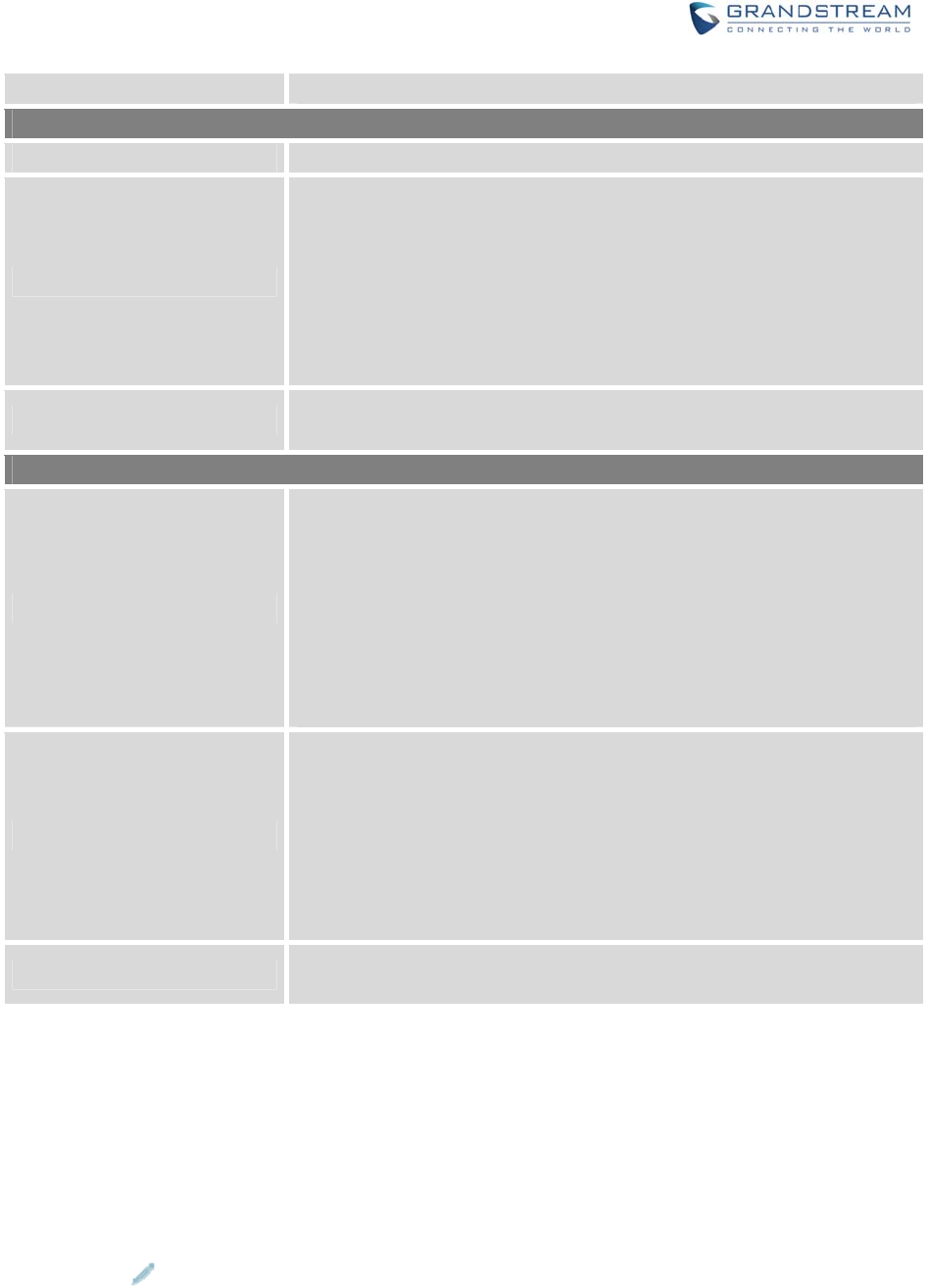
Firmware Version 1.0.0.1 UCM6200 Series IP PBX User Manual Page 172 of 320
Example: [12345-9] - Any digit from 1 to 9.
Send This Call Through Trunk
Use Trunk Select the trunk for this outbound rule.
Strip
Allows the user to specify the number of digits that will be stripped from
the beginning of the dialed string before the call is placed via the selected
trunk.
Example:
The users will dial 9 as the first digit of a long distance calls. However, 9
should not be sent out via analog lines and the PSTN line. In this case, 1
digit should be stripped before the call is placed.
Prepend Specify the digits to be prepended before the call is placed via the trunk.
Those digits will be prepended after the dialing number is stripped.
Use Failover Trunk
Failover Trunk
Failover trunks can be used to make sure that a call goes through an
alternate route, when the primary trunk is busy or down. If "Use Failover
Trunk" is enabled and "Failover trunk" is defined, the calls that cannot be
placed via the regular trunk may have a secondary trunk to go through.
Example:
The user's primary trunk is a VoIP trunk and the user would like to use the
PSTN when the VoIP trunk is not available. The PSTN trunk can be
configured as the failover trunk of the VoIP trunk.
Strip
Allows the user to specify the number of digits that will be stripped from
the beginning of the dialed string before the call is placed via the selected
trunk.
Example:
The users will dial 9 as the first digit of a long distance calls. However, 9
should not be sent out via analog lines and the PSTN line. In this case, 1
digit should be stripped before the call is placed.
Prepend Specify the digits to be prepended before the call is placed via the trunk.
Those digits will be prepended after the dialing number is stripped.
INBOUNDROUTES
Inbound routes can be configured via Web GUI->PBX->Basic/Call Routes->Inbound Routes.
Click on "Create New Inbound Rule" to add a new inbound route.
Click on "Blacklist" to configure blacklist for all inbound routes.
Click on to edit the inbound route.

Firmware Version 1.0.0.1 UCM6200 Series IP PBX User Manual Page 173 of 320
Click on to delete the inbound route.
INBOUNDRULECONFIGURATIONS
Table 57: Inbound Rule Configuration Parameters
Trunks Select the trunk to configure the inbound rule.
DID Pattern
All patterns are prefixed with the "_".
Special characters:
X: Any Digit from 0-9.
Z: Any Digit from 1-9.
N: Any Digit from 2-9.
".": Wildcard. Match one or more characters.
"!": Wildcard. Match zero or more characters immediately.
Example: [12345-9] - Any digit from 1 to 9.
The pattern can be composed of two parts, divided by a ‘/’ character.
The first part is used to specify the dialed number the second part is
used to specify the caller ID and it is optional, if set it means only the
extension with the specific caller ID is allowed to call in or call out.
For example, patter '_2XXX/1234' means the only extension with the
caller ID '1234' is allowed to use this rule.
Prepend Trunk Name Prepend trunk name to display
Alert-Info Configure the Alert-Info, when UCM6200 receives an INVITE request, the
Alert-Info header field specifies an alternative ring tone to the UAS.
Inbound Multiple Mode
Multiple mode allows user to switch between destinations of the inbound
rule by feature codes. Configure related feature codes in the “Feature
Codes” page. If this option is enabled, user can use feature code to
switch between different destinations.
Default Destination
Select the default destination for the inbound call.
Extension
Voicemail
Conference Room
Queue
Ring Group
Paging/Intercom
Voicemail Group
Fax
DISA
IVR
Dial By Name

Firmware Version 1.0.0.1 UCM6200 Series IP PBX User Manual Page 174 of 320
External Number
By DID
When "By DID" is used, the UCM6200 will look for the destination
based on the number dialed, which could be local extensions,
conference, call queue, ring group, paging/intercom group, IVR,
voicemail groups and Fax extension as configured in "DID
destination". If the dialed number matches the DID pattern, the call
will be allowed to go through.
Strip Configure the number of digits to be stripped from the beginning of the
DID. This option shows up only when "By DID" is selected.
Prepend Configure the number of digits to be prepended to an inbound DID
pattern, with strip taking precedence over prepend.
Dial Trunk
This option shows up only when "By DID" is selected. If enabled, the
external users dialing in to the trunk via this inbound route can dial
outbound call using the UCM6200’s trunk.
DID Destination
This option shows up only when "By DID" is selected. This controls the
destination that can be reached by the external caller via the inbound
route. The DID destination are:
Extension
Conference
Call Queue
Ring Group
Paging/Intercom Groups
IVR
Voicemail Groups
Fax Extension
Dial By Name
All
Time Condition
Time Conditions Select the time condition for the inbound rule.
Destination Select the destination for the inbound call during the specified time
condition.
INBOUNDROUTE:PREPENDEXAMPLE
UCM6200 now allows user to prepend digits to an inbound DID pattern, with strip taking precedence over
prepend. With the ability to prepend digits in inbound route DID pattern, user no longer needs to create
multiple routes for the same trunk in order to route calls to different extensions.
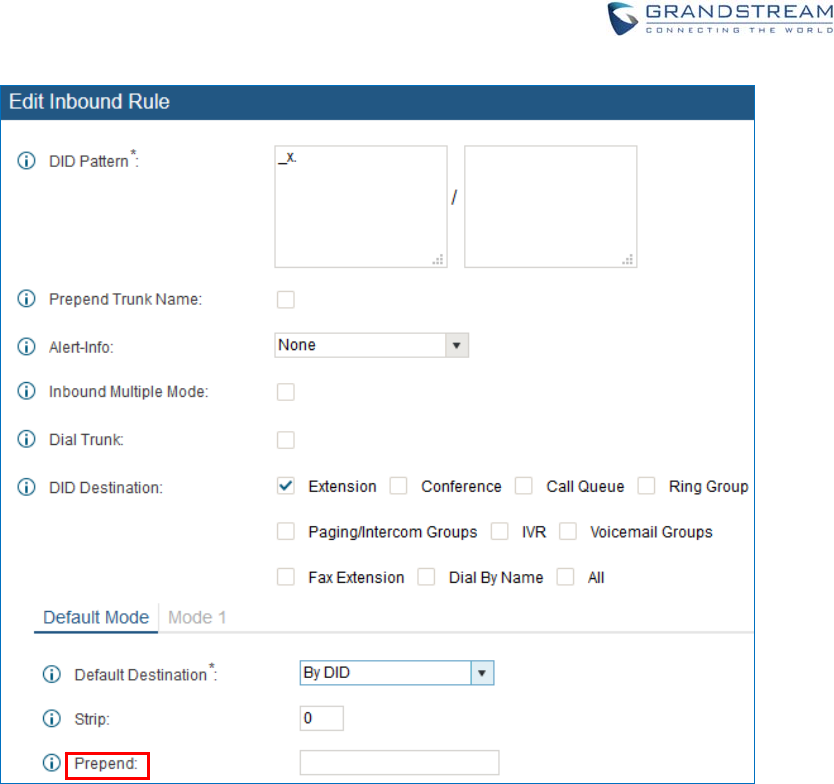
Firmware Version 1.0.0.1 UCM6200 Series IP PBX User Manual Page 175 of 320
Figure 104: Inbound Route feature: Prepend
The following example demonstrates the process,
1. If Trunk provides a DID pattern of 18005251163.
2. If Strip is set to 8, UCM6200 will strip the first 8 digits.
3. If Prepend is set to 2, UCM6200 will then prepend a 2 to the stripped number, now the number
become 2163.
4. UCM6200 will now forward the incoming call to extension 2163.
INBOUNDROUTE:MULTIPLEMODE
In the UCM6200, the user can configure inbound route to enable multiple mode to switch between different
destinations. The inbound multiple mode can be enabled under Inbound Route settings.
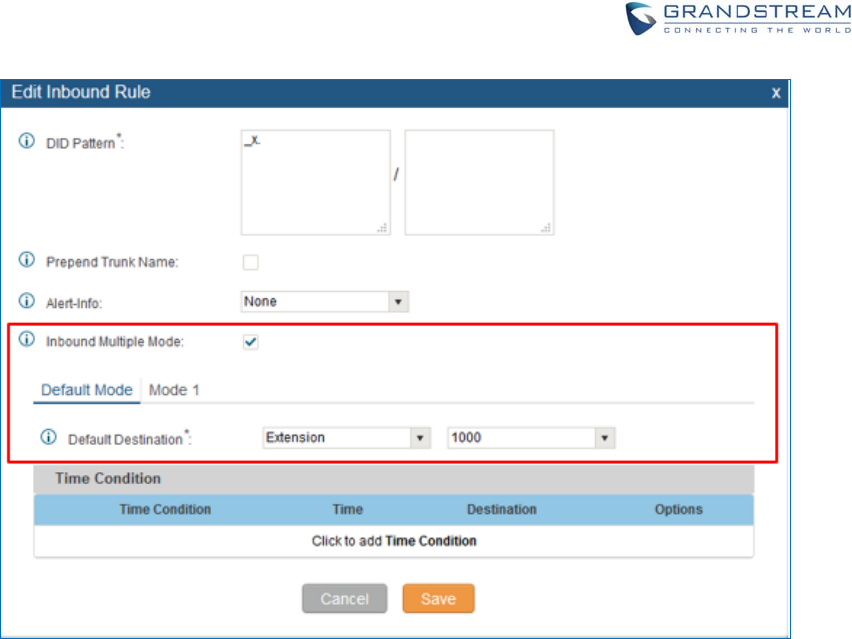
Firmware Version 1.0.0.1 UCM6200 Series IP PBX User Manual Page 176 of 320
Figure 105: Inbound Route - Multiple Mode
When Multiple Mode is enabled for the inbound route, the user can configure a “Default Destination” and a
“Mode 1” destination for this route. By default, the call coming into this inbound route will be routed to the default
destination.
SIP end devices that have registered on the UCM6200 can dial feature code *62 to switch to inbound route
“Mode 1” and dial feature code *61 to switch back to “Default Destination”. Switching between different mode
can be easily done without web UI login.
For example, the customer service hotline destination has to be set to a different IVR after 7PM. The user can
dial *62 to switch to “Mode 1” with that IVR set as the destination before off work.
FAXINTELLIGENTROUTE
The UCM6200 can automatically detect Fax and phone signal coming from the FXO port, and then forward Fax
or phone signal to the right destination. For example, when a regular phone call is coming, the UCM6200 will be
able to detect the phone signal and forward it through the correct inbound route to the destination; if Fax signal is
coming, the UCM6200 will be able to forward it to the FXS extension where the Fax machine is connected.
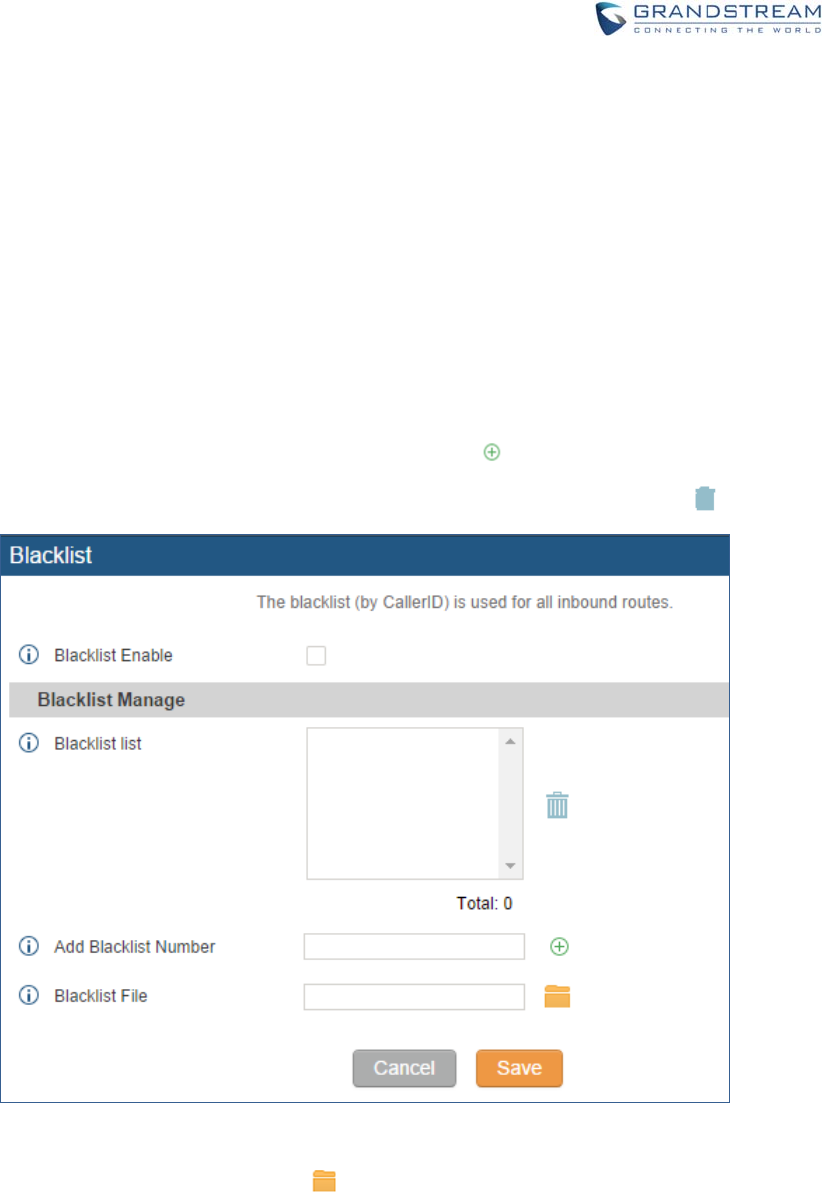
Firmware Version 1.0.0.1 UCM6200 Series IP PBX User Manual Page 177 of 320
FAXWITHTWOMEDIA
The UCM6200 supports Fax re-invite with multiple codec negotiation. If a Fax re-invite contains both T.38 and
PCMA/PCMU codec, UCM6200 will choose T.38 codec over PCMA/PCMU.
BLACKLISTCONFIGURATIONS
In the UCM6200, Blacklist is supported for all inbound routes. Users could enable the Blacklist feature and
manage the Blacklist by clicking on "Blacklist".
Select the checkbox for "Blacklist Enable" to turn on Blacklist feature for all inbound routes. Blacklist is
disabled by default.
Enter a number in "Add Blacklist Number" field and then click to add to the list.
To remove a number from the Blacklist, select the number in "Blacklist list" and click on .
Figure 106: Blacklist Configuration Parameters
To add blacklist number in batch, click on to upload blacklist file in csv format. The supported csv
format is as below.
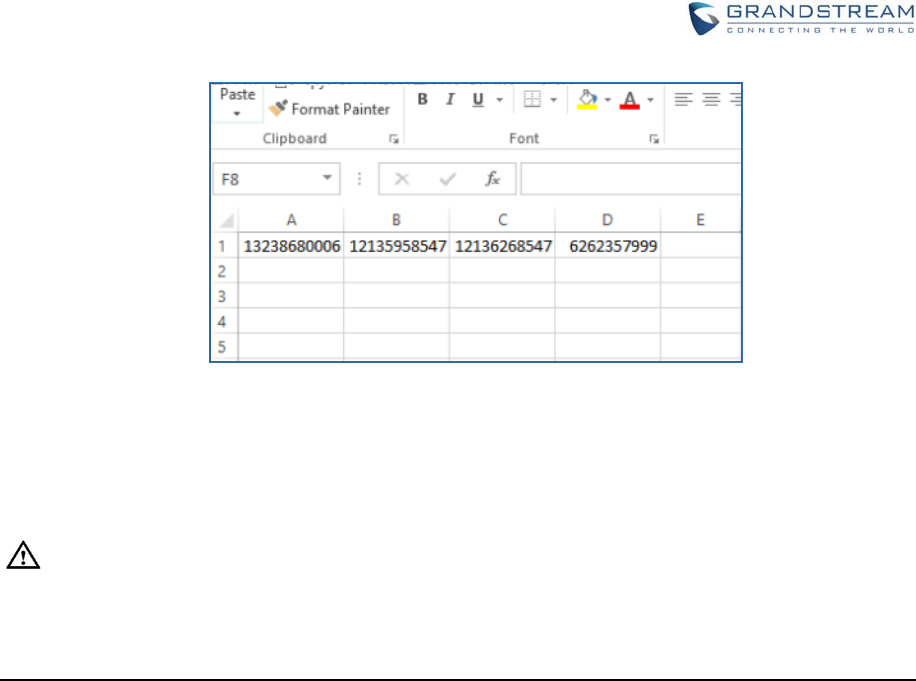
Firmware Version 1.0.0.1 UCM6200 Series IP PBX User Manual Page 178 of 320
Figure 107: Blacklist csv File
--------------------------------------------------------------------------------------------------------------------------------------------
Note:
Users could also add a number to the Blacklist or remove a number from the Blacklist by dialing the feature
code for "Blacklist Add' (default: *40) and "Blacklist Remove" (default: *41) from an extension. The feature
code can be configured under Web GUI->PBX->Internal Options->Feature Codes.

Firmware Version 1.0.0.1 UCM6200 Series IP PBX User Manual Page 179 of 320
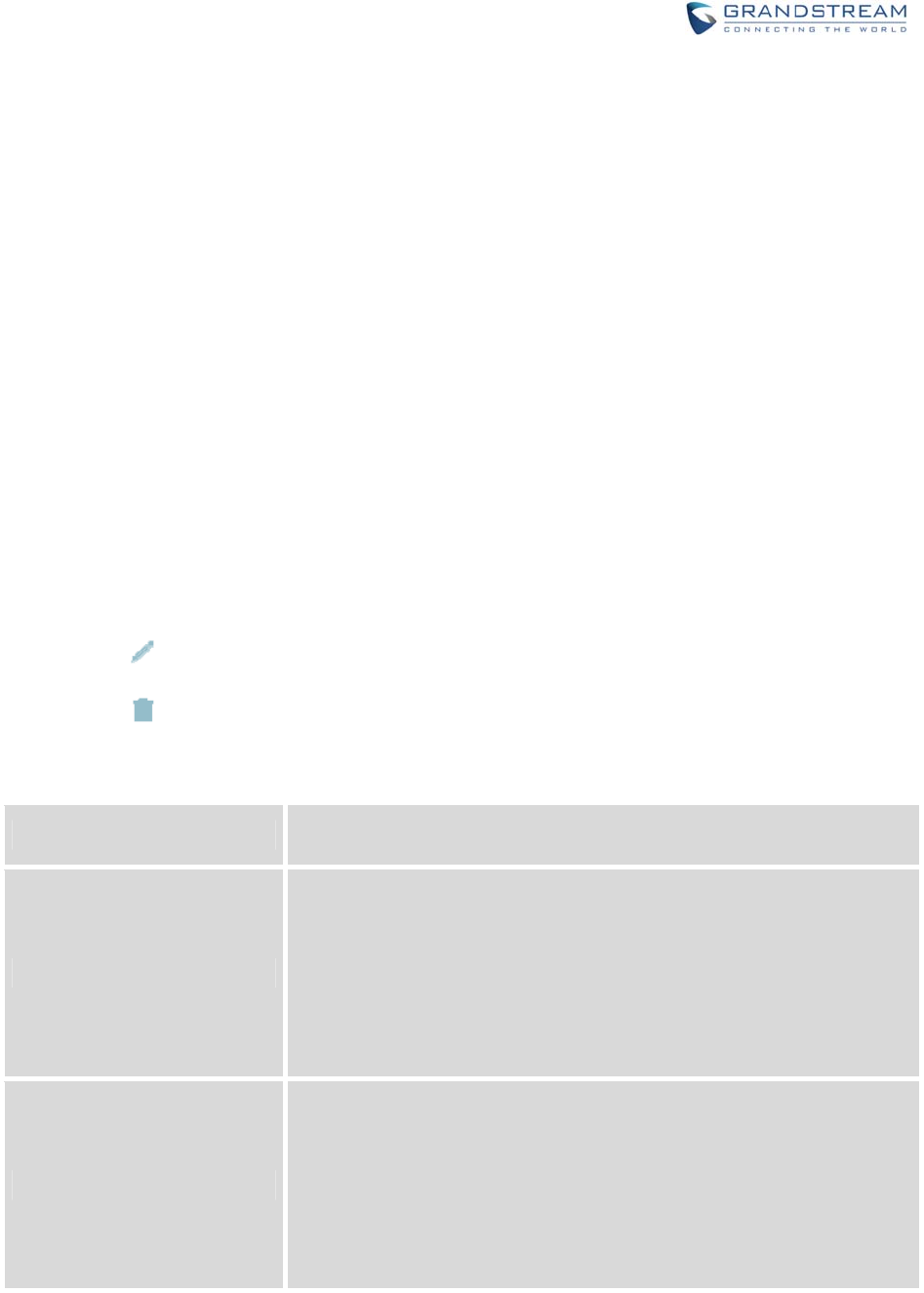
Firmware Version 1.0.0.1 UCM6200 Series IP PBX User Manual Page 180 of 320
CONFERENCEBRIDGE
The UCM6200 supports conference bridge allowing multiple bridges used at the same time:
UCM6202/6204 supports up to 3 conference bridges allowing up to 25 simultaneous PSTN or IP
participants.
UCM6208 supports up to 6 conference bridges allowing up to 32 simultaneous PSTN or IP participants.
The conference bridge configurations can be accessed under Web GUI->PBX->Call
Features->Conference. In this page, users could create, edit, view, invite, manage the participants and
delete conference bridges. The conference bridge status and conference call recordings (if recording is
enabled) will be displayed in this web page as well.
CONFERENCEBRIDGECONFIGURATIONS
Click on "Create New Conference Room" to add a new conference bridge.
Click on to edit the conference bridge.
Click on to delete the conference bridge.
Table 58: Conference Bridge Configuration Parameters
Extension Configure the conference number for the users to dial into the
conference.
Password
When configured, the users who would like to join the conference call
must enter this password before accessing the conference bridge.
Note:
If "Public Mode" is enabled, the password is not required to join the
conference bridge thus this field is invalid.
The password has to be at least 4 characters.
Admin Password
Configure the password to join the conference bridge as administrator.
Conference administrator can manage the conference call via IVR (if
"Enable Caller Menu" is enabled) as well as invite other parties to join the
conference by dialing "0" (permission required from the invited party) or
"1" (permission not required from the invited party) during the conference
call.
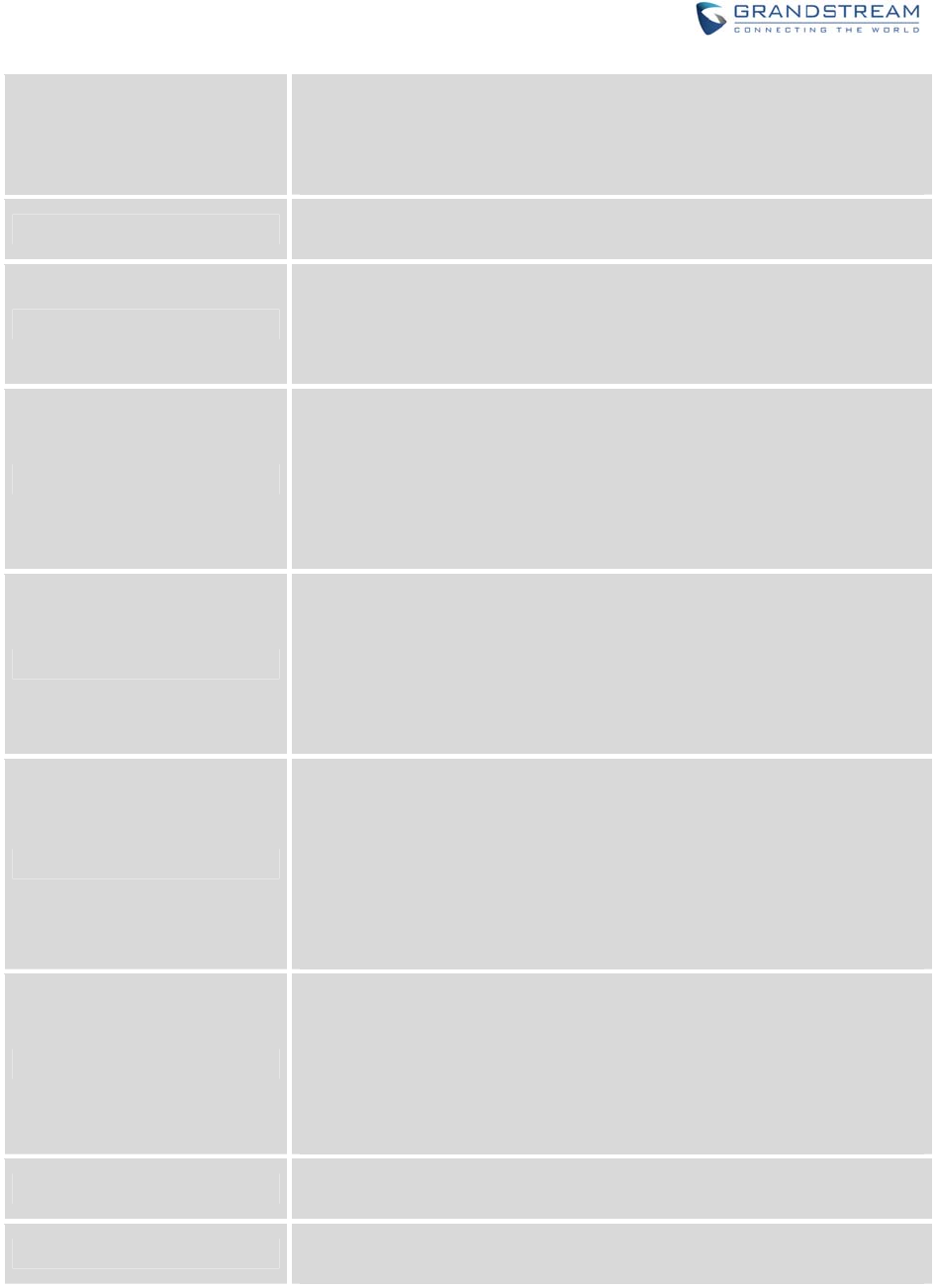
Firmware Version 1.0.0.1 UCM6200 Series IP PBX User Manual Page 181 of 320
Note:
If "Public Mode" is enabled, the password is not required to join the
conference bridge thus this field is invalid.
The password has to be at least 4 characters.
Enable Caller Menu If enabled, conference participant could press the * key to access the
conference bridge menu. The default setting is "No".
Record Conference
If enabled, the calls in this conference bridge will be recorded
automatically in a .wav format file. All the recording files will be displayed
and can be downloaded in the conference web page. The default setting
is "No".
Quiet Mode
If enabled, if there are users joining or leaving the conference, voice
prompt or notification tone won't be played. The default setting is "No".
Note:
"Quiet Mode" and "Announce Callers" cannot be enabled at the same
time.
Wait For Admin
If enabled, the participants will not hear each other until the conference
administrator joins the conference. The default setting is "No".
Note:
If "Quiet Mode" is enabled, the voice prompt for "Wait For Admin" will not
be announced.
Enable User Invite
If enabled, users could press 0 to invite other users (with the users'
permission) or press 1 to invite other users (without the user's permission)
to join the conference. The default setting is "No".
Note:
Conference administrator can always invite other users without enabling
this option.
Announce Callers
If enabled, the caller will be announced to all conference participants
when there the caller joins the conference. The default setting is "No".
Note:
"Quiet Mode" and "Announce Callers" cannot be enabled at the same
time.
Public Mode If enabled, no authentication will be required when joining the conference
call. The default setting is "Yes".
Play Hold Music If enabled, the UCM6200 will play Hold music when there is only one user
in the conference. The default setting is "No".
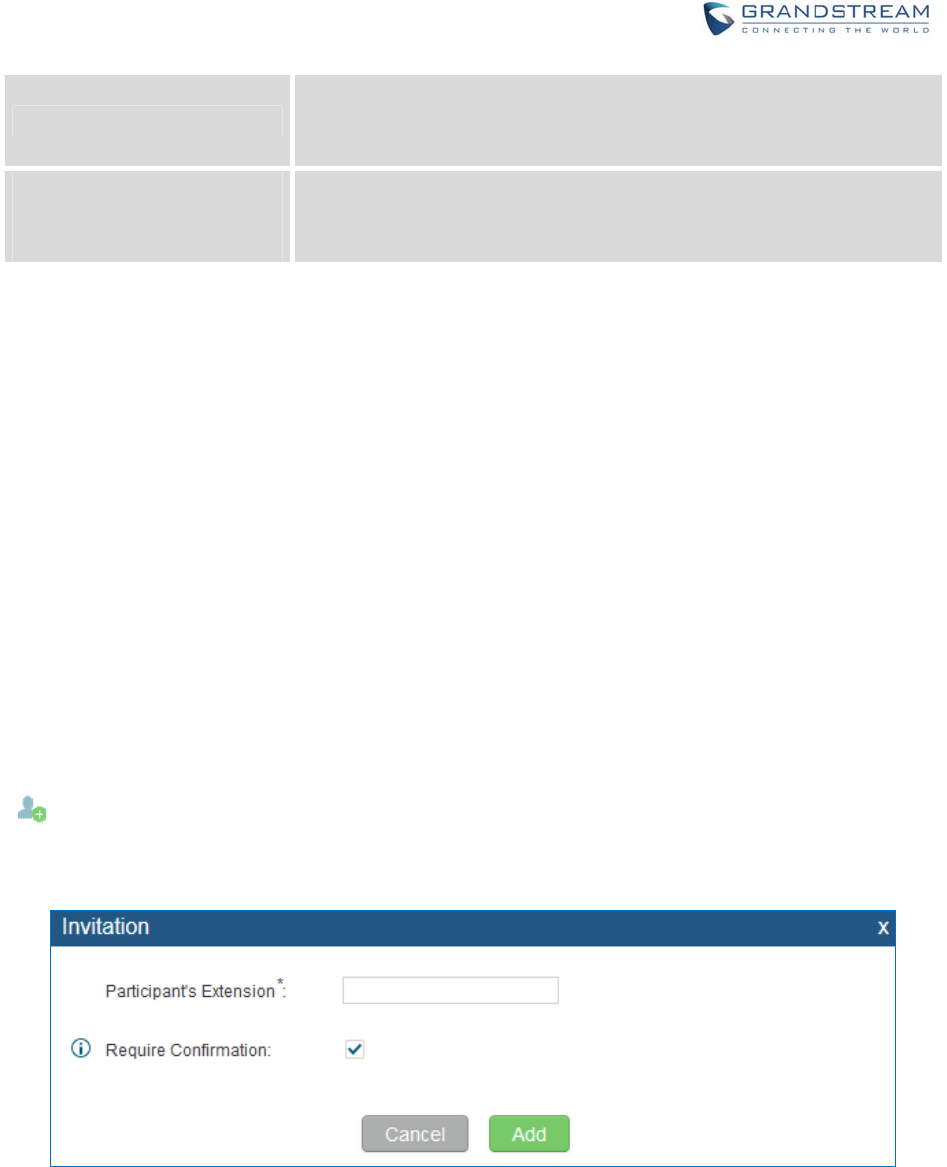
Firmware Version 1.0.0.1 UCM6200 Series IP PBX User Manual Page 182 of 320
Music On Hold
Select the music on hold class to be played in conference call. Music On
Hold class can be set up under web UI->PBX->Internal Options->Music
On Hold.
Skip Authentication When
Inviting User via Trunk from
Web GUI
If enabled, the invitation from Web GUI for a conference bridge with
password will skip the authentication for the invited users. The default
setting is "No".
JOINACONFERENCECALL
Users could dial the conference bridge extension to join the conference. If password is required, enter the
password to join the conference as a normal user, or enter the admin password to join the conference as
administrator.
INVITEOTHERPARTIE STOJOINCONFERENCE
When using the UCM6200 conference bridge, there are two ways to invite other parties to join the
conference.
Invite from Web GUI.
For each conference bridge in UCM6200 Web GUI->PBX->Call Features->Conference, there is an icon
for option "Invite a participant". Click on it and enter the number of the party you would like to invite.
Then click on "Add". A call will be sent to this number to join it into the conference.
Figure 108: Conference Invitation From Web GUI
Invite by dialing 0 or 1 during conference call.
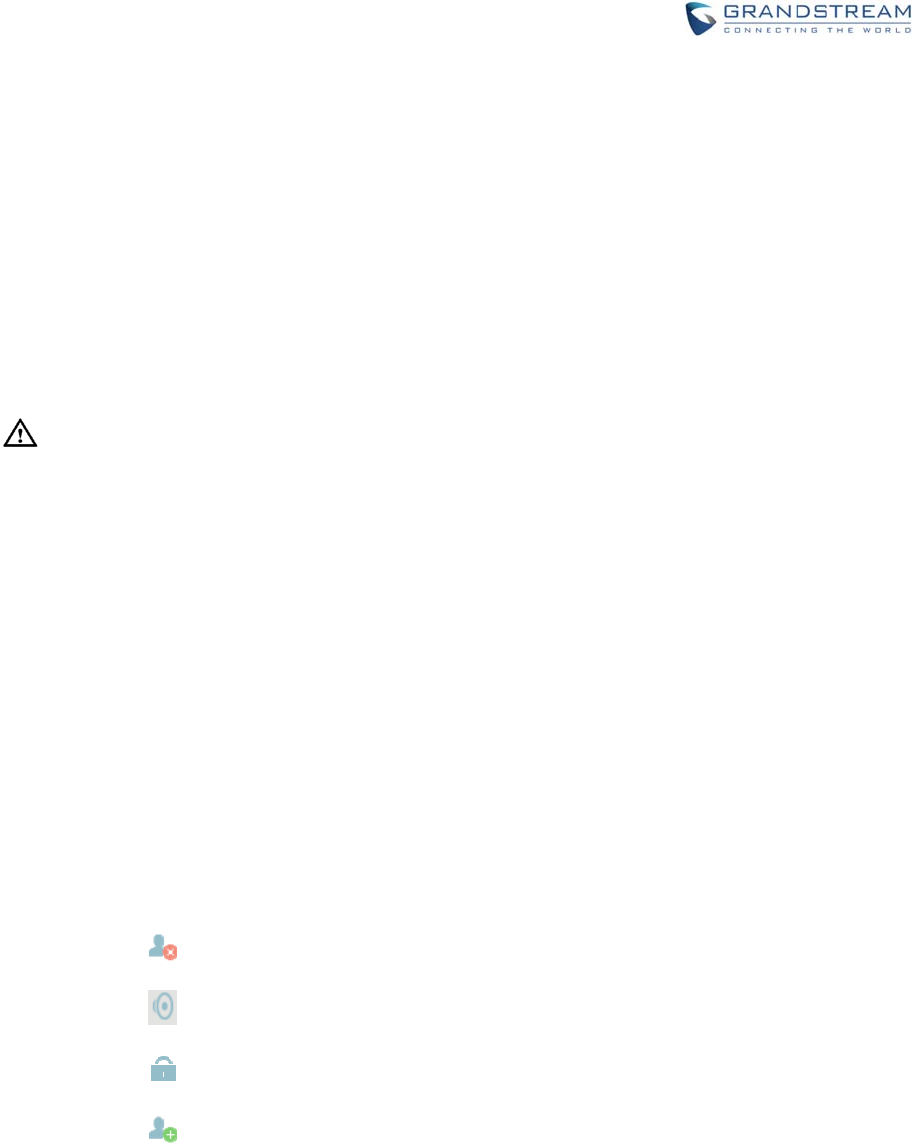
Firmware Version 1.0.0.1 UCM6200 Series IP PBX User Manual Page 183 of 320
A conference participant can invite other parties to the conference by dialing from the phone during the
conference call. Please make sure option "Enable User Invite" is turned on for the conference bridge first.
Enter 0 or 1 during the conference call. Follow the voice prompt to input the number of the party you would
like to invite. A call will be sent to this number to join it into the conference.
0: If 0 is entered to invite other party, once the invited party picks up the invitation call, a permission will be
asked to "accept" or "reject" the invitation before joining the conference.
1: If 1 is entered to invite other party, no permission will be required from the invited party.
--------------------------------------------------------------------------------------------------------------------------------------------
Note:
Conference administrator can always invite other parties from the phone during the call by entering 0 or 1.
To join a conference bridge as administrator, enter the admin password when joining the conference. A
conference bridge can have multiple administrators.
--------------------------------------------------------------------------------------------------------------------------------------------
DURINGTHECONFERENCE
During the conference call, users can manage the conference from web GUI or IVR.
Manage the conference call from Web GUI.
Log in UCM6200 web GUI during the conference call, the participants in each conference bridge will
be listed.
1. Click on to kick a participant from the conference.
2. Click on to mute the participant.
3. Click on to lock this conference bridge so that other users cannot join it anymore.
4. Click on to invite other users into the conference bridge.
Manage the conference call from IVR.
If "Enable Caller Menu" is enabled, conference participant can input * to enter the IVR menu for the
conference. Please see options listed in the table below.

Firmware Version 1.0.0.1 UCM6200 Series IP PBX User Manual Page 184 of 320
Table 59: Conference Caller IVR Menu
Conference Administrator IVR Menu
1 Mute/unmute yourself.
2 Lock/unlock the conference bridge.
3 Kick the last joined user from the conference.
4 Decrease the volume of the conference call.
5 Decrease your volume.
6 Increase the volume of the conference call.
7 Increase your volume.
8
More options.
1: List all users currently in the conference call.
2: Kick all non-Administrator participants from the conference call.
3: Mute/Unmute all non-Administrator participants from the conference call.
4: Record the conference call.
8: Exit the caller menu and return to the conference.
Conference User IVR Menu
1 Mute/unmute yourself.
4 Decrease the volume of the conference call.
5 Decrease your volume.
6 Increase the volume of the conference call.
7 Increase your volume.
8 Exit the caller menu and return to the conference.
--------------------------------------------------------------------------------------------------------------------------------------------
Note:
When there is participant in the conference, the conference bridge configuration cannot be modified.
--------------------------------------------------------------------------------------------------------------------------------------------
RECORDCONFERENCE
The UCM6200 allows users to record the conference call and retrieve the recording from web
GUI->PBX->Call Features->Conference.
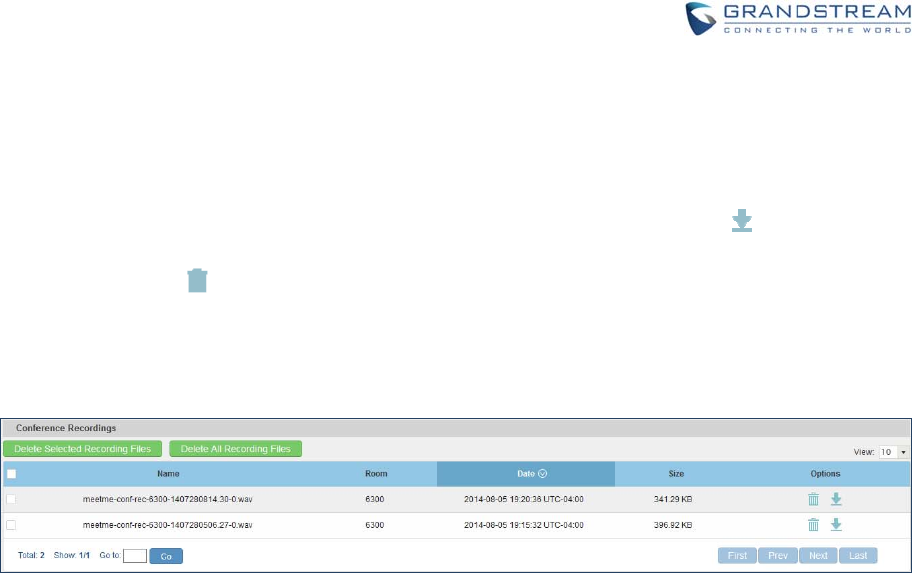
Firmware Version 1.0.0.1 UCM6200 Series IP PBX User Manual Page 185 of 320
To record the conference call, when the conference bridge is in idle, enable "Record Conference" from the
conference bridge configuration dialog. Save the setting and apply the change. When the conference call
starts, the call will be automatically recorded in .wav format.
The recording files will be listed as below once available. Users could click on to download the
recording or click on to delete the recording. Users could also delete all recording files by clicking on
“Delate All Recording Files”, or delete multiple recording files at once by clicking on “Delete Selected
Recording Files” after selecting the recording files.
Figure 109: Conference Recording
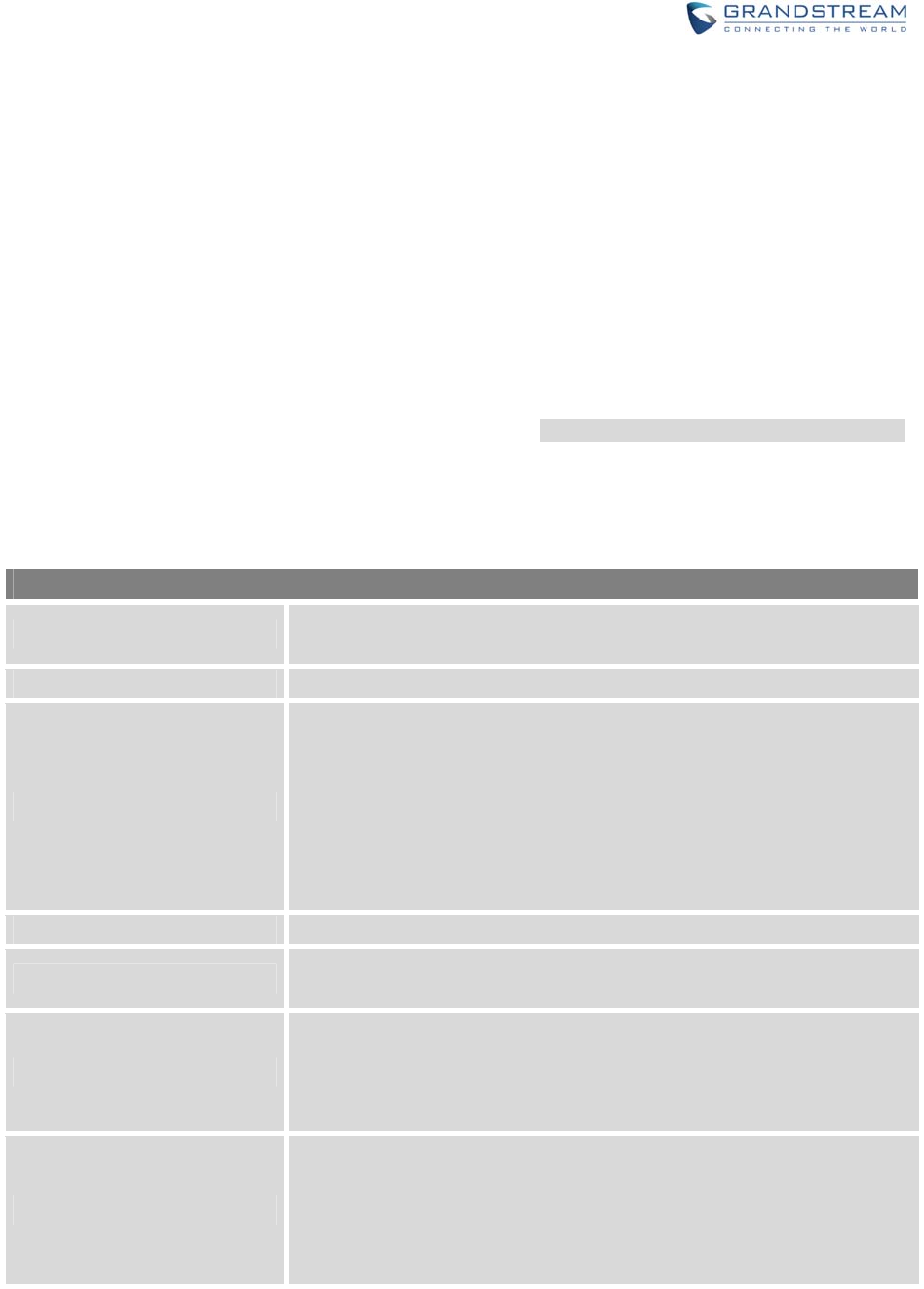
Firmware Version 1.0.0.1 UCM6200 Series IP PBX User Manual Page 186 of 320
CONFERENCESCHEDULE
CONFERENCESCHEUDLECONFIGURATION
Conference Schedule can be found under UCM6200 web UI->PBX->Call Features->Conference Schedule.
Users can create, edit, view and delete a Conference Schedule.
Click on “Create New Conference Schedule” to add a new Conference Schedule.
Click on the scheduled conference to edit or delete the event.
After the user configures UCM6200 with Google Service Settings [GOOGLE SERVICE SETTINGS SUPPORT]
and enables Google Calendar for Conference Schedule, the conference schedule on the UCM6200 can be
synchronized with Google Calendar for authorized Google account.
Table 60: Conference Schedule Parameters
Schedule Options
Conference Topic Configure the name of the scheduled conference. Letters, digits, _ and -
are allowed.
Conference Room Select a conference room for this scheduled conference.
Kick Time(m)
Set kick time before conference starts. When kick time is reached, a
warning prompt will be played for all attendees in the conference room.
After 5 minutes, this conference room will be cleared and locked for the
scheduled conference to begin.
Note: Kick Time cannot be less than 6 minutes in order to clear the
conference room.
Description The description of scheduled conference.
Repeat Repeat interval of scheduled conference. By default it’s set to single
event.
Schedule Time
Configure the beginning date and duration of scheduled conference.
Note: Please pay attention to avoid time conflict on schedules in the
same conference room.
Enable Google Calendar
Select this option to sync scheduled conference with Google Calendar.
Note: Google Service Setting OAuth2.0 must be configured on the
UCM6200. Please refer to section [GOOGLE SERVICE SETTINGS
SUPPORT].
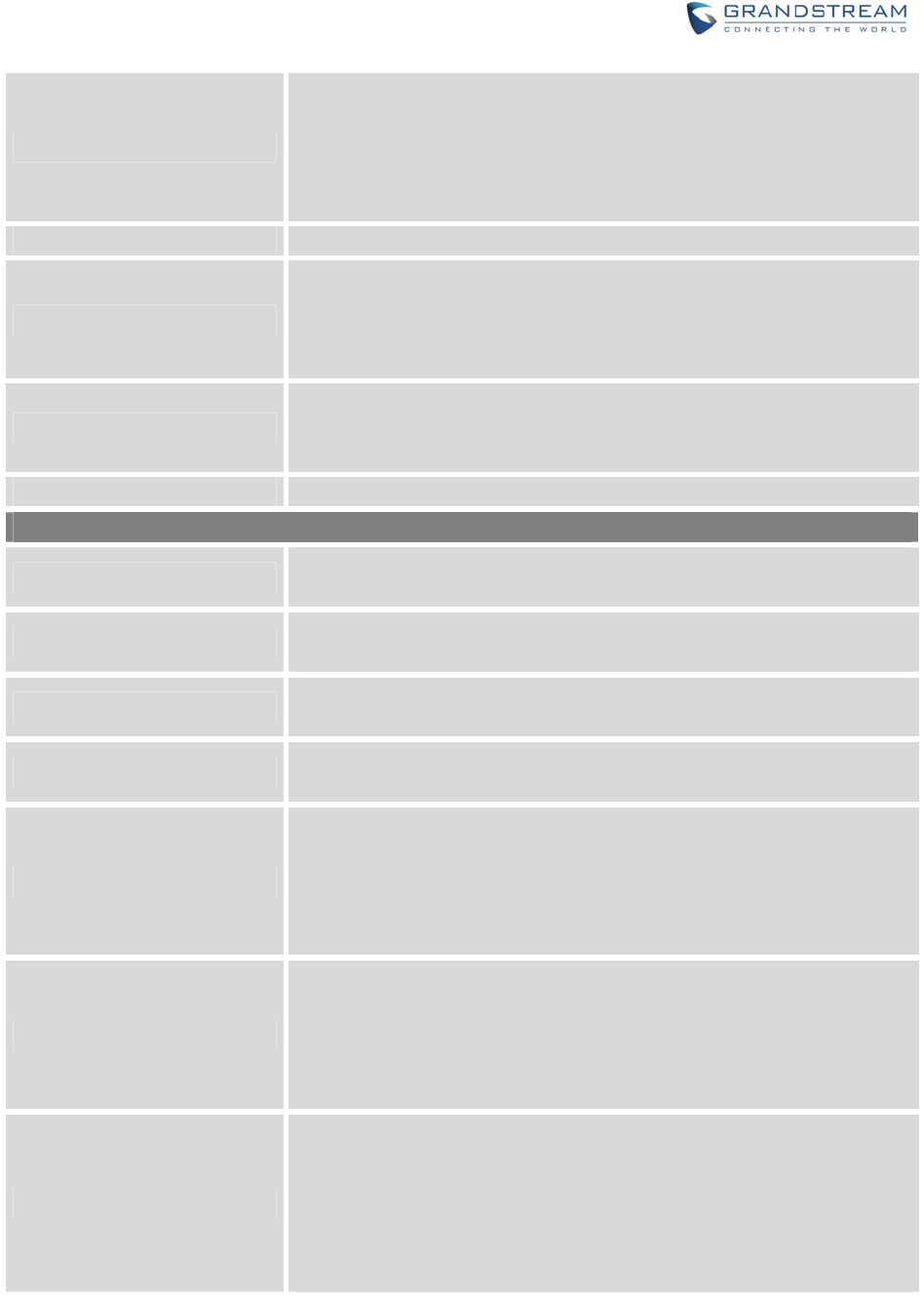
Firmware Version 1.0.0.1 UCM6200 Series IP PBX User Manual Page 187 of 320
Conference Administrator
Select the administrator of scheduled conference from selected
extensions.
Note:
“Public Mode” must be disabled from Conference Room Options tab.
Local Extension Select available extensions from the list to attend scheduled conference.
Remote Extension
Select available extensions from the remote peer PBX.
Note: “LDAP Sync” must be enabled on the UCM6200 in order to view
remote extensions here.
Special Extension
Add extensions that are not in the list (both local and remote list). If the
user wishes to add the special extension, please match the pattern on the
outbound route.
Remote Conference Invite a remote conference.
Conference Room Options
Password Configure conference room password. Please note that if “Public Mode” is
enabled, this option is automatically disabled.
Admin Password Configure the password to join as conference administrator. Please note
that if “Public Mode” is enabled, this option is automatically disabled.
Enable Caller Menu If this option is enabled, conference participants will be able to access
conference bridge menu by pressing the * key.
Record Conference If this option is enabled, conference call will be recorded in .wav format.
The recorded file can be found from Conference page.
Quiet Mode
If this option is enabled, the notification tone or voice prompt for joining or
leaving the conference won’t be played.
Note: Option “Quiet Mode” and option “Announce Caller” cannot be
enabled at the same time.
Wait For Admin
If this option is enabled, the participants in the conference won’t be able to
hear each other until conference administrator joins the conference.
Note: If “Quiet Mode” is enabled, voice prompt for this option won’t be
played.
Enable User Invite
If this option is enabled, the user can:
Press ‘0’ to invite others to join the conference with invited party’s
permission
Press ‘1’ to invite without invited party’s permission
Press ‘2’ to create a multi-conference bridge to another conference
room
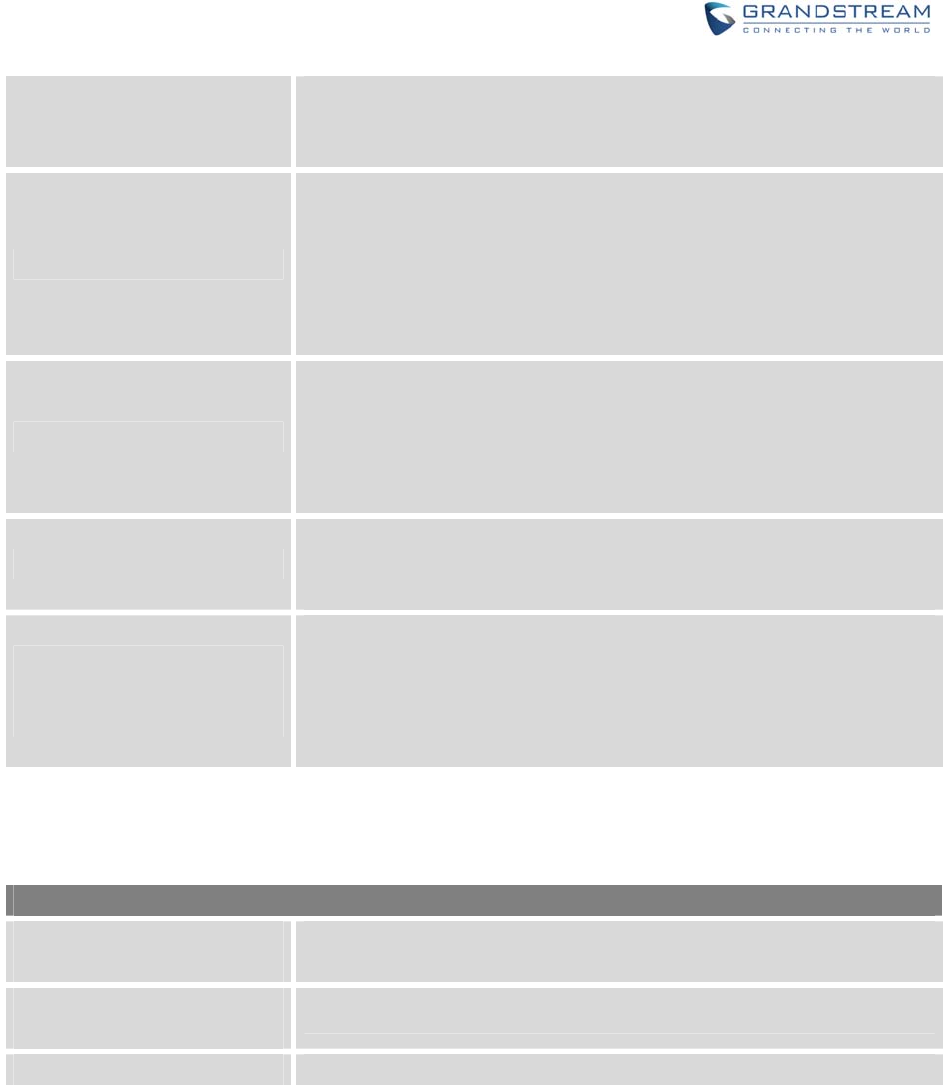
Firmware Version 1.0.0.1 UCM6200 Series IP PBX User Manual Page 188 of 320
Press ‘3’ to drop all current multi-conference bridges
Note: Conference Administrator is always allowed to access this menu.
Announce Callers
If this option is enabled, when a participant joins the conference room,
participant’s name will be announced to all members in the conference
room.
Note: Option “Quiet Mode” and option “Announce Caller” cannot be
enabled at the same time.
Public Mode
If this option is enabled, no authentication is required for entering the
conference room.
Note: Please be aware of the potential security risks when turning on this
option.
Play Hold Music
If this option is enabled, UCM6200 will play Hold Music while there is only
one participant in the conference room or the conference is not yet
started.
Skip Authentication When
Inviting Users via Trunk from
Web GUI
If this option is enabled, the invitation from Web GUI via a trunk with
password won’t require authentication.
Note: Please be aware of the potential security risks when turning on this
option.
Cleaner Options
Cleaner Options
Enable Conference
Schedules Cleaner
If this option is enabled, conference schedules will be automatically
cleaned as configured.
Conference Schedules Clean
Time Enter the clean time (in hours). The valid range is from 0 to 23.
Clean Interval Enter the clean interval (in days). The valid range is from 1 to 30.
Show/hide Conference Schedule Table
Enable this option will allow web UI to display scheduled conference in Conference Schedule Table. Please
see figure below.
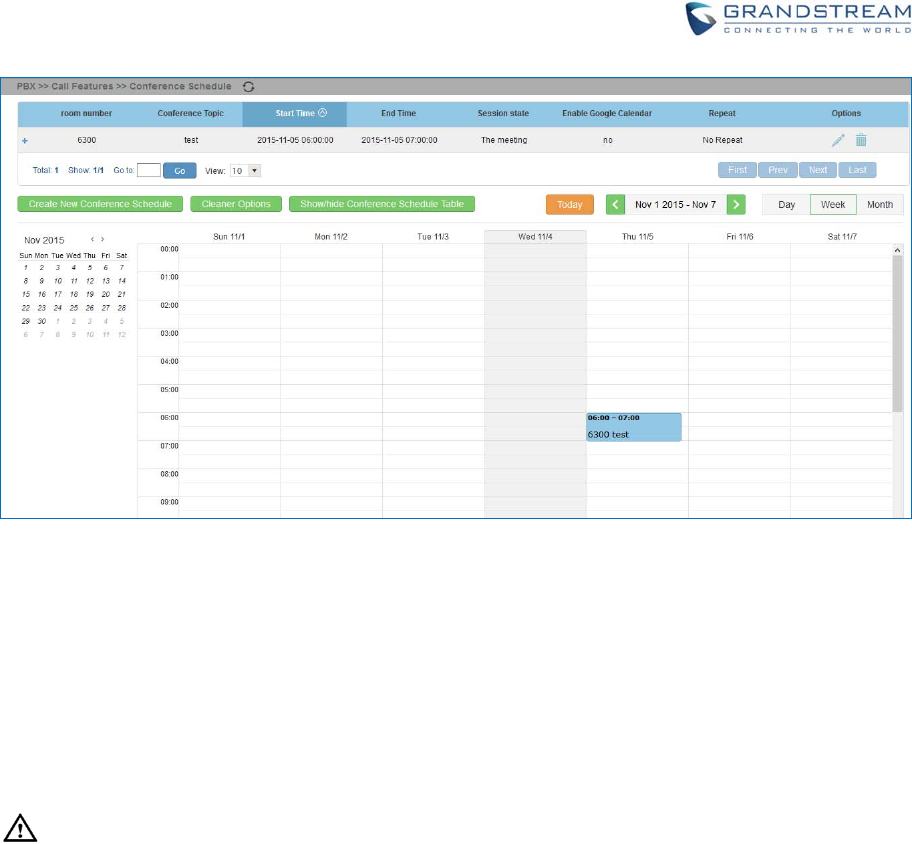
Firmware Version 1.0.0.1 UCM6200 Series IP PBX User Manual Page 189 of 320
Figure 110: Conference Schedule
Once the conference room is scheduled, at the kick time, all users will be removed from conference room
and no extension is allowed to join the conference room anymore. At the scheduled conference time,
UCM6200 will send INVITE to the extensions that have been selected for conference.
--------------------------------------------------------------------------------------------------------------------------------------------
Note:
Please make sure that outbound route is properly configured for remote extensions to join the
conference.
Once Kick Time is reached, Conference Schedule is locked and cannot be modified.
--------------------------------------------------------------------------------------------------------------------------------------------
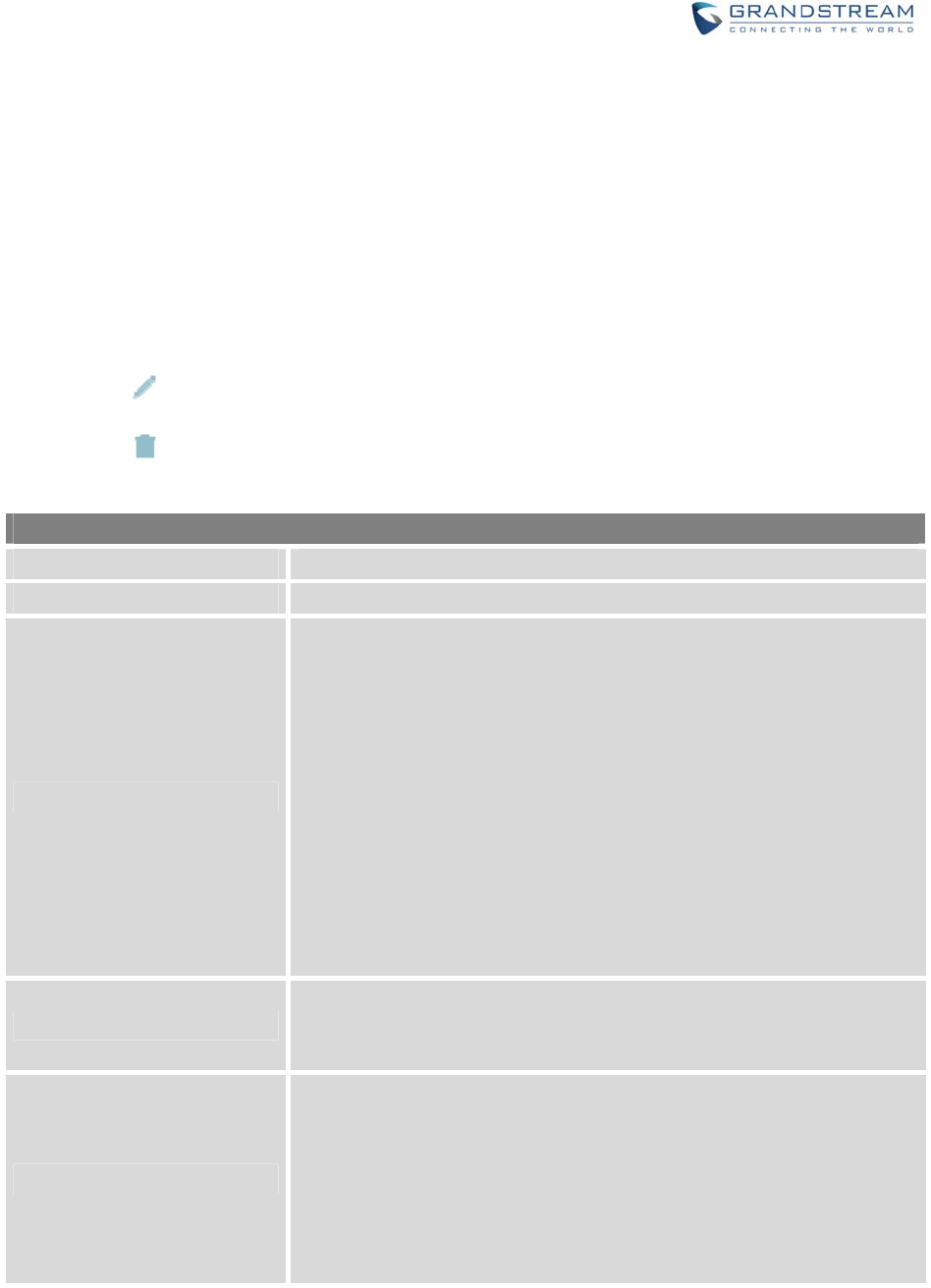
Firmware Version 1.0.0.1 UCM6200 Series IP PBX User Manual Page 190 of 320
IVR
CONFIGUREIVR
IVR configurations can be accessed under the UCM6200 Web GUI->PBX->Call Features->IVR. Users
could create, edit, view and delete an IVR.
Click on "Create New IVR" to add a new IVR.
Click on to edit the IVR configuration.
Click on to delete the IVR.
Table 61: IVR Configuration Parameters
Basic Settings
Name Configure the name of the IVR. Letters, digits, _ and - are allowed.
Extension Enter the extension number for users to access the IVR.
DID Destination
This option shows up only when "By DID" is selected. This controls the
destination that can be reached by the external caller via the inbound
route. The DID destination are:
Extension
Conference
Call Queue
Ring Group
Paging/Intercom Groups
Voicemail Groups
Fax Extension
Dial By Name
All
Dial Trunk
If enabled, all callers to the IVR is allowed to use trunk. The permission
must be configured for the users to use the trunk first. The default setting
is "No".
Permission
Assign permission level for outbound calls if "Dial Trunk" is enabled. The
available permissions are "Internal", "Local", "National" and
"International" from the lowest level to the highest level. The default
setting is "Internal". If the user tries to dial outbound calls after dialing into
the IVR, the UCM6200 will compared the IVR's permission level with the
outbound route's privilege level. If the IVR's permission level is higher
than (or equal to) the outbound route's privilege level, the call will be
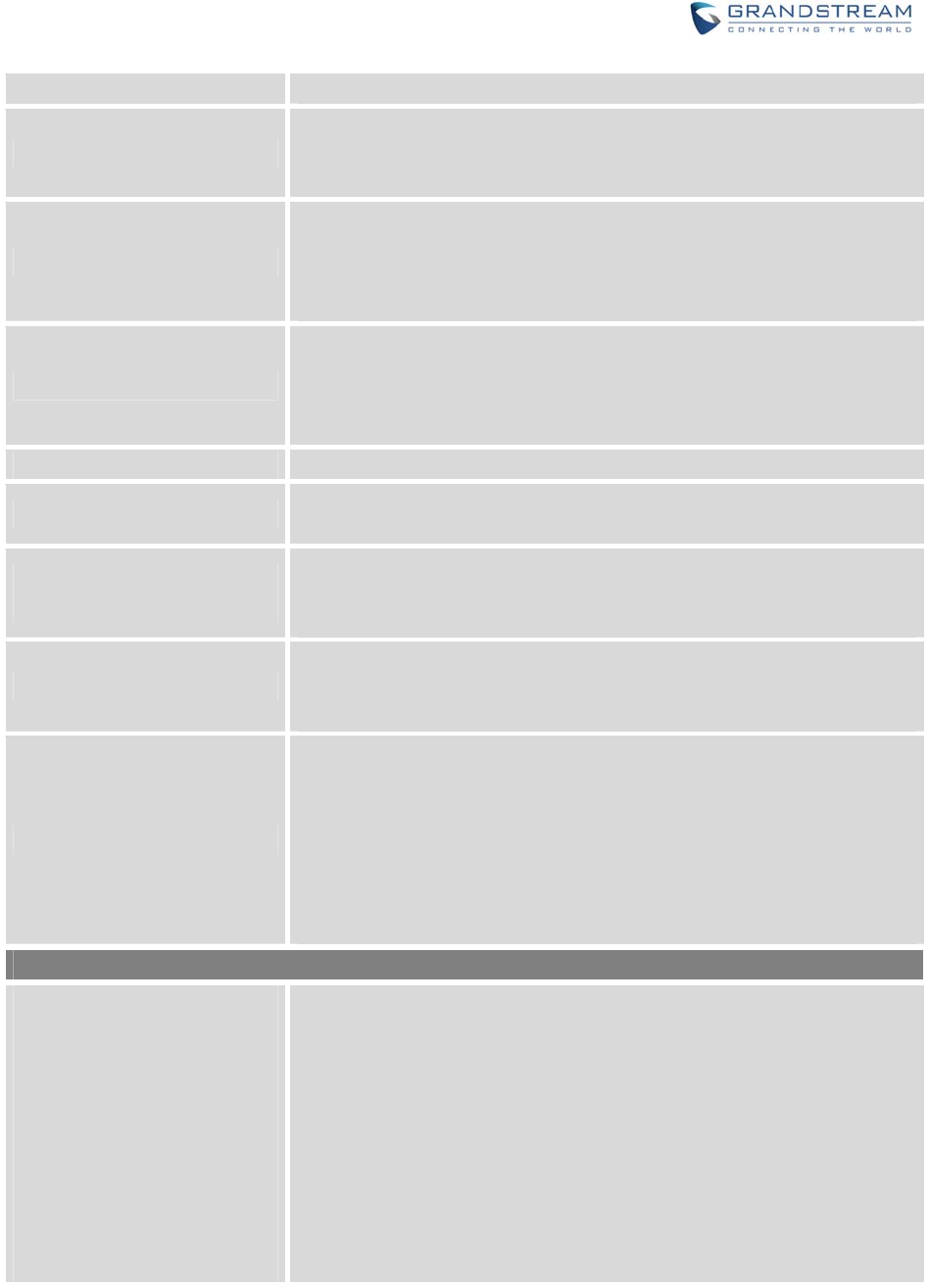
Firmware Version 1.0.0.1 UCM6200 Series IP PBX User Manual Page 191 of 320
allowed to go through.
Welcome Prompt
Select an audio file to play as the welcome prompt for the IVR. Click on
"Prompt" to add additional audio file under web GUI->Internal
Options->IVR Prompt.
Digit Timeout
Configure the timeout between digit entries. After the user enters a digit,
the user needs to enter the next digit within the timeout. If no digit is
detected within the timeout, the UCM6200 will consider the entries
complete. The default timeout is 3 seconds.
Response Timeout
After playing the prompts in the IVR, the UCM6200 will wait for the DTMF
entry within the timeout (in seconds). If no DTMF entry is detected within
the timeout, a timeout prompt will be played. The default setting is 10
seconds.
Response Timeout Prompt Select the prompt message to be played when timeout occurs.
Invalid Prompt Select the prompt message to be played when an invalid extension is
pressed.
Response Timeout Repeat
Loops
Configure the number of times to repeat the prompt if no DTMF input is
detected. When the loop ends, it will go to the timeout destination if
configured, or hang up. The default setting is 3.
Invalid Repeat Loops
Configure the number of times to repeat the prompt if the DTMF input is
invalid. When the loop ends, it will go to the invalid destination if
configured, or hang up. The default setting is 3.
Language
Select the voice prompt language to be used for this IVR. The default
setting is "Default" which is the selected voice prompt language under
web GUI->PBX->Internal Options->Language. The dropdown list
shows all the current available voice prompt languages on the UCM6200.
To add more languages in the list, please download voice prompt
package by selecting "Check Prompt List" under web
GUI->PBX->Internal Options->Language.
Key Pressing Events
Key Press Event:
Press 0
Press 1
Press 2
Press 3
Press 4
Press 5
Press 6
Press 7
Press 8
Select the event for each key pressing for 0-9, *, Timeout and Invalid. The
event options are:
Extension
Voicemail
Conference Rooms
Voicemail Group
IVR
Ring Group
Queues
Page Group
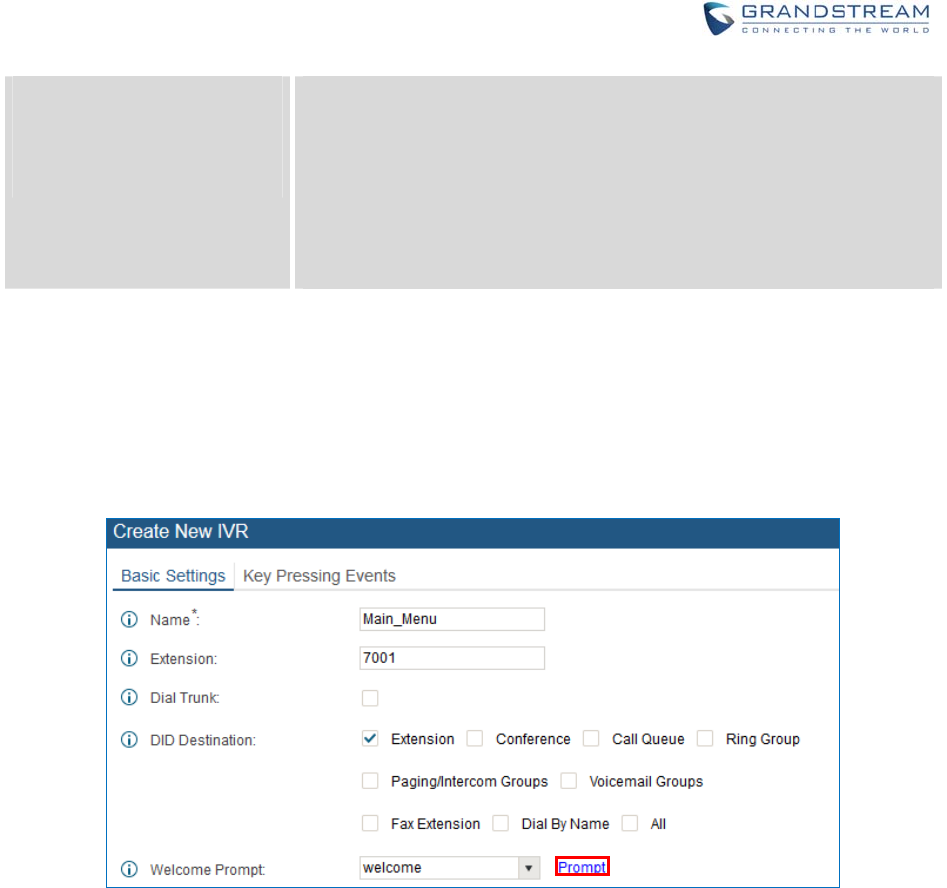
Firmware Version 1.0.0.1 UCM6200 Series IP PBX User Manual Page 192 of 320
Press 9
Press *
Timeout
Invalid
Fax
Custom Prompt
Hangup
DISA
Dial By Name
External Number
Callback
CREATECUSTOMPROMPT
To record new IVR prompt or upload IVR prompt to be used in IVR, click on “Prompt” next to the “Welcome
Prompt” option and the users will be redirected to Custom Prompt page. Or users could go to Web
GUI->PBX->Internal Options->Custom Prompt page directly.
Figure 111: Click on Prompt to Create IVR Prompt
Once the IVR prompt file is successfully added to the UCM6200, it will be added into the prompt list
options for users to select in different IVR scenarios.
RECORDNEWCUSTOMPROMPT
Settings
In the UCM6200 web UI->PBX->Internal Options->Custom Prompt page, click on “Record New Custom
Prompt” and follow the steps below to record new IVR prompt.
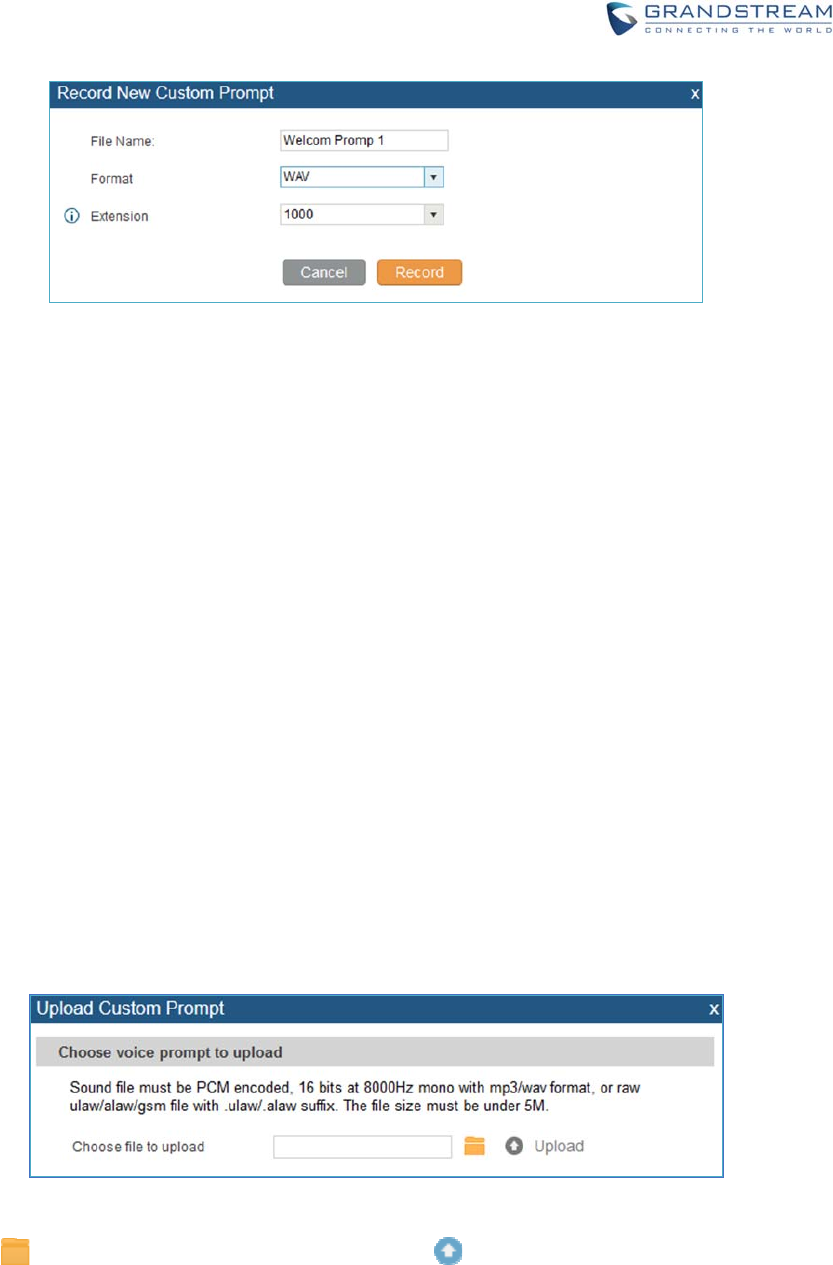
Firmware Version 1.0.0.1 UCM6200 Series IP PBX User Manual Page 193 of 320
Figure 112: Record New Custom Prompt
Specify the IVR file name.
Select the format (GSM or WAV) for the IVR prompt file to be recorded.
Select the extension to receive the call from the UCM6200 to record the IVR prompt.
Click the “Record” button. A request will be sent to the UCM6200. The UCM6200 will then call the
extension for recording the IVR prompt from the phone.
Pick up the call from the extension and start the recording following the voice prompt.
The recorded file will be listed in the IVR Prompt web page. Users could select to re-record, play or
delete the recording.
UPLOADCUSTOMPROMPT
If the user has a pre-recorded IVR prompt file, click on “Upload Custom Prompt” in Web
GUI->PBX->Internal Options->Custom Prompt page to upload the file to the UCM6200. The following
are required for the IVR prompt file to be successfully uploaded and used by the UCM6200:
PCM encoded.
16 bits.
8000Hz mono.
In .mp3 or .wav format; or raw/ulaw/alaw/gsm file with .ulaw or .alaw suffix.
File size under 5M.
Figure 113: Upload Custom Prompt
Click on to select audio file from local PC and click on to start uploading. Once uploaded, the file
will appear in the Custom Prompt web page.
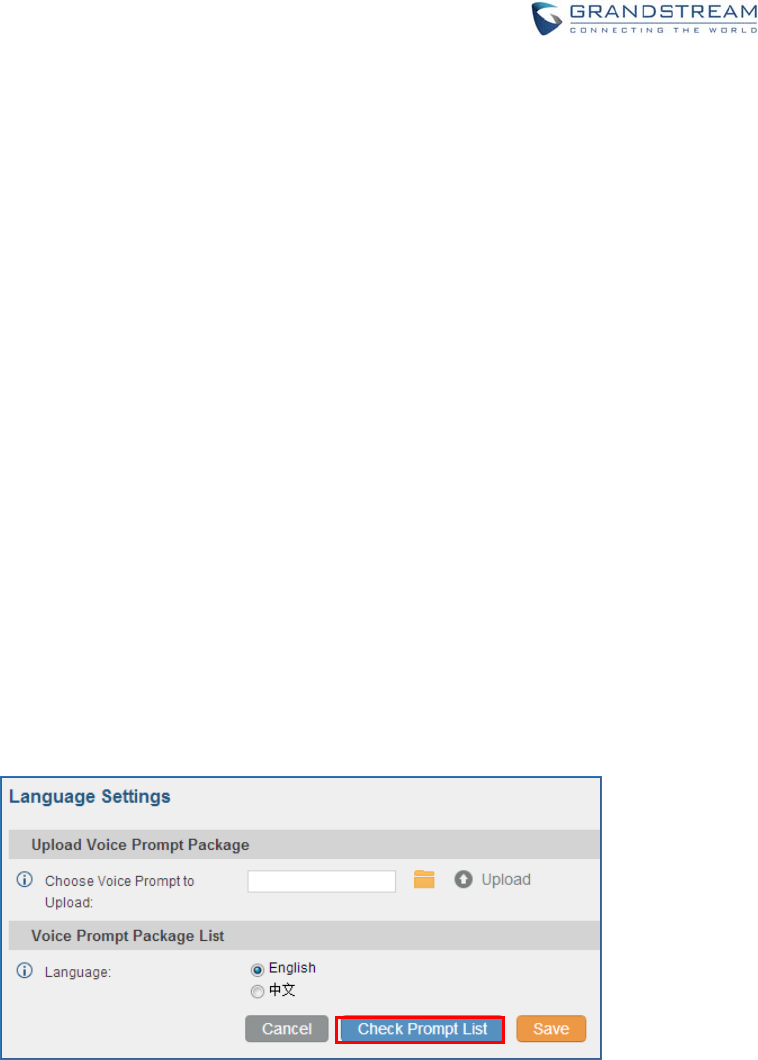
Firmware Version 1.0.0.1 UCM6200 Series IP PBX User Manual Page 194 of 320
LANGUAGESETTINGSFORVOICEPROMPT
The UCM6200 supports multiple languages in web GUI as well as system voice prompt. Currently, there
are 16 languages supported in system voice prompt: English (United States), Arabic, Chinese, Dutch,
English (United Kingdom), French, German, Greek, Hebrew, Italian, Polish, Portuguese, Russian,
Spanish, Swedish and Turkish.
English (United States) and Chinese voice prompts are built in with the UCM6200 already. The other
languages provided by Grandstream can be downloaded and installed from the UCM6200 web GUI
directly. Additionally, users could customize their own voice prompts, package them and upload to the
UCM6200.
Language settings for voice prompt can be accessed under Web GUI->PBX->Internal
Options->Language.
DOWNLOADANDINSTALLVOICEPROMPTPACKAGE
To download and install voice prompt package in different languages from UCM6200 web GUI, click on
"Check Prompt List" button.
Figure 114: Language Settings for Voice Prompt
A new dialog window of voice prompt package list will be displayed. Users can see the version number
(latest version available V.S. current installed version), package size and options to upgrade or download
the language.
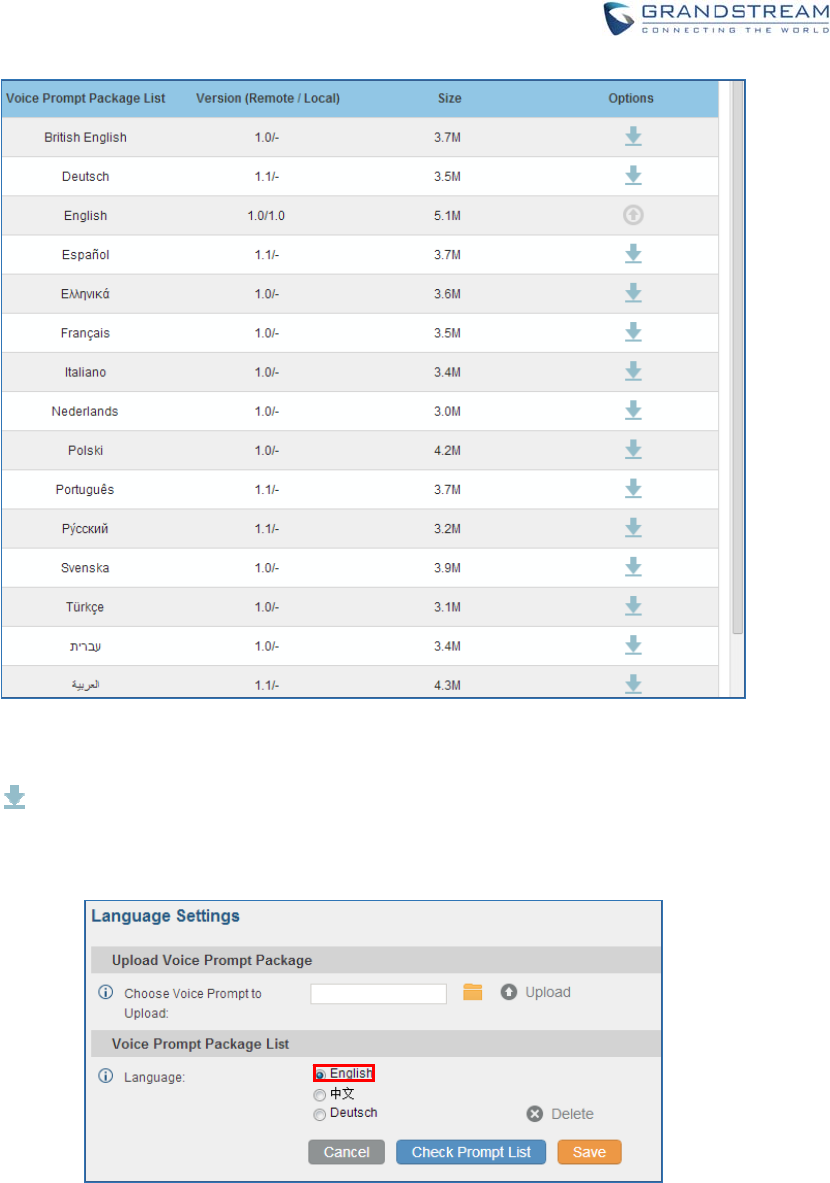
Firmware Version 1.0.0.1 UCM6200 Series IP PBX User Manual Page 195 of 320
Figure 115: Voice Prompt Package List
Click on to download the language to the UCM6200. The installation will be automatically started
once the downloading is finished.
Figure 116: New Voice Prompt Language Added
A new language option will be displayed after successfully installed. Users then could select it to apply in
the UCM6200 system voice prompt or delete it from the UCM6200.
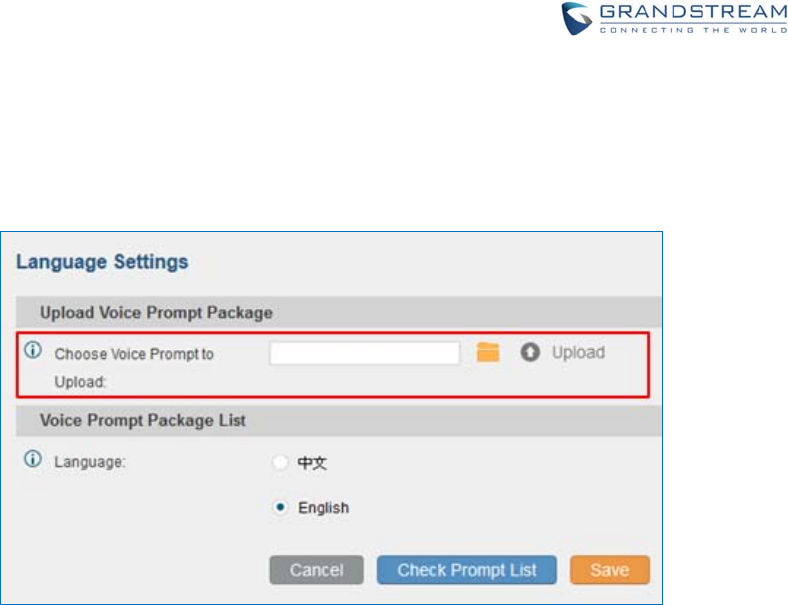
Firmware Version 1.0.0.1 UCM6200 Series IP PBX User Manual Page 196 of 320
CUSTOMIZESPECIFICPROMPT
On the UCM6200, if the user needs to replace some specific customized prompt, the user can upload a single
specific customized prompt from web UI->PBX->Internal Options->Language instead of the entire language
pack.
Figure 117: Upload Single Voice Prompt for Entire Language Pack

Firmware Version 1.0.0.1 UCM6200 Series IP PBX User Manual Page 197 of 320

Firmware Version 1.0.0.1 UCM6200 Series IP PBX User Manual Page 198 of 320
VOICEMAIL
CONFIGUREVOICEMAIL
If the voicemail is enabled for UCM6200 extensions, the configurations of the voicemail can be globally set
up and managed under Web GUI->PBX->Call Features->Voicemail.
Table 62: Voicemail Settings
Max Greeting Configure the maximum number of seconds for the voicemail greeting.
The default setting is 60 seconds.
Dial ‘0’ For Operator
If enabled, the caller can press 0 to exit the voicemail application and
connect to the configured operator’s extension. The operator extension
can be configured under web GUI->PBX->Internal Options->General.
Max Messages Per Folder Configure the maximum number of messages per folder in users’
voicemail. The valid range 10 to 1000. The default setting is 50.
Max Message Time
Select the maximum duration of the voicemail message. The message
will not be recorded if the duration exceeds the max message time. The
default setting is 15 minutes. The available options are:
1 minute
2 minutes
5 minutes
15 minutes
30 minutes
Unlimited
Min Effective Message Time
Configure the minimum duration (in seconds) of a voicemail message.
Messages will be automatically deleted if the duration is shorter than the
Min Message Time. The default setting is 3 seconds. The available
options are:
No minimum
1 second
2 seconds
3 seconds
4 seconds
5 seconds
Note:
Silence and noise duration are not counted in message time.
Announce Message Caller-ID If enabled, the caller ID of the user who has left the message will be
announced at the beginning of the voicemail message. The default setting
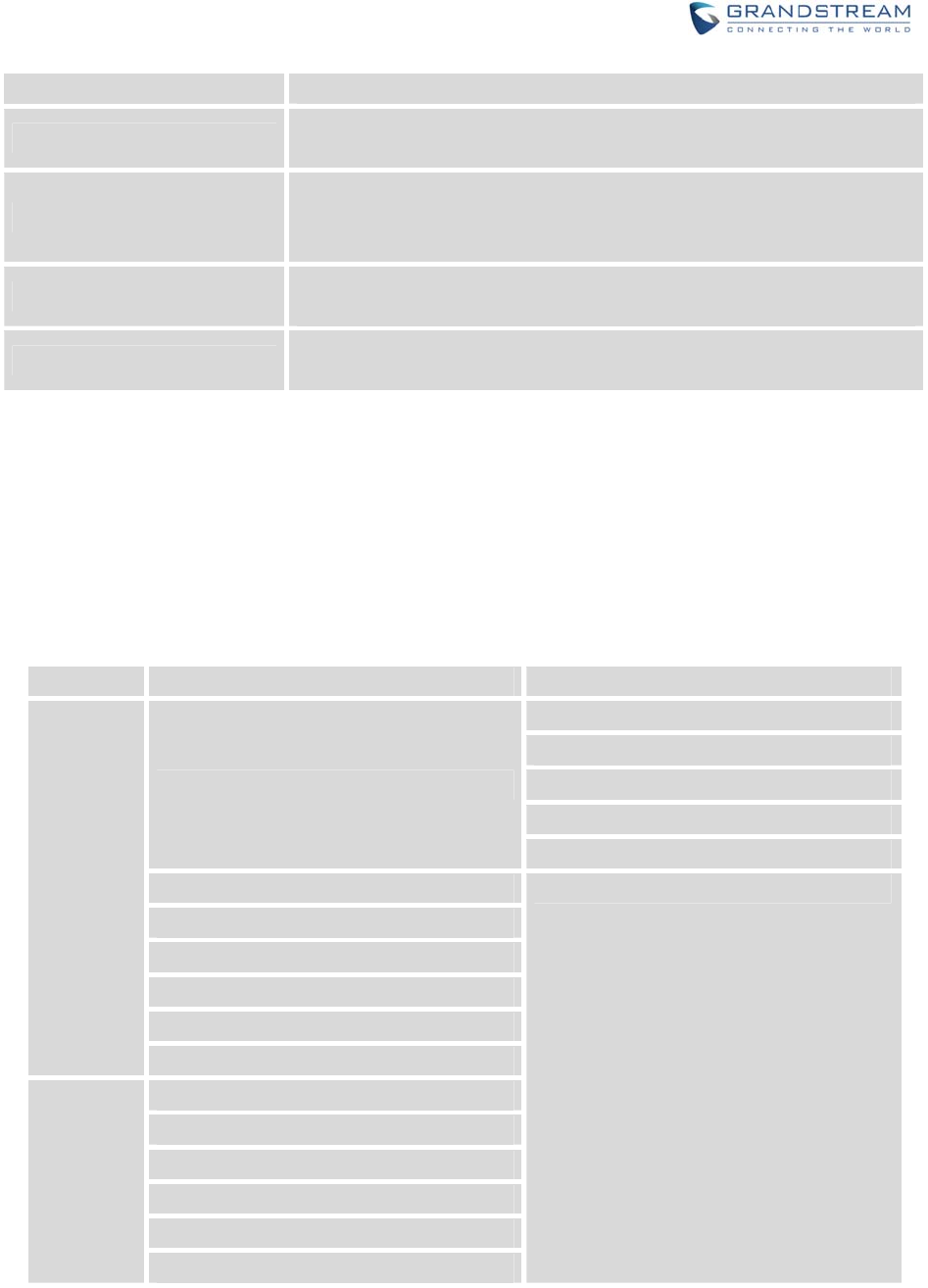
Firmware Version 1.0.0.1 UCM6200 Series IP PBX User Manual Page 199 of 320
is "No".
Announce Message Duration If enabled, the message duration will be announced at the beginning of
the voicemail message. The default setting is "No".
Play Envelope
If enabled, a brief introduction (received time, received from, and etc) of
each message will be played when accessed from the voicemail
application. The default setting is "Yes".
Play from Last If enabled, UCM will play from the voice message left most recently; if
disabled, UCM will play from the earliest left voice message
Allow User Review If enabled, users can review the message following the IVR before
sending the message out. The default setting is "No".
ACCESSVOICEMAIL
If the voicemail is enabled for UCM6200 extensions, the users can dial the voicemail access feature code
(by default *98 or *97) to access the extension’s voicemail. The users will be prompt to enter the voicemail
password and then can enter digits from the phone keypad to navigate in the IVR menu for different
options.
Table 63: Voicemail IVR Menu
Main Menu Sub Menu 1 Sub Menu 2
1 - New
messages
3 - Advanced options
1 - Send a reply
2 - Call the person who sent this message
3 - Hear the message envelop
4 - Leave a message
* - Return to the main menu
5 - Repeat the current message
7 - Delete this message
8 - Forward the message to another user
9 – Save
* - Help
# - Exit
2 - Change
folders
0 - New messages
1 - Old messages
2 - Work messages
3 - Family messages
4 - Friend messages
# - Cancel
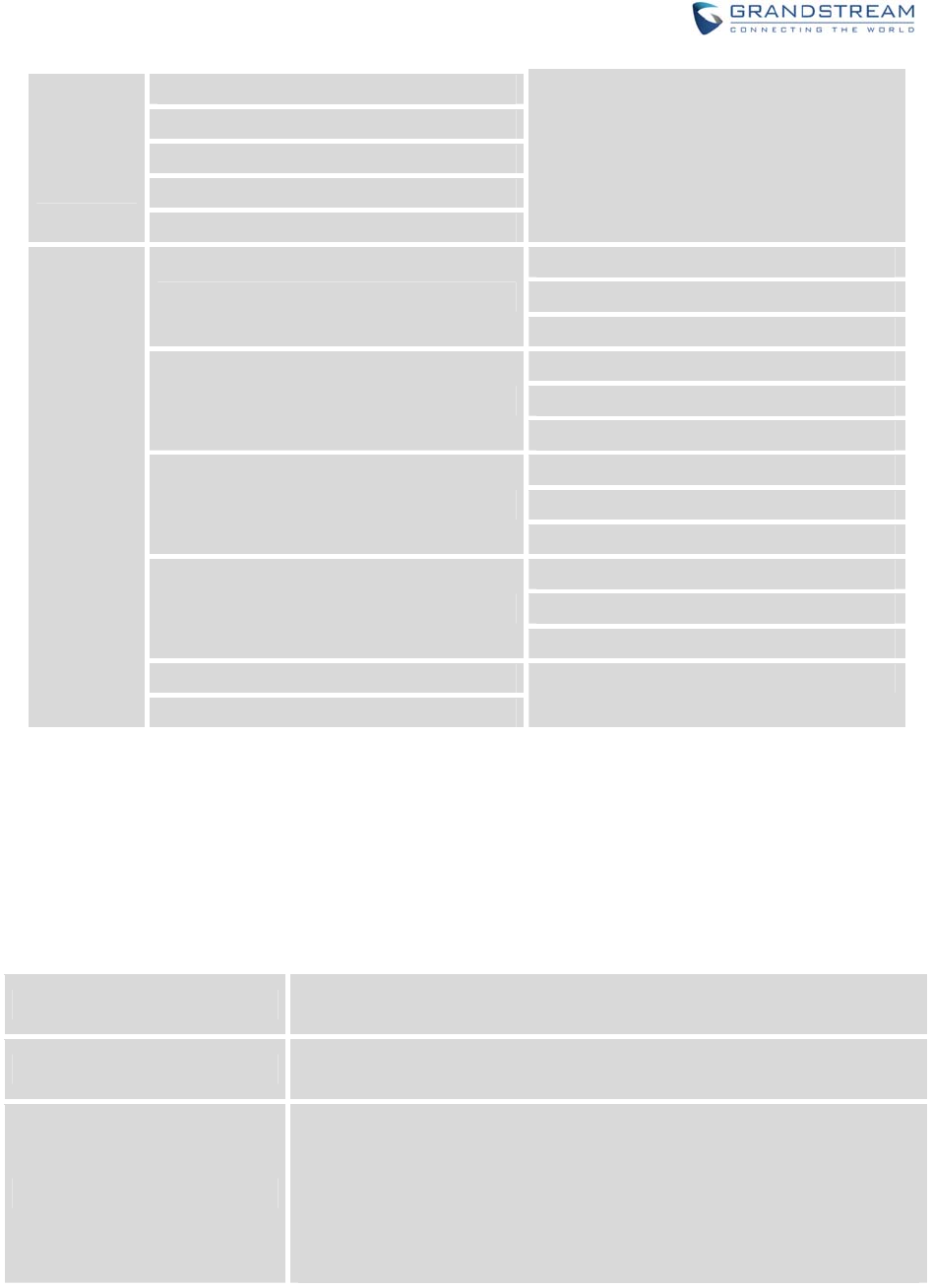
Firmware Version 1.0.0.1 UCM6200 Series IP PBX User Manual Page 200 of 320
3 -
Advanced
options
1 - Send a reply
2 - Call the person who sent this message
3 - Hear the message envelop
4 - Leave a message
* - Return to the main menu
0 - Mailbox
options
1 - Record your unavailable message
1 - Accept this recording
2 - Listen to it
3 - Re-record your message
2 - Record your busy message
1 - Accept this recording
2 - Listen to it
3 - Re-record your message
3 - Record your name
1 - Accept this recording
2 - Listen to it
3 - Re-record your message
4 - Record temporary greeting
1 - Accept this recording
2 - Listen to it
3 - Re-record your message
5 - Change your password
* - Return to the main menu
VOICEMAILEMAILSETTINGS
The UCM6200 can be configured to send the voicemail as attachment to Email. Click on "Voicemail Email
Settings" button to configure the Email attributes and content.
Table 64: Voicemail Email Settings
Attach Recordings to E-Mail If enabled, voicemails will be sent to user's Email address. The default
setting is "Yes".
Keep Recordings If enabled, voicemail will be stored in the UCM6200 after the email is sent.
The default setting is “Yes”.
Template For Voicemail Emails
Fill in the "Subject:" and "Message:" content, to be used in the Email
when sending to the user.
The template variables are:
\t: TAB
${VM_NAME}: Recipient's first name and last name
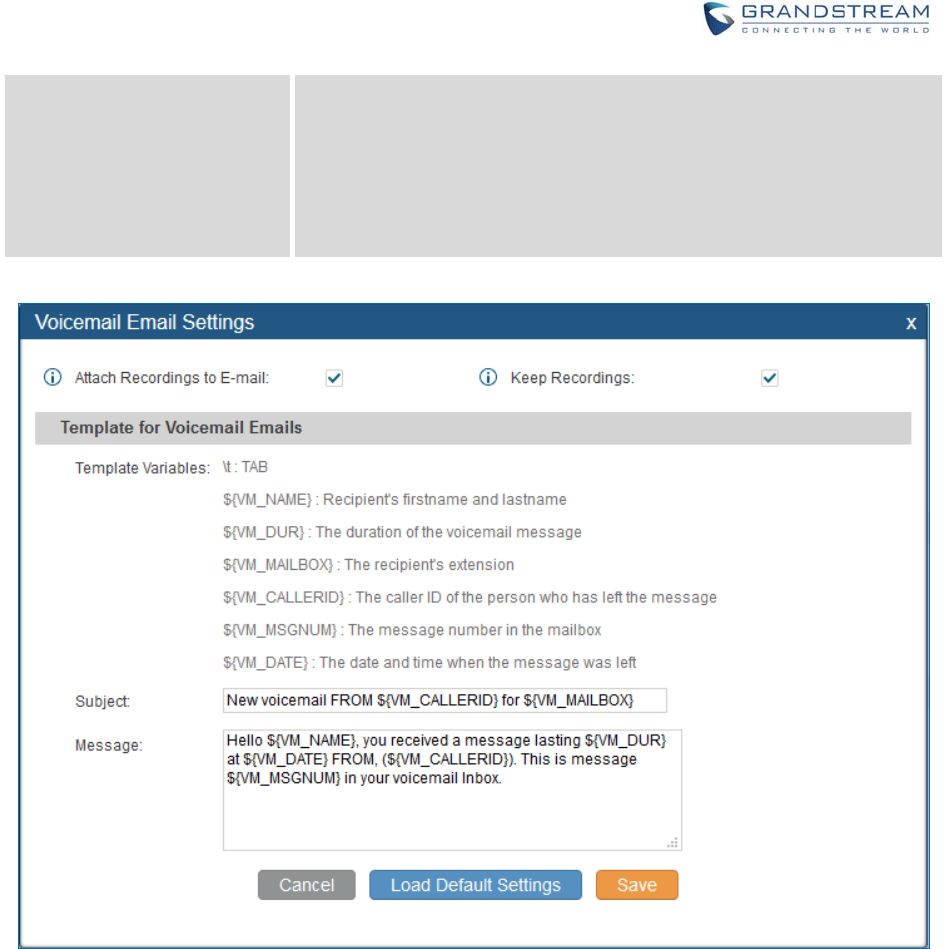
Firmware Version 1.0.0.1 UCM6200 Series IP PBX User Manual Page 201 of 320
${VM_DUR}: The duration of the voicemail message
${VM_MAILBOX}: The recipient's extension
${VM_CALLERID}: The caller ID of the person who has left the
message
${VM_MSGNUM}: The number of messages in the mailbox
${VM_DATE}: The date and time when the message is left
Figure 118: Voicemail Email Settings
Click on "Load Default Settings" button to view the default template as an example.
CONFIGUREVOICEMAILGROUP
The UCM6200 supports voicemail group and all the extensions added in the group will receive the
voicemail to the group extension. The voicemail group can be configured under Web GUI->PBX->Call
Features->Voicemail Group. Click on "Create New Voicemail Group" to configure the group.
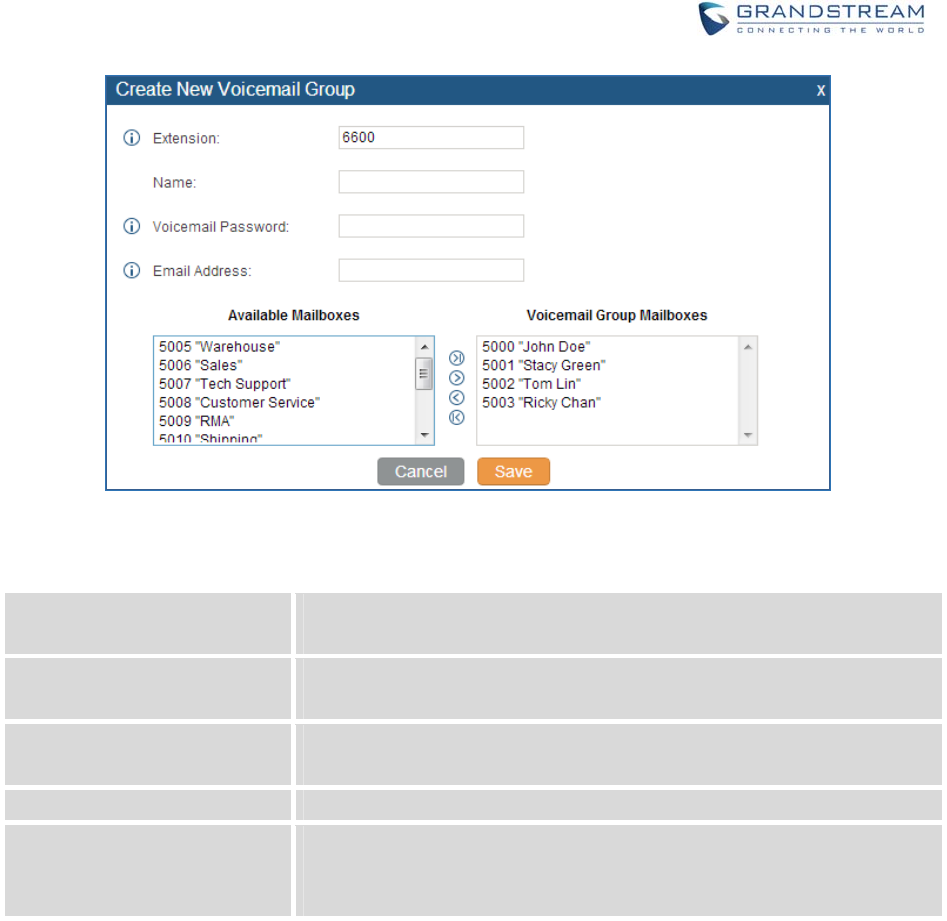
Firmware Version 1.0.0.1 UCM6200 Series IP PBX User Manual Page 202 of 320
Figure 119: Voicemail Group
Table 65: Voicemail Group Settings
Extension Enter the Voicemail Group Extension. The voicemail messages left to this
extension will be forwarded to all the voicemail group members.
Name Configure the Name to identify the voicemail group. Letters, digits, _ and -
are allowed.
Voicemail Password Configure the voicemail password for the users to check voicemail
messages.
Email Address Configure the Email address for the voicemail group extension.
Voicemail Group Mailboxes
Select available mailboxes from the left list and add them to the right list.
The extensions need to have voicemail enabled to be listed in available
mailboxes list.

Firmware Version 1.0.0.1 UCM6200 Series IP PBX User Manual Page 203 of 320
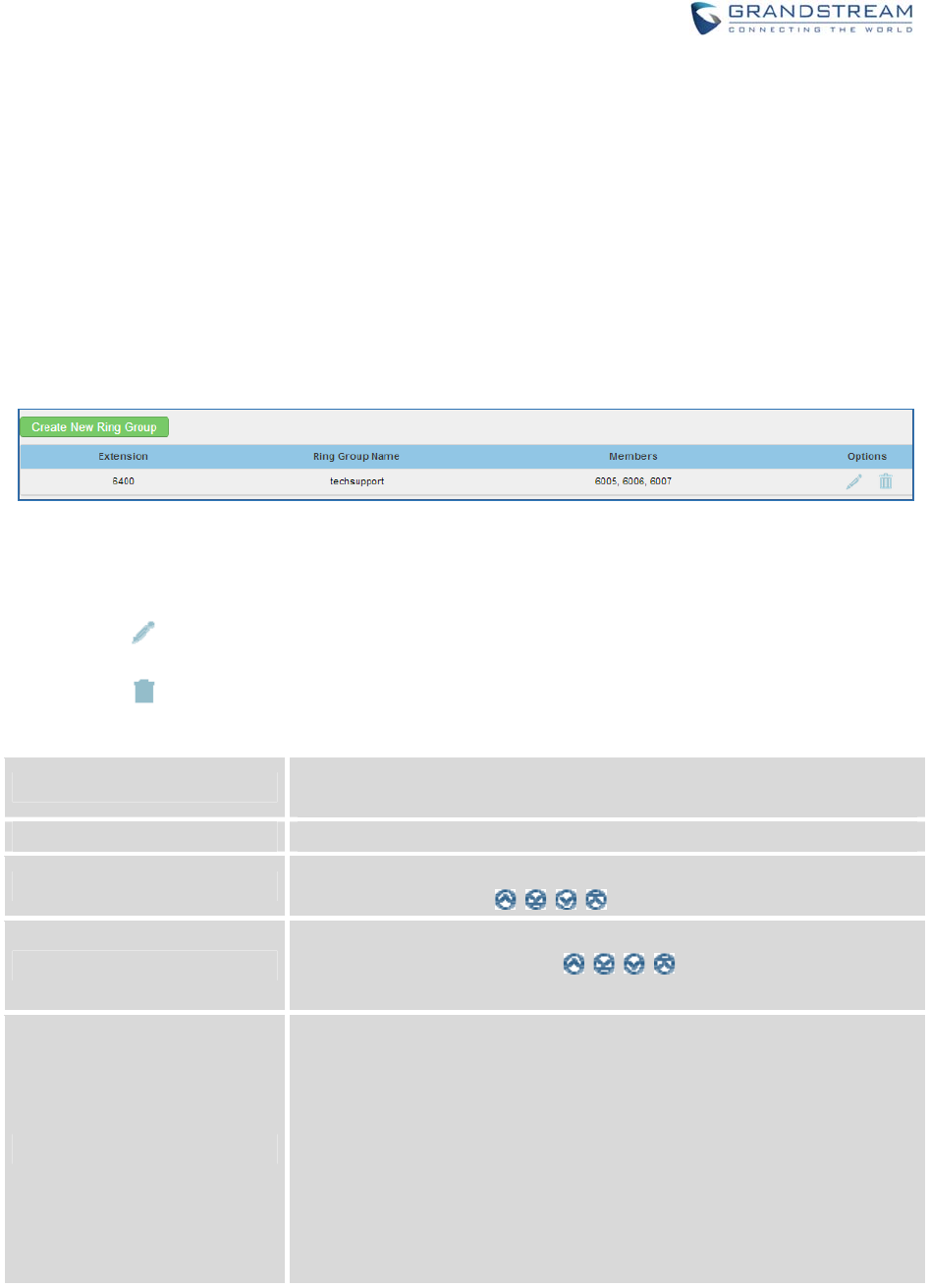
Firmware Version 1.0.0.1 UCM6200 Series IP PBX User Manual Page 204 of 320
RINGGROUP
The UCM6200 supports ring group feature with different ring strategies applied to the ring group members.
This section describes the ring group configuration on the UCM6200.
CONFIGURERINGGROUP
Ring group settings can be accessed via Web GUI->PBX->Call Features->Ring Group.
Figure 120: Ring Group
Click on “Create New Ring Group” to add ring group.
Click on to edit the ring group. The following table shows the ring group configuration parameters.
Click on to delete the ring group.
Table 66: Ring Group Parameters
Ring Group Name Configure ring group name to identify the ring group. Letters, digits, _ and
– are allowed.
Extension Configure the ring group extension.
Ring Group Members Select available users from the left side to the ring group member list on
the right side. Click on to arrange the order.
Selected LDAP Numbers
Select available remote users from the left side to the ring group member
list on the right side. Click on to arrange the order. Note:
LDAP Sync must be enabled first.
Ring Strategy
Select the ring strategy. The default setting is “Ring in order”.
Ring simultaneously.
Ring all the members at the same time when there is incoming call to
the ring group extension. If any of the member answers the call, it will
stop ringing.
Ring in order.
Ring the members with the order configured in ring group list. If the
first member doesn’t answer the call, it will stop ringing the first
member and start ringing the second member.
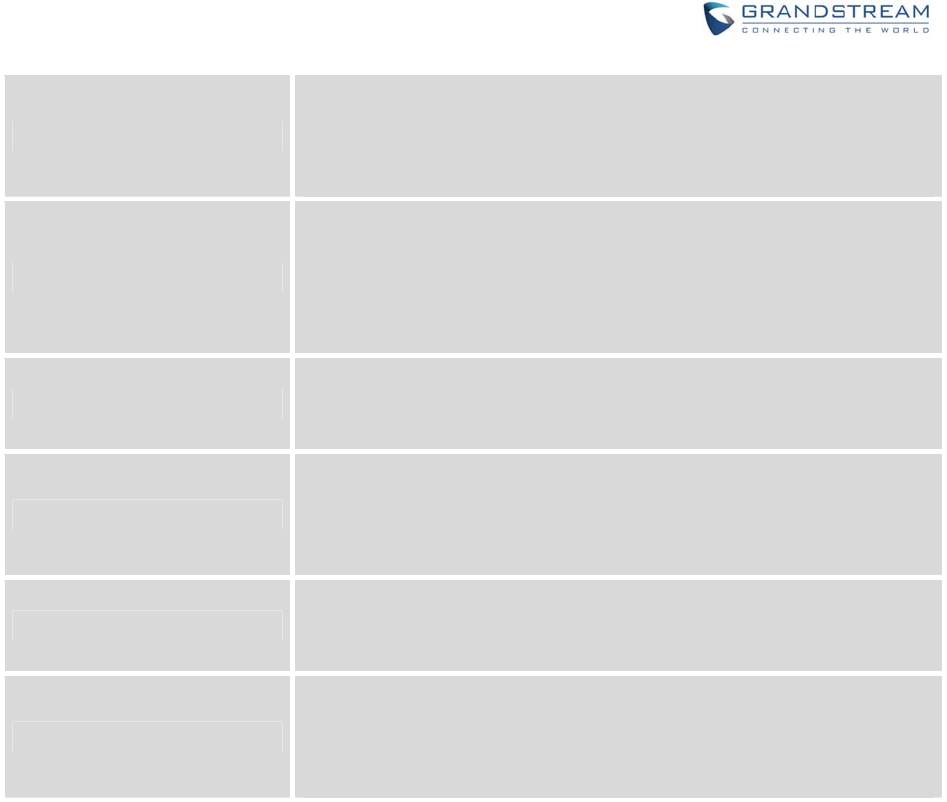
Firmware Version 1.0.0.1 UCM6200 Series IP PBX User Manual Page 205 of 320
Custom Prompt
This option is to set a custom prompt for a ring group to announce to
caller. Click on ‘Prompt’, it will direct to the page PBX->Internal
Options->Custom Prompt, where users could record new prompt or
upload prompt files.
Ring Timeout on Each Member
Configure the number of seconds to ring each member. If set to 0, it will
keep ringing. The default setting is 30 seconds.
Note:
The actual ring timeout might be overridden by users if the phone has ring
timeout settings as well.
Auto Record
If enabled, calls on this ring group will be automatically recorded. The
default setting is No. The recording files can be accessed from web
GUI->CDR->Recording Files.
Enable Destination
If enabled, users could select extension, voicemail, ring group, IVR, call
queue, voicemail group as the destination if the call to the ring group has
no answer. Secret and Email address are required if voicemail is selected
as the destination.
Secret
Configure the password to access the ring group extension's voicemail.
Note:
The password has to be at least 4 characters.
Email Address
Configure the Email address of the ring group extension's voicemail. If
"Attach Recordings to E-mail" is enabled from Web
GUI->PBX->Voicemail->Voicemail Email Settings, the voicemail can
be sent to the ring group's Email address as attachment.
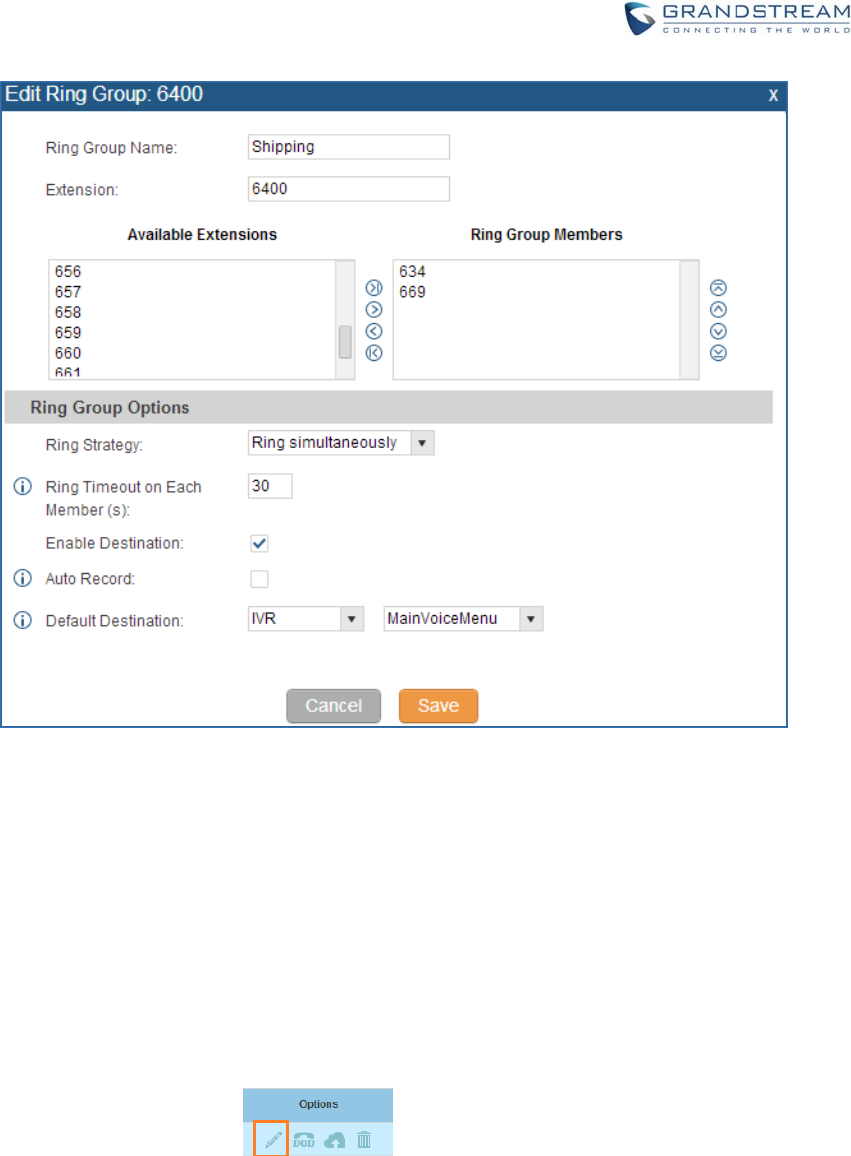
Firmware Version 1.0.0.1 UCM6200 Series IP PBX User Manual Page 206 of 320
Figure 121: Ring Group Configuration
REMOTEEXTENSIONINRINGGROUP
Remote extensions from the peer trunk of a remote UCM6200 can be included in the ring group with local
extension. An example of Ring Group with peer extensions is presented in the following:
1. Creating SIP Peer Trunk between both UCM6200_A and UCM6200_B. SIP Trunk can be found under
web UI-> PBX-> Basic/Call Routes-> VoIP Trunks. Also, please configure their Inbound/Outbound
routes accordingly.
2. Click edit button in the menu , and check if Sync LDAP Enable is selected, this
option will allow UCM6200_A update remote LDAP server automatically from peer UCM6200_B. In
addition, Sync LDAP Password must match for UCM6200_A and UCM6200_B in order to sync LDAP
contact automatically. Port number can be anything between 0~65535, and use the outbound rule
created in step 1 for the LDAP Outbound Rule option.
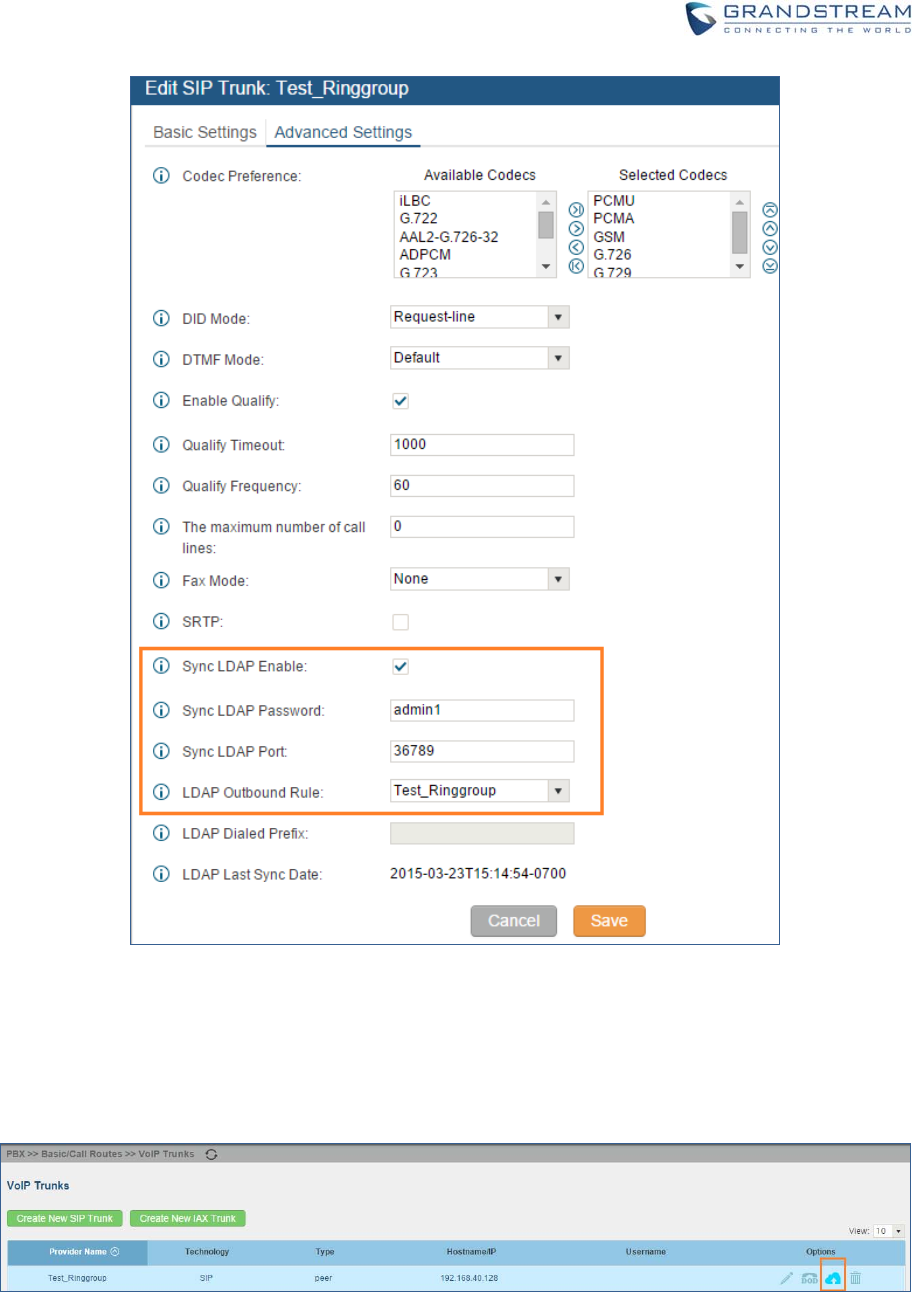
Firmware Version 1.0.0.1 UCM6200 Series IP PBX User Manual Page 207 of 320
Figure 122: Sync LDAP Server option
3. In case if LDAP server doesn’t sync automatically, user can manually sync LDAP server. Under VoIP
Trunks page, click sync button shown in the following figure to manually sync LDAP contacts from
peer UCM6200.
Figure 123: Manually Sync LDAP Server
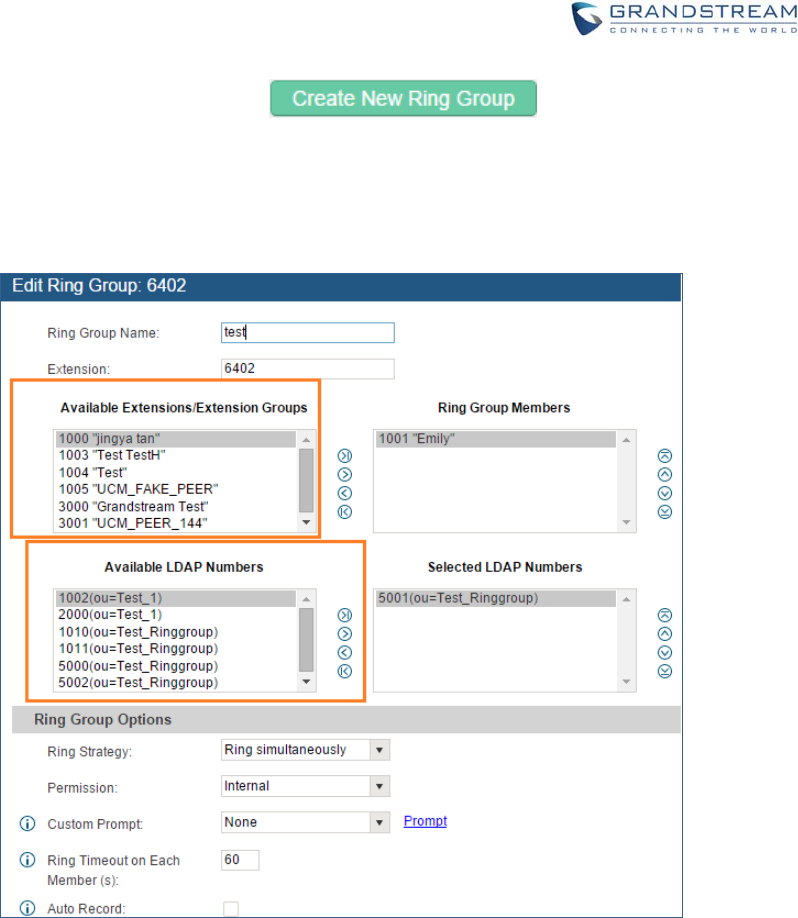
Firmware Version 1.0.0.1 UCM6200 Series IP PBX User Manual Page 208 of 320
4. Under Ring Groups setting page, click . Ring Groups can be found
under web UI-> PBX-> Call Features-> Ring Groups.
5. If LDAP server is synced correctly, Available LDAP Numbers box will display available remote
extensions that can be included in the current ring group. Please also make sure the extensions in the
peer UCM6200 can be included into that UCM6200’s LDAP contact.
Figure 124: Ring Group Remote Extension

Firmware Version 1.0.0.1 UCM6200 Series IP PBX User Manual Page 209 of 320
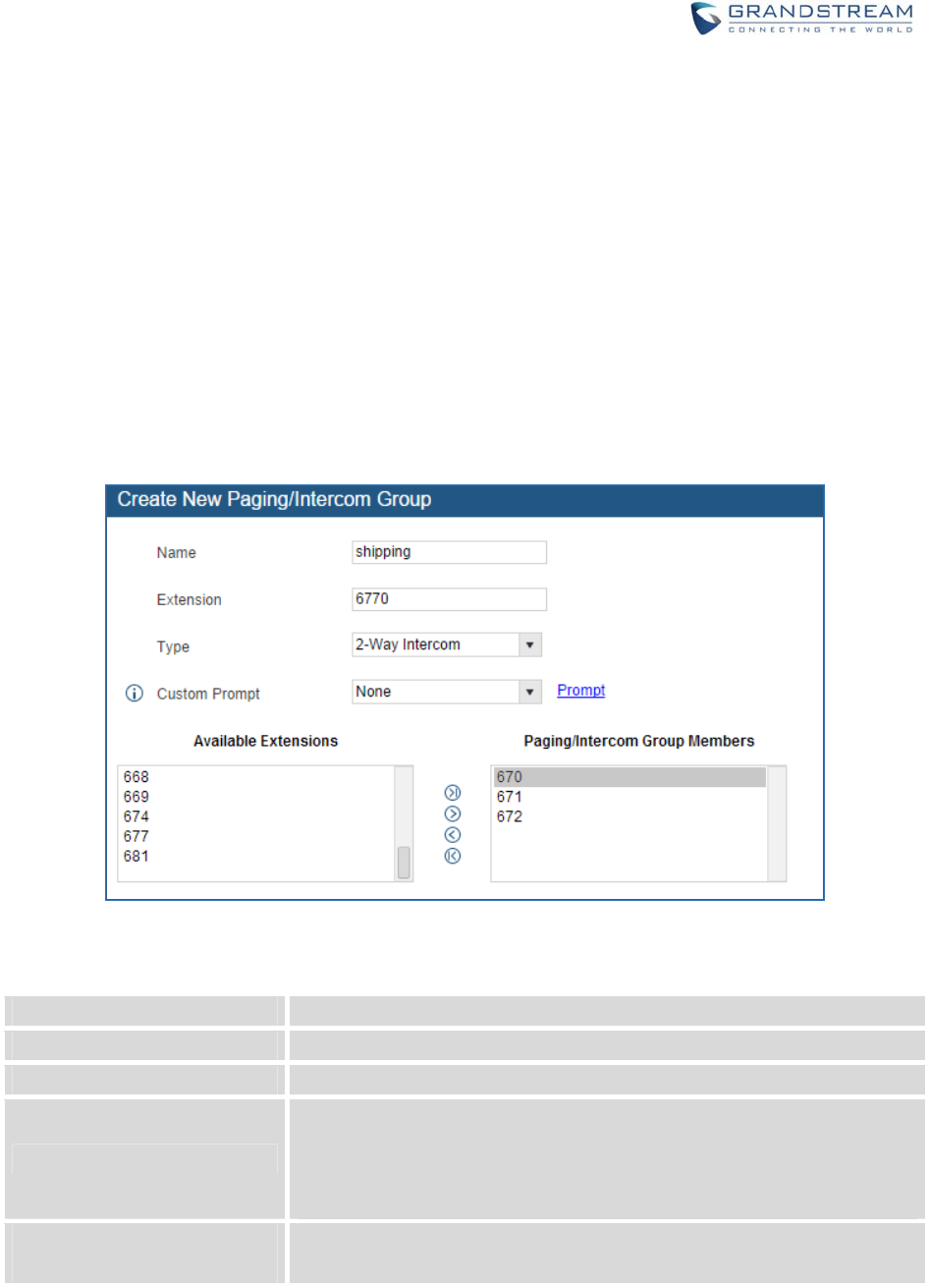
Firmware Version 1.0.0.1 UCM6200 Series IP PBX User Manual Page 210 of 320
PAGINGANDINTERCOMGROUP
Paging and Intercom Group can be used to make an announcement over the speaker on a group of
phones. Targeted phones will answer immediately using speaker. The UCM6200 paging and intercom can
be used via feature code to a single extension or a paging/intercom group. This sections describes the
configuration of paging/intercom group under Web GUI->PBX->Call Features->Paging/Intercom.
CONFIGUREPAGING/INTERCOMGROUP
Click on "Create New Paging/Intercom Group" to add paging/intercom group.
Figure 125: Paging/Intercom Group
Table 67: Paging/Intercom Group Configuration Parameters
Name Configure paging/intercom group name.
Extension Configure the paging/intercom group extension.
Type Select "2-way Intercom" or "1-way Page".
Custom Prompt
This option is to set a custom prompt for a paging/intercom group to
announce to caller. Click on ‘Prompt’, it will direct to the page
PBX->Internal Options->Custom Prompt, where users could record
new prompt or upload prompt files.
Page/Intercom Group
Members
Select available users from the left side to the paging/intercom group
member list on the right.
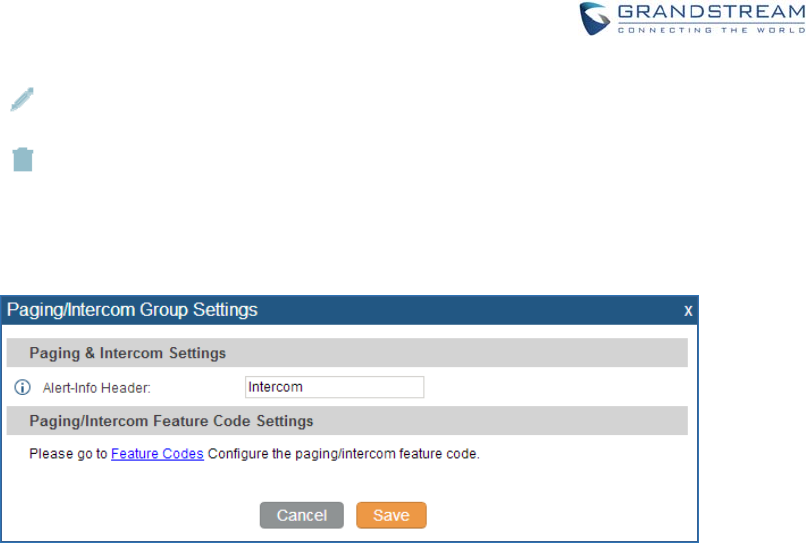
Firmware Version 1.0.0.1 UCM6200 Series IP PBX User Manual Page 211 of 320
Click on to edit the paging/intercom group.
Click on to delete the paging/intercom group.
Click on "Paging/Intercom Group Settings" to edit Alert-Info Header. This header will be included in the
SIP INVITE message sent to the callee in paging/intercom call.
Figure 126: Page/Intercom Group Settings
The UCM6200 has pre-configured paging/intercom feature code. By default, the Paging Prefix is *81
and the Intercom Prefix is *80. To edit page/intercom feature code, click on "Feature Codes" in the
"Paging/Intercom Group Settings" dialog. Or users could go to Web GUI->PBX->Internal
Options->Feature Codes directly.
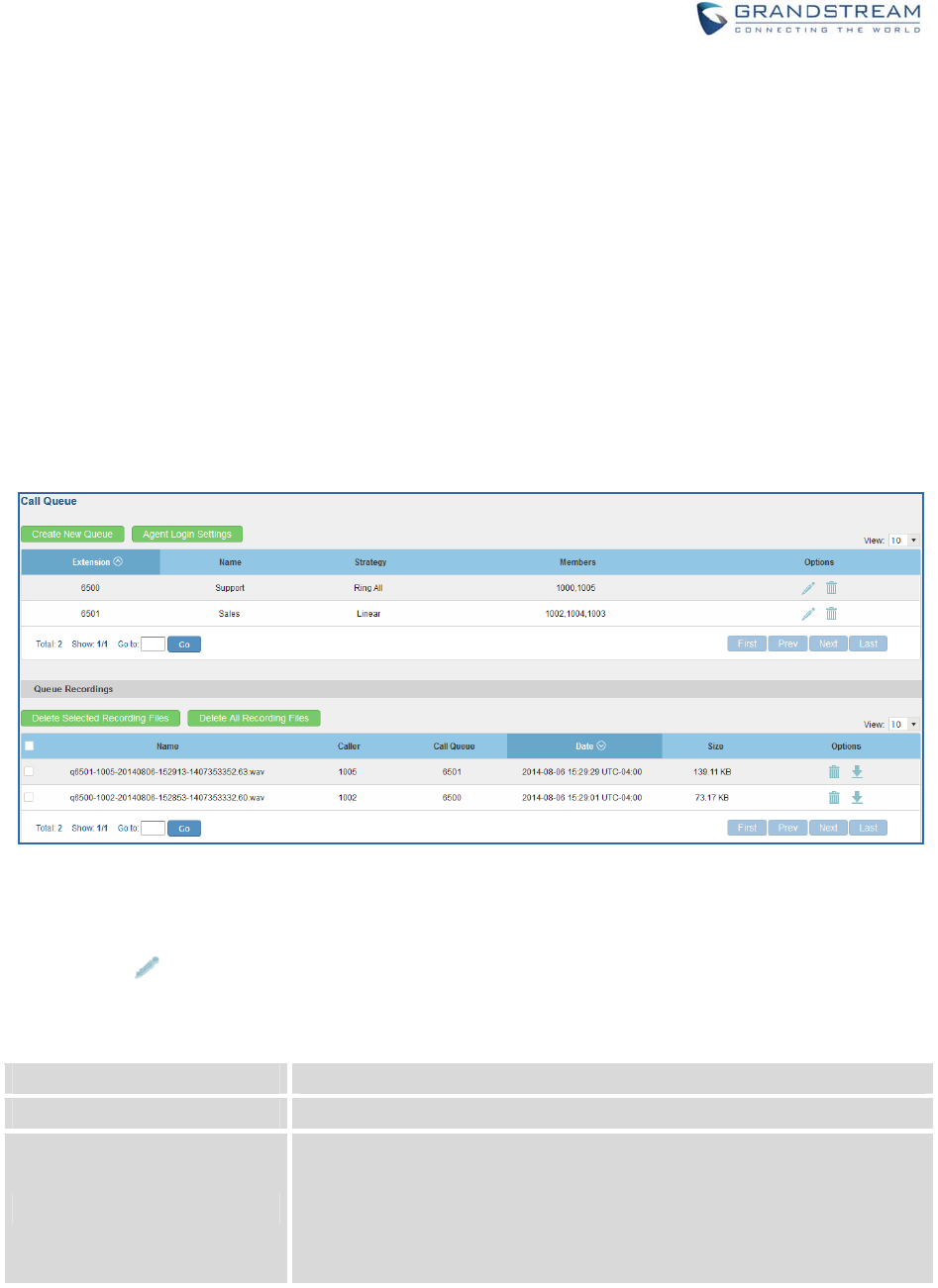
Firmware Version 1.0.0.1 UCM6200 Series IP PBX User Manual Page 212 of 320
CALLQUEUE
The UCM6200 supports call queue by using static agents or dynamic agents. Call Queue system can
accept more calls than the available agents. Incoming calls will be held until next representative is
available in the system. This section describes the configuration of call queue under Web GUI->PBX->Call
Features->Call Queue.
CONFIGURECALLQUEUE
Call queue settings can be accessed via Web GUI->PBX->Call Features->Call Queue.
Figure 127: Call Queue
Click on "Create New Queue" to add call queue.
Click on to edit the call queue. The call queue configuration parameters are listed in the table
below.
Table 68: Call Queue Configuration Parameters
Extension Configure the call queue extension.
Name Configure the call queue name to identify the call queue.
Strategy
Select the strategy for the call queue.
Ring All
Ring all available Agents simultaneously until one answers.
Linear
Ring agents in the specified order.

Firmware Version 1.0.0.1 UCM6200 Series IP PBX User Manual Page 213 of 320
Least Recent
Ring the agent who has been called the least recently.
Fewest Calls
Ring the agent with the fewest completed calls.
Random
Ring a random agent.
Round Robin
Ring the agents in Round Robin scheduling with memory.
The default setting is "Ring All".
Music On Hold
Select the Music On Hold class for the call queue.
Note:
Music On Hold classes can be managed from Web GUI-> PBX->Internal
Options->Music On Hold.
Leave When Empty
Configure whether the callers will be disconnected from the queue or not
if the queue has no agent anymore. The default setting is "Strict".
Yes
Callers will be disconnected from the queue if all agents are paused
or invalid.
No
Never disconnect the callers from the queue when the queue is
empty.
Strict
Callers will be disconnected from the queue if all agents are paused,
invalid or unavailable.
Dial in Empty Queue
Configure whether the callers can dial into a call queue if the queue has
no agent. The default setting is "No".
Yes
Callers can always dial into a call queue.
No
Callers cannot dial into a queue if all agents are paused or invalid.
Strict
Callers cannot dial into a queue if the agents are paused, invalid or
unavailable.
Dynamic Login Password If enabled, the configured PIN number is required for dynamic agent to
log in. The default setting is disabled.
Ring Time Out Configure the number of seconds an agent will ring before the call goes to
the next agent. The default setting is 15 seconds.
Wrapup Time Configure the number of seconds before a new call can ring the queue
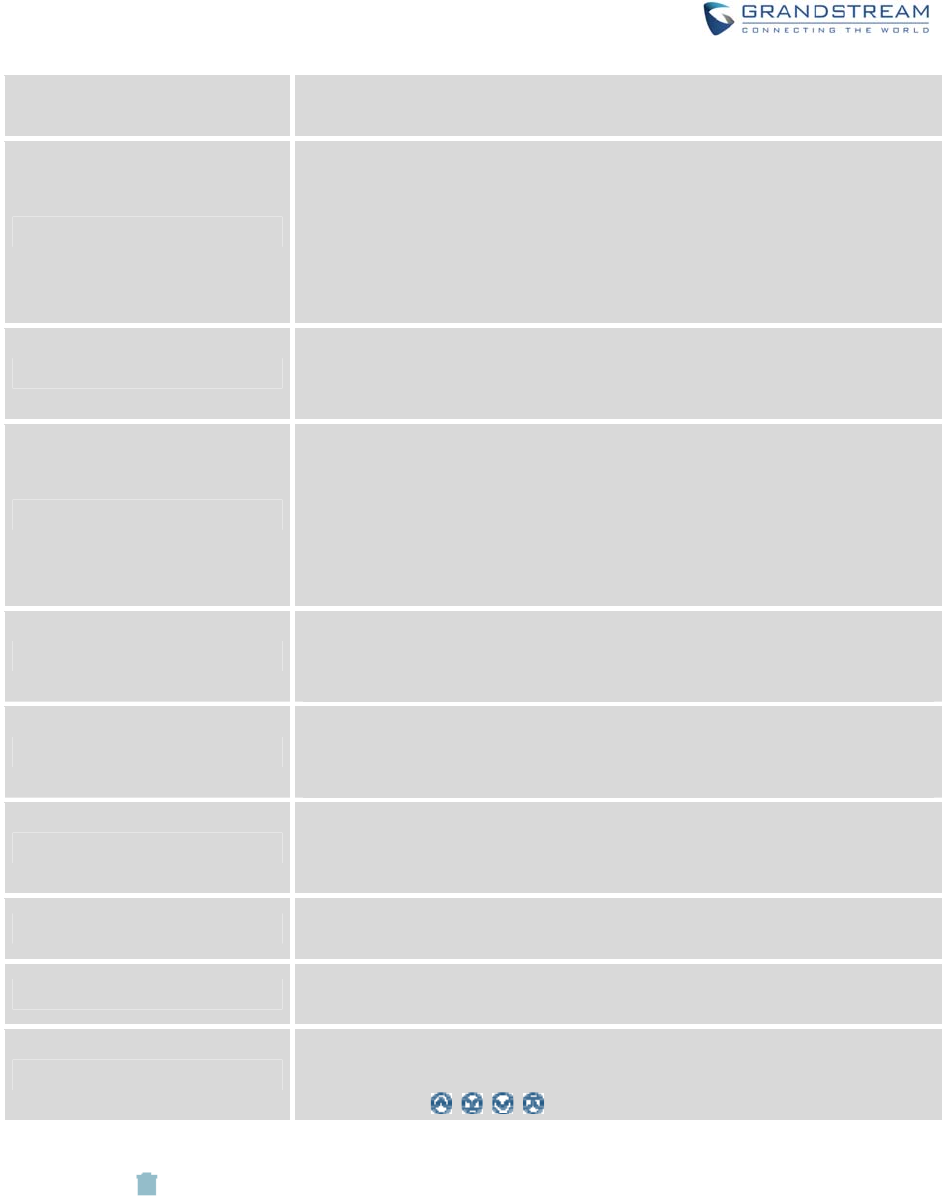
Firmware Version 1.0.0.1 UCM6200 Series IP PBX User Manual Page 214 of 320
after the last call on the agent is completed. If set to 0, there will be no
delay between calls to the queue. The default setting is 15 seconds.
Max Queue Length
Configure the maximum number of calls to be queued at once. This
number does not include calls that have been connected with agents. It
only includes calls not connected yet. The default setting is 0, which
means unlimited. When the maximum value is reached, the caller will be
treated with busy tone followed by the next calling rule after attempting to
enter the queue.
Report Hold Time
If enabled, the UCM6200 will report (to the agent) the duration of time of
the call before the caller is connected to the agent. The default setting is
"No".
Wait Time
If enabled, users will be disconnected after the configured number of
seconds. The default setting is "No".
Note:
It is recommended to configure "Wait Time" longer than the "Wrapup
Time".
Auto Record
If enabled, the calls on the call queue will be automatically recorded. The
recording files can be accessed in Queue Recordings under web
GUI->PBX->Call Features->Call Queue.
Enable Destination
If enabled, the incoming call for the call queue will be routed to the
destination configured in the next field if none of the agents answers the
call after ringing for a time of “Ring Timeout”.
Queue Timeout
Configure the global timeout (in seconds) of call queue. It must be bigger
than the value of ring timeout. The call in the queue will be transferred to
the failover destination directly if this time is exceeded.
Failover Destination Configure the call destination for the call to be routed to if no agent in this
call queue answers the call.
Enable Feature Codes Enable feature codes option for call queue. For example, *83 is used for
“Agent Pause”
Agents
Select the available users to be the static agents in the call queue.
Choose from the available users on the left to the static agents list on the
right. Click on to arrange the order.
Click on to delete the call queue.
Click on "Agent Login Settings" to configure Agent Login Extension Postfix and Agent Logout
Extension Postfix. Once configured, users could log in the call queue as dynamic agent.
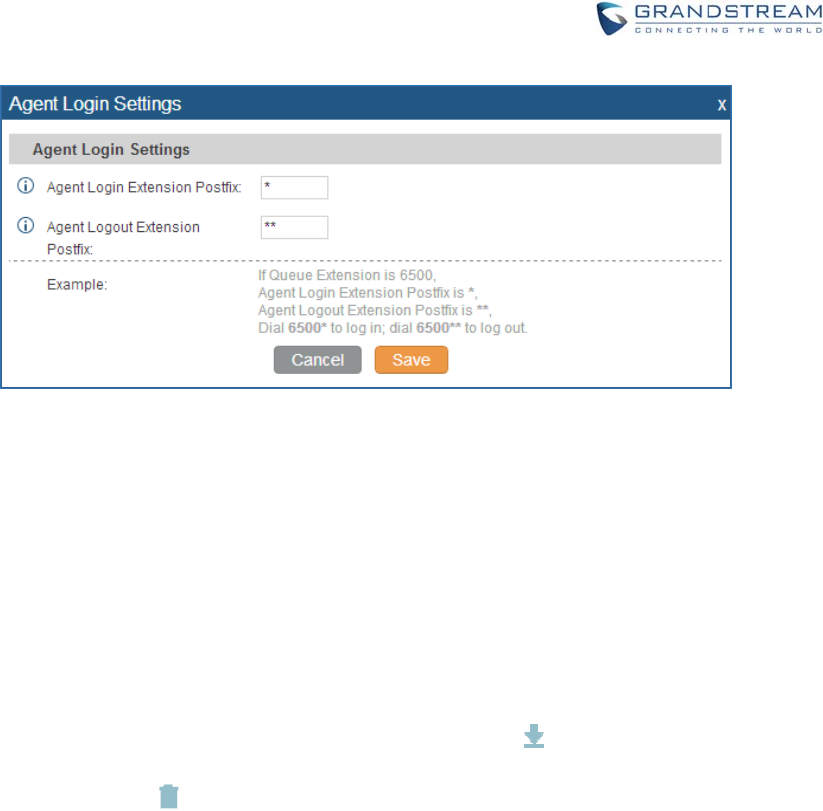
Firmware Version 1.0.0.1 UCM6200 Series IP PBX User Manual Page 215 of 320
Figure 128: Agent Login Settings
For example, if the call queue extension is 6500, Agent Login Extension Postfix is * and Agent Logout
Extension Postfix is **, users could dial 6500* to login to the call queue as dynamic agent and dial
6500** to logout from the call queue. Dynamic agent doesn't need to be listed as static agent and can
log in/log out at any time.
Call queue feature code "Agent Pause" and "Agent Unpause" can be configured under Web
GUI->PBX->Internal Options->Feature Codes. The default feature code is *83 for "Agent Pause"
and *84 for "Agent Unpause".
Queue recordings are shown on the Call Queue page. Click on to download the recording file
in .wav format; click on to delete the recording file. To delete multiple recording files by one click,
select several recording files to be deleted and click on “Delete Selected Recording Files” or click on
“Delete All Recording Files” to delete all recording files.
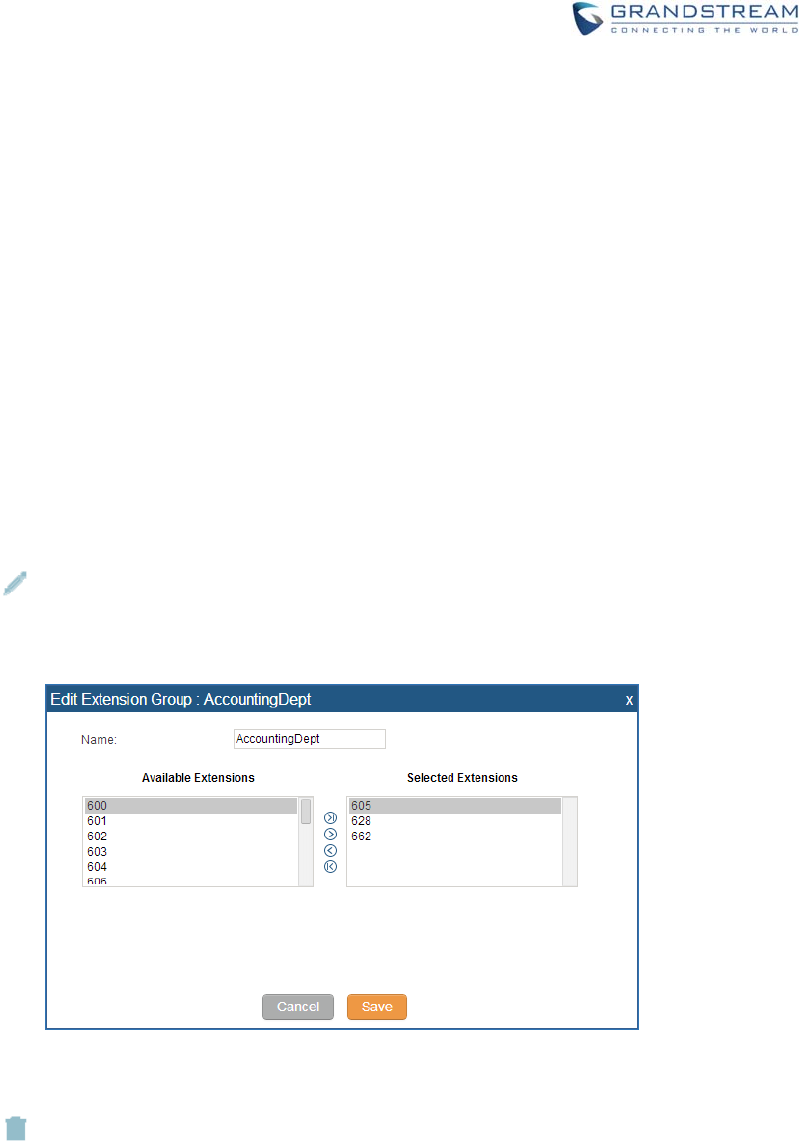
Firmware Version 1.0.0.1 UCM6200 Series IP PBX User Manual Page 216 of 320
EXTENSIONGROUPS
The UCM6200 extension group feature allows users to assign and categorize extensions in different
groups to better manage the configurations on the UCM6200. For example, when configuring "Enable
Filter on Source Caller ID", users could select a group instead of each person's extension to assign. This
feature simplifies the configuration process and helps manage and categorize the extensions for business
environment.
CONFIGUREEXTENSIONGROUPS
Extension group can be configured via Web GUI->PBX->Call Features->Extension Groups.
Click on "Create New Extension Group" to create a new extension group.
Click on to edit the extension group.
Select extensions from the list on the left side to the right side.
Figure 129: Edit Extension Group
Click on to delete the extension group.
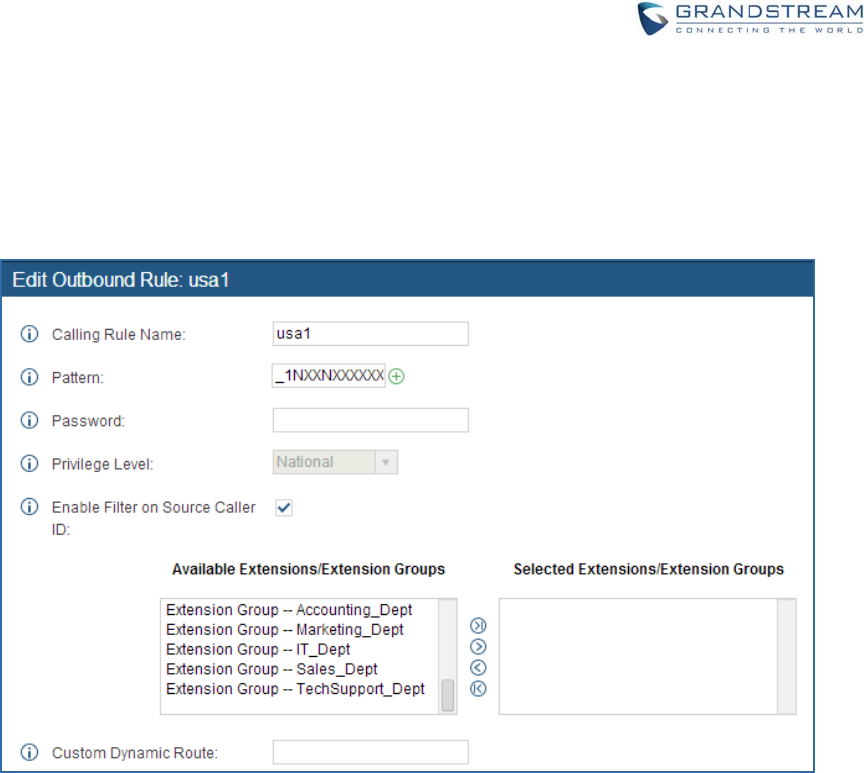
Firmware Version 1.0.0.1 UCM6200 Series IP PBX User Manual Page 217 of 320
USINGEXTENSIONGROUPS
Here is an example where the extension group can be used. Go to Web GUI->PBX->Basic/Call
Routes->Outbound Routes and select "Enable Filter on Source Caller ID". Both single extensions and
extension groups will show up for users to select.
Figure 130: Select Extension Group in Outbound Route
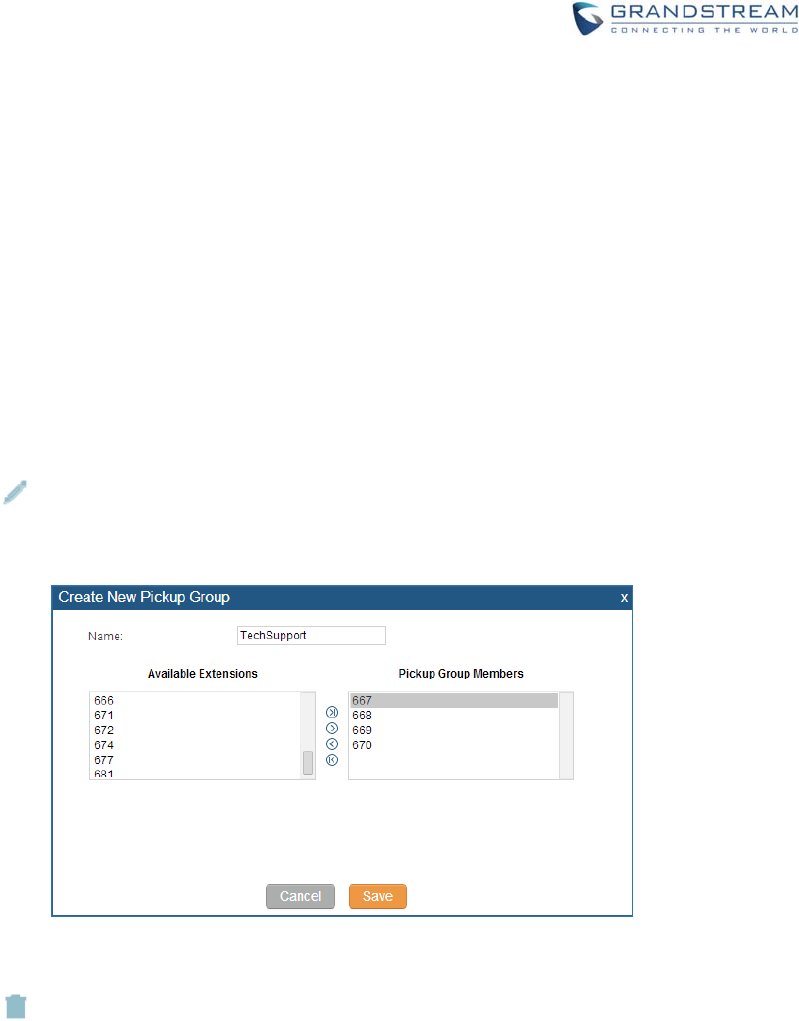
Firmware Version 1.0.0.1 UCM6200 Series IP PBX User Manual Page 218 of 320
PICKUPGROUPS
The UCM6200 supports pickup group feature which allows users to pick up incoming calls for other
extensions if they are in the same pickup group, by dialing "Pickup Extension" feature code (by default *8).
CONFIGUREPICKUPGROUPS
Pickup groups can be configured via Web GUI->PBX->Call Features->Pickup Groups.
Click on "Create New Pickup Group" to create a new pickup group.
Click on to edit the pickup group.
Select extensions from the list on the left side to the right side.
Figure 131: Edit Pickup Group
Click on to delete the pickup group.
CONFIGUREPICKUPFEATURECODE
When picking up the call for the pickup group member, the user only needs to dial the pickup feature code.
It’s not necessary to add the extension number after the pickup feature code. The pickup feature code is
configurable under Web GUI->PBX->Internal Options->Feature Codes.
The default pickup feature code is *8.
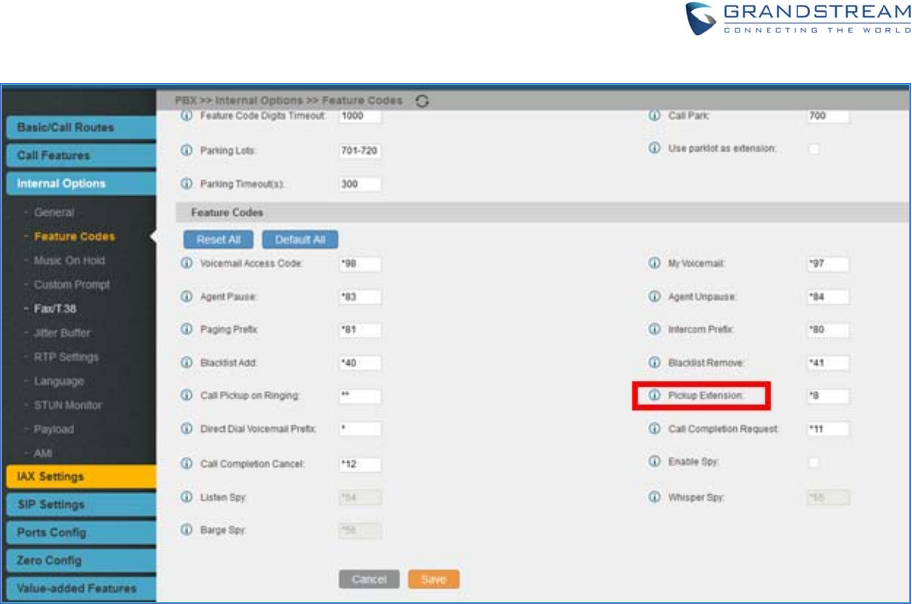
Firmware Version 1.0.0.1 UCM6200 Series IP PBX User Manual Page 219 of 320
Figure 132: Edit Pickup Feature Code
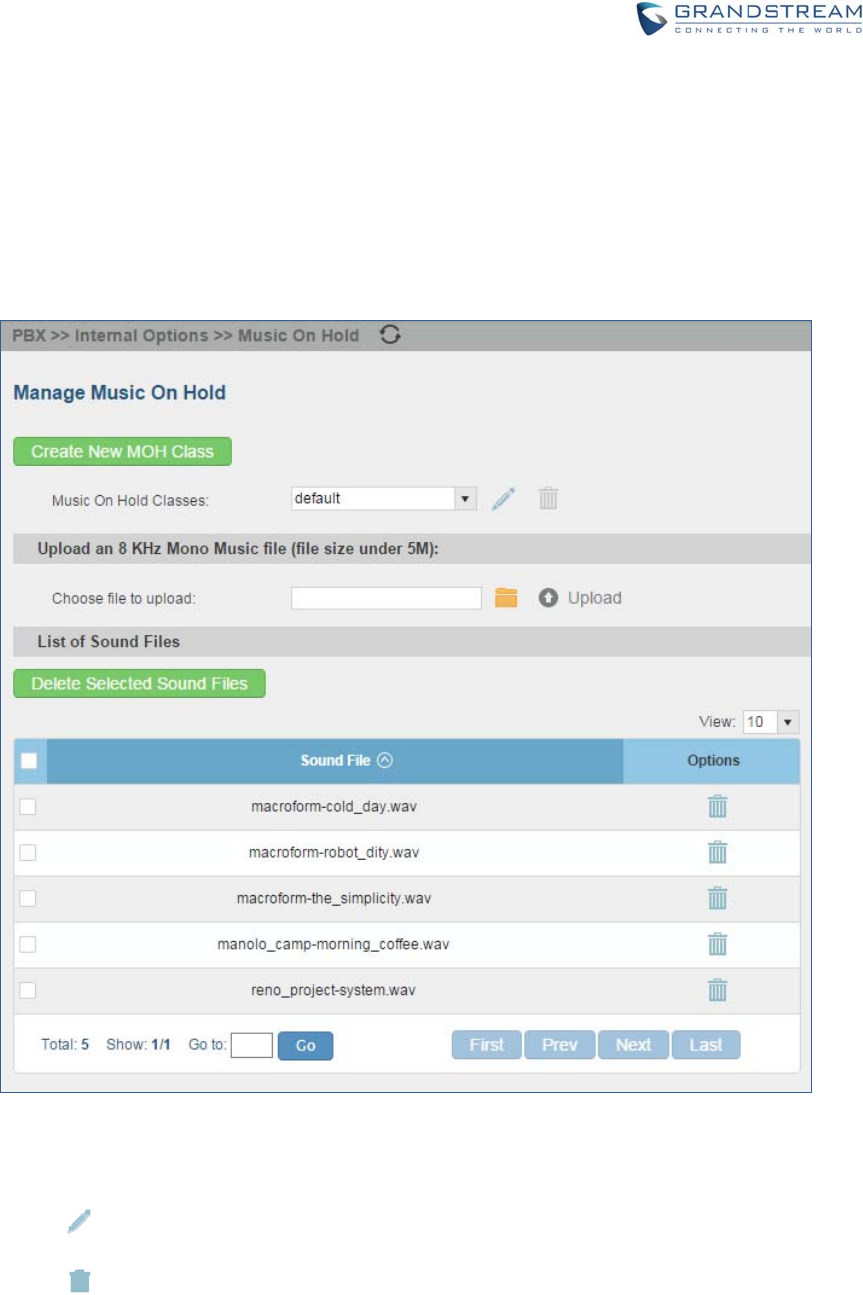
Firmware Version 1.0.0.1 UCM6200 Series IP PBX User Manual Page 220 of 320
MUSICONHOLD
Music On Hold settings can be accessed via Web GUI->PBX->Internal Options->Music On Hold. In this
page, users could configure music on hold class and upload music files. The "default" Music On Hold class
already has 5 audio files defined for users to use.
Figure 133: Music On Hold Default Class
Click on "Create New MOH Class" to add a new Music On Hold class.
Click on to configure the MOH class sort method to be "Alpha" or "Random" for the sound files.
Click on next to the selected Music On Hold class to delete this Music On Hold class.
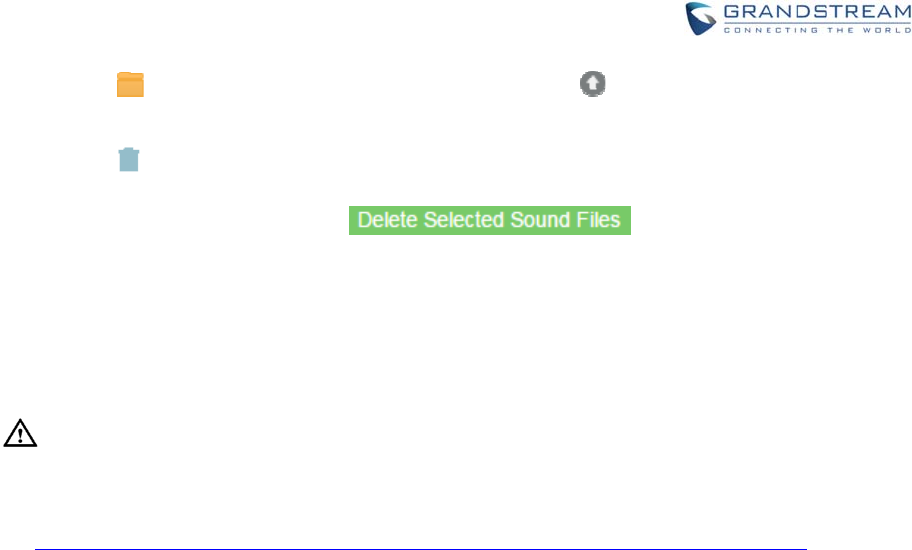
Firmware Version 1.0.0.1 UCM6200 Series IP PBX User Manual Page 221 of 320
Click on to select music file from local PC and click on to start uploading. The music file
uploaded has to be 8 KHz Mono format with size smaller than 5M.
Click on next to the sound file to delete it from the selected Music On Hold Class.
Select the sound files and click on to delete all selected music on
hold files.
--------------------------------------------------------------------------------------------------------------------------------------------
Note:
Once the MOH file is deleted, there are two ways to recover the music files.
Users could download the MOH file from this link:
http://downloads.asterisk.org/pub/telephony/sounds/releases/asterisk-moh-opsound-wav-2.03.tar.gz
After downloading and unzip the pack, users could then upload the music files to UCM.
Factory reset could also recover the MOH file on the UCM.
--------------------------------------------------------------------------------------------------------------------------------------------
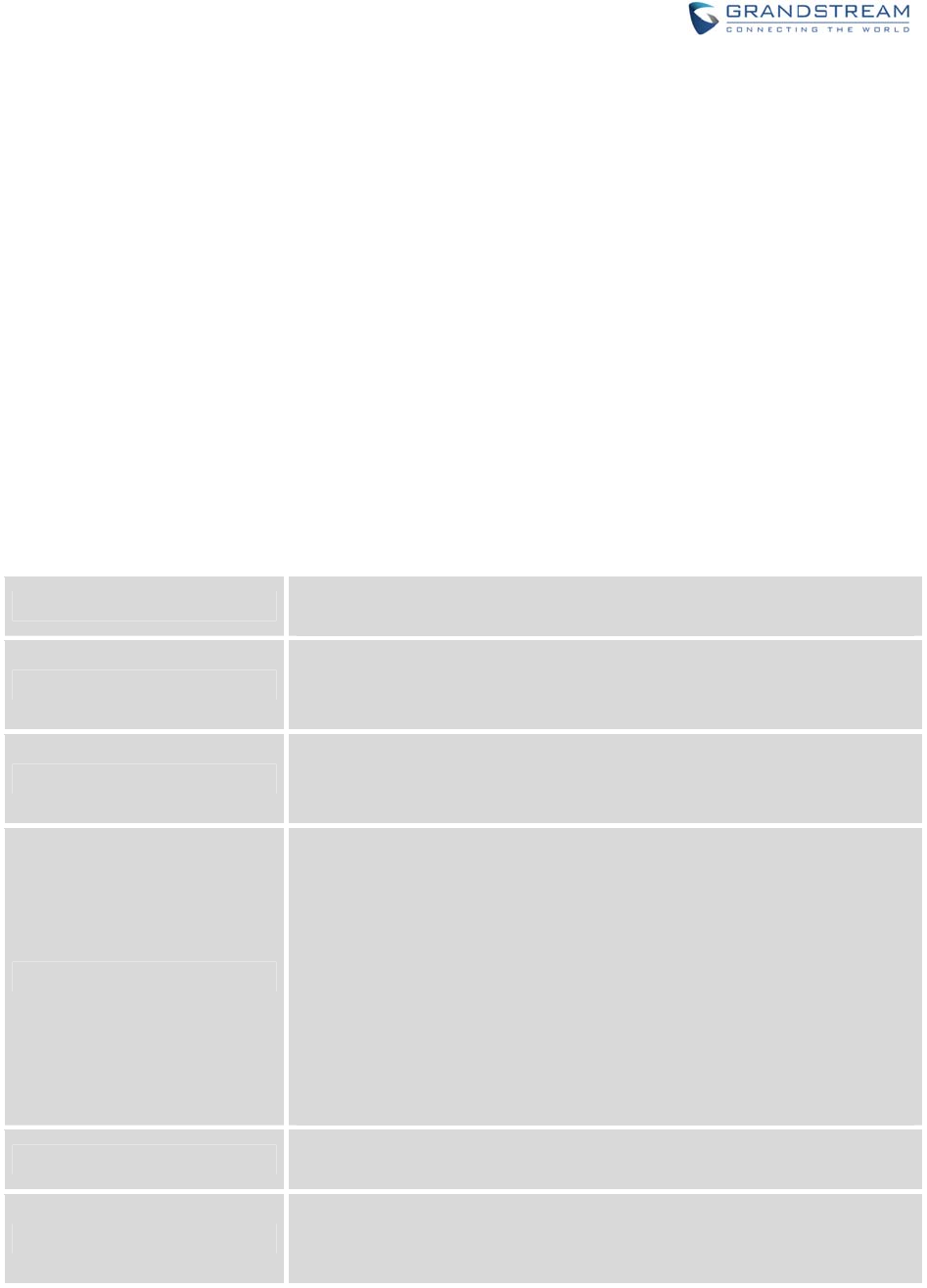
Firmware Version 1.0.0.1 UCM6200 Series IP PBX User Manual Page 222 of 320
FAX/T.38
The UCM6200 supports T.30/T.38 Fax and Fax Pass-through. It can convert the received Fax to PDF
format and send it to the configured Email address. Fax/T.38 settings can be accessed via Web
GUI->PBX->Internal Options->FAX/T.38. The list of received Fax files will be displayed in the same web
page for users to view, retrieve and delete.
CONFIGUREFAX/T.38
Click on "Create New Fax Extension". In the popped up window, fill the extension, name and Email
address to send the received Fax to.
Click on "Fax Settings" to configure the Fax parameters.
Table 69: FAX/T.38 Settings
Enable Error Correction Mode Configure to enable Error Correction Mode (ECM) for the Fax. The default
setting is "Yes".
Maximum Transfer Rate
Configure the maximum transfer rate during the Fax rate negotiation. The
possible values are 2400, 4800, 7200, 9600, 12000 and 14400. The
default setting is 14400.
Minimum Transfer Rate
Configure the minimum transfer rate during the Fax rate negotiation. The
possible values are 2400, 4800, 7200, 9600, 12000 and 14000. The
default setting is 2400.
Max Concurrent Sending Fax
Configure the concurrent fax that can be sent by UCM6200. Two mode
“Only” and “More” are supported.
Only
Under this mode, the UCM6200 allows only single user to send fax at
a time.
More
Under this mode, the UCM6200 supports multiple concurrent fax
sending by the users.
By default, this option is set to “only”.
Fax Queue Length Configure the maximum length of Fax Queue from 6 to 10. The default
setting is 6.
Default Email Address
Configure the Email address to send the received Fax to if user's Email
address cannot be found.
Note:

Firmware Version 1.0.0.1 UCM6200 Series IP PBX User Manual Page 223 of 320
The extension's Email address or the Fax's default Email address needs
to be configured in order to receive Fax from Email. If neither of them is
configured, Fax will be not be received from Email.
Template Variables
Fill in the "Subject:" and "Message:" content, to be used in the Email
when sending the Fax to the users.
The template variables are:
${CALLERIDNUM} : Caller ID Number
${CALLERIDNAME} : Caller ID Name
${RECEIVEEXTEN} : The extension to receive the Fax
${FAXPAGES} : Number of pages in the Fax
${VM_DATE} : The date and time when the Fax is received
Click on to edit the Fax extension.
Click on to delete the Fax extension.
SAMPLECONFIGURATIONTORECEIVEFAXFROMPSTNLINE
The following instructions describe how to use the UCM6200 to receive Fax from PSTN line on the Fax
machine connected to the UCM6200 FXS port.
1. Connect Fax machine to the UCM6200 FXS port.
2. Connect PSTN line to the UCM6200 FXO port.
3. Go to web GUI->PBX->Analog Trunks page.
4. Create or edit the analog trunk for Fax as below.
Fax Mode: Make sure "Fax Mode" option is set to "None".
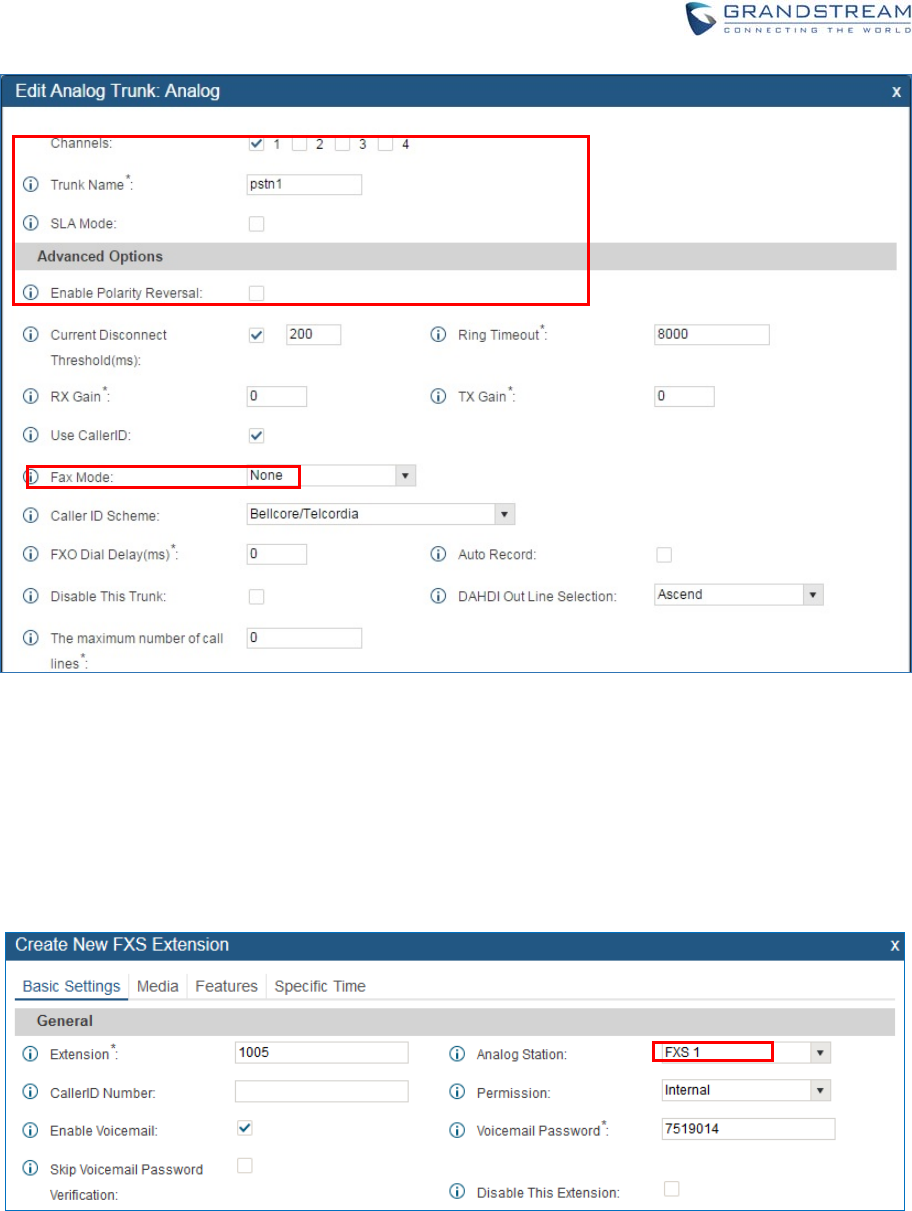
Firmware Version 1.0.0.1 UCM6200 Series IP PBX User Manual Page 224 of 320
Figure 134: Configure Analog Trunk without Fax Detection
5. Go to UCM6200 web GUI->PBX->Basic/Call Routes->Extensions page.
6. Create or edit the extension for FXS port.
Analog Station: Select FXS port to be assigned to the extension. By default, it's set to "None".
Once selected, analog related settings for this extension will show up in "Analog Settings"
section.
Figure 135: Configure Extension for Fax Machine: FXS Extension
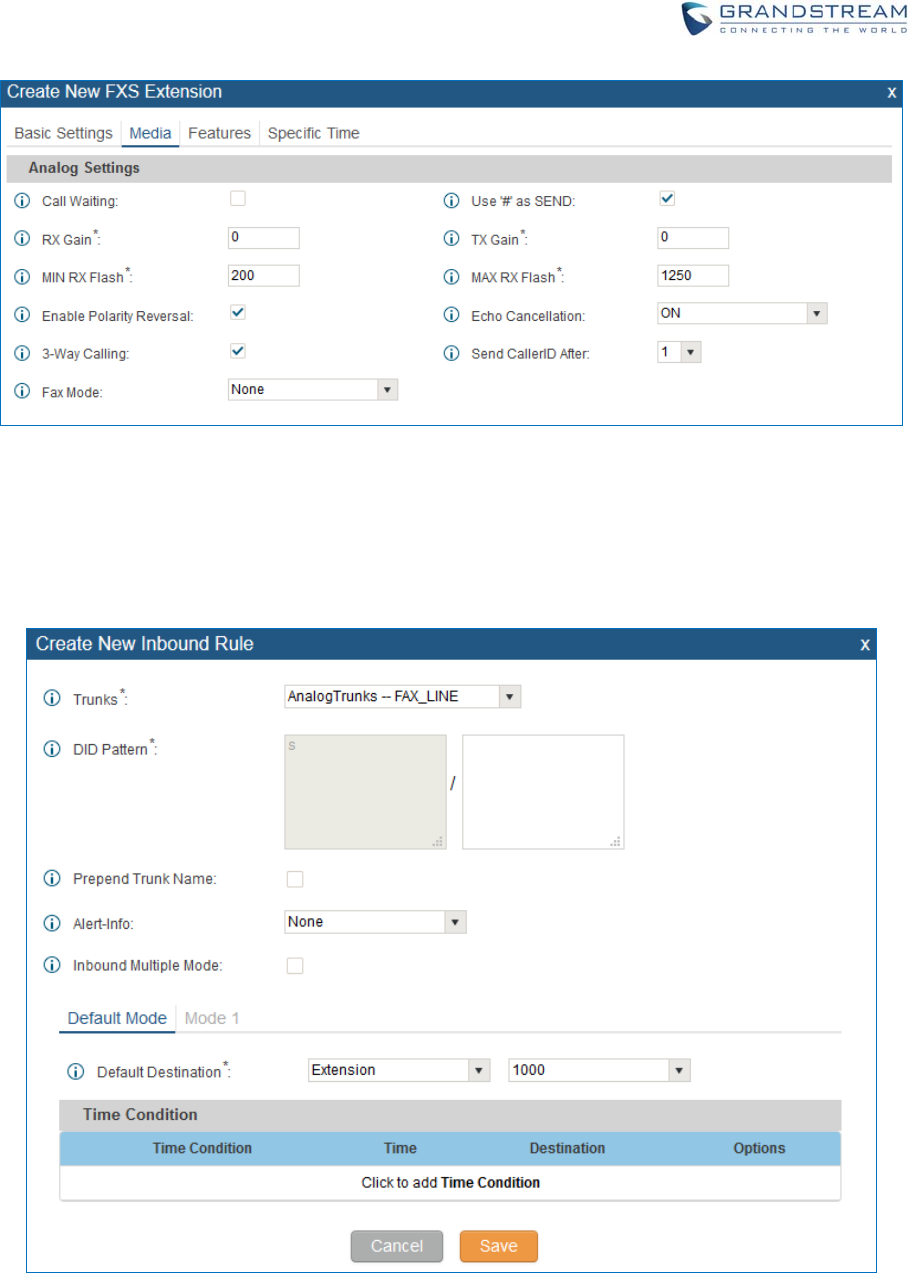
Firmware Version 1.0.0.1 UCM6200 Series IP PBX User Manual Page 225 of 320
Figure 136: Configure Extension for Fax Machine: Analog Settings
7. Go to web GUI->PBX->Basic/Call Routes->Inbound Routes page.
8. Create an inbound route to use the Fax analog trunk. Select the created extension for Fax machine in
step 4 as the default destination.
Figure 137: Configure Inbound Rule for Fax
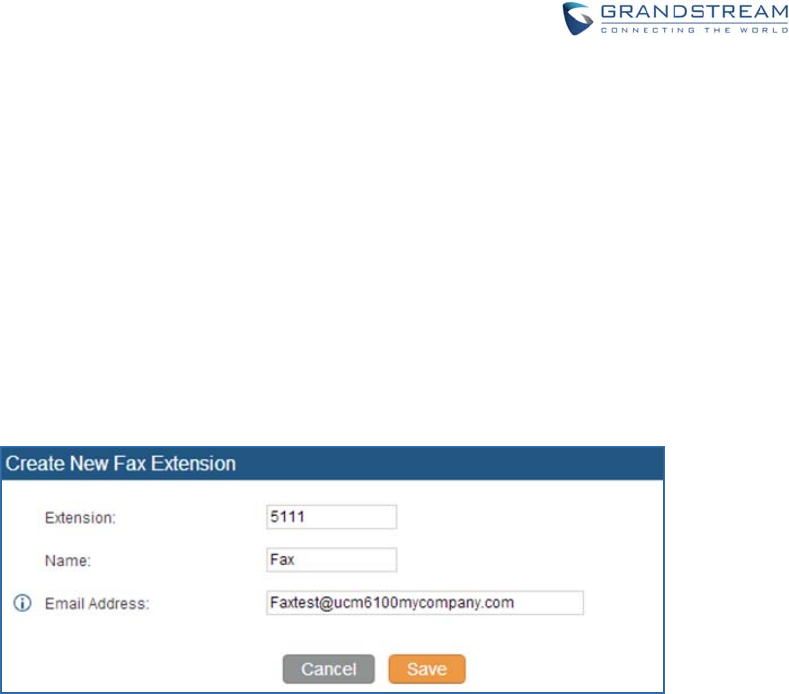
Firmware Version 1.0.0.1 UCM6200 Series IP PBX User Manual Page 226 of 320
Now the Fax configuration is done. When there is an incoming Fax calling to the PSTN number for the
FXO port, it will send the Fax to the Fax machine.
SAMPLECONFIGURATIONFORFAX‐TO‐EMAIL
The following instructions describe a sample configuration on how to use Fax-to-Email feature on the
UCM6200.
1. Connect PSTN line to the UCM6200 FXO port.
2. Go to UCM6200 web GUI->Internal Options->Fax/T.38 page. Create a new Fax extension.
Figure 138: Create Fax Extension
3. Go to UCM6200 web GUI->Basic/Call Routes->Analog Trunks page. Create a new analog trunk.
Please make sure "Fax Detection" is set to "No".
4. Go to UCM6200 web GUI->Basic/Call Routes->Inbound Routes page. Create a new inbound route
and set the default destination to the Fax extension.
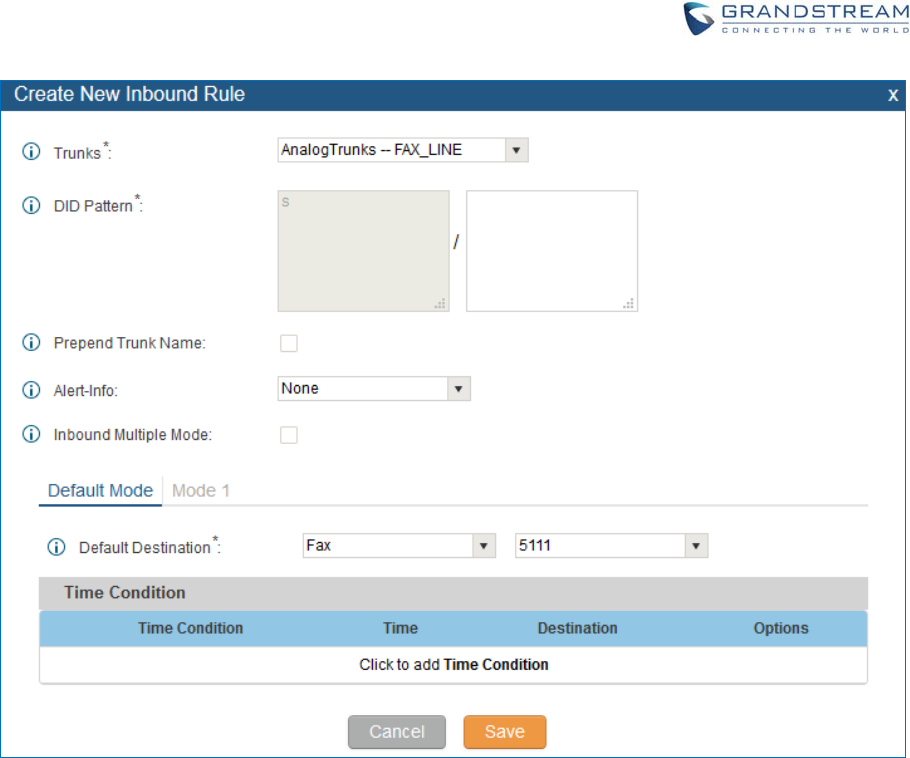
Firmware Version 1.0.0.1 UCM6200 Series IP PBX User Manual Page 227 of 320
Figure 139: Inbound Route to Fax Extension
5. Once successfully configured, the incoming Fax from external Fax machine to the PSTN line number
will be converted to PDF file and sent to the Email address Faxtest@ucm6200mycompany.com as
attachment.
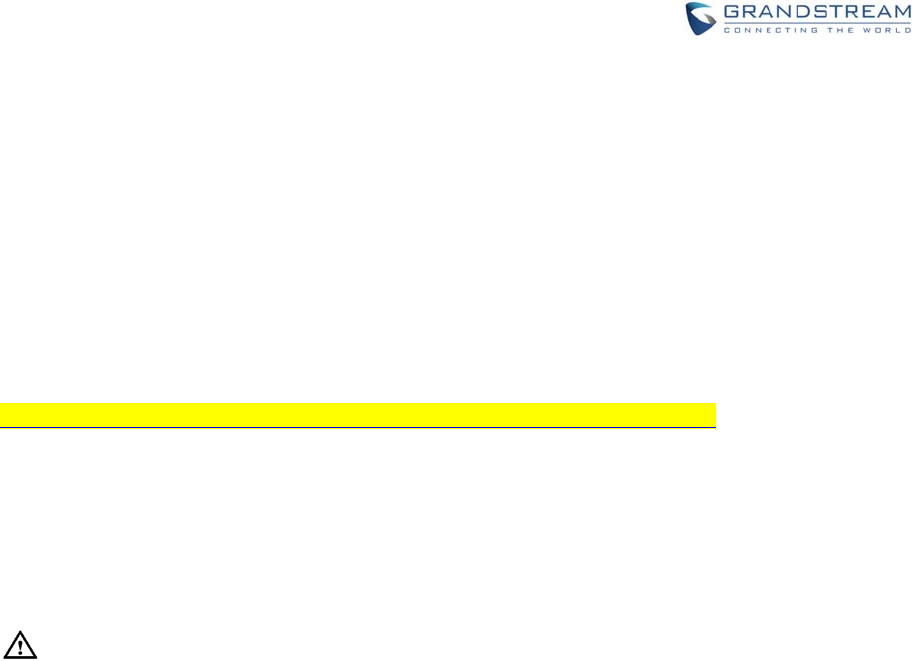
Firmware Version 1.0.0.1 UCM6200 Series IP PBX User Manual Page 228 of 320
ASTERISKMANAGERINTERFACE(RESTRICTEDACCESS)
The UCM6200 supports Asterisk Manager Interface (AMI) with restricted access. AMI allows a client
program to connect to an Asterisk instance commands or read events over a TCP/IP stream. It’s
particularly useful when the system admin tries to track the state of a telephony client inside Asterisk.
User could configure AMI parameters on UCM6200 web GUI->PBX->Internal Options->AMI. For details
on how to use AMI on UCM6200, please refer to the following AMI guide:
http://www.grandstream.com/sites/default/files/Resources/ucm6200_AMI_guide.pdf
--------------------------------------------------------------------------------------------------------------------------------------------
Warning:
Please do not enable AMI on the UCM6200 if it is placed on a public or untrusted network unless you have
taken steps to protect the device from unauthorized access. It is crucial to understand that AMI access can
allow AMI user to originate calls and the data exchanged via AMI is often very sensitive and private for
your UCM6200 system. Please be cautious when enabling AMI access on the UCM6200 and restrict the
permission granted to the AMI user. By using AMI on UCM6200 you agree you understand and
acknowledge the risks associated with this.
--------------------------------------------------------------------------------------------------------------------------------------------

Firmware Version 1.0.0.1 UCM6200 Series IP PBX User Manual Page 229 of 320

Firmware Version 1.0.0.1 UCM6200 Series IP PBX User Manual Page 230 of 320
BUSYCAMP‐ON
The UCM6200 supports busy camp-on/call completion feature that allows the PBX to camp on a called
party and inform the caller as soon as the called party becomes available given the previous attempted call
has failed.
The configuration and instructions on how to use busy camp-on/call completion feature can be found in the
following guide:
http://www.grandstream.com/sites/default/files/Resources/ucm6200_busy_camp_on_guide.pdf

Firmware Version 1.0.0.1 UCM6200 Series IP PBX User Manual Page 231 of 320
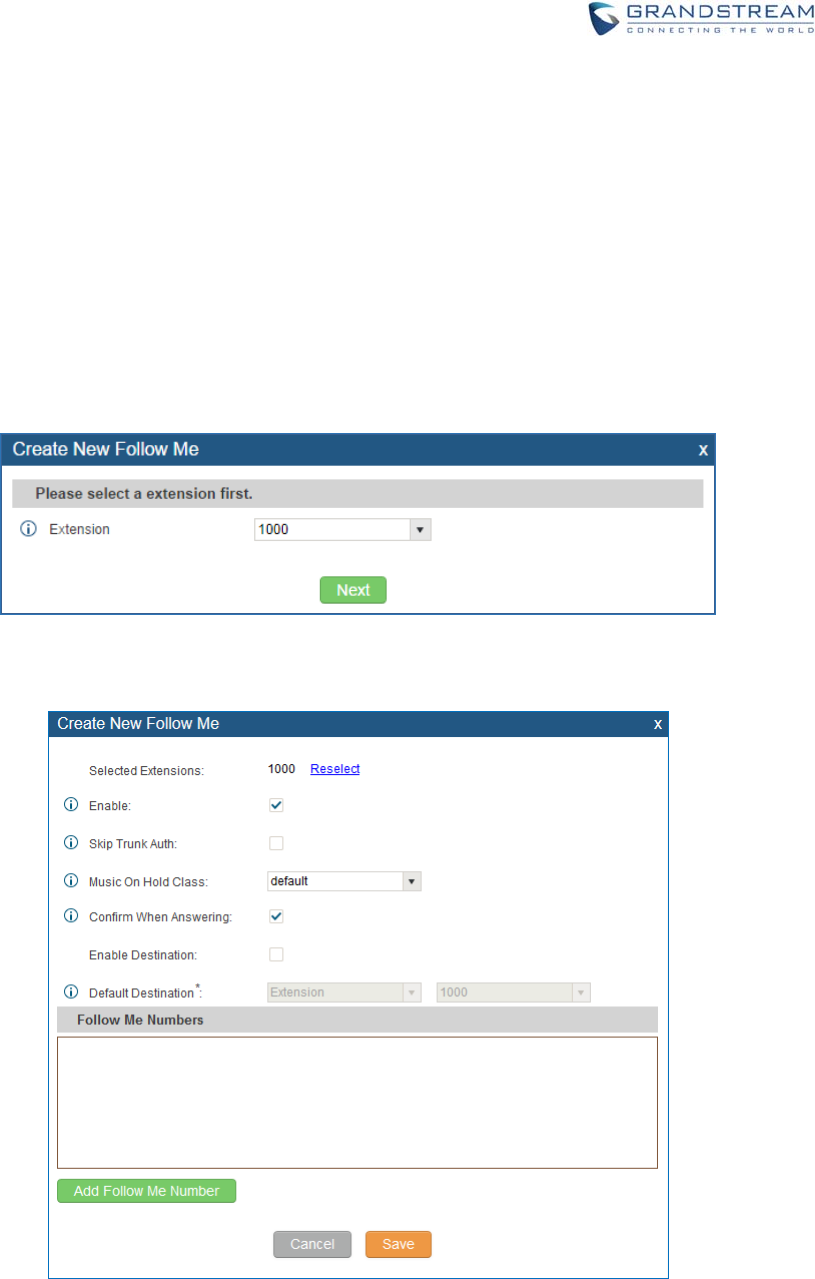
Firmware Version 1.0.0.1 UCM6200 Series IP PBX User Manual Page 232 of 320
FOLLOWME
Follow Me is a feature on the UCM6200 that allows users to direct calls to other phone numbers and have
them ring all at once or one after the other. Calls can be directed to users’ home phone, office phone,
mobile and etc. The calls will get to the user no matter where they are. Follow Me option can be found
under web GUI-> PBX-> Call Features->Follow Me.
To configure follow me:
Click on "Create New Follow Me" and then select an extension to be configured with Follow Me.
Figure 140: Create Follow Me
Click on “Next” to continue editing Follow Me configuration.
Figure 141: Edit Follow Me

Firmware Version 1.0.0.1 UCM6200 Series IP PBX User Manual Page 233 of 320
Click on “Add Follow Me Number” to add local extensions or external numbers to be called after
ringing the extension selected in the first step.
Once created, it will be displayed on the follow me web page list. Click on to edit the Follow Me
configuration. Click on to delete the Follow Me.
The following table shows the Follow Me configuration parameters.
Table 70: Follow Me Settings
Enable Configure to enable or disable Follow Me for this user.
Skip Trunk Auth
If external number is added in the Follow Me, please make sure this
option is enabled or the “Skip Trunk Auth” option of the extension is
enabled, otherwise the external Follow Me number cannot be reached.
Music On Hold Class Configure the Music On Hold class that the caller would hear while
tracking the user.
Confirm When Answering
By default it is enabled and user will be asked to press 1 to accept the call
or to press 2 to reject the call after answering a Follow Me call.
If it is disabled, the Follow Me call will be established once after the user
answers it.
Enable Destination When enabled, the call will be routed to the default destination if no one in
the Follow Me extensions answers the call.
Default Destination
Configure the destination if no one in the Follow Me extensions answers
the call. The available options are:
Extension
Voicemail
Queues
Ring Group
Voicemail Group
IVR
External Number
Follow Me Numbers
The added numbers are listed here. Click on to arrange the
order. Click on to delete the number. Click on to add new
numbers.
New Follow Me Number
Add a new Follow Me number which could be a ‘Local Extension’ or
‘External Number’. The selected dial plan should have permissions to dial
the defined external number.
Dialing Order Select the order in which the Follow Me destinations will be dialed to
reach the user: ring all at once or ring one after the other.
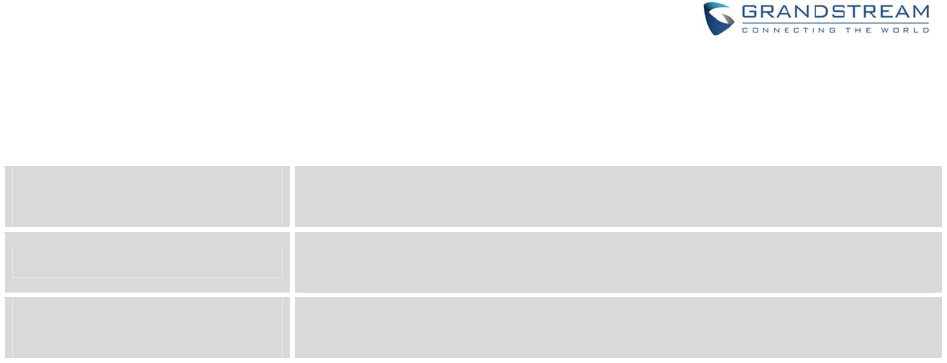
Firmware Version 1.0.0.1 UCM6200 Series IP PBX User Manual Page 234 of 320
Click on “Follow Me Options” to enable or disable the options listed in the following table.
Table 71: Follow Me Options
Playback Incoming Status
Message
If enabled, the PBX will playback the incoming status message before
starting the Follow Me steps.
Record the Caller’s Name If enabled, the PBX will record the caller’s name from the phone so it can
be announced to the callee in each step.
Playback Unreachable Status
Message
If enabled, the PBX will playback the unreachable status message to the
caller if the callee cannot be reached.

Firmware Version 1.0.0.1 UCM6200 Series IP PBX User Manual Page 235 of 320
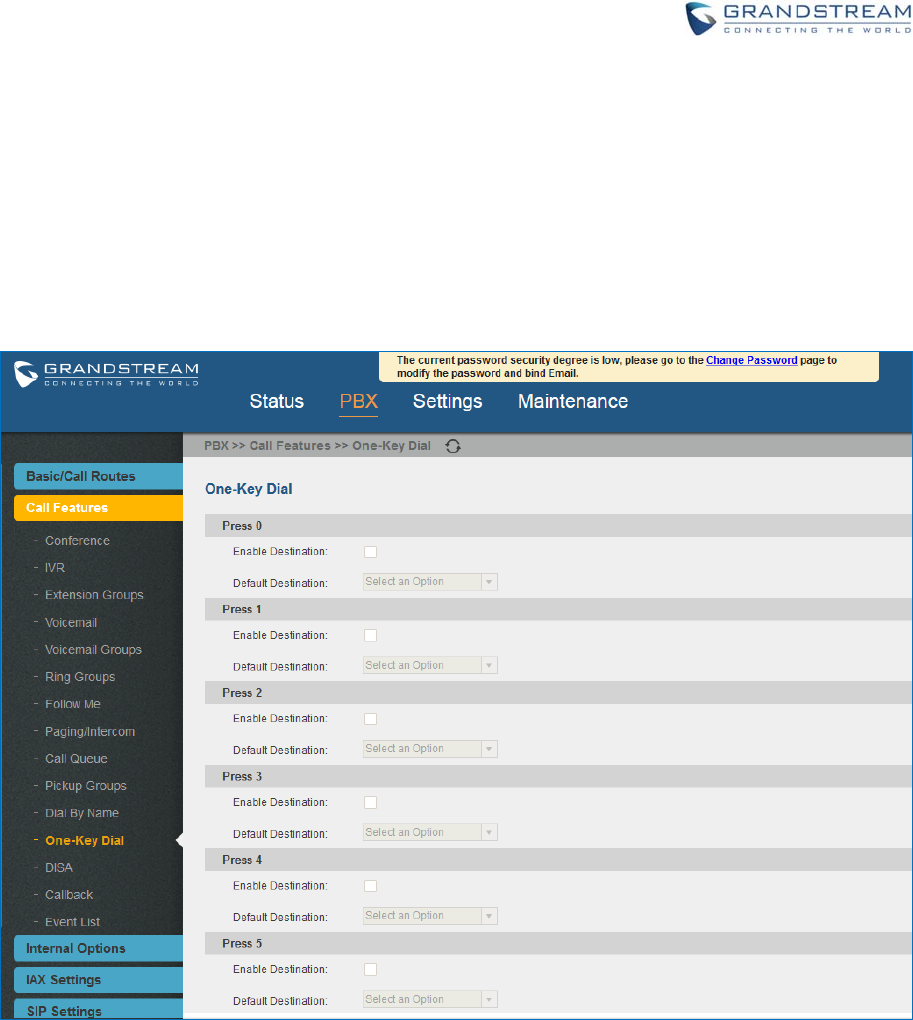
Firmware Version 1.0.0.1 UCM6200 Series IP PBX User Manual Page 236 of 320
ONE‐KEYDIAL
The UCM6200 supports One-Key Dial that allows users to call a certain destination by pressing one digit 0
to 9 on the keypad. This creates a system-wide speed dial access for all the extensions on the UCM6200.
To enable One-Key Dial, on the UCM6200 web GUI, go to page PBX->Call Features->One-Key Dial.
Figure 142: Configure One-Key Dial
User should first decide a digit used for One-Key Dial and check the option “Enable Destination” for the
digit. Then select a dial destination from “Default Destination”. The supported destinations include
extension, voicemail, conference room, voicemail group, IVR, ring group, call queue, page group, fax,
DISA, Dial by Name and external number.
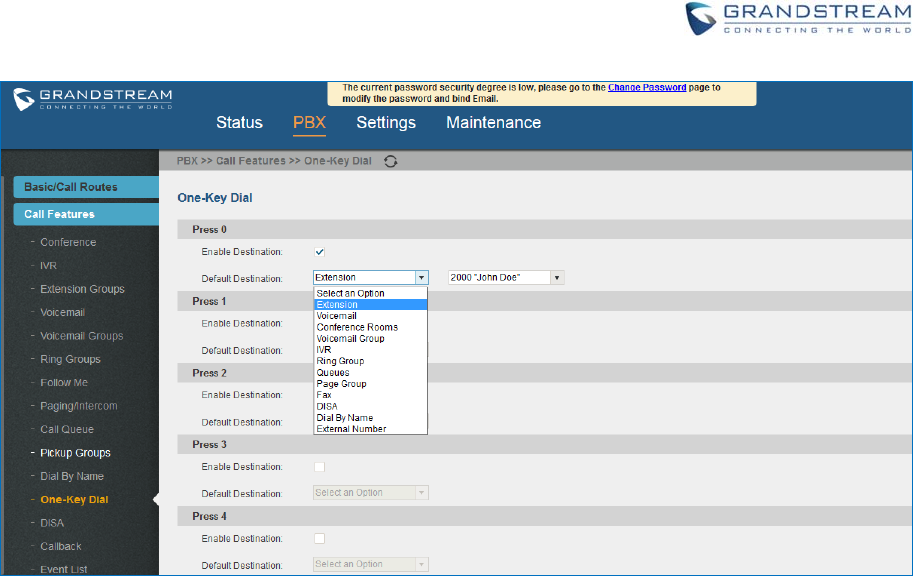
Firmware Version 1.0.0.1 UCM6200 Series IP PBX User Manual Page 237 of 320
Figure 143: One-Key Dial Destinations
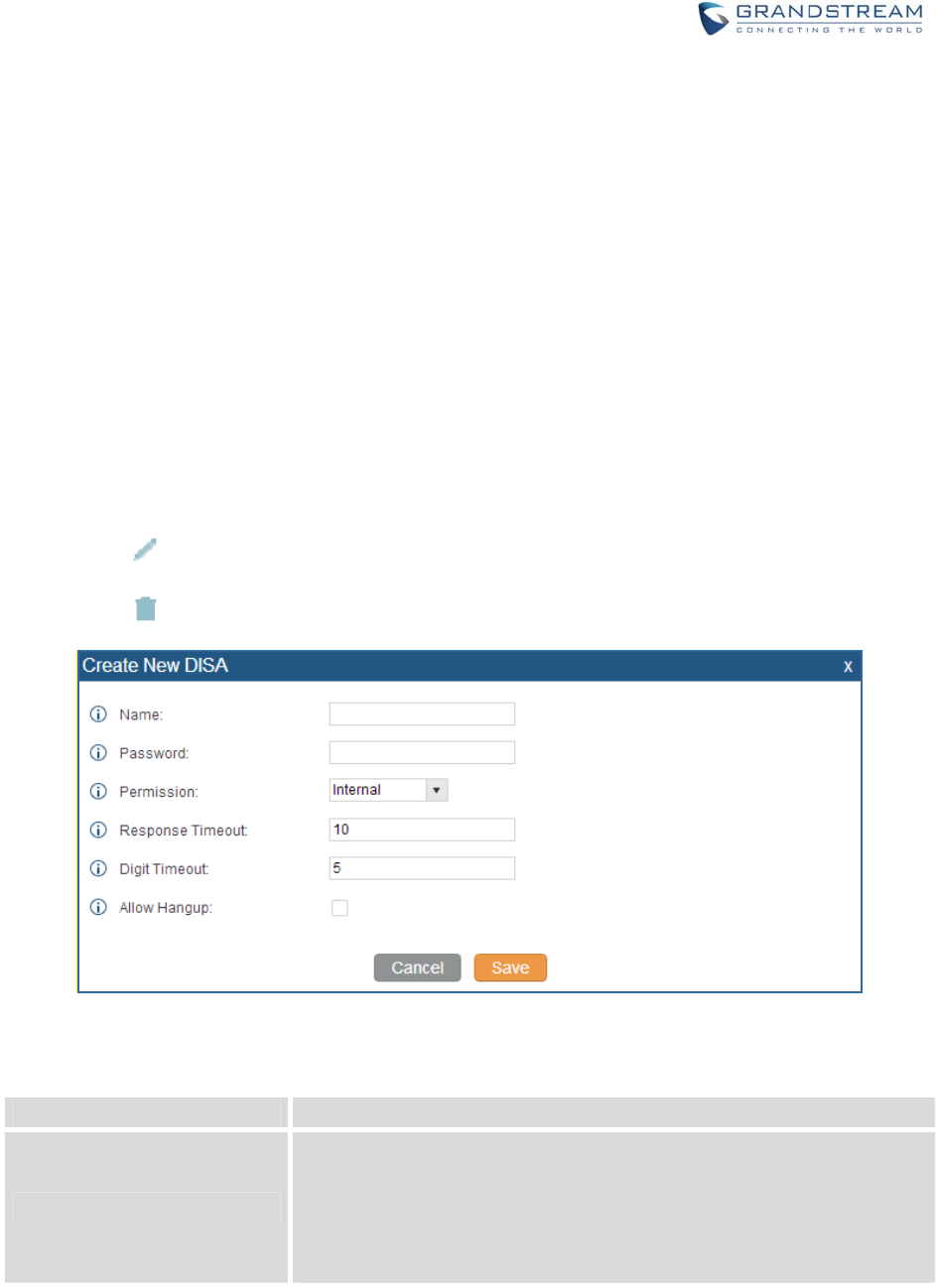
Firmware Version 1.0.0.1 UCM6200 Series IP PBX User Manual Page 238 of 320
DISA
In many situations the user will find the need to access his own IP PBX resources but he is not physically
near one of his extensions. However, he does have access to his own cell phone. In this case we can use
what is commonly known as DISA (Direct Inward System Access). Under this scenario the user will be able
to call from the outside, whether it’s using his cell phone, pay phone, regular PSTN, etc. After calling into
UCM6200, the user can then dial out via the SIP trunk or PSTN trunk connected to UCM6200 as it is an
internal extension.
The UCM6200 supports DISA to be used in IVR or inbound route. Before using it, create new DISA under
web GUI->Call Features->DISA.
Click on "Create New IVR" to add a new DISA.
Click on to edit the DISA configuration.
Click on to delete the DISA.
Figure 144: Create New DISA
Table 72: DISA Settings
Name Configure DISA name to identify the DISA.
Password
Configure the password (digit only) required for the user to enter before
using DISA to dial out.
Note:
The password has to be at least 4 digits.
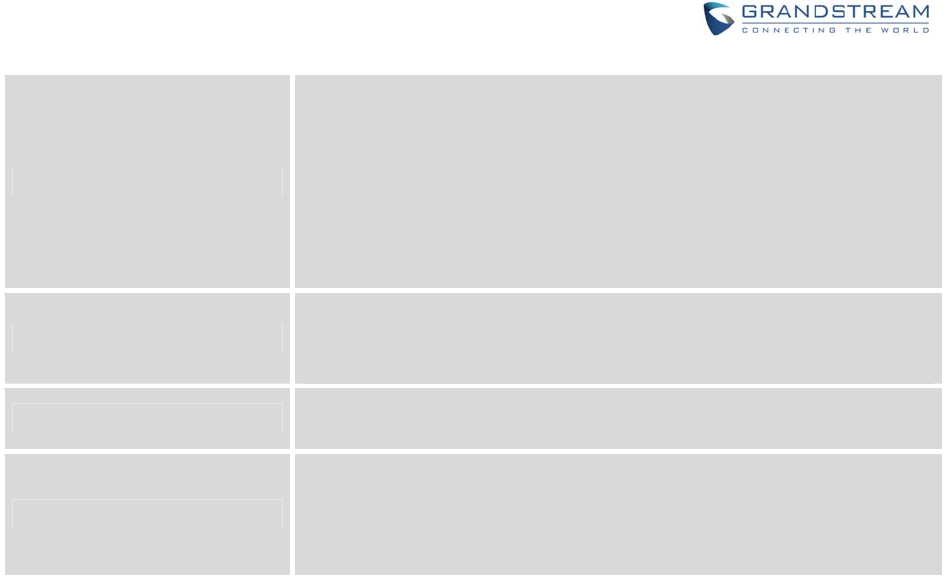
Firmware Version 1.0.0.1 UCM6200 Series IP PBX User Manual Page 239 of 320
Permission
Configure the permission level for DISA. The available permissions are
"Internal", "Local", "National" and "International" from the lowest level to
the highest level. The default setting is "Internal". If the user tries to dial
outbound calls after dialing into the DISA, the UCM6200 will compared
the DISA's permission level with the outbound route's privilege level. If the
DISA's permission level is higher than (or equal to) the outbound route's
privilege level, the call will be allowed to go through.
Response Timeout
Configure the maximum amount of time the UCM6200 will wait before
hanging up if the user dials an incomplete or invalid number. The default
setting is 10 seconds.
Digit Timeout Configure the maximum amount of time permitted between digits when
the user is typing the extension. The default setting is 5 seconds.
Allow Hangup
If enabled, during an active call, users can enter the UCM6200 hangup
feature code (by default it's *0) to disconnect the call or hang up directly. A
new dial tone will be heard shortly for the user to make a new call. The
default setting is "No".
Once successfully created, users can configure the inbound route destination as "DISA" or IVR key event
as "DISA". When dialing into DISA, users will be prompted with password first. After entering the correct
password, a second dial tone will be heard for the users to dial out.

Firmware Version 1.0.0.1 UCM6200 Series IP PBX User Manual Page 240 of 320
CALLBACKFEATURE
Callback is mainly designed for users who often use their mobile phones to make long distance or
international calls which may have high service charges. The callback feature provides an economic
solution for reduce the cost from this.
The callback feature works as follows:
1. Configure a new callback on the UCM6200.
2. On the UCM6200, configure destination of the inbound route for analog trunk to callback.
3. Save and apply the settings.
4. The user calls the PSTN number of the UCM6200 using the mobile phone, which goes to callback
destination as specified in the inbound route.
5. Once the user hears the ringback tone from the mobile phone, hang up the call on the mobile phone.
6. The UCM6200 will call back the user.
7. The user answers the call.
8. The call will be sent to DISA or IVR which directs the user to dial the destination number.
9. The user will be connected to the destination number.
In this way, the calls are placed and connected through trunks on the UCM6200 instead of to the mobile
phone directly. Therefore, the user will not be charged on mobile phone services for long distance or
international calls.
To configure callback on the UCM6200, go to web GUI->PBX->Call Features->Callback page and click
on . Configuration parameters are listed in the following table.
Table 73: Callback Configuration Parameters
Name Configure a name to identify the Callback.
CallerID Pattern
Configure the pattern of the callers allowed to use this callback. The caller
who places the inbound call needs to have the callerID match this pattern
so that the caller can get callback after hanging up the call.
Note:
If leaving as blank, all numbers are allowed to use this callback.
Outbound Prepend
Configure the prepend digits to be added at before dialing the outside
number. The number with prepended digits will be used to match the
outbound route. ‘-’ is the connection character which will be ignored.

Firmware Version 1.0.0.1 UCM6200 Series IP PBX User Manual Page 241 of 320
Delay Before Callback Configure the number of seconds to be delayed before calling back the
user.
Destination
Configure the destination which the callback will direct the caller to. Two
destinations are available:
IVR
DISA
The caller can then enter the desired number to dial out via UCM6200
trunk.
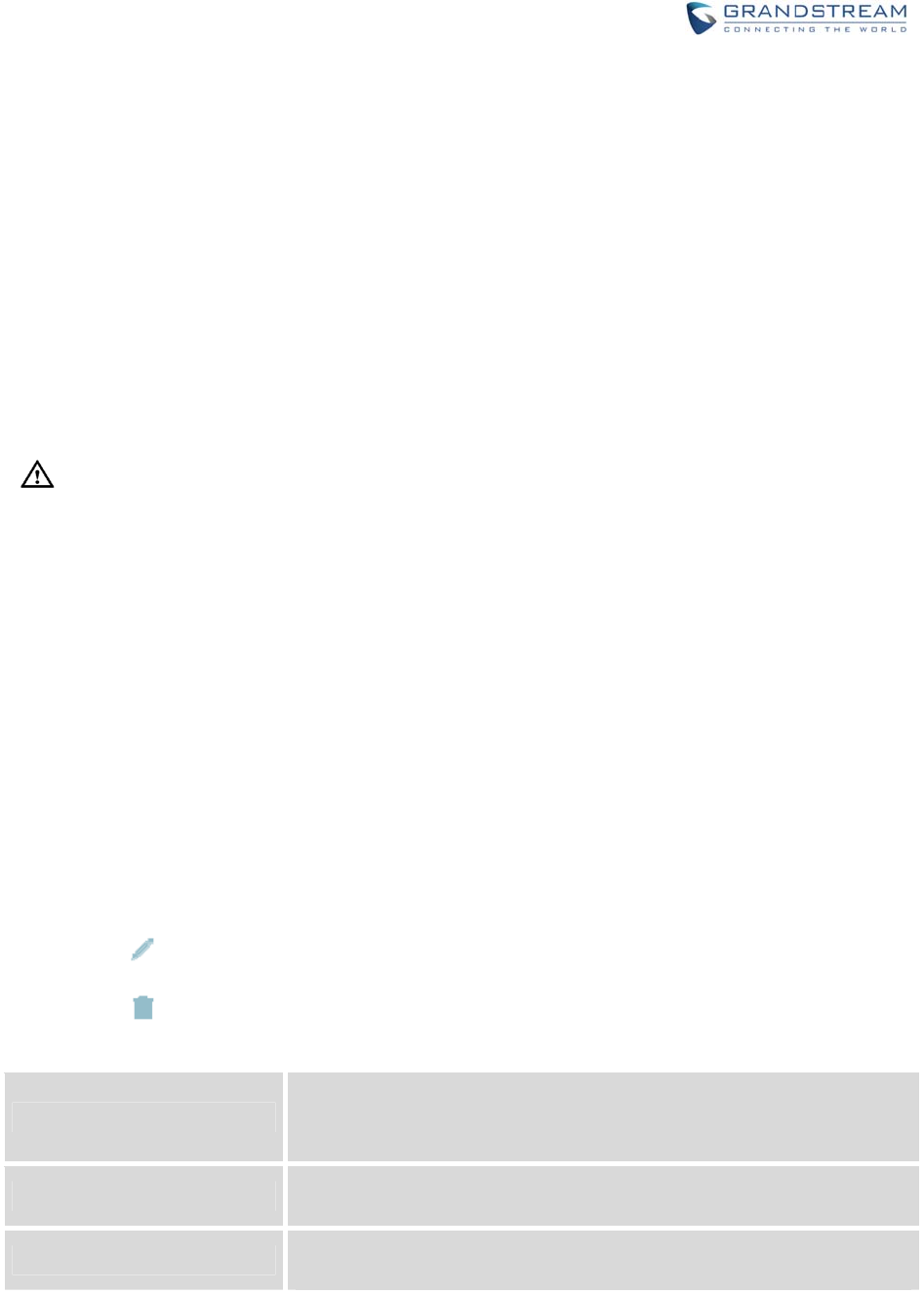
Firmware Version 1.0.0.1 UCM6200 Series IP PBX User Manual Page 242 of 320
BLFANDEVENTLIST
BLF
The UCM6200 supports BLF monitoring for extensions, ring group, call queue, conference room and
parking lot. For example, on the user's phone, configure the parking lot number 701 as the BLF monitored
number. When there is a parked call on 701, the LED for this BLF key will light up in red, meaning a call is
parked against this parking lot. Pressing this BLF key can pick up the call from this parking lot.
--------------------------------------------------------------------------------------------------------------------------------------------
Note:
On the Grandstream GXP series phones, the MPK supports "Call Park" mode, which can be used to park
the call by configuring the MPK number as call park feature code (e.g., 700). MPK "Call Park" mode can
also be used to monitor and pickup parked call if the MPK number is configured as parking lot (e.g., 701).
--------------------------------------------------------------------------------------------------------------------------------------------
EVENTLIST
Besides BLF, users can also configure the phones to monitor event list. In this way, both local extensions
on the same UCM6200 and remote extensions on the VOIP trunk can be monitored. The event list setting
is under web GUI->Call Features->Event List.
Click on "Create New Event List" to add a new event list.
Click on to edit the event list configuration.
Click on to delete the event list.
Table 74: Event List Settings
URI
Configure the name of this event list (for example, office_event_list).
Please note the URI name cannot be the same as the extension name on
the UCM6200. The valid characters are letters, digits, _ and -.
Local Extensions Select the available extensions/Extension Groups listed on the local
UCM6200 to be monitored in the event list.
Remote Extensions If LDAP sync is enabled between the UCM6200 and the peer UCM6200,
the remote extensions will be listed under "Available Extensions". If not,
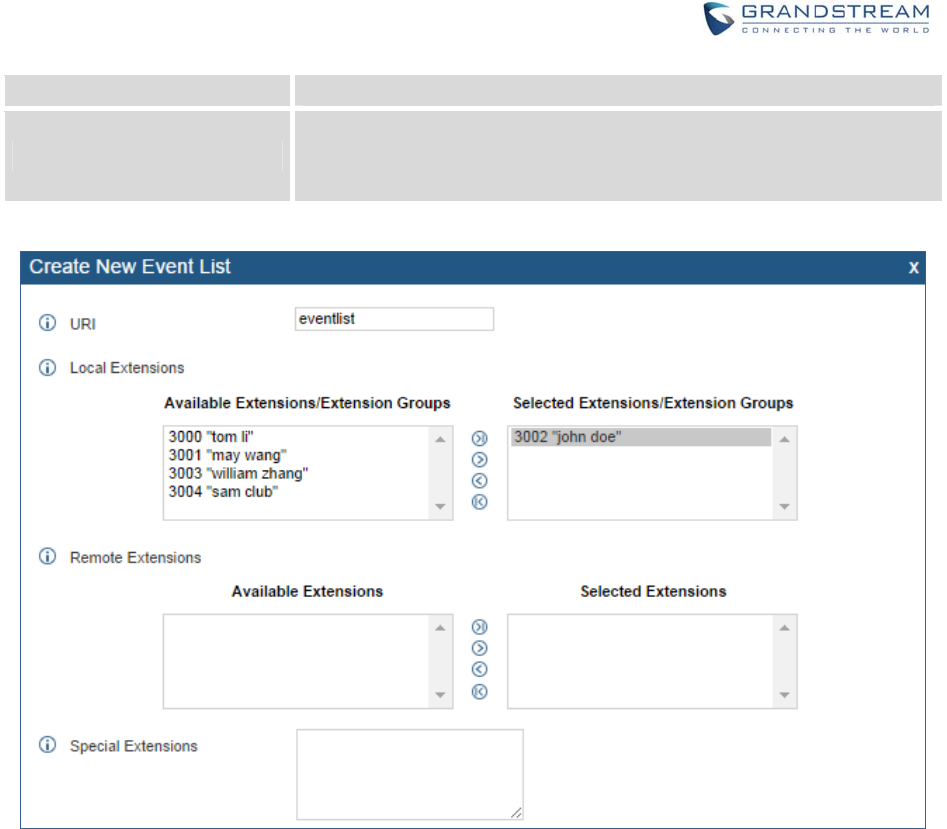
Firmware Version 1.0.0.1 UCM6200 Series IP PBX User Manual Page 243 of 320
manually enter the remote extensions under "Special Extensions" field.
Special Extensions
Manually enter the remote extensions in the peer/register trunk to be
monitored in the event list.
Valid format: 5000,5001,9000
Figure 145: Create New Event List
Remote extension monitoring works on the UCM6200 via event list BLF, among Peer SIP trunks or
Register SIP trunks (register to each other). Therefore, please properly configure SIP trunks on the
UCM6200 first before using remote BLF feature. Please note the SIP end points need support event list
BLF in order to monitor remote extensions.
When an event list is created on the UCM6200 and remote extensions are added to the list, the UCM6200
will send out SIP SUBSCIRBE to the remote UCM6200 to obtain the remote extension status. When the
SIP end points registers and subscribes to the local UCM6200 event list, it can obtain the remote extension
status from this event list. Once successfully configured, the event list page will show the status of total
extension and subscribers for each event list. Users can also select the event URI to check the monitored
extension's status and the subscribers' details.

Firmware Version 1.0.0.1 UCM6200 Series IP PBX User Manual Page 244 of 320
--------------------------------------------------------------------------------------------------------------------------------------------
Note:
To configure LDAP sync, please go to UCM6200 web GUI->PBX->Basic/Call Routes->VoIP Trunk.
You will see "Sync LDAP Enable" option. Once enabled, please configure password information for the
remote peer UCM6200 to connect to the local UCM6200. Additional information such as port number,
LDAP outbound rule, LDAP Dialed Prefix will also be required. Both the local UCM6200 and remote
UCM6200 need enable LDAP sync option with the same password for successful connection and
synchronization.
Currently LDAP sync feature only works between two UCM6200s.
(Theoretically) Remote BLF monitoring will work when the remote PBX being monitored is
non-UCM6200 PBX. However, it might not work the other way around depending on whether the
non-UCM6200 PBX supports event list BLF or remote monitoring feature.
--------------------------------------------------------------------------------------------------------------------------------------------

Firmware Version 1.0.0.1 UCM6200 Series IP PBX User Manual Page 245 of 320
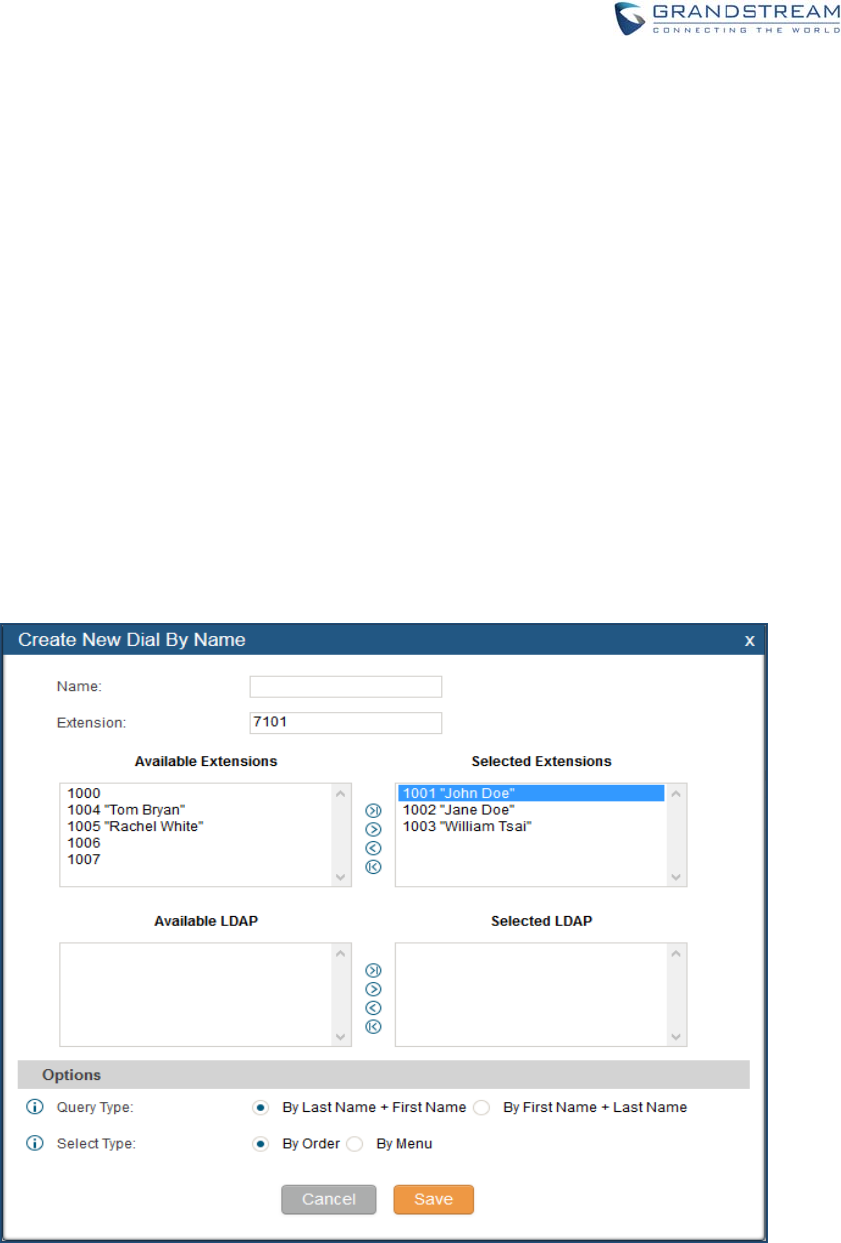
Firmware Version 1.0.0.1 UCM6200 Series IP PBX User Manual Page 246 of 320
DIALBYNAME
Dial By Name is a feature on the PBX that allows caller to search a person by first or last name via his/her
phone's keypad. The administrator can define the Dial By Name directory including the desired extensions
in the directory and the searching type by "first name" or "last name". After dialing in, the PBX IVR/Auto
Attendant will guide the caller to spell the digits to find the person in the Dial By Name directory. This
feature allows customers/clients to use the guided automatic system to get in touch with the enterprise
employees without having to know the extension number, which brings convenience and improves
business image for the enterprise.
DIALBYNAMECONFIGURATION
The administrators can create the dial by name group under web GUI->PBX->Call Features->Dial By
Name.
Figure 146: Create Dial By Name Group
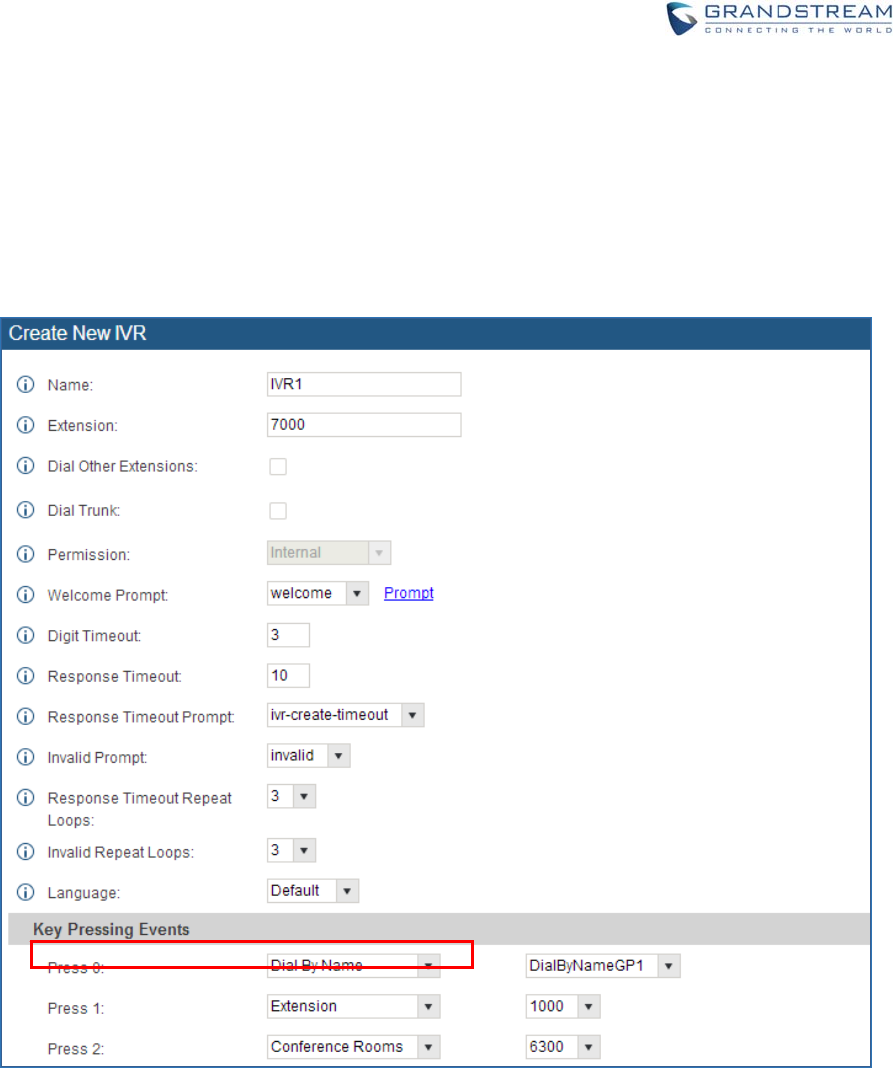
Firmware Version 1.0.0.1 UCM6200 Series IP PBX User Manual Page 247 of 320
1. Group Name
Enter the Group Name. This is to identify the Dial By Name group. The Dial By Name group can be
used as the destination for inbound route and key pressing event for IVR. The group name defined
here will show up in the destination list when configuring IVR and inbound route. If Dial By Name is set
as a key pressing event for IVR, user could use ‘*’ to exit from Dial By Name, then re-enter IVR and
start a new event. The following example shows how to use this option.
Figure 147: Dial By Name Group In IVR Key Pressing Events
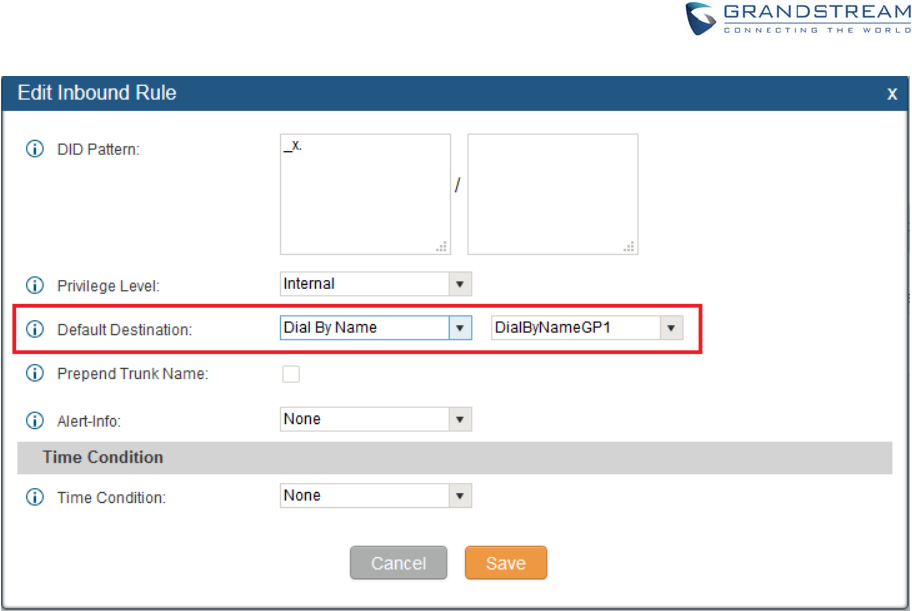
Firmware Version 1.0.0.1 UCM6200 Series IP PBX User Manual Page 248 of 320
Figure 148: Dial By Name Group In Inbound Rule
2. Extension
Configure the direct dial extension for the Dial By Name group.
3. Available Extensions/Selected Extensions
Select available extensions from the left side to the right side as the directory for the Dial By Name
group. Only the selected extensions here can be reached by the Dial By Name IVR when dialing into
this group. The extensions here must have a valid first name and last name configured under web
GUI->PBX->Basic/Call Routes->Extensions in order to be searchable in Dial By Name directory
through IVR. By specifying the extensions here, the administrators can make sure unscreened calls
will not reach the company employee if he/she doesn't want to receive them directly.
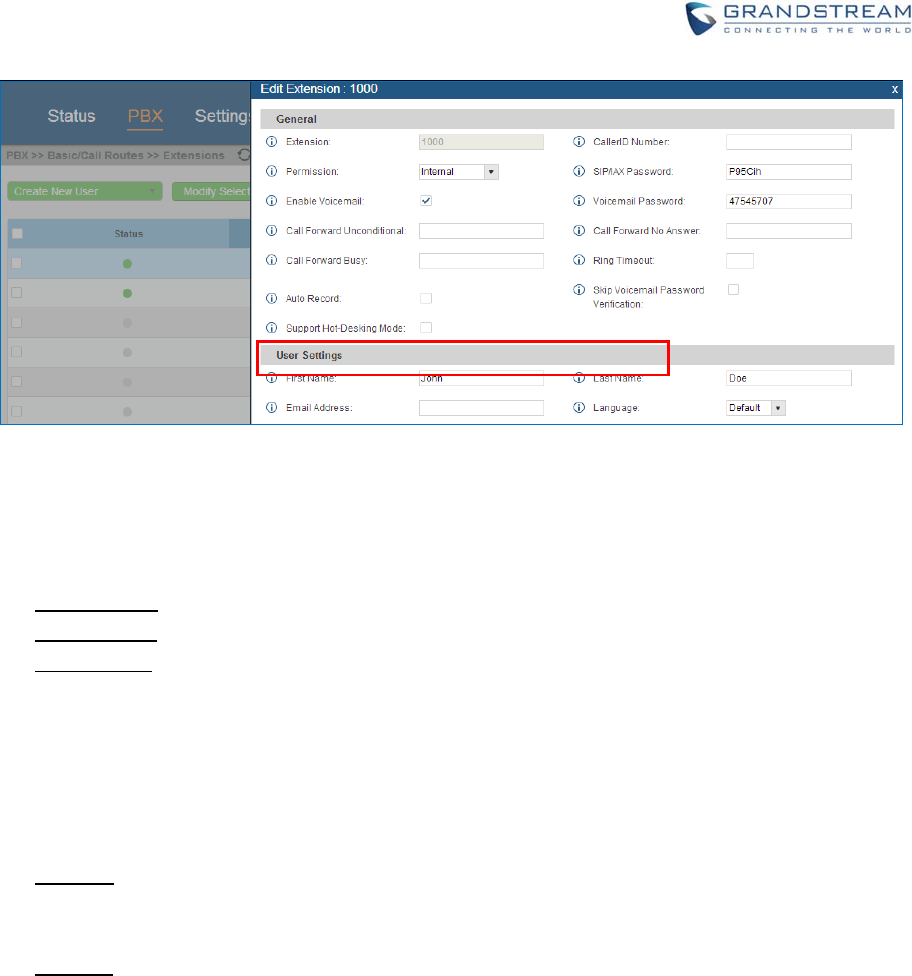
Firmware Version 1.0.0.1 UCM6200 Series IP PBX User Manual Page 249 of 320
Figure 149: Configure Extension First Name and Last Name
4. Query Type
Specify the query type. This defines how the caller will need to enter to search the directory.
By First Name: enter the first 3 digits of the first name to search the directory.
By Last Name: enter the first 3 digits of the last name to search the directory.
By Full Name: enter the first 3 digits of the first name or last name to search the directory.
5. Select Type
Specify the select type on the searching result. The IVR will confirm the name/number for the party the
caller would like to reach before dialing out.
By Order: After the caller enters the digits, the IVR will announce the first matching party's name and
number. The caller can confirm and dial out if it's the destination party, or press * to listen to the next
matching result if it's not the desired party to call.
By Menu: After the caller enters the digits, the IVR will announce 8 matching results. The caller can
press number 1 to 8 to select and call, or press 9 for results in next page.
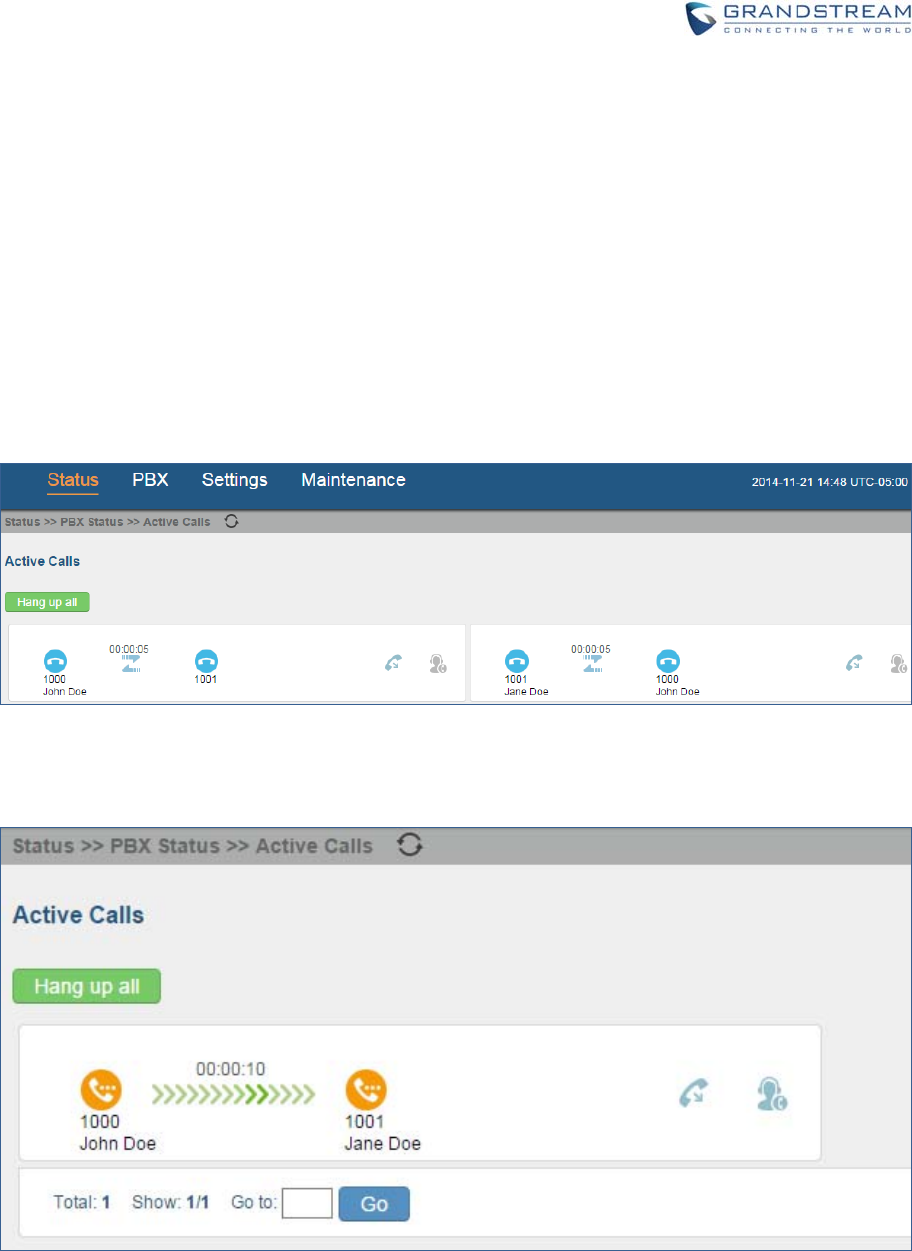
Firmware Version 1.0.0.1 UCM6200 Series IP PBX User Manual Page 250 of 320
ACTIVECALLSANDMONITOR
The active calls on the UCM6200 are displayed in web UI->Status->Active Calls page. Users can monitor
the status, hang up the call as well as barge in the active calls in real time manner.
ACTIVECALLSSTATUS
To view the status of active calls, navigate to web GUI->Status->Active Calls. The following figure shows
extension 1000 is calling 1001. 1001 is ringing.
Figure 150: Status->PBX Status->Active Calls - Ringing
The following figure shows the call between 1000 and 1001 is established.
Figure 151: Status->PBX Status->Active Calls – Call Established
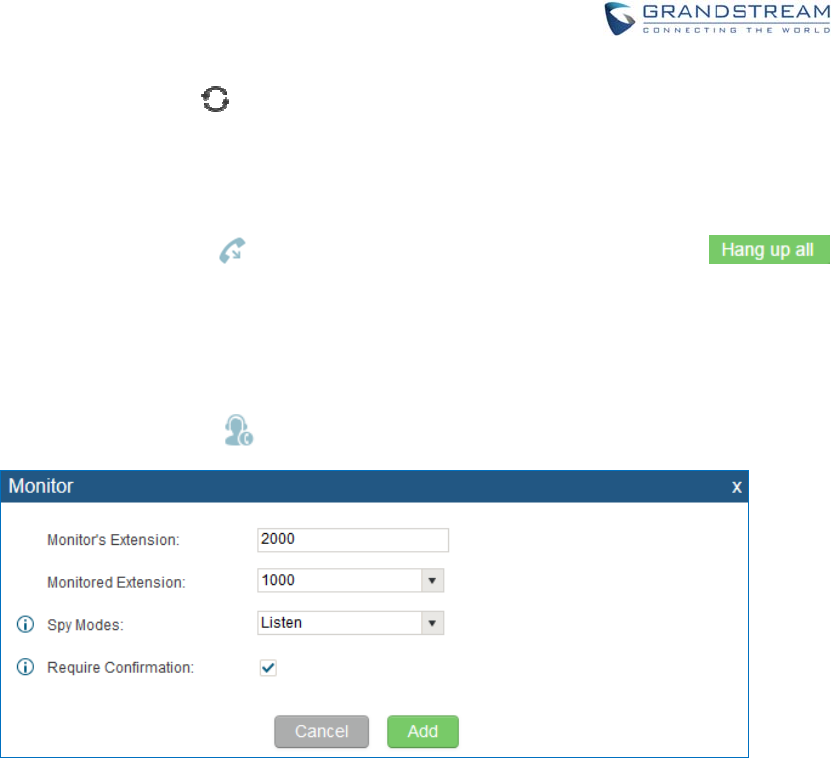
Firmware Version 1.0.0.1 UCM6200 Series IP PBX User Manual Page 251 of 320
In active call web page, click on to refresh the active call status.
HANGUPACTIVECALLS
To hang up an active call, click on icon in the active call dialog. Users can also click on
to hang up all active calls.
CALLMONITOR
During an active call, click on icon and the monitor dialog will pop up.
Figure 152: Configure to Monitor an Active Call
In the “Monitor” dialog, configure the following to monitor an active call:
1. Enter an available extension for “Monitor’s Extension” which will be used to monitor the active call.
2. “Monitored Extension” must be one of the parties in the active call to be monitored.
3. Select spy mode. There are three options in “Spy Mode”.
Listen
In “Listen” mode, the extension monitoring the call can hear both parties in the active call but the
audio of the user on this extension will not be heard by either party in the monitored active call.
Whisper
In “Whisper” mode, the extension monitoring the call can hear both parties in the active call. The
user on this extension can only talk to the selected monitored extension and he/she will not be
heard by the other party in the active call. This can be usually used to supervise calls.
Barge
In “Barge” mode, the extension monitoring the call can talk to both parties in the active call. The
call will be established similar to three-way conference.

Firmware Version 1.0.0.1 UCM6200 Series IP PBX User Manual Page 252 of 320
4. Enable or disable “Require Confirmation” option. If enabled, the confirmation of the invited monitor’s
extension is required before the active call can be monitored. This option can be used to avoid adding
participant who has auto-answer configured or call forwarded to voicemail.
5. Click on “Add”. An INVITE will be sent to the monitor’s extension. The monitor can answer the call and
start monitoring. If “Require Confirmation” is enabled, the user will be asked to confirm to monitor the
call.
Another way to monitor active calls is to dial the corresponding feature codes from an extension. Please
refer to [Table 75: UCM6200 Feature Codes] and [ENABLE SPY] section for instructions.

Firmware Version 1.0.0.1 UCM6200 Series IP PBX User Manual Page 253 of 320

Firmware Version 1.0.0.1 UCM6200 Series IP PBX User Manual Page 254 of 320
CALLFEATURES
The UCM6200 supports call recording, transfer, call forward, call park and other call features via feature
code. This section lists all the feature codes in the UCM6200 and describes how to use the call features.
FEATURECODES
Table 75: UCM6200 Feature Codes
Feature Maps
Blind Transfer
Default code: #1.
Enter the code during active call. After hearing "Transfer", you
will hear dial tone. Enter the number to transfer to. Then the
user will be disconnected and transfer is completed.
Options
Disable
Allow Caller: Enable the feature code on caller side only.
Allow Callee: Enable the feature code on callee side only.
Allow Both: Enable the feature code on both caller and callee.
Attended Transfer
Default code: *2.
Enter the code during active call. After hearing "Transfer", you
will hear the dial tone. Enter the number to transfer to and the
user will be connected to this number. Hang up the call to
complete the attended transfer.
Options
Disable
Allow Caller: Enable the feature code on caller side only.
Allow Callee: Enable the feature code on callee side only.
Allow Both: Enable the feature code on both caller and callee.
Disconnect
Default code: *0.
Enter the code during active call. It will disconnect the call.
Options
Disable
Allow Caller: Enable the feature code on caller side only.
Allow Callee: Enable the feature code on callee side only.
Allow Both: Enable the feature code on both caller and callee.
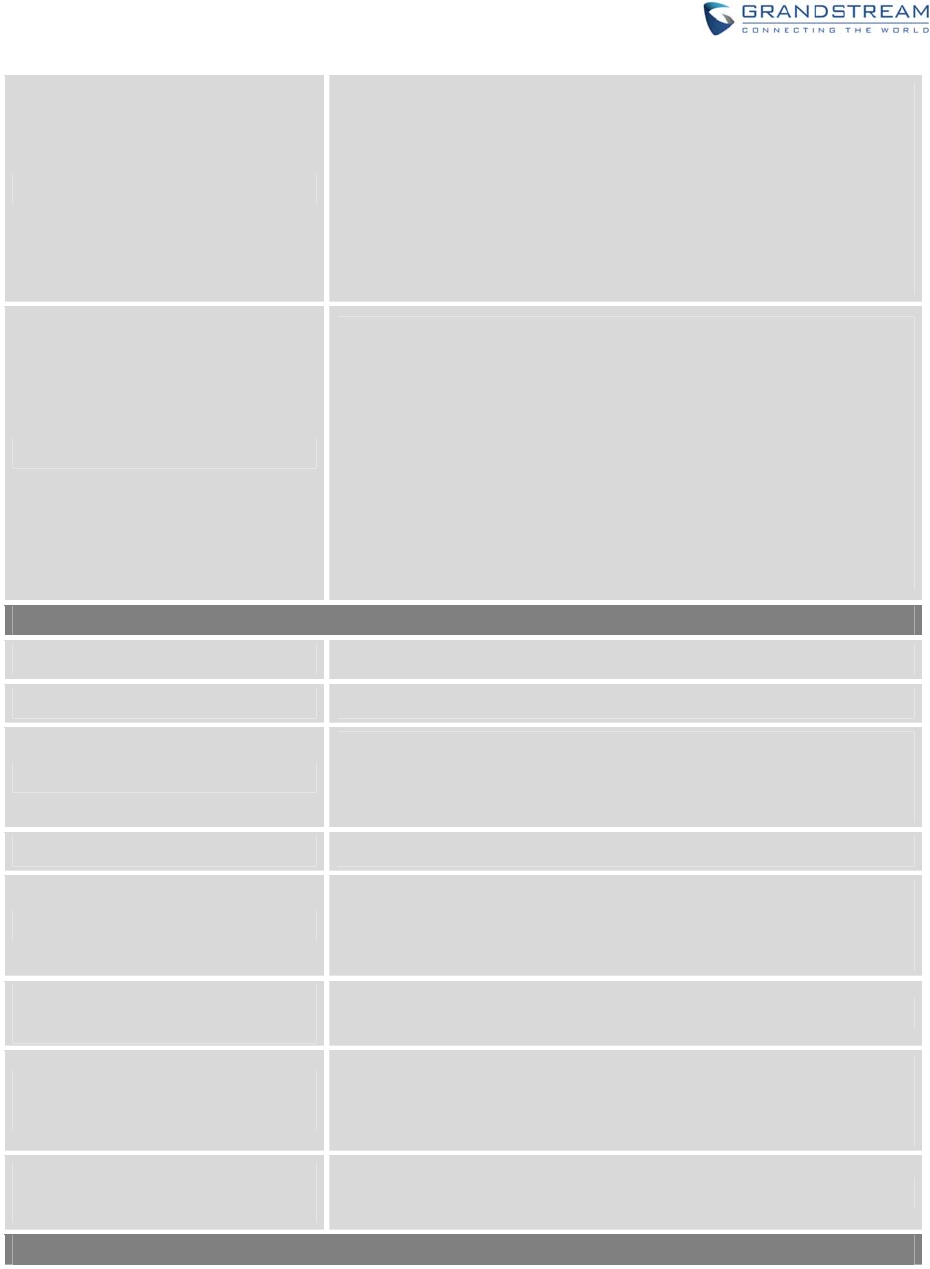
Firmware Version 1.0.0.1 UCM6200 Series IP PBX User Manual Page 255 of 320
Call Park
Default code: #72.
Enter the code during active call to park the call.
Options
Disable
Allow Caller: Enable the feature code on caller side only.
Allow Callee: Enable the feature code on callee side only.
Allow Both: Enable the feature code on both caller and callee.
Audio Mix Record
Default code: *3.
Enter the code followed by # or SEND to start recording the
audio call and the UCM6200 will mix the streams natively on
the fly as the call is in progress.
Options
Disable
Allow Caller: Enable the feature code on caller side only.
Allow Callee: Enable the feature code on callee side only.
Allow Both: Enable the feature code on both caller and callee.
DND/Call Forward
Do Not Disturb (DND) Activate Default code: *77.
Do Not Disturb (DND) Deactivate Default code: *78.
Call Forward Busy Activate
Default Code: *90.
Enter the code and follow the voice prompt. Or enter the code
followed by the extension to forward the call.
Call Forward Busy Deactivate Default Code: *91.
Call Forward No Answer Activate
Default Code: *92.
Enter the code and follow the voice prompt. Or enter the code
followed by the extension to forward the call.
Call Forward No Answer
Deactivate Default Code: *93.
Call Forward Unconditional
Activate
Default Code: *72.
Enter the code and follow the voice prompt. Or enter the code
followed by the extension to forward the call.
Call Forward Unconditional
Deactivate Default Code: *73.
Feature Misc
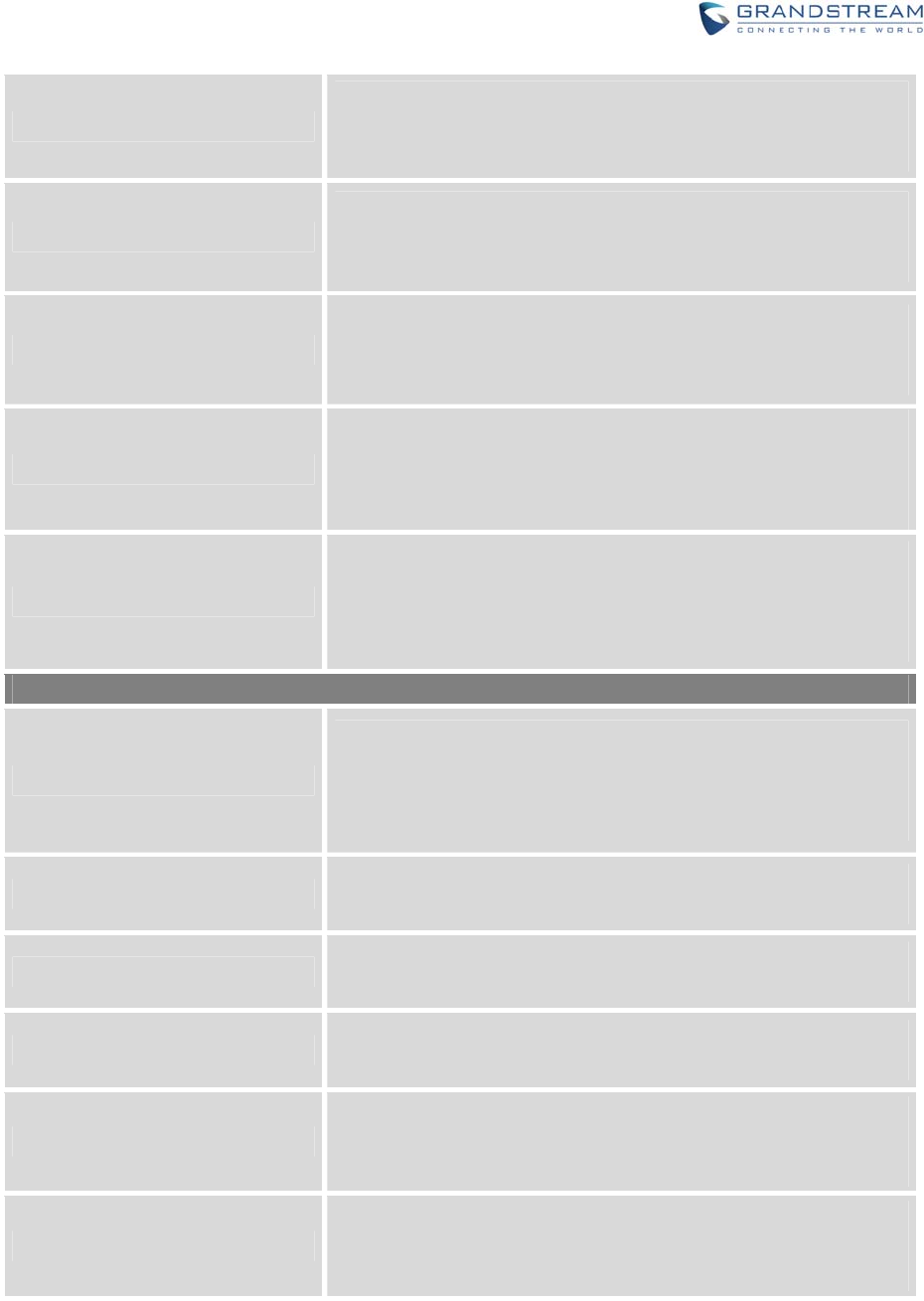
Firmware Version 1.0.0.1 UCM6200 Series IP PBX User Manual Page 256 of 320
Feature Code Digits Timeout
Default Setting: 1000.
Configure the maximum interval (in milliseconds) between the
digits input to activate the feature code.
Call Park
Default Extension: 700.
During an active call, initiate blind transfer and then enter this
code to park the call.
Parked Lots
Default Extension: 701-720.
These are the extensions where the calls will be parked, i.e.,
parking lots that the parked calls can be retrieved.
Use Parklot as Extension
If checked, the parking lot number can be used as extension.
The user can transfer the call to the parking lot number to park
the call. Please note this parking lot number range might
conflict with extension range.
Parking Timeout (s)
Default setting: 300.
This is the timeout allowed for a call to be parked. After the
timeout, if the call is not picked up, the extension who parks the
call will be called back.
Feature Codes
Voicemail Access Code
Default Code: *98.
Enter *98 and follow the voice prompt. Or dial *98 followed by
the extension and # to access the entered extension's
voicemail box.
My Voicemail Default Code: *97.
Press *97 to access the voicemail box.
Agent Pause Default Code: *83.
Pause the agent in all call queues.
Agent Unpause Default Code: *84.
Unpause the agent in all call queues.
Paging Prefix
Default Code: *81.
To page an extension, enter the code followed by the extension
number.
Intercom Prefix
Default Code: *80.
To intercom an extension, enter the code followed by the
extension number.
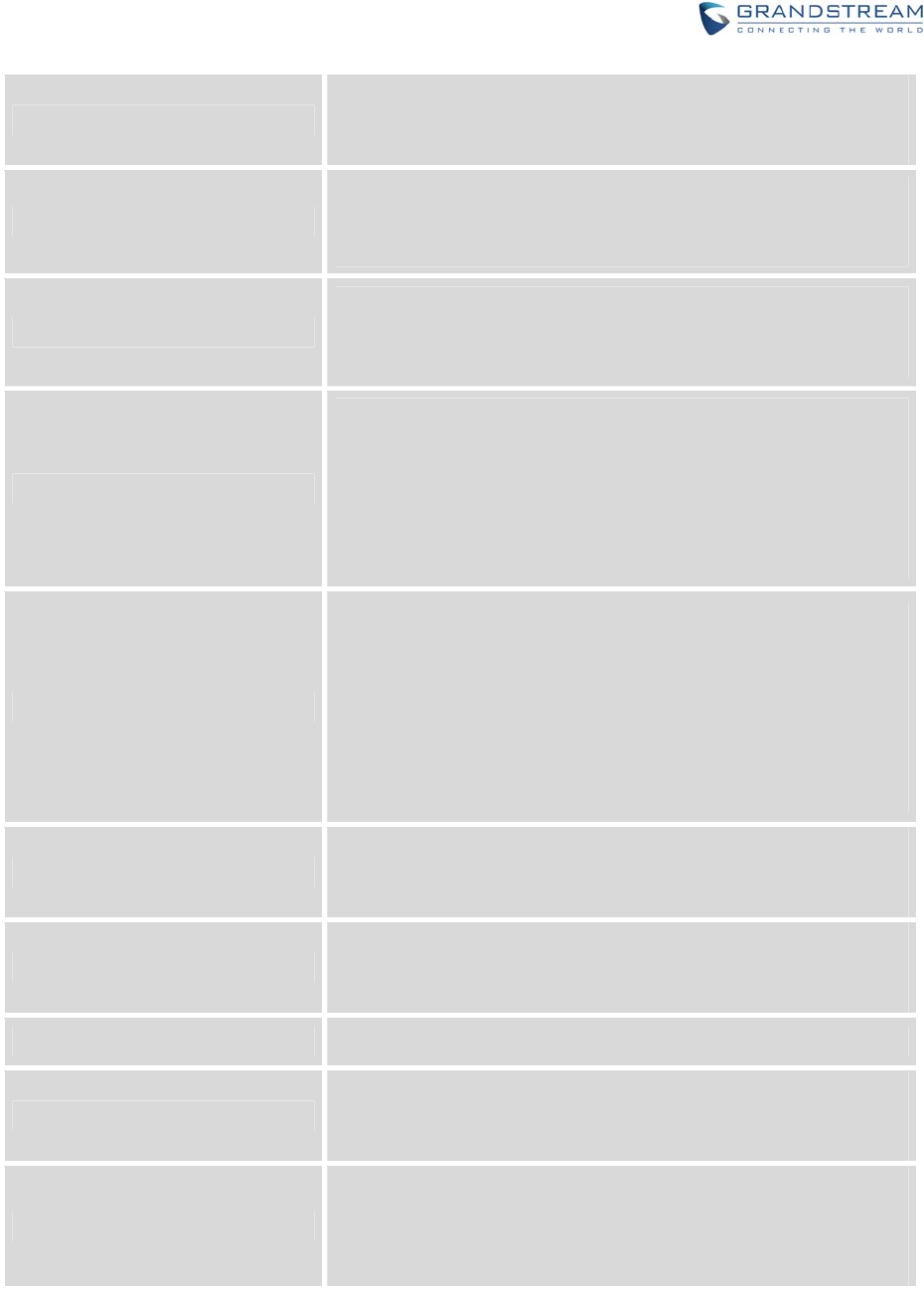
Firmware Version 1.0.0.1 UCM6200 Series IP PBX User Manual Page 257 of 320
Blacklist Add
Default Code: *40.
To add a number to blacklist for inbound route, dial *40 and
follow the voice prompt to enter the number.
Blacklist Remove
Default Code: *41.
To remove a number from current blacklist for inbound route,
dial *41 and follow the voice prompt to remove the number.
Call Pickup on Ringing
Default Code: **.
To pick up a call for any extension xxxx, enter the code followed
by the extension number xxxx.
Pickup Extension
Default Code: *8.
This code is for the pickup group which can be assigned for
each extension on the extension configuration page.
If there is an incoming call to an extension, the other
extensions within the same pickup group can dial *8 directly to
pick up the call.
Direct Dial Voicemail Prefix
Default Code: *
This code is for the user to directly dial or transfer to an
extension's voicemail.
For example, directly dial *5000 will have to call go into the
extension 5000's voicemail. If the user would like to transfer the
call to the extension 5000's voicemail, enter *5000 as the
transfer target number.
Call Completion Request
Default Code: *11
This code is for the user who wants to use Call Completion to
complete a call.
Call Completion Cancel
Default Code: *12
This code is for the user who wants to cancel Call Completion
request.
Enable Spy Check this box to enable spy feature codes.
Listen Spy
This is the feature code to listen in on a call to monitor
performance. Monitor’s line will be muted, and neither party will
hear from the monitor’s extension. The default setting is *54.
Whisper Spy
This is the feature code to speak to one side of the call (for
example, whisper to employees to help them handle a call). Only
one side will be able to hear from the monitor’s extension. The
default setting is *55.
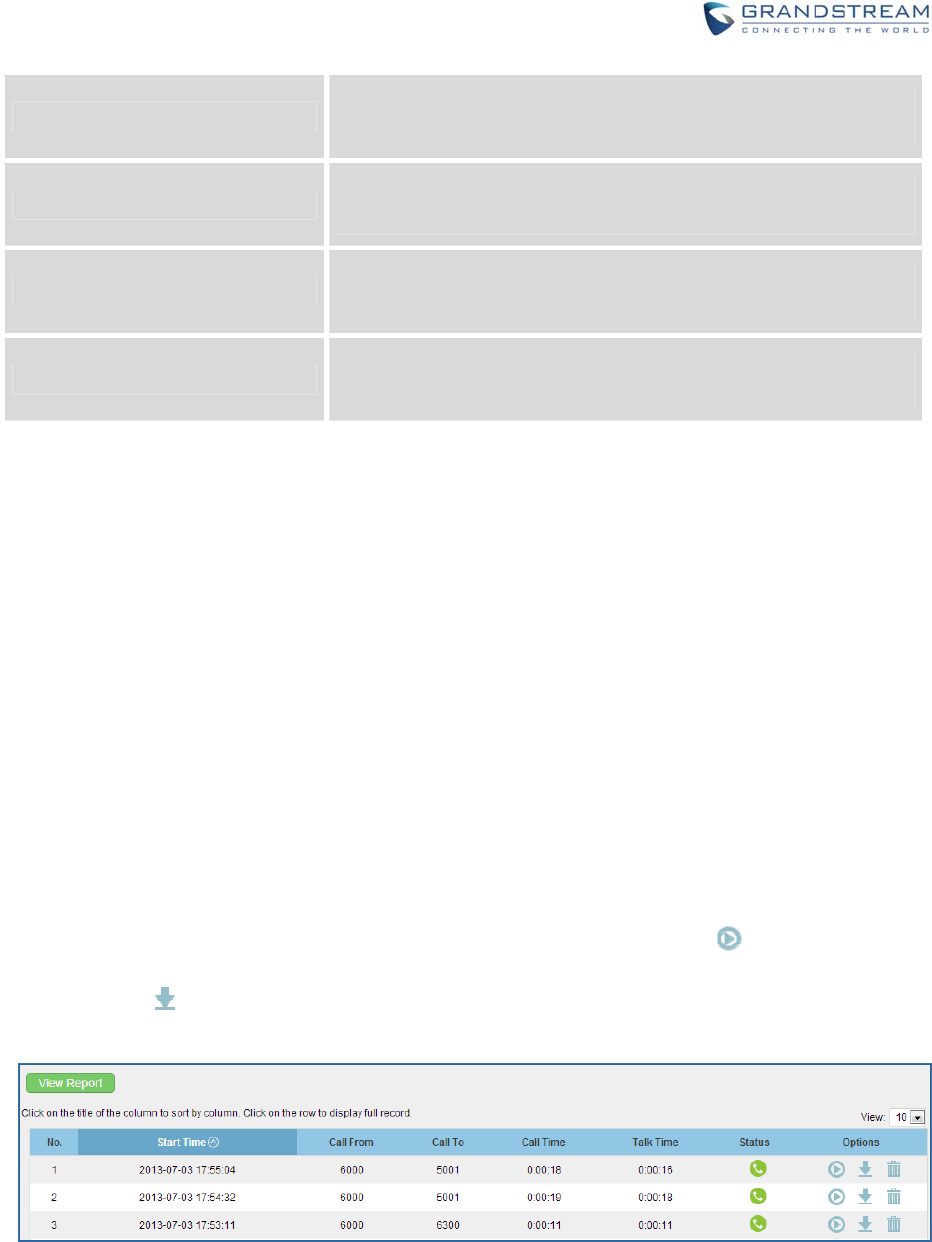
Firmware Version 1.0.0.1 UCM6200 Series IP PBX User Manual Page 258 of 320
Barge Spy This is the feature code to join in on the call to assist both parties.
The default setting is *56.
Enable Inbound Multiple Mode If enabled, user can switch between different inbound route modes
with feature code. By default, this option is disabled.
Inbound Default Mode This feature code is used to switch inbound route mode to default
mode. The default setting is *61.
Inbound Mode 1 This feature code is used to switch inbound route mode to mode 1.
The default setting is *62.
CALLRECORDING
The UCM6200 allows users to record audio during the call. If "Auto Record" is turned on for an extension,
ring group, call queue or trunk, the call will be automatically recorded when there is established call with it.
Otherwise, please follow the instructions below to manually record the call.
1. Make sure the feature code for "Audio Mix Record" is configured and enabled.
2. After establishing the call, enter the "Audio Mix Record" feature code (by default it's *3) followed by #
or SEND to start recording.
3. To stop the recording, enter the "Audio Mix Record" feature code (by default it's *3) followed by # or
SEND again. Or the recording will be stopped once the call hangs up.
4. The recording file can be retrieved under Web GUI->Status->CDR. Click on to play the recording
or click on to download the recording file.
Figure 153: Download Recording File from CDR Page
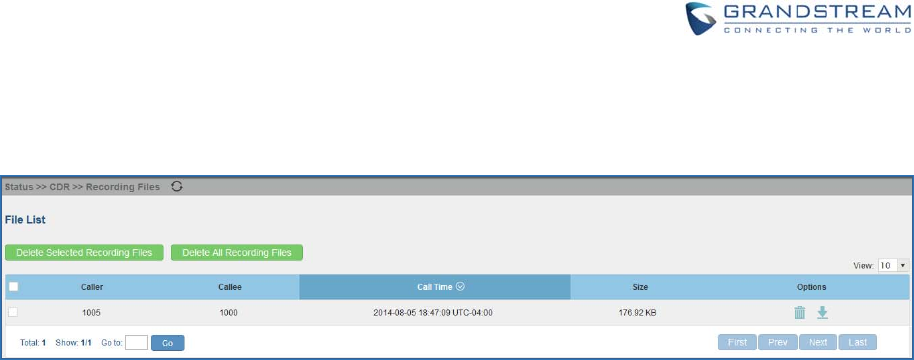
Firmware Version 1.0.0.1 UCM6200 Series IP PBX User Manual Page 259 of 320
The above recorded call's recording files are also listed under the UCM6200 web GUI->CDR->Recording
Files.
Figure 154: Download Recording File from Recording Files Page
CALLPA R K
The UCM6200 provides call park and call pickup features via feature code.
PARKACALL
There are two feature codes that can be used to park the call.
Feature Maps->Call Park (Default code #72)
During an active call, press #72 and the call will be parked. Parking lot number (default range 701 to
720) will be announced after parking the call.
Feature Misc->Call Park (Default code 700)
During an active call, initiate blind transfer (default code #1) and then dial 700 to park the call. Parking
lot number (default range 701 to 720) will be announced after parking the call.
RETRIEVETHEPARKEDCALL
To retrieve the parked call, simply dial the parking lot number and the call will be established. If a parked
call is not retrieved after the timeout, the original extension who parks the call will be called back.
ENABLESPY
If “Enable Spy” option is enabled, feature codes for Listen Spy, Whisper Spy and Barge Spy are available
for users to dial from any extension to perform the corresponding actions.

Firmware Version 1.0.0.1 UCM6200 Series IP PBX User Manual Page 260 of 320
Assume a call is on-going between extension A and extension B, user could dial the feature code from
extension C to listen on their call (*54 by default), whisper to one side (*55 by default), or barge into the call
(*56 by default). Then the user will be asked to enter the number to call, which should be either side of the
active call, extension A or B in this example.
--------------------------------------------------------------------------------------------------------------------------------------------
Caution:
“Enable Spy” allows any user to listen to any call by feature codes. This may result in the leakage of user
privacy.
--------------------------------------------------------------------------------------------------------------------------------------------

Firmware Version 1.0.0.1 UCM6200 Series IP PBX User Manual Page 261 of 320
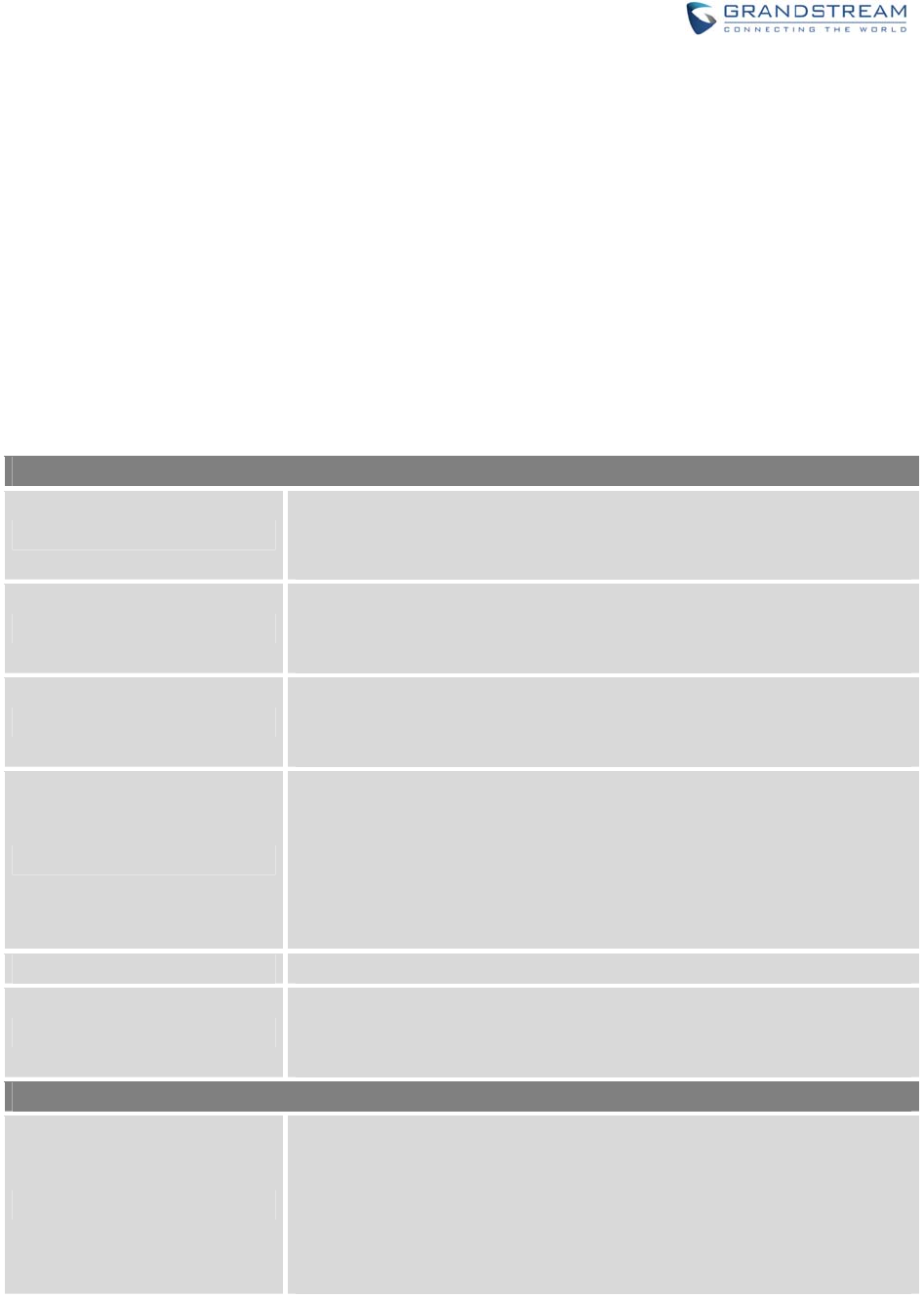
Firmware Version 1.0.0.1 UCM6200 Series IP PBX User Manual Page 262 of 320
INTERNALOPTIONS
This section describes internal options that haven't been mentioned in previous sections yet. The settings
in this section can be applied globally to the UCM6200, including general configurations, jitter buffer, RTP
settings, ports config and STUN monitor. The options can be accessed via Web GUI->PBX->Internal
Options-> General.
INTERNALOPTIONS/GENERAL
Table 76: Internal Options/General
General Preferences
Global OutBound CID
Configure the global CallerID used for all outbound calls when no other
CallerID is defined with higher priority. If no CallerID is defined for
extension or trunk, the global outbound CID will be used as CallerID.
Global OutBound CID Name
Configure the global CallerID Name used for all outbound calls. If
configured, all outbound calls will have the CallerID Name set to this
name. If not, the extension's CallerID Name will be used.
Operator Extension
Specify the operator extension, which will be dialed when users press 0 to
exit voicemail application. The operator extension can also be used in
IVR option.
Ring Timeout
Configure the number of seconds to ring an extension before the call
goes to the user's voicemail box. The default setting is 60.
Note:
This is the global value used for each extension if "Ring Timeout" field is
left empty on the extension configuration page.
Call Duration Limit Configure the maximum duration of call-blocking.
Record Prompt
If enabled, users will hear voice prompt before recording is started or
stopped. For example, before recording, the UCM6200 will play voice
prompt "The call will be recorded". The default setting is "No".
Extension Preferences
Enforce Strong Passwords
If enabled, strong password will be enforced for the password created on
the UCM6200. The default setting is enabled.
Strong Password Rules:
1. Password for voicemail, voicemail group, outbound route, DISA, call
queue and conference requires non-repetitive and non-sequential

Firmware Version 1.0.0.1 UCM6200 Series IP PBX User Manual Page 263 of 320
digits, with a minimum length of 4 digits. Repetitive digits pattern
(such as 0000, 1111, 1234, 2345, and etc), or common digits pattern
(such as 111222, 321321 and etc) are not allowed to be configured as
password.
2. Password for extension registration, web GUI admin login, LDAP and
LDAP sync requires alphanumeric characters containing at least two
categories of the following, with a minimum length of 4 characters.
Numeric digits
Lowercase alphabet characters
Uppercase alphabet characters
Special characters
Enable Random Password
If enabled, random password will be generated when the extension is
created. The default setting is "Yes". It is recommended to enable it for
security purpose.
Enable Auto Email To User If enabled, UCM6200 will send Email notification to user automatically
after editing extension settings or adding a new extension.
Disable Extension Range
If set to "Yes", users could disable the extension range
pre-configured/configured on the UCM6200. The default setting is "No".
Note:
It is recommended to keep the system assignment to avoid inappropriate
usage and unnecessary issues.
Extension Ranges
The default extension range assignment is:
User Extensions: 1000-6299
User Extensions is referring to the extensions created under web
UI->PBX->Basic/Call Routes->Extensions page.
Pick Extensions: 4000-4999
This refers to the extensions that can be manually picked from end
device when being provisioned by the UCM6200. There are two
related options in zero config page->Auto Provision Settings, "Pick
Extension Segment" and "Enable Pick Extension". If "Enable Pick
Extension" under zero config settings is selected, the extension list
defined in "Pick Extension Segment" will be sent out to the device
after receiving the device's request. This "Pick Extension Segment"
should be a subset of the "Pick Extensions" range here. This feature
is for the GXP series phones that support selecting extension to be
provisioned via phone's LCD.
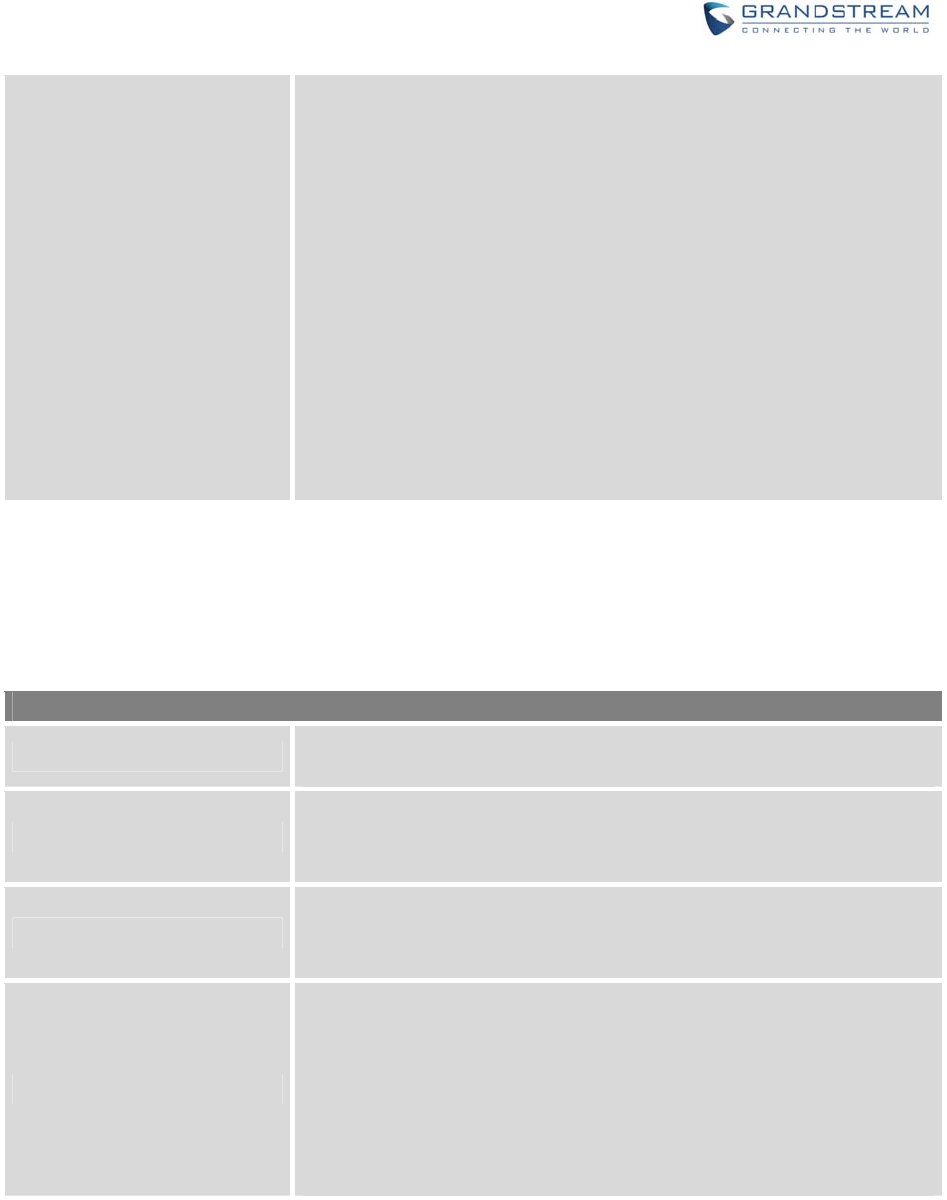
Firmware Version 1.0.0.1 UCM6200 Series IP PBX User Manual Page 264 of 320
Auto Provision Extensions: 5000-6299
This sets the range for "Zero Config Extension Segment" which is the
extensions can be assigned on the UCM6200 to provision the end
device.
Conference Extensions: 6300-6399
Ring Group Extensions: 6400-6499
Queue Extensions: 6500-6599
Voicemail Group Extensions: 6600-6699
IVR Extensions: 7000-7100
Dial By Name Extensions: 7101-7199
Fax Extensions: 7200-8200
INTERNALOPTIONS/JITTERBUFFER
Table 77: Internal Options/Jitter Buffer
SIP Jitter Buffer
Enable Jitter Buffer Select to enable jitter buffer on the sending side of the SIP channel. The
default setting is "No".
Jitter Buffer Size
Configure the time (in ms) to buffer. This is the jitter buffer size used in
"Fixed" jitter buffer, or used as the initial time for "adaptive" jitter buffer.
The default setting is 100.
Max Jitter Buffer
Configure the maximum time (in ms) to buffer for "Adaptive" jitter buffer
implementation, or used as the jitter buffer size for "Fixed" jitter buffer
implementation. The default setting is 200.
Implementation
Configure the jitter buffer implementation on the sending side of a SIP
channel. The default setting is "Fixed".
Fixed
The size is always equal to the value of "Max Jitter Buffer".
Adaptive
The size is adjusted automatically and the maximum value equals to
the value of "Max Jitter Buffer".
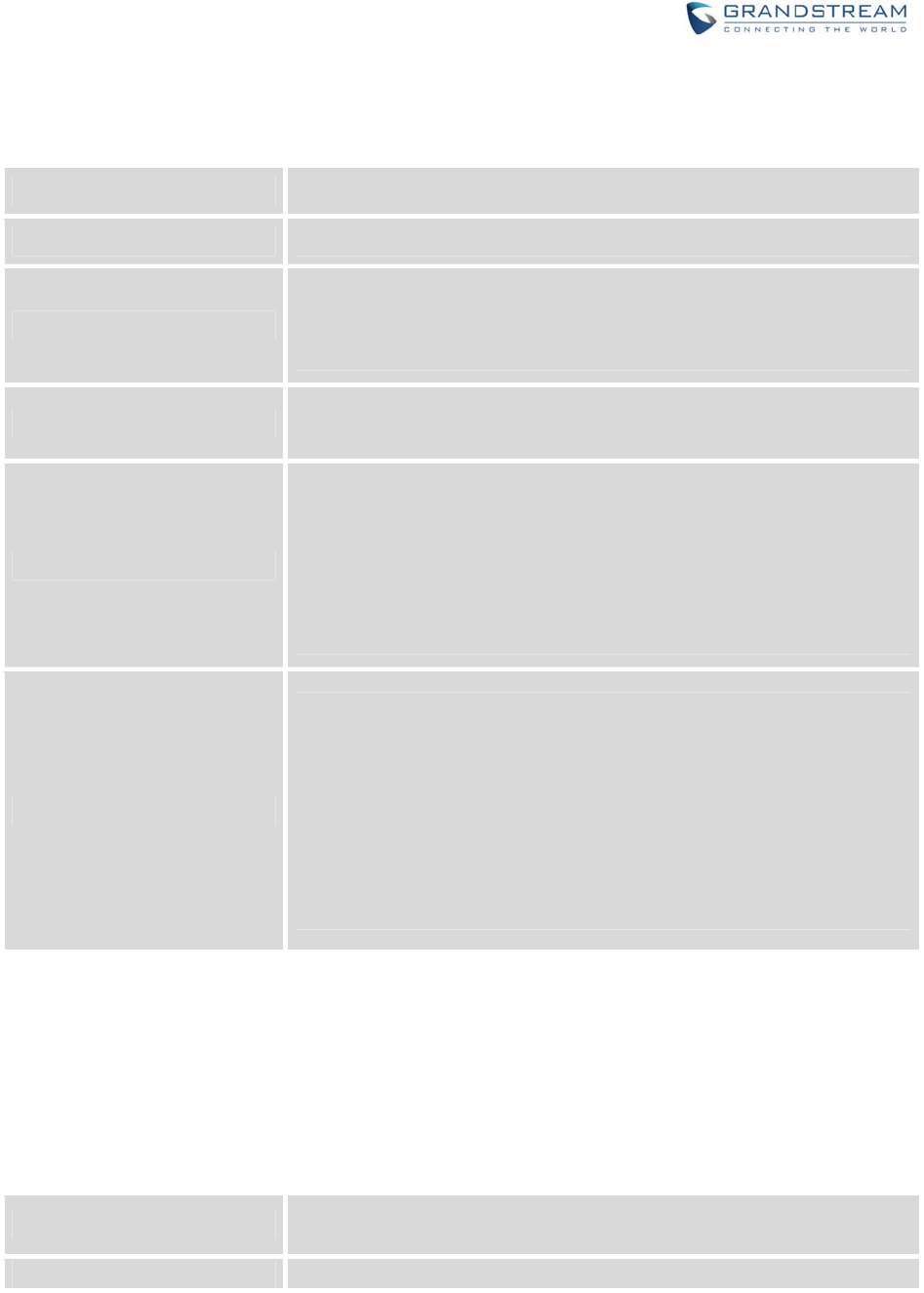
Firmware Version 1.0.0.1 UCM6200 Series IP PBX User Manual Page 265 of 320
INTERNALOPTIONS/RTPSETTINGS
Table 78: Internal Options/RTP Settings
RTP Start Configure the RTP port starting number. The default setting is 10000.
RTP End Configure the RTP port ending address. The default setting is 20000.
Strict RTP
Configure to enable or disable strict RTP protection. If enabled, RTP
packets that do not come from the source of the RTP stream will be
dropped. The default setting is "Disable".
RTP Checksums Configure to enable or disable RTP Checksums on RTP traffic. The
default setting is "Disable".
ICE Support
Configure whether to support ICE. The default setting is enabled.
ICE is the integrated use of STUN and TURN structure to provide reliable
VoIP or video calls and media transmission, via a SIP request/ response
model or multiple candidate endpoints exchanging IP addresses and
ports, such as private addresses and TURN server address.
STUN Server
Configure STUN server address. STUN protocol is a Client/Server and
also a Request/Response protocol. It’s used to check the connectivity
between the two terminals, such as maintaining a NAT binding entries
keep-alive agreement. The default STUN Server is stun.ipvideotalk.com.
Valid format:
[(hostname | IP-address) [':' port]
The default port number is 3478 if not specified.
INTERNALOPTIONS/PAYLOAD
The UCM6200 payload type for audio codecs and video codes can be configured here.
Table 79: Internal Options/Payload
AAL2-G.726 Configure payload type for ADPCM (G.726, 32kbps, AAL2 codeword
packing). The default setting is 112.
DTMF Configured payload type for DTMF. The default setting is 101.
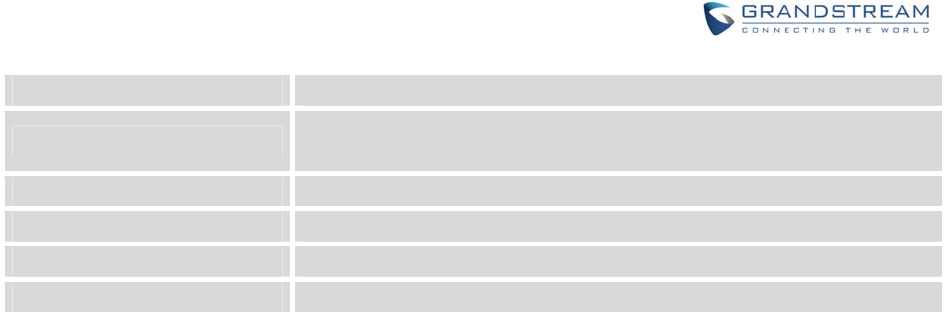
Firmware Version 1.0.0.1 UCM6200 Series IP PBX User Manual Page 266 of 320
G.721 Compatible Configure to enable/disable G.721 compatible. The default setting is Yes.
G.72 6 Configure the payload type for G.726 if "G.721 Compatible" is disabled.
The default setting is 111.
iLBC Configure the payload type for iLBC. The default setting is 97.
H.264 Configure the payload type for H.264. The default setting is 99.
H.263P Configure the payload type for H.263+. The default setting is 100 103.
VP8 Configure the payload type for VP8. The default settings is 108.

Firmware Version 1.0.0.1 UCM6200 Series IP PBX User Manual Page 267 of 320
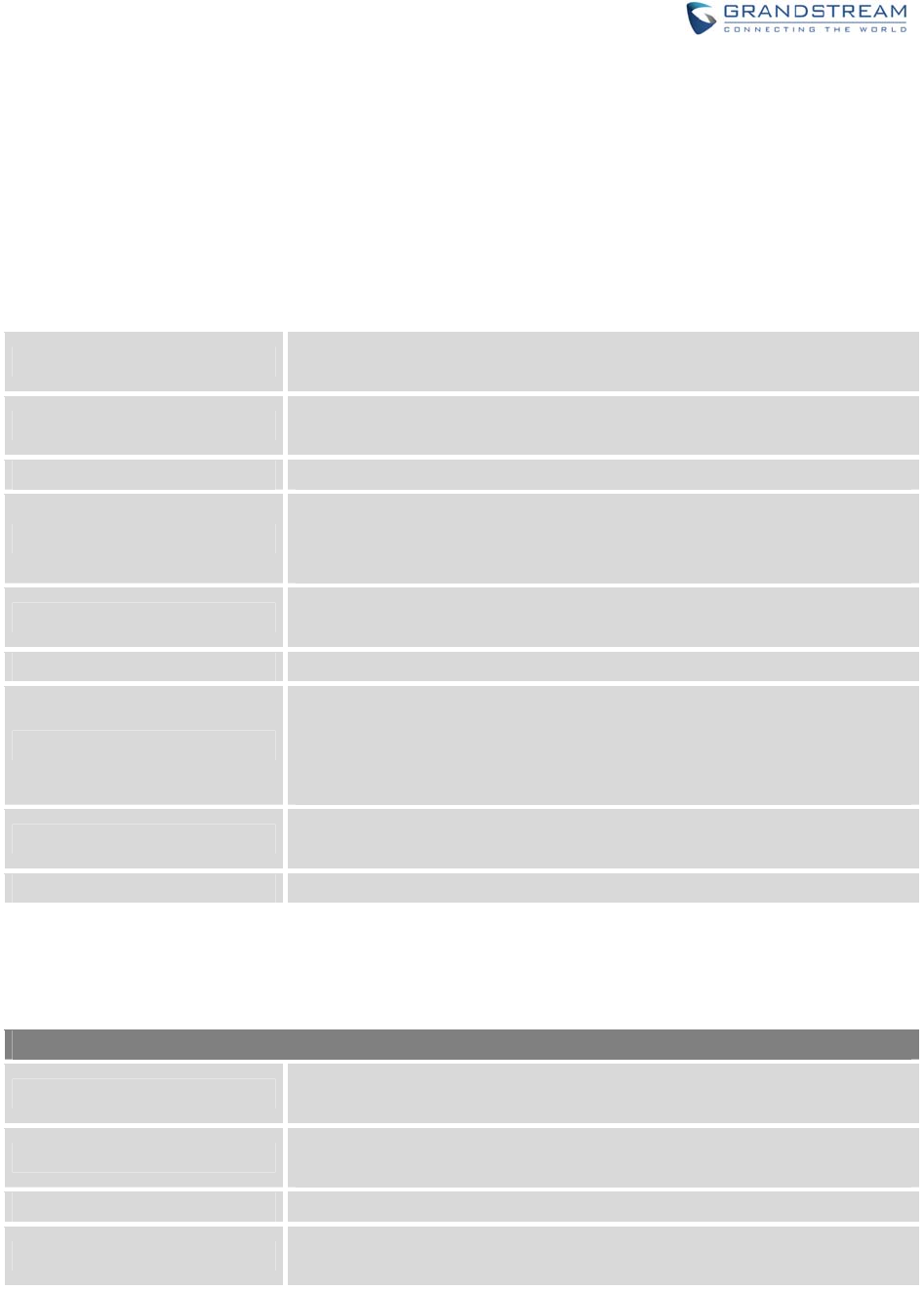
Firmware Version 1.0.0.1 UCM6200 Series IP PBX User Manual Page 268 of 320
IAXSETTINGS
The UCM6200 IAX global settings can be accessed via Web GUI->PBX->IAX Settings.
IAXSETTINGS/GENERAL
Table 80: IAX Settings/General
Bind Port Configure the port number that the IAX2 will be allowed to listen to. The
default setting is 4569.
Bind Address Configure the address that the IAX2 will be forced to bind to. The default
setting is 0.0.0.0, which means all addresses.
IAX1 Compatibility Select to configure IAX1 compatibility. The default setting is "No".
No Checksums
If selected, UDP checksums will be disabled and no checksums will be
calculated/checked on systems supporting this features. The default
setting is "No".
Delay Reject If enabled, the IAX2 will delay the rejection of calls to avoid DOS. The
default setting is "No".
ADSI Select to enable ADSI phone compatibility. The default setting is "No".
Music On Hold Interpret
Specify which Music On Hold class this channel would like to listen to
when being put on hold. This music class is only effective if this channel
has no music class configured and the bridged channel putting the call on
hold has no "Music On Hold Suggest" setting.
Music On Hold Suggest Specify which Music On Hold class to suggest to the bridged channel
when putting the call on hold.
Bandwidth Configure the bandwidth for IAX settings. The default setting is "Low".
IAXSETTINGS/REGISTRATION
Table 81: IAX Settings/Registration
IAX Registration Options
Min Reg Expire Configure the minimum period (in seconds) of registration. The default
setting is 60.
Max Reg Expire Configure the maximum period (in seconds) of registration. The default
setting is 3600.
IAX Thread Count Configure the number of IAX helper threads. The default setting is 10.
IAX Max Thread Count Configure the maximum number of IAX threads allowed. The default
setting is 100.
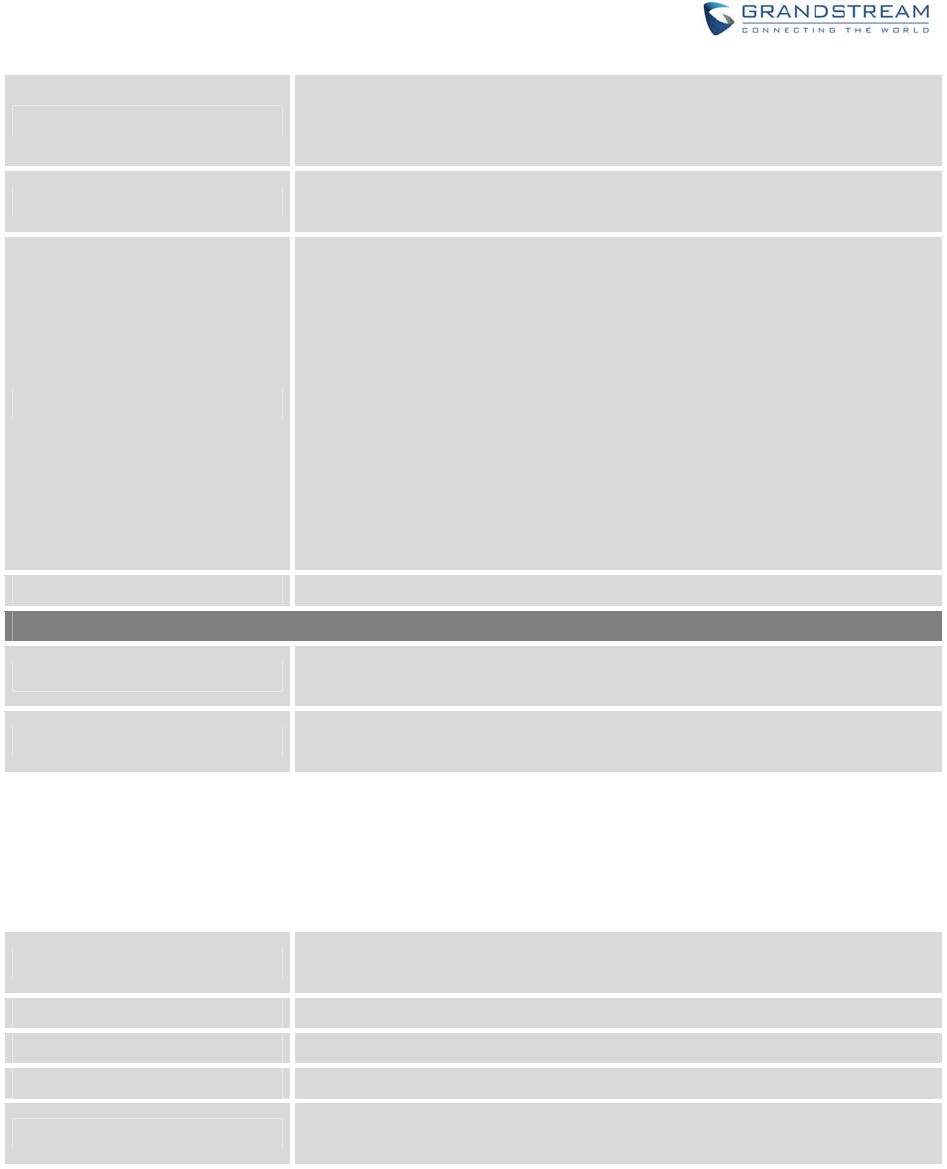
Firmware Version 1.0.0.1 UCM6200 Series IP PBX User Manual Page 269 of 320
Auto Kill
If set to "yes", the connection will be terminated if ACK for the NEW
message is not received within 2000ms. Users could also specify number
(in milliseconds) in addition to "yes" and "no". The default setting is "yes".
Authentication Debugging If enabled, authentication traffic in debugging will not show. The default
setting is "No".
Codec Priority
Configure codec negotiation priority. The default setting is "Reqonly".
Caller
Consider the callers preferred order ahead of the host's.
Host
Consider the host's preferred order ahead of the caller's.
Disabled
Disable the consideration of codec preference all together.
Reqonly
This is almost the same as "Disabled", except when the requested
format is not available. The call will only be accepted if the requested
format is available.
Type of Service Configure ToS bit for preferred IP routing.
IAX Trunk Options
Trunk Frequency Configure the frequency of trunk frames (in milliseconds). The default
setting is 20.
Trunk Time Stamps If enabled, time stamps will be attached to trunk frames. The default
setting is "No".
IAXSETTINGS/STATICDEFENSE
Table 82: IAX Settings/Static Defense
Call Token Optional Enter a single IP address (e.g., 11.11.11.11) or a range of IP addresses
(11.11.11.11/22.22.22.22) for which call token validation is not required.
Max Call Numbers Configure the maximum number of calls allowed for a single IP address.
Max Unvalidated Call Numbers Configure the maximum number of unvalidated calls for all IP addresses.
Call Number Limits Configure to limit the number of calls for a give IP address of IP range.
IP or IP Range Enter the IP address (11.11.11.11) or a range of IP addresses
(11.11.11.11/22.22.22.22) to be considered for call number limits.
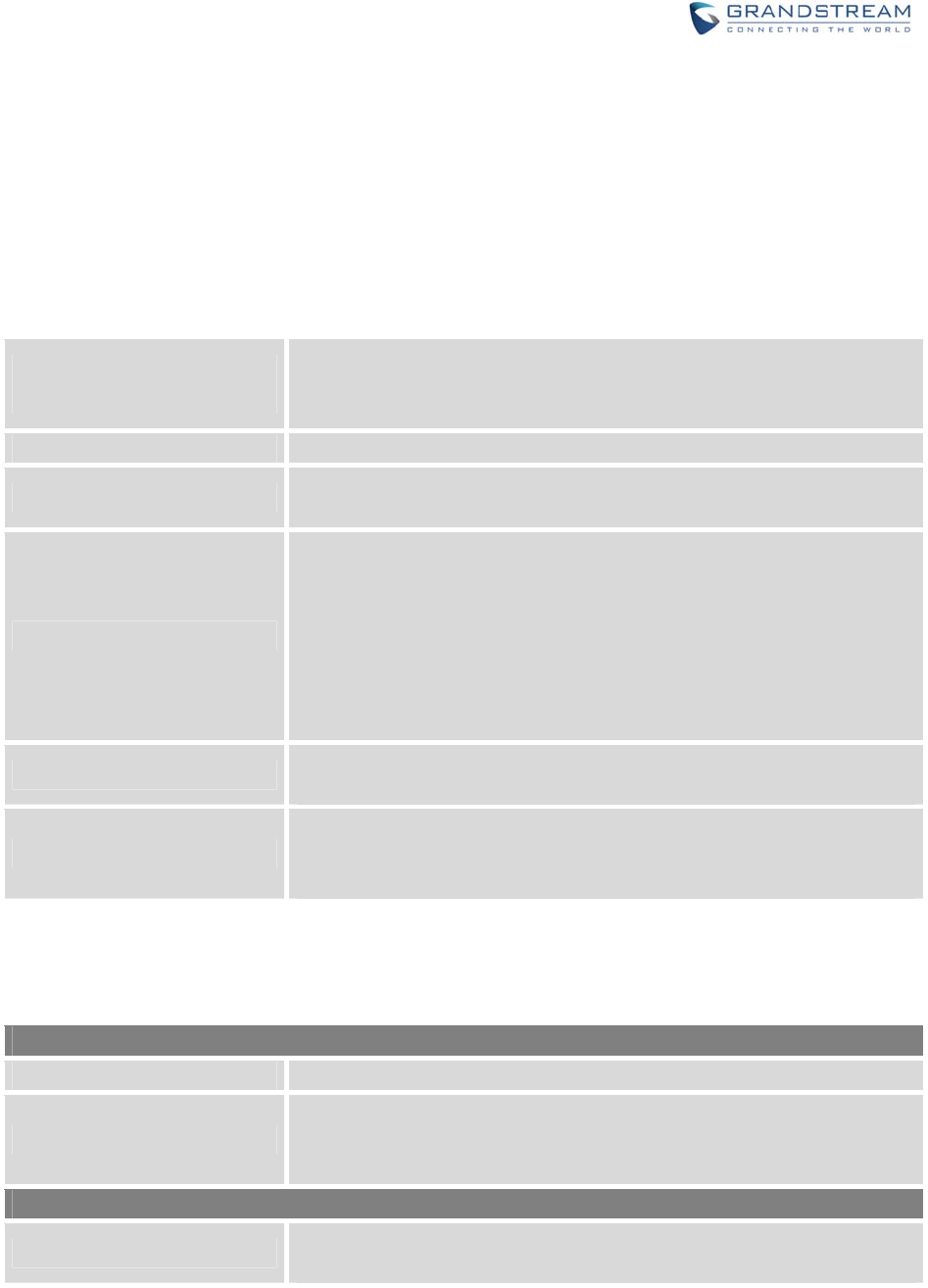
Firmware Version 1.0.0.1 UCM6200 Series IP PBX User Manual Page 270 of 320
SIPSETTINGS
The UCM6200 SIP global settings can be accessed via Web GUI->PBX->SIP Settings.
SIPSETTINGS/GENERAL
Table 83: SIP Settings/General
Realm For Digest
Authentication
Configure the host name or domain name for the UCM6200. Realms
MUST be globally unique according to RFC3261. The default setting is
Grandstream.
Bind UDP Port Configure the UDP port used for SIP. The default setting is 5060.
Bind IP Address Configure the IP address to bind to. The default setting is 0.0.0.0, which
means binding to all addresses.
Allow Guest Calls
If enabled, the UCM6200 allows unauthorized INVITE coming into the
PBX and the call can be made. The default setting is "No".
Warning:
Please be aware of the potential security risk when enabling "Allow Guest
Calls" as this will allow any user with the UCM6200 address to dial into
the UCM6200.
Allow Transfer If set to "No", all transfers initiated by the endpoint in the UCM6200 will be
disabled (unless enabled in peers or users). The default setting is "Yes".
MWI From
When sending MWI NOTIFY requests, this value will be used in the
"From:" header as the "name" field. If no "From User" is configured, the
"user" field of the URI in the "From:" header will be filled with this value.
SIPSETTINGS/MISC
Table 84: SIP Settings/Misc
Outbound SIP Registrations
Register Timeout Configure the register retry timeout (in seconds). The default setting is 20.
Register Attempts
Configure the number of registration attempts before the UCM6200 gives
up. The default setting is 0, which means the UCM6200 will keep trying
until the server side accepts the registration request.
Video
Max Bit Rate (kb/s) Configure the maximum bit rate (in kb/s) for video calls. The default
setting is 384.

Firmware Version 1.0.0.1 UCM6200 Series IP PBX User Manual Page 271 of 320
Support SIP Video Select to enable video support in SIP calls. The default setting is "Yes".
Reject Non-Matching INVITE
If enabled, when rejecting an incoming INVITE or REGISTER request, the
UCM6200 will always reject with "401 Unauthorized" instead of notifying
the requester whether there is a matching user or peer for the request.
This reduces the ability of an attacker to scan for valid SIP usernames.
The default setting is "No".
SIPSETTINGS/SESSIONTIMER
Table 85: SIP Settings/Session Timer
Session Timers
Select the session timer mode. The default setting is "Accept".
The options are:
Originate
Always request and run session timer.
Accept
Run session timer only when requested by other UA.
Refuse
Do not run session timer.
Session Expire Configure the maximum session refresh interval (in seconds). The default
setting is 1800.
Min SE Configure the minimum session refresh interval (in seconds). The default
setting is 90.
Session Refresher Select the session refresher to be UAC or UAS. The default setting is
UAC.
SIPSETTINGS/TCPANDTLS
Table 86: SIP Settings/TCP and TLS
TCP Enable Configure to allow incoming TCP connections with the UCM6200. The
default setting is "No".
TCP Bind Address
Configure the IP address for TCP server to bind to. 0.0.0.0 means binding
to all interfaces. The port number is optional. If not specified, 5060 will be
used.
TLS Enable Configure to allow incoming TLS connections with the UCM6200. The
default setting is "No".
TLS Bind Address
Configure the IP address for TLS server to bind to. 0.0.0.0 means binding
to all interfaces. The port number is optional. If not specified, 5061 will be
used.
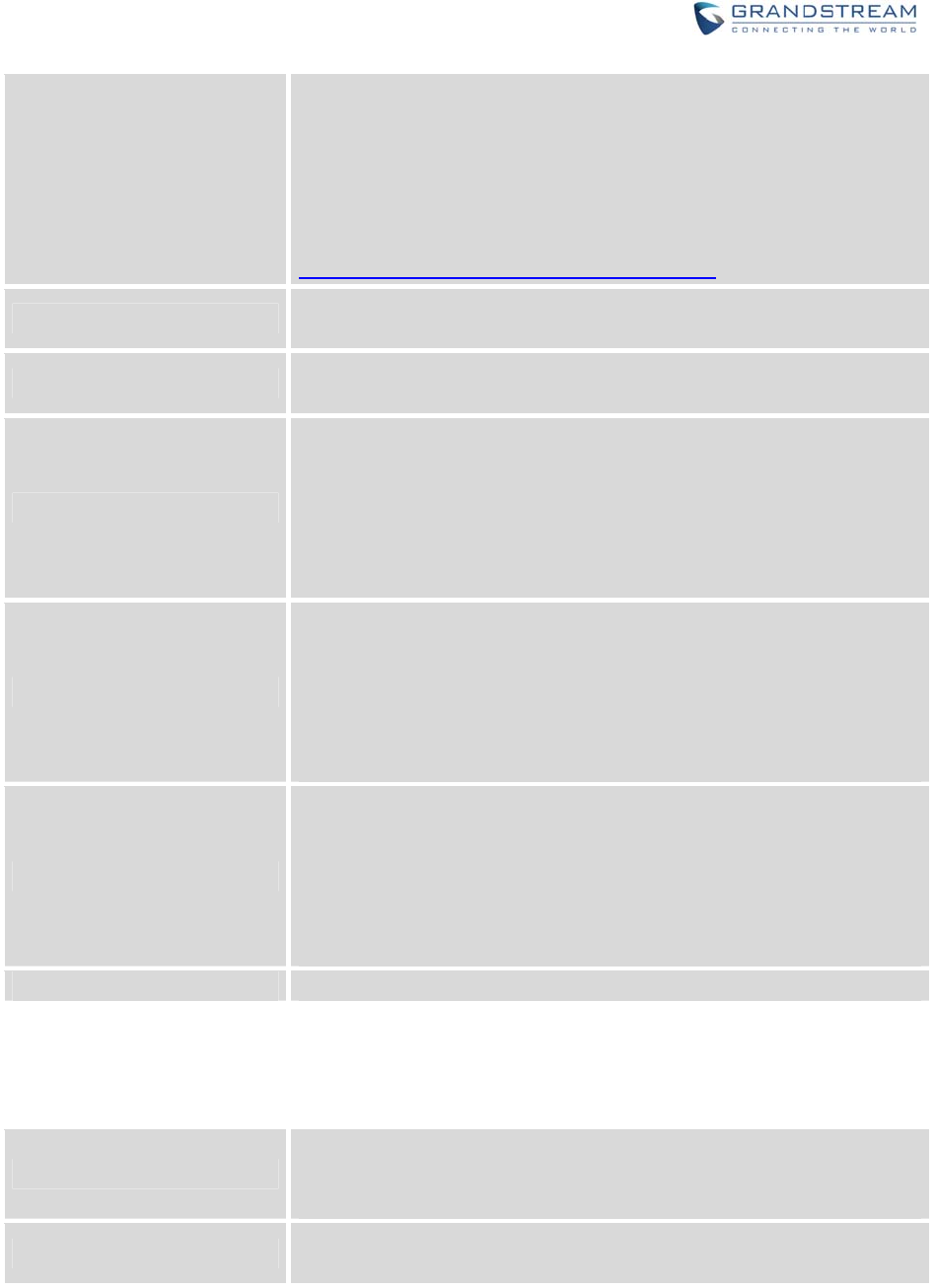
Firmware Version 1.0.0.1 UCM6200 Series IP PBX User Manual Page 272 of 320
Note:
The IP address must match the common name (hostname) in the
certificate. Please do not bind a TLS socket to multiple IP addresses. For
details on how to construct a certificate for SIP, please refer to the
following document:
http://tools.ietf.org/html/draft-ietf-sip-domain-certs
TLS Client Protocol Select the TLS protocol for outbound client connections. The default
setting is TLSv1.
TLS Do Not Verify If enabled, the TLS server's certificate won't be verified when acting as a
client. The default setting is "Yes".
TLS Self-Signed CA
This is the CA certificate if the TLS server being connected to requires
self-signed certificate, including server's public key. This file will be
renames as "TLS.ca" automatically.
Note:
The size of the uploaded ca file must be under 2MB.
TLS Cert
This is the Certificate file (*.pem format only) used for TLS connections. It
contains private key for client and signed certificate for the server. This file
will be renamed as "TLS.pem" automatically.
Note:
The size of the uploaded certificate file must be under 2MB.
TLS CA Cert
This file must be named with the CA subject name hash value. It contains
CA's (Certificate Authority) public key, which is used to verify the
accessed servers.
Note:
The size of the uploaded CA certificate file must be under 2MB.
TLS CA List Display a list of files under the CA Cert directory.
SIPSETTINGS/NAT
Table 87: SIP Settings/NAT
External Host
Configure a static IP address and port (optional) used in outbound SIP
messages if the UCM6200 is behind NAT. If it is a host name, it will only
be looked up once.
Use IP address in SDP If enabled, the SDP connection will use the IP address resolved from the
external host.
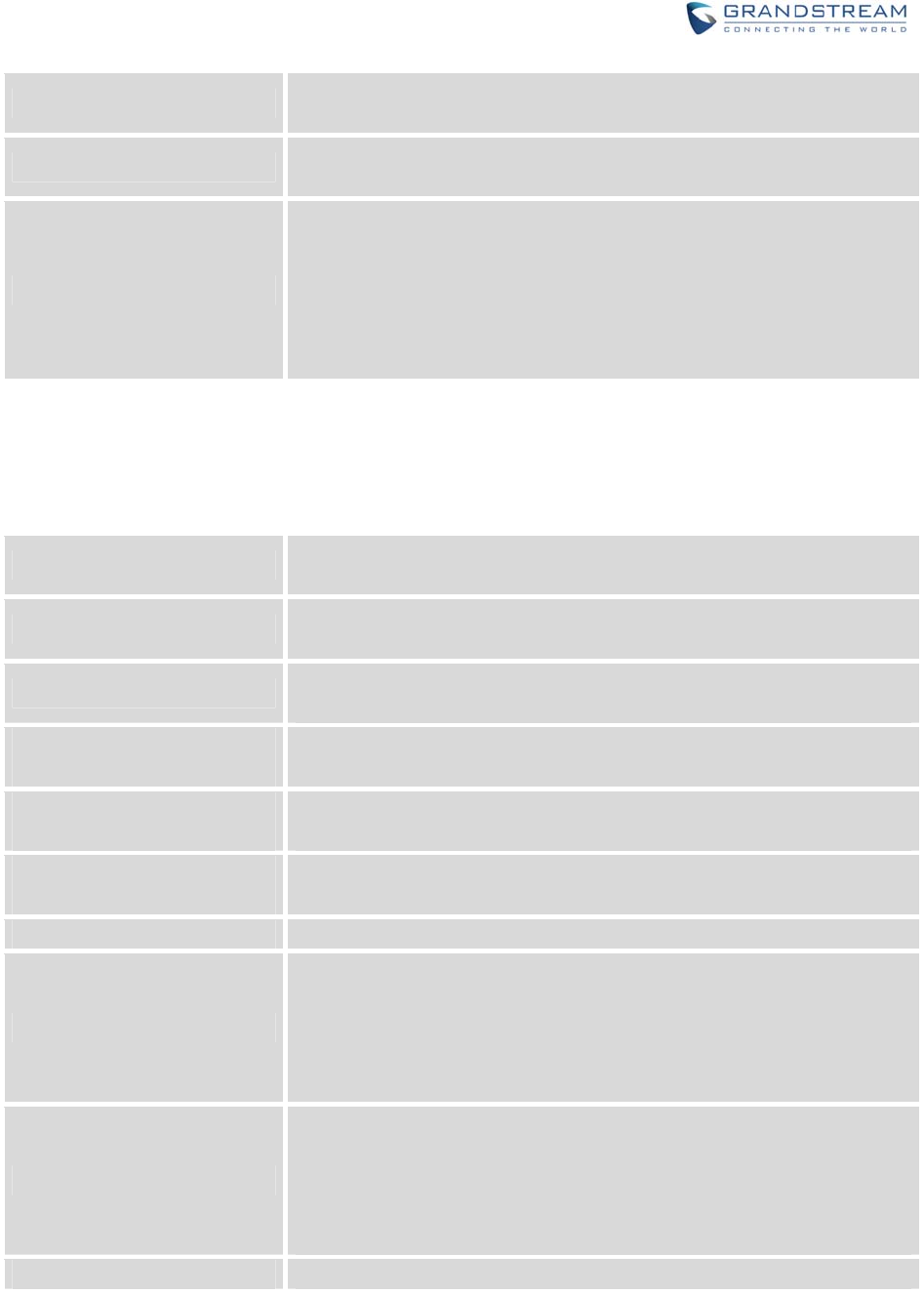
Firmware Version 1.0.0.1 UCM6200 Series IP PBX User Manual Page 273 of 320
External TCP Port Configure the externally mapped TCP port when the UCM6200 is behind
a static NAT or PAT.
External TLS Port Configures the externally mapped TLS port when UCM6200 is behind a
static NAT or PAT.
Local Network Address
Specify a list of network addresses that are considered inside of the NAT
network. Multiple entries are allowed. If not configured, the external IP
address will not be set correctly.
A sample configuration could be as follows:
192.168.0.0/16
SIPSETTINGS/TOS
Table 88: SIP Settings/ToS
ToS For SIP Configure the Type of Service for SIP packets. The default setting is
None.
ToS For RTP Audio Configure the Type of Service for RTP audio packets. The default setting
is None.
ToS For RTP Video Configure the Type of Service for RTP video packets. The default setting
is None.
Default Incoming/Outgoing
Registration Time
Configure the default duration (in seconds) of incoming/outgoing
registration. The default setting is 120.
Max Registration/Subscription
Time
Configure the maximum duration (in seconds) of incoming registration
and subscription allowed by the UCM6200. The default setting is 3600.
Min Registration/Subscription
Time
Configure the minimum duration (in seconds) of incoming registration and
subscription allowed by the UCM6200. The default setting is 60.
Enable Relaxed DTMF Select to enable relaxed DTMF handling. The default setting is "No".
DTMF Mode
Select DTMF mode to send DTMF. The default setting is RFC2833. If
"Info" is selected, SIP INFO message will be used. If "Inband" is selected,
64-kbit codec PCMU and PCMA are required. When "Auto" is selected,
"RFC2833" will be used if offered, otherwise "Inband" will be used. The
default setting is "RFC2833".
RTP Timeout
During an active call, if there is no RTP activity within the timeout (in
seconds), the call will be terminated. The default setting is no timeout.
Note:
This setting doesn't apply to calls on hold.
RTP Hold Timeout When the call is on hold, if there is no RTP activity within the timeout (in
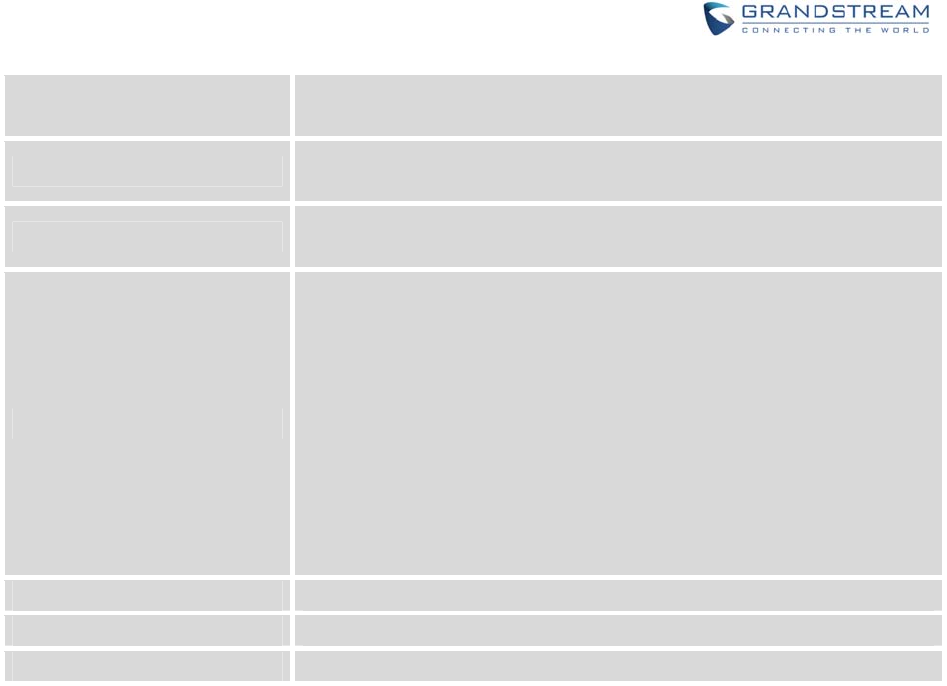
Firmware Version 1.0.0.1 UCM6200 Series IP PBX User Manual Page 274 of 320
seconds), the call will be terminated. This value of RTP Hold Timeout
should be larger than RTP Timeout. The default setting is no timeout.
Trust Remote Party ID Configure whether the Remote-Party-ID should be trusted. The default
setting is "No".
Send Remote Party ID Configure whether the Remote-Party-ID should be sent or not. The
default setting is "No".
Generate In-Band Ringing
Configure whether the UCM6200 should generate inband ringing or not.
The default setting is "Never".
Yes: The UCM6200 will send 180 Ringing followed by 183 Session
Progress and in-band audio.
No: The UCM6200 will send 180 Ringing if 183 Session Progress has
not been sent yet. If audio path is established already with 183 then
send in-band ringing.
Never: Whenever ringing occurs, the UCM6200 will send 180 Ringing
as long as 200OK has not been set yet. Inband ringing will not be
generated even the end point device is not working properly.
Server User Agent Configure the user agent string for the UCM6200.
Send Compact SIP Headers If enabled, compact SIP headers will be sent. The default setting is "No".
100rel Configure the 100rel setting on UCM6200. The default setting is “Yes”.

Firmware Version 1.0.0.1 UCM6200 Series IP PBX User Manual Page 275 of 320
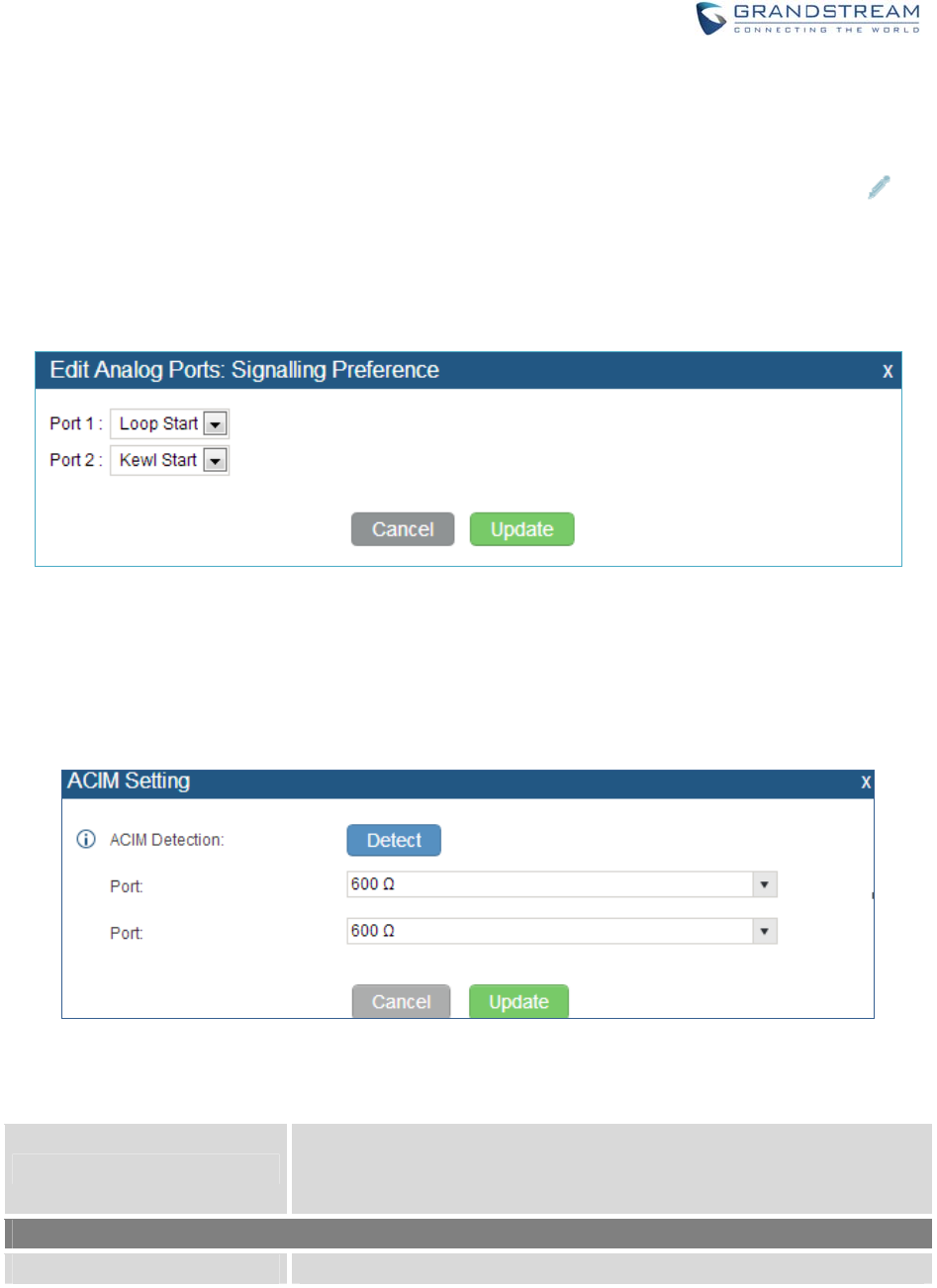
Firmware Version 1.0.0.1 UCM6200 Series IP PBX User Manual Page 276 of 320
PORTSCONFIG
The analog hardware (FXS port and FXO port) on the UCM6200 will be listed in this page. Click on to
edit signaling preference for FXS port or configure ACIM settings for FXO port.
Select "Loop Start" or "Kewl Start" for each FXS port. And then click on "Update" to save the change.
Figure 155: FXS Ports Signaling Preference
For FXO port, users could manually enter the ACIM settings by selecting the value from dropdown list for
each port. Or users could click on "Detect" for the UCM6200 to automatically detect the ACIM value. The
detecting value will be automatically filled into the settings.
Figure 156: FXO Ports ACIM Settings
Table 89: Internal Options/Ports Config
Tone Region
Select country to set the default tones for dial tone, busy tone, ring tone
and etc to be sent from the FXS port. The default setting is "United States
of America (USA)".
Advanced Settings
FXO Opermode Select country to set the On Hook Speed, Ringer Impedance, Ringer
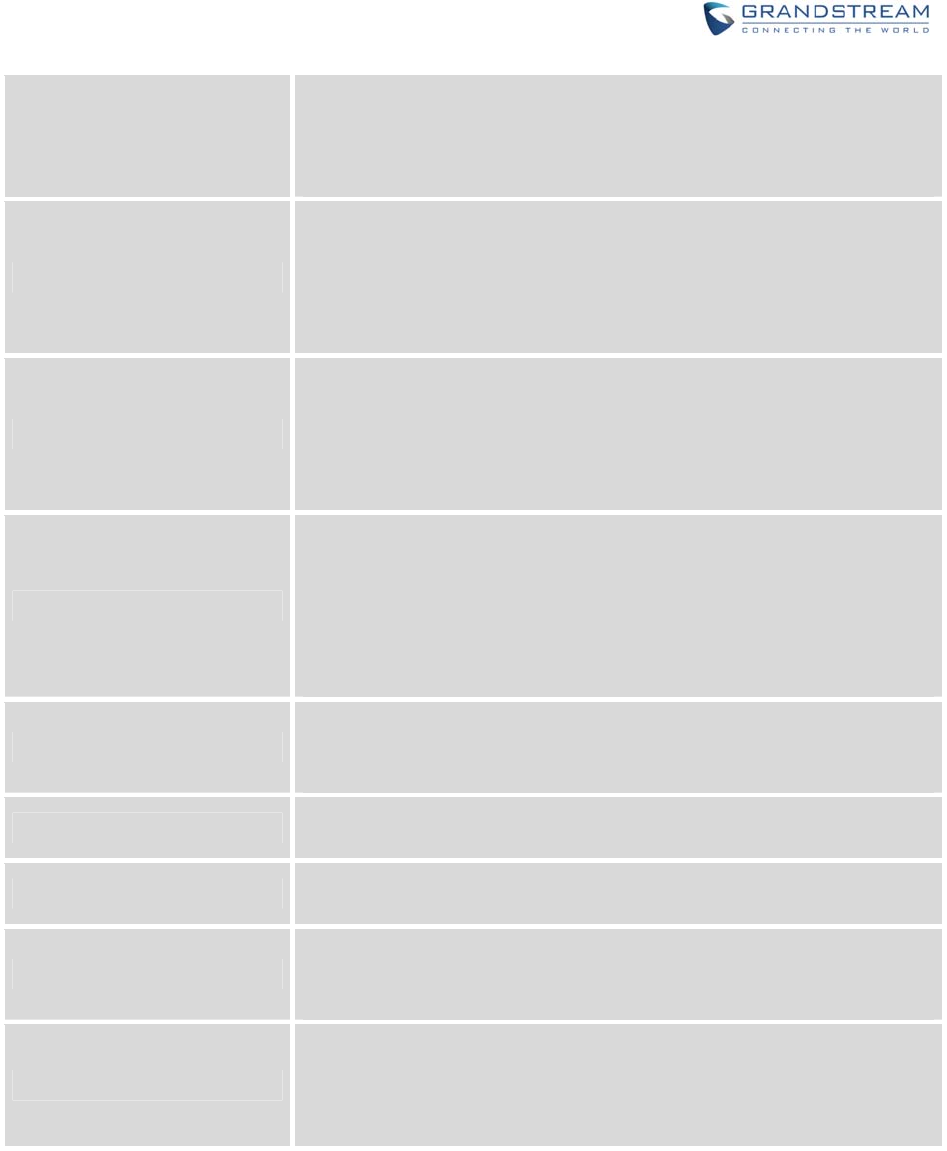
Firmware Version 1.0.0.1 UCM6200 Series IP PBX User Manual Page 277 of 320
Threshold, Current Limiting, TIP/RING voltage adjustment, Minimum
Operational Loop Current, and AC Impedance as predefined for your
country's analog line characteristics. The default setting is "United States
of America (USA)".
FXS Opermode
Select country to set the On Hook Speed, Ringer Impedance, Ringer
Threshold, Current Limiting, TIP/RING voltage adjustment, Minimum
Operational Loop Current, and AC Impedance as predefined for your
country's analog line characteristics. The default setting is "United States
of America (USA)".
FXS TISS Override
Configure to enable or disable override Two-Wire Impedance Synthesis
(TISS). The default setting is No.
If enabled, users can select the impedance value for Two-Wire
Impedance Synthesis (TISS) override. The default setting is 600Ω.
PCMA Override
Select the codec to be used for analog lines. North American users
should choose PCMU. All other countries, unless already known, should
be assumed to be PCMA. The default setting is PCMU.
Note:
This option requires system reboot to take effect.
Boost Ringer
Configure whether normal ringing voltage (40V) or maximum ringing
voltage (89V) for analog phones attached to the FXS port is required. The
default setting is "Normal".
Fast Ringer Configure to increase the ringing speed to 25HZ. This option can be used
with "Low Power" option. The default setting is "Normal".
Low Power Configure the peak voltage up to 50V during "Fast Ringer" operation. This
option is used with "Fast Ringer". The default setting is "Normal".
Ring Detect
If set to "Full Wave", false ring detection will be prevented for lines where
Caller ID is sent before the first ring and proceeded by a polarity reversal,
as in UK. The default setting is "Standard".
FXS MWI Mode
Configure the type of Message Waiting Indicator on FXS lines. The
default setting is "FSK".
FSK: Frequency Shift Key Indicator
NEON: Light Neon Bulb Indicator.
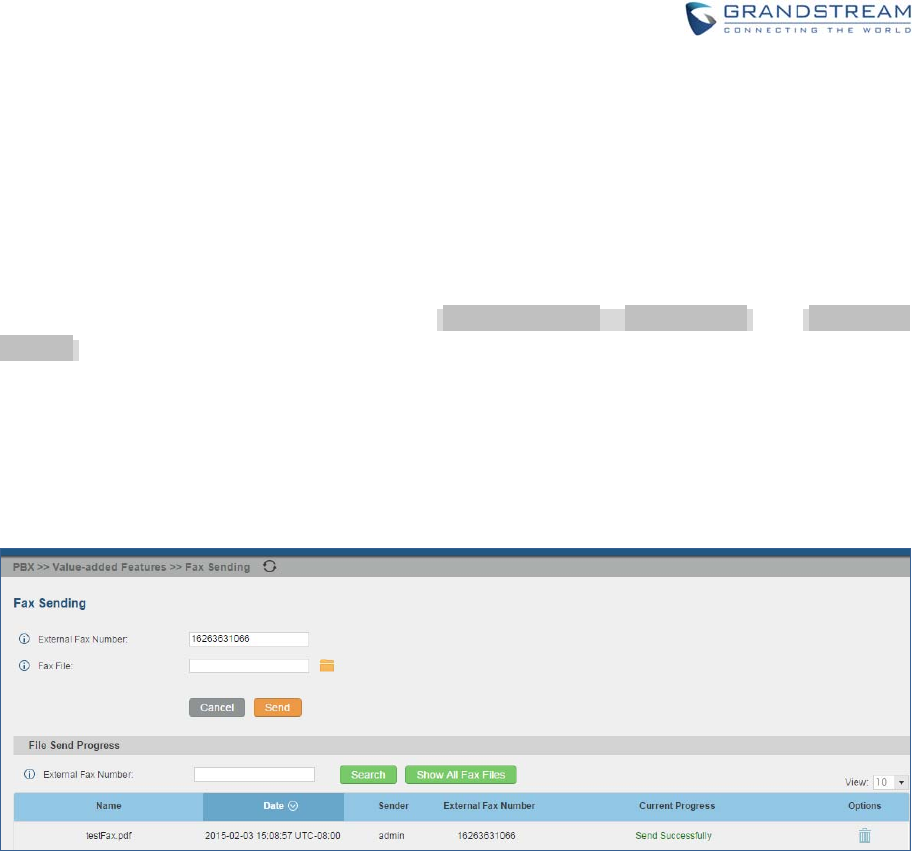
Firmware Version 1.0.0.1 UCM6200 Series IP PBX User Manual Page 278 of 320
VALUE‐ADDEDFEATURES
FAXSENDING
The UCM6200 supports sending Fax via web UI access. This feature can be found on web
UI->PBX->Value-added Features->Fax Sending page. In order to send fax, pre-setup for analog trunk
and outbound route is required. Please refer to [ANALOG TRUNKS], [VOIP TRUNKS] and [OUTBOUND
ROUTES] sections for configuring analog trunk and outbound route.
After making sure analog trunk or VoIP Trunk is setup properly and UCM6200 can reach out to PSTN
numbers via the trunk, on Fax Sending page, enter the fax number and upload the file to be faxed. Then
click on “Send” to start. The progress of sending fax will be displayed in web UI. Users can also view the
sending history is in the same web page.
Figure 157: Fax Sending in Web UI
ANNOUNCEMENTSCENTER
The UCM6200 supports Announcements Center feature which allows users to pre-record and store voice
message into UCM6200 with a specified code. The users can also create group with specified extensions.
When the code and the group number are dialed together in the combination of code + group number,
the specified voice message is sent to all group members and only extensions in the group will hear the
voice message.
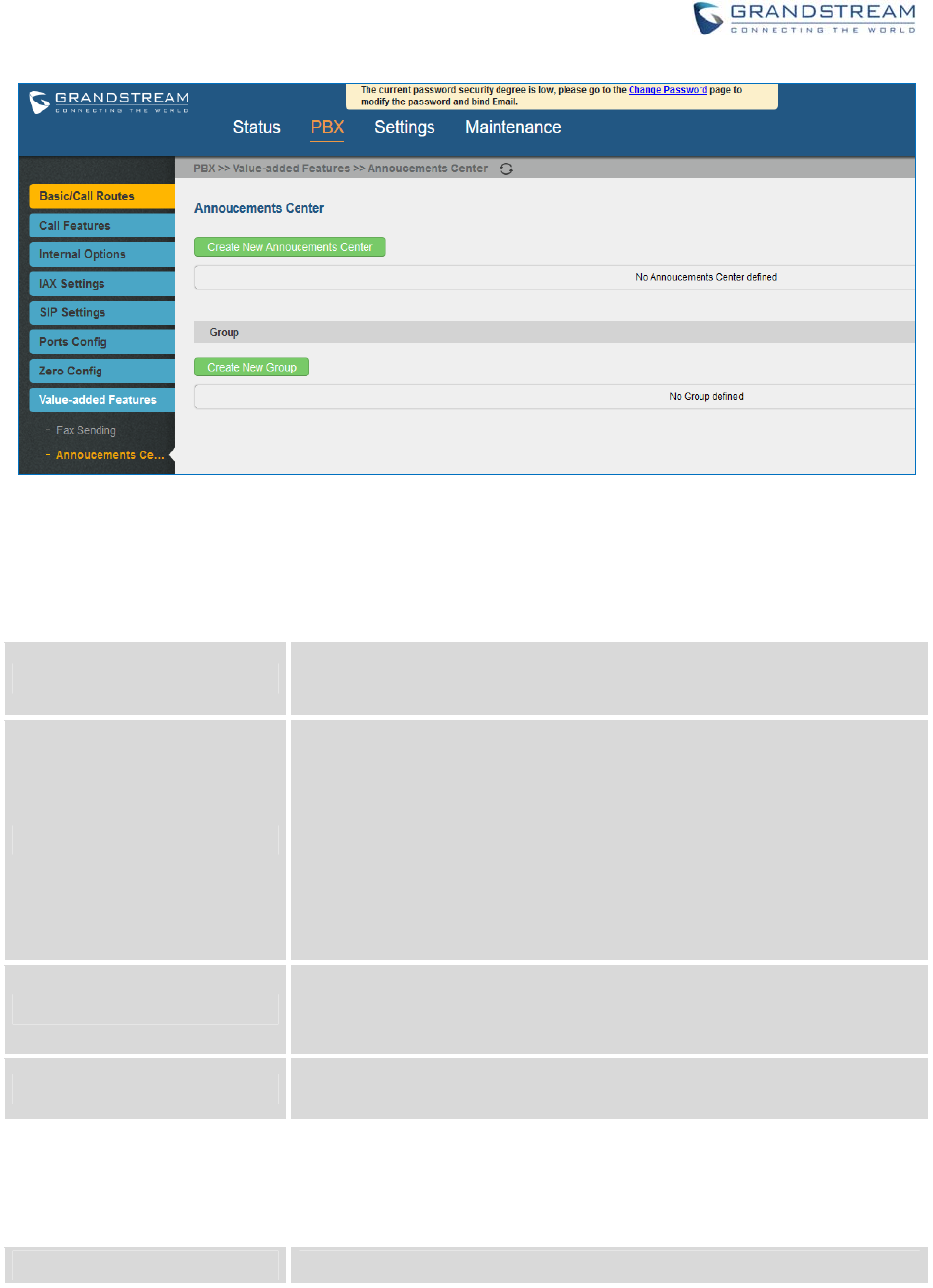
Firmware Version 1.0.0.1 UCM6200 Series IP PBX User Manual Page 279 of 320
Figure 158: Announcements Center
ANNOUNCEMENTSCENTERSETTINGS
Table 90: Announcements Center Settings
Name Configure a name for the newly created Announcements Center to
identify this announcement center.
Code
Enter a code number for the custom prompt. This code will be used in
combination with the group number. For example, if the code is 55, and
group number is 666. The user can dial 55666 to send prompt 55 to all
members in group 666.
Note:
The combination number must not conflict with any number in the system
such as extension number or conference number.
Custom Prompt
This option is to set a custom prompt as an announcement to notify group
members. The file can be uploaded from page ‘Custom Prompt’. Click
‘Prompt’ to add additional record.
Ring Timeout Configure the ring timeout for the group members. The default value is 30
seconds.
GROUPSETTINGS
Table 91: Group Settings
Name Configure a name for the newly created group to identify the group.
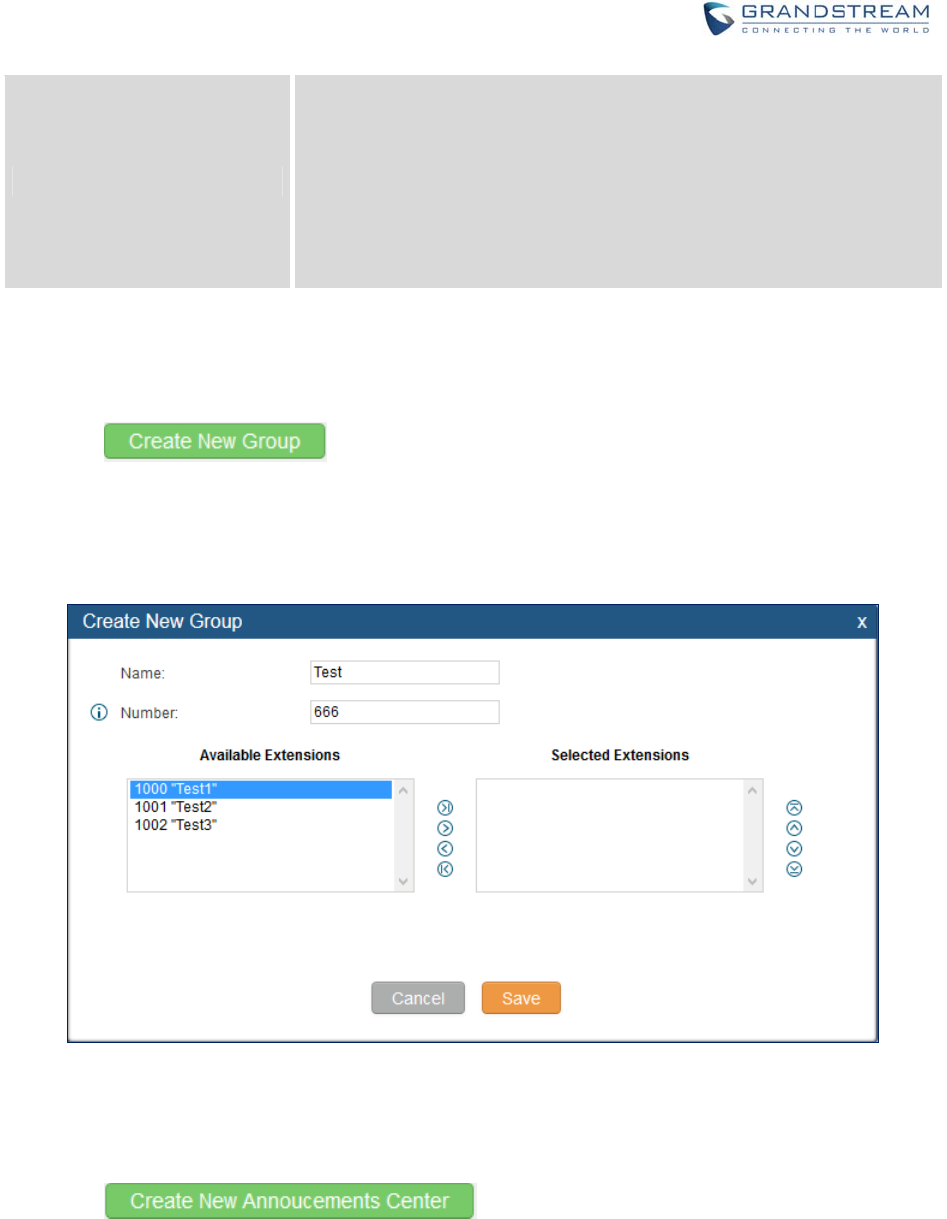
Firmware Version 1.0.0.1 UCM6200 Series IP PBX User Manual Page 280 of 320
Number
Configure the group number. The group number is used in combination
with the code. For example, if group number is 666, and code is 55. The
user can dial 55666 to send prompt 55 to all members in group 666.
Note:
The combination number must not conflict with any number in the system
such as extension number or conference number.
Announcements Center feature can be found under web UI->PBX->Value-added Features->
Announcements Center. The following example demonstrates the usage of this feature.
1. Click to create new group.
2. Give a name to the newly created group.
3. Create a group number which is used with code to send voice message.
4. Select the extensions to be included in the group, who will receive the voice message.
Figure 159: Announcements Center Group Configuration
In this example, group “Test” has number 666. Extension 1000, 1001 and 1002 are in this group.
5. Click to create a new Announcement Center.
6. Give a name to the newly created Announcement Center.
7. Specify the code which will be used with group number to send the voice message to.
8. Select the message that will be used by the code from the Custom Prompt drop down menu. To create
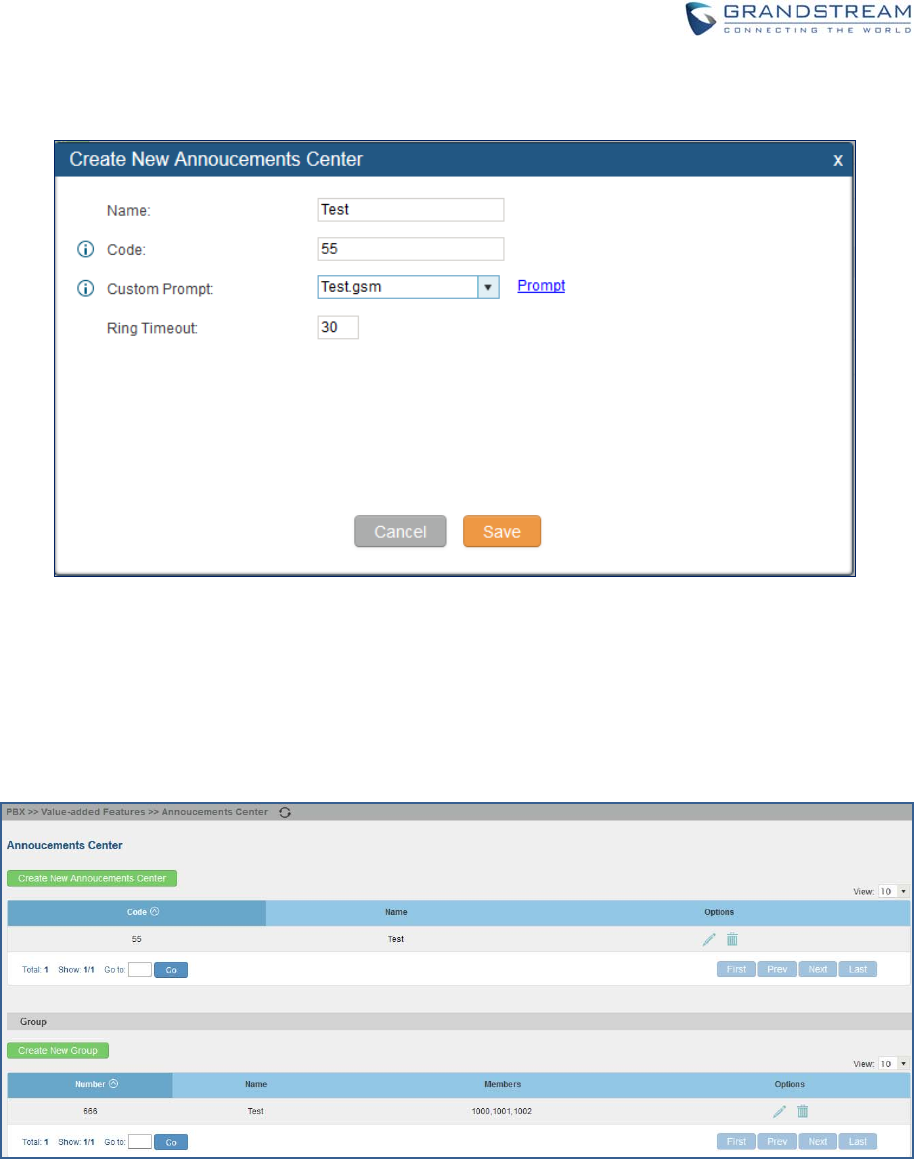
Firmware Version 1.0.0.1 UCM6200 Series IP PBX User Manual Page 281 of 320
a new Prompt, please click “Prompt” link and follow the instructions in that page.
Figure 160: Announcements Center Code Configuration
Code and Group number are used together to direct specified message to the target group. All extensions
in the group will receive the message. For example, we can send code 55 to group 666 by dialing 55666
from any extension registered to the UCM6200. All the members in group 666 which are extension 1000,
1001 and 1002 will receive this voice message after they pick up the call.
Figure 161: Announcements Center Example
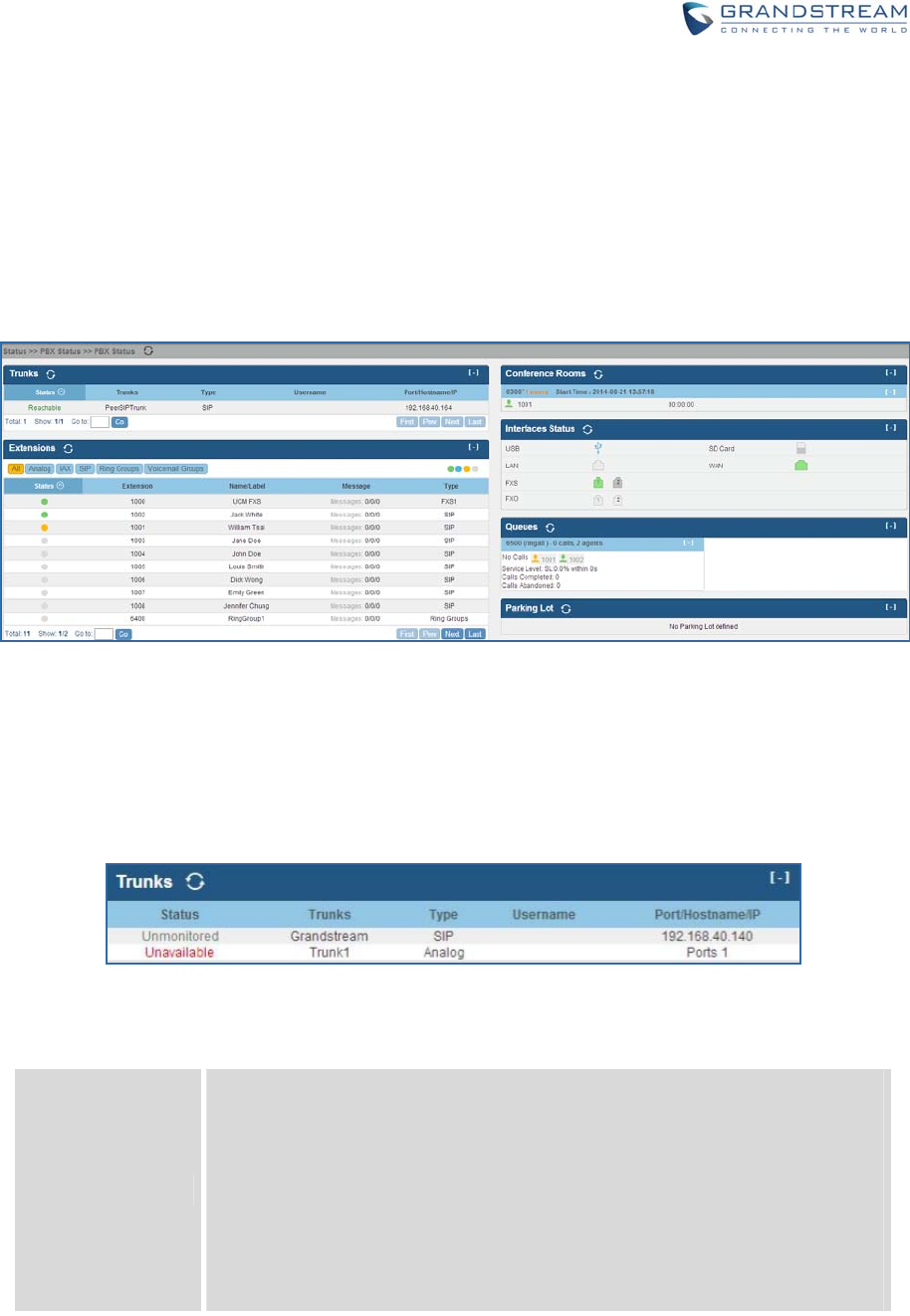
Firmware Version 1.0.0.1 UCM6200 Series IP PBX User Manual Page 282 of 320
STATUSANDREPORTING
PBXSTATUS
The UCM6200 monitors the status for Trunks, Extensions, Queues, Conference Rooms, Interfaces and
Parking lot. It presents administrators the real time status in different sections under web
GUI->Status->PBX Status.
Figure 162: Status->PBX Status
TRUNKS
Users could see all the configured trunk status in this section.
Figure 163: Trunk Status
Table 92: Trunk Status
Status
Display trunk status.
Analog trunk status:
Available
Busy
Unavailable
Unknown Error
SIP Peer trunk status:
Unreachable: The hostname cannot be reached.
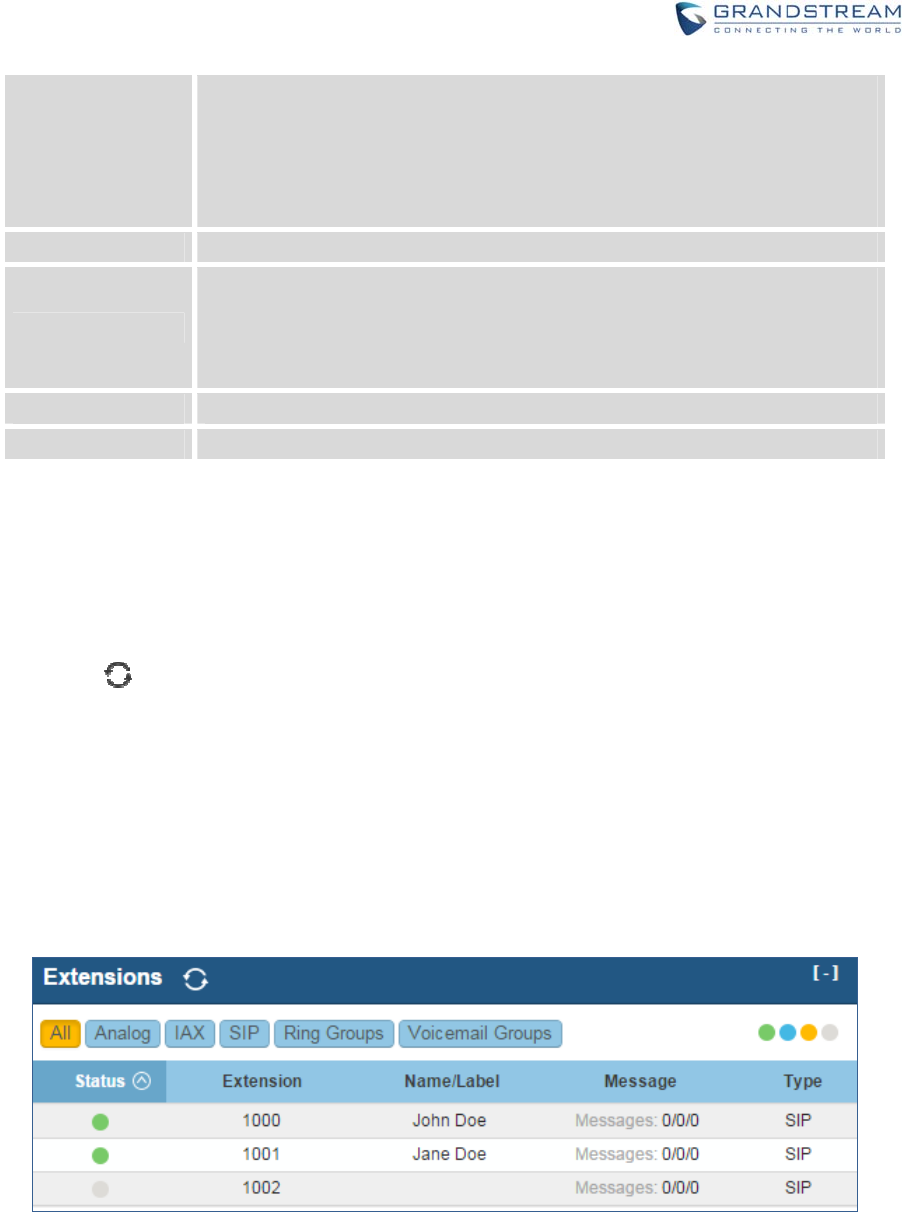
Firmware Version 1.0.0.1 UCM6200 Series IP PBX User Manual Page 283 of 320
Unmonitored: QUALIFY feature is not turned on to be monitored.
Reachable: The hostname can be reached.
SIP Register trunk status:
Registered
Unrecognized Trunk
Trunks Display trunk name
Type
Display trunk Type:
Analog
SIP
IAX
Username Display username for this trunk.
Port/Hostname/IP Display Port for analog trunk, or Hostname/IP for VoIP (SIP/IAX) trunk.
Other operations are also available in trunk status section:
Click on "Trunks", the web page will redirect to trunk configuration page which can also be accessed
via web GUI->PBX->Basic/Call Routes->Analog Trunks.
Click on to refresh the trunk status.
Click on [ + ] to expand the status detail table.
Click on [ - ] to hide the status detail table.
EXTENSIONS
Users could see all the configured extension status in this section.
Figure 164: Extension Status
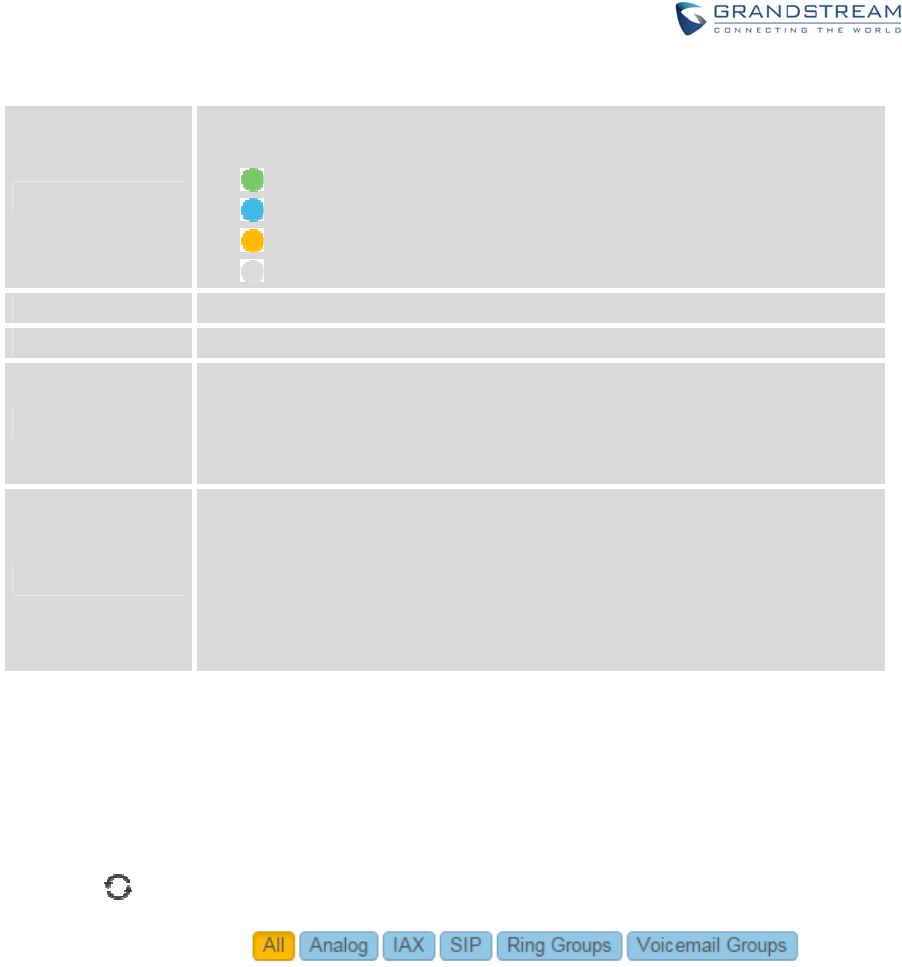
Firmware Version 1.0.0.1 UCM6200 Series IP PBX User Manual Page 284 of 320
Table 93: Extension Status
Status
Display extension number (including feature code). The color indicator has the
following definitions.
Green: Free
Blue: Ringing
Yellow: In Use
Grey: Unavailable
Extension Display the extension number.
Name/Label First name and last name of the extension.
Message
Display message status for the extension.
Example: 2/4/1
Description: There are 2 urgent messages, 4 messages in total and 1
message that has been already read.
Type
Displays extension type.
SIP User
IAX User
Analog User
Ring Groups
Voicemail Groups
Other operations are also available in extension status section:
Click on "Extensions", the web page will redirect to extension configuration page which can also be
accessed via web GUI->PBX->Basic/Call Routes->Extensions.
Click on to refresh the extension status.
Click on one of the tabs to display
the corresponding extensions accordingly.
Click on [ + ] to expand the status detail table.
Click on [ - ] to hide the status detail table.
QUEUES
Users could see all the configured call queue status in this section. The following figure shows the call
queue 6500 being in used.
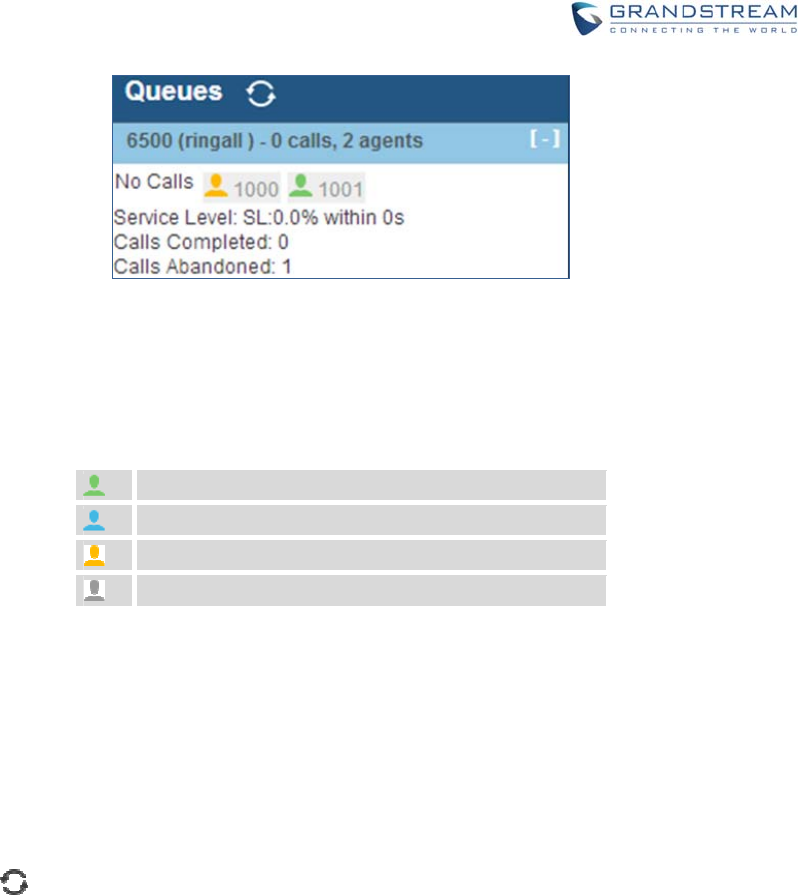
Firmware Version 1.0.0.1 UCM6200 Series IP PBX User Manual Page 285 of 320
Figure 165: Queue Status
The current call status (caller ID, duration), agent status, service level, calls summary
(completed/abandoned) are shown for the call queue. The agent status is defined as below.
Table 94: Agent Status
The agent is available/idle.
The agent is ringing.
The agent is talking/busy.
The agent has been logged out.
On the UCM6200, Service Level is defined as the percentage of high-quality calls over all calls in the call
queue, where high-quality call means calls answered within 10 seconds.
Other operations are also available in queue status section:
Click on "Queues", the web page will redirect to call queue configuration page which can also be
accessed via web GUI->PBX->Call Features->Call Queue.
Click on to refresh the call queue status.
Click on [ + ] to expand the call queue detail.
Click on [ - ] to hide the call queue detail.
CONFERENCEROOMS
Users could see all the conference room status in this section. It shows all the configured conference
rooms, current users, call duration for each user and conference call.
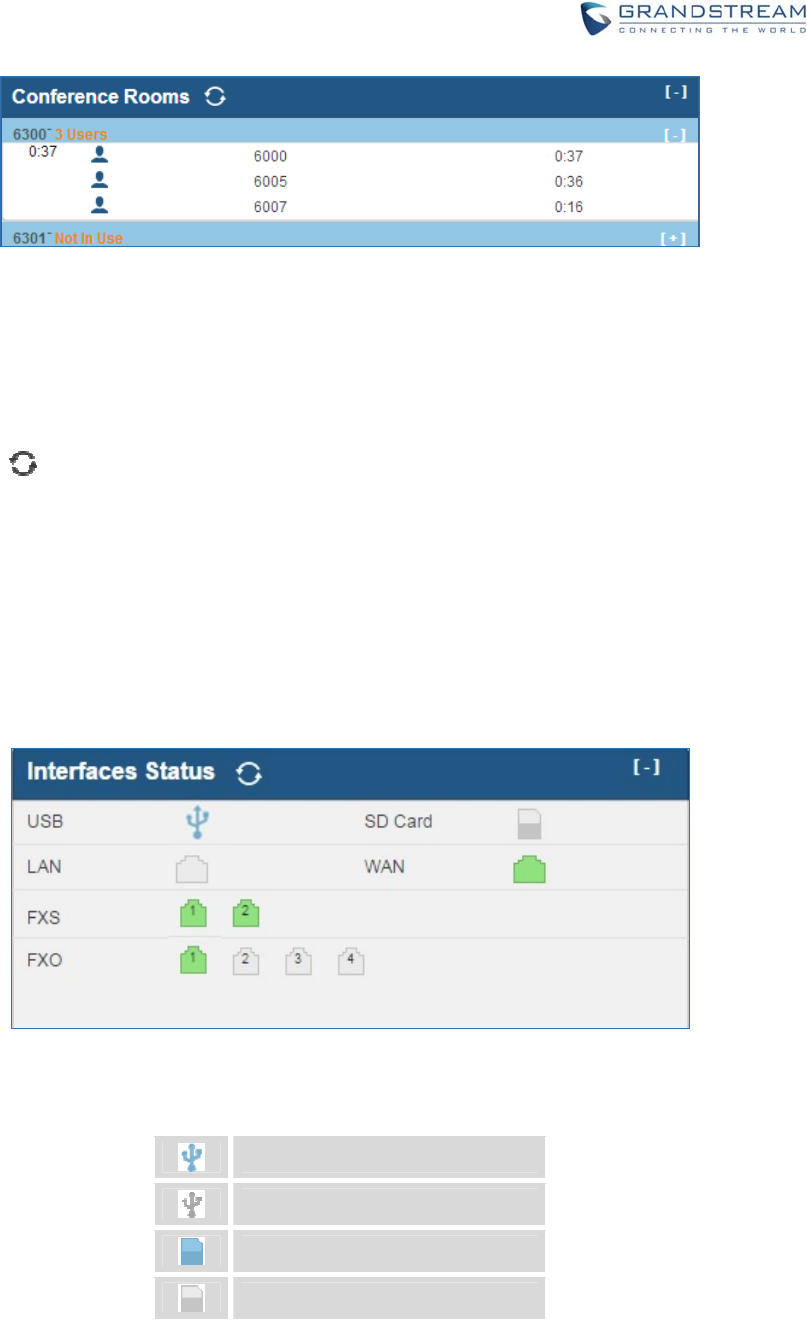
Firmware Version 1.0.0.1 UCM6200 Series IP PBX User Manual Page 286 of 320
Figure 166: Conference Room Status
Other operations are also available in conference room status section:
Click on "Conference Rooms", the web page will redirect to conference room configuration page which
can also be accessed via web GUI->PBX->Call Features->Conference.
Click on to refresh the conference room status.
Click on [ + ] to expand the conference room details.
Click on [ - ] to hide the conference room details.
INTERFACESSTATUS
This section displays interface/port connection status on the UCM6200. The following example shows the
interface status for UCM6204 with USB, WAN port, FXS1, FXS2 and FXO1 connected.
Figure 167: UCM6204 Interfaces Status
Table 95: Interface Status Indicators
USB connected.
USB disconnected.
SD Card connected.
SD Card disconnected.
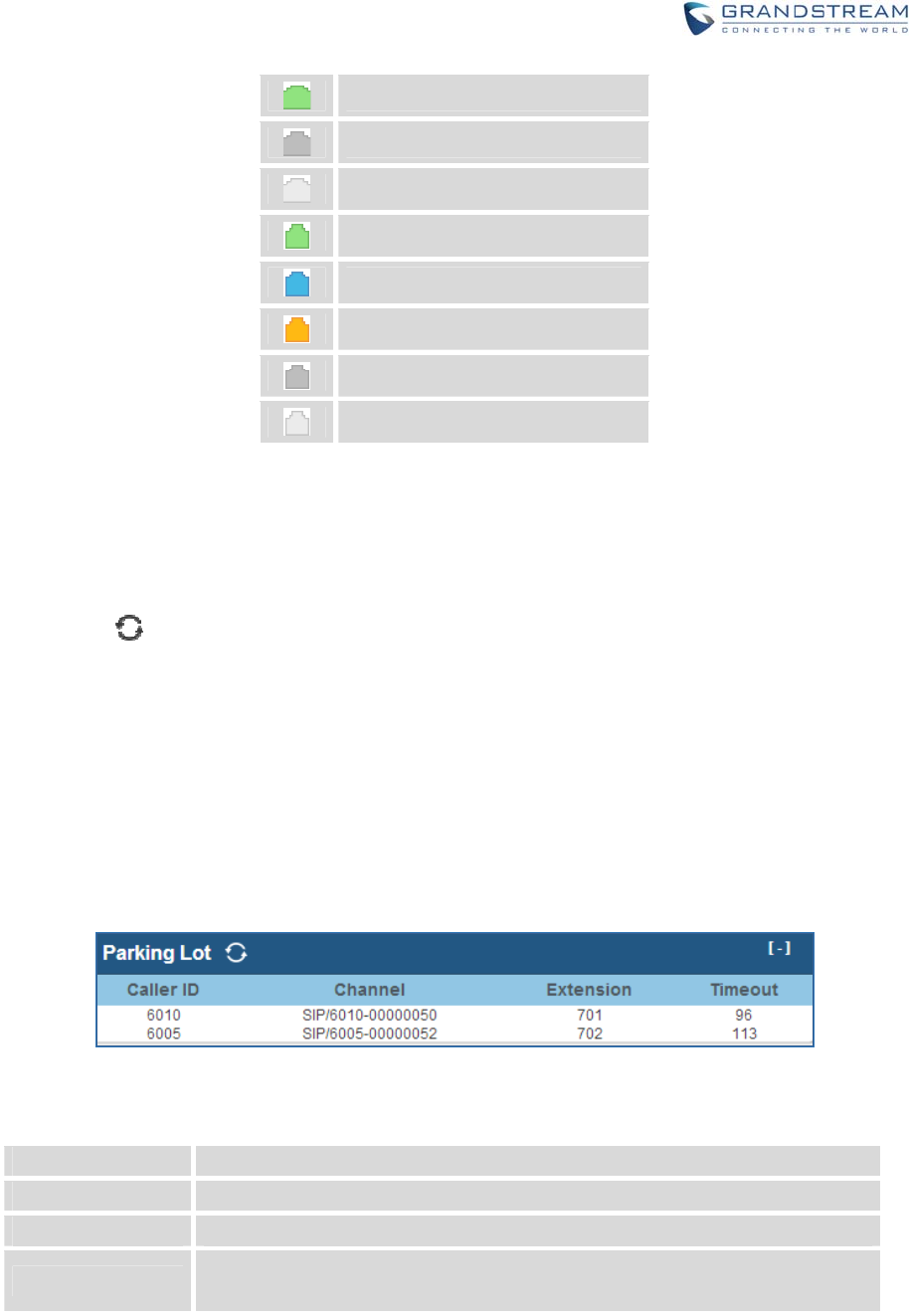
Firmware Version 1.0.0.1 UCM6200 Series IP PBX User Manual Page 287 of 320
LAN/WAN connected.
LAN/WAN not configured.
LAN/WAN disconnected.
FXS/FXO connected.
FXS/FXO waiting.
FXS/FXO busy.
FXS/FXO not configured.
FXS/FXO disconnected.
Other operations are also available in interface status section:
Click on "Interfaces Status", the web page will redirect to ports configuration page which can also be
accessed via web GUI->PBX->Internal Options->Ports Config.
Click on to refresh the interface status.
Click on [ + ] to expand the interface details.
Click on [ - ] to hide the interface details.
PARKINGLOT
The UCM6200 supports call park using feature code. When there is call being parked, this section will
display the parking lot status.
Figure 168: Parking Lot Status
Table 96: Parking Lot Status
Caller ID Display the caller ID who parks the call.
Channel Display channel for the call park.
Extension Display the parking lot number where the call is parked/retrieved.
Timeout Display timeout (in seconds) for the parked call. The status page will
dynamically update this timer from 120 seconds (default) to 0. When the timer
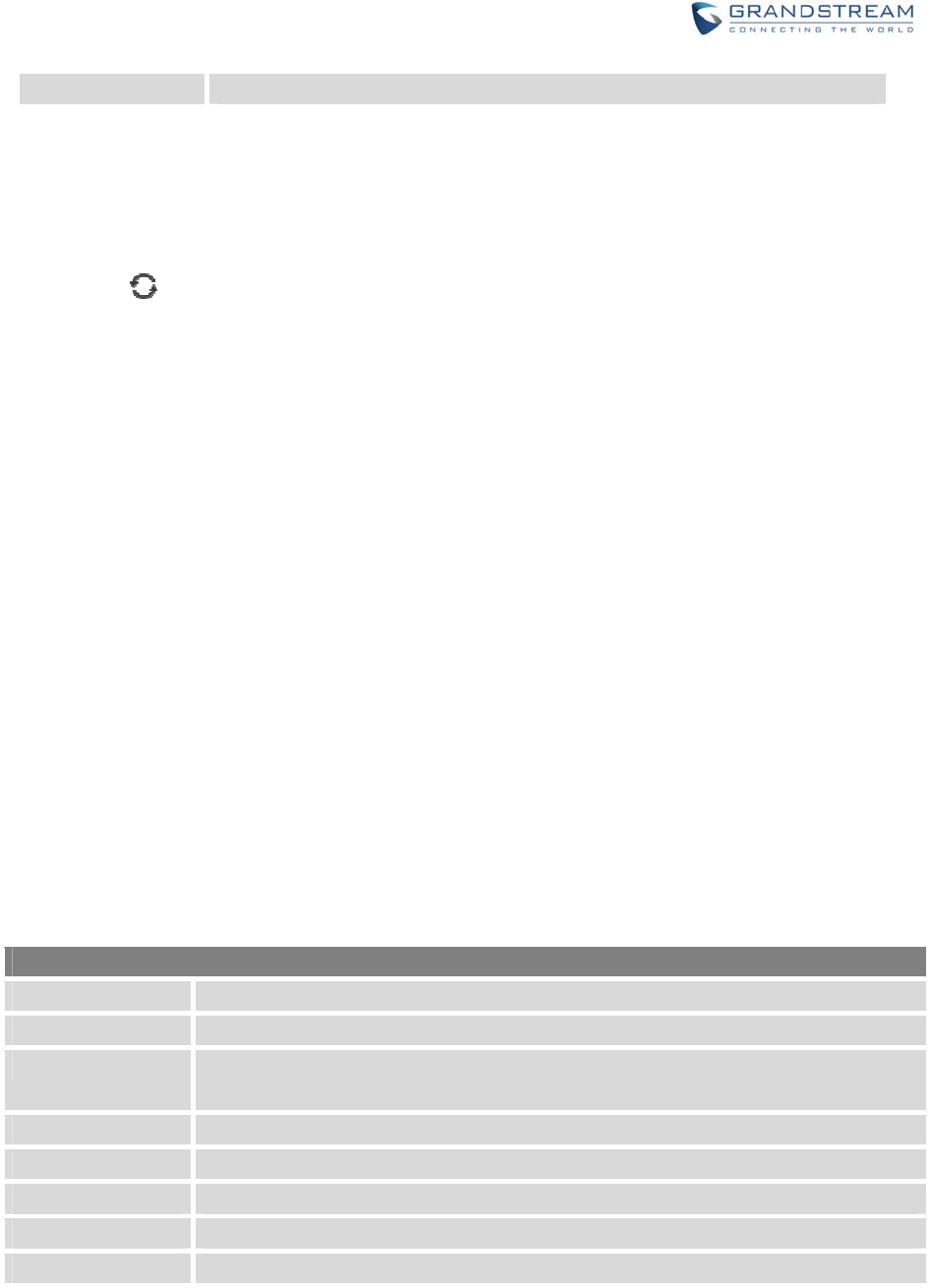
Firmware Version 1.0.0.1 UCM6200 Series IP PBX User Manual Page 288 of 320
reaches 0, the caller who parks the call will be called back.
Other operations are also available in parking lot status section:
Click on "Parking Lot", the web page will redirect to feature codes page which can also be accessed
via web GUI->PBX->Internal Options->Feature Codes.
Click on to refresh the parking lot status.
Click on [ + ] to expand the parking lot details.
Click on [ - ] to hide the parking details.
SYSTEMSTATUS
The UCM6200 system status can be accessed via Web GUI->Status->System Status, which displays the
following system information.
General
Network
Storage Usage
Resource Usage
GENERAL
Under Web GUI->Status->System Status->General, users could check the hardware and software
information for the UCM6200. Please see details in the following table.
Table 97: System Status->General
Status ->System Status -> General
Model Product model.
Part Number Product part number.
System Time Current system time. The current system time is also available on the upper right of
each web page.
Up Time System up time since the last reboot.
Boot Boot version.
Core Core version.
Base Base version.
Program Program version. This is the main software release version.
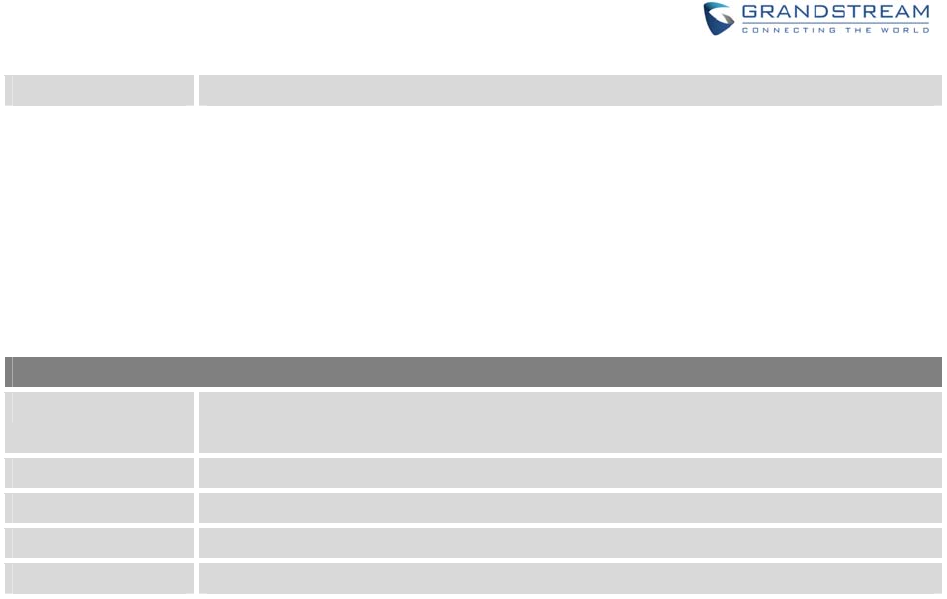
Firmware Version 1.0.0.1 UCM6200 Series IP PBX User Manual Page 289 of 320
Recovery Recovery version.
NETWORK
Under Web GUI->Status->System Status->Network, users could check the network information for the
UCM6200. Please see details in the following table.
Table 98: System Status->Network
Status -> System Status -> Network
MAC Address Global unique ID of device, in HEX format. The MAC address can be found on the
label coming with original box and on the label located on the bottom of the device.
IP Address IP address.
Gateway Default gateway address.
Subnet Mask Subnet mask address.
DNS Server DNS Server address.
STORAGEUSAGE
Users could access the storage usage information from web UI->Status->System Status->Storage
Usage. It shows the available and used space for the following partitions.
Configuration partition
This partition contains PBX system configuration files and service configuration files.
Data partition
Voicemail, recording files, IVR file, Music on Hold files and etc.
USB disk
USB disk will display if connected.
SD Card
SD Card will display if connected.
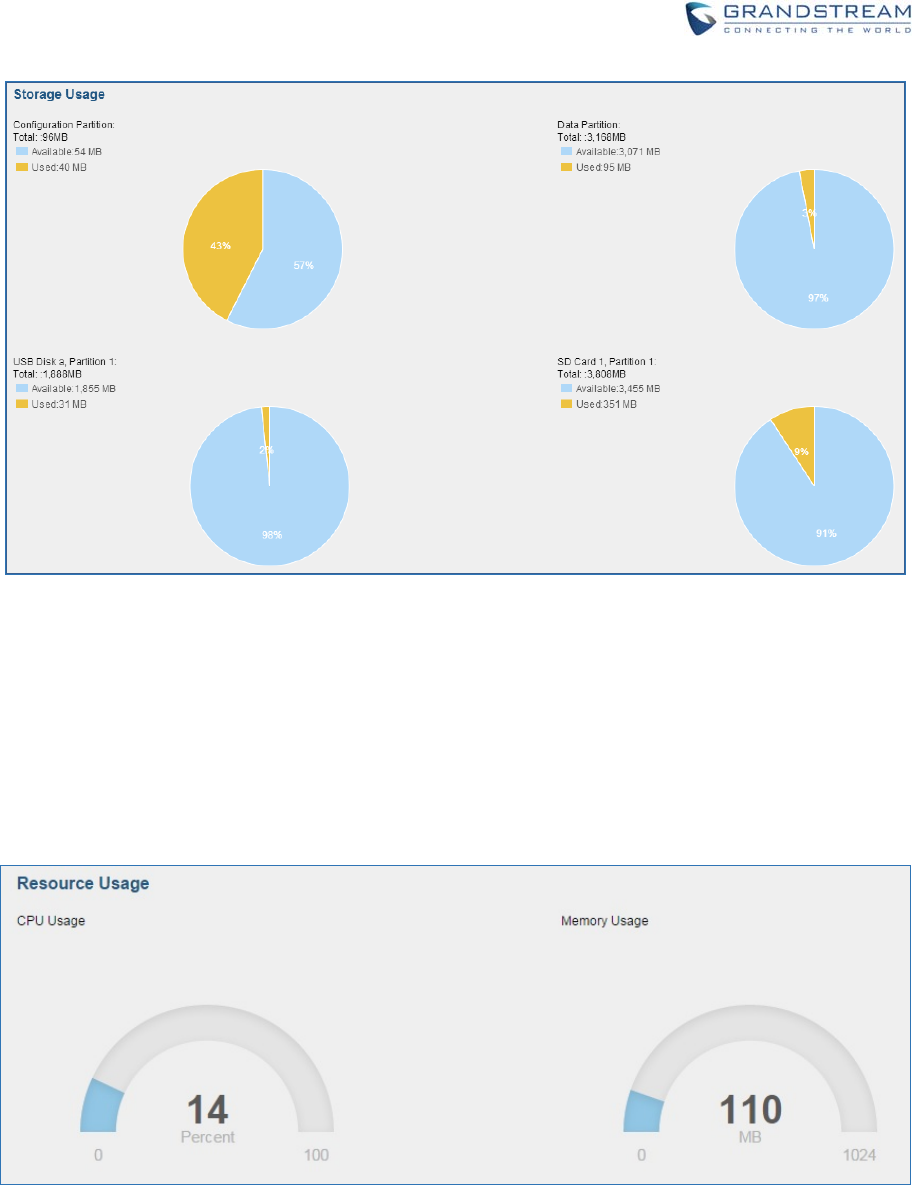
Firmware Version 1.0.0.1 UCM6200 Series IP PBX User Manual Page 290 of 320
Figure 169: System Status->Storage Usage
RESOURCEUSAGE
When configuring and managing the UCM6200, users could access resource usage information to
estimate the current usage and allocate the resources accordingly. Under web UI->Status->System
Status->Resource Usage, the current CPU usage and Memory usage are shown in the pie chart.
Figure 170: System Status->Resource Usage
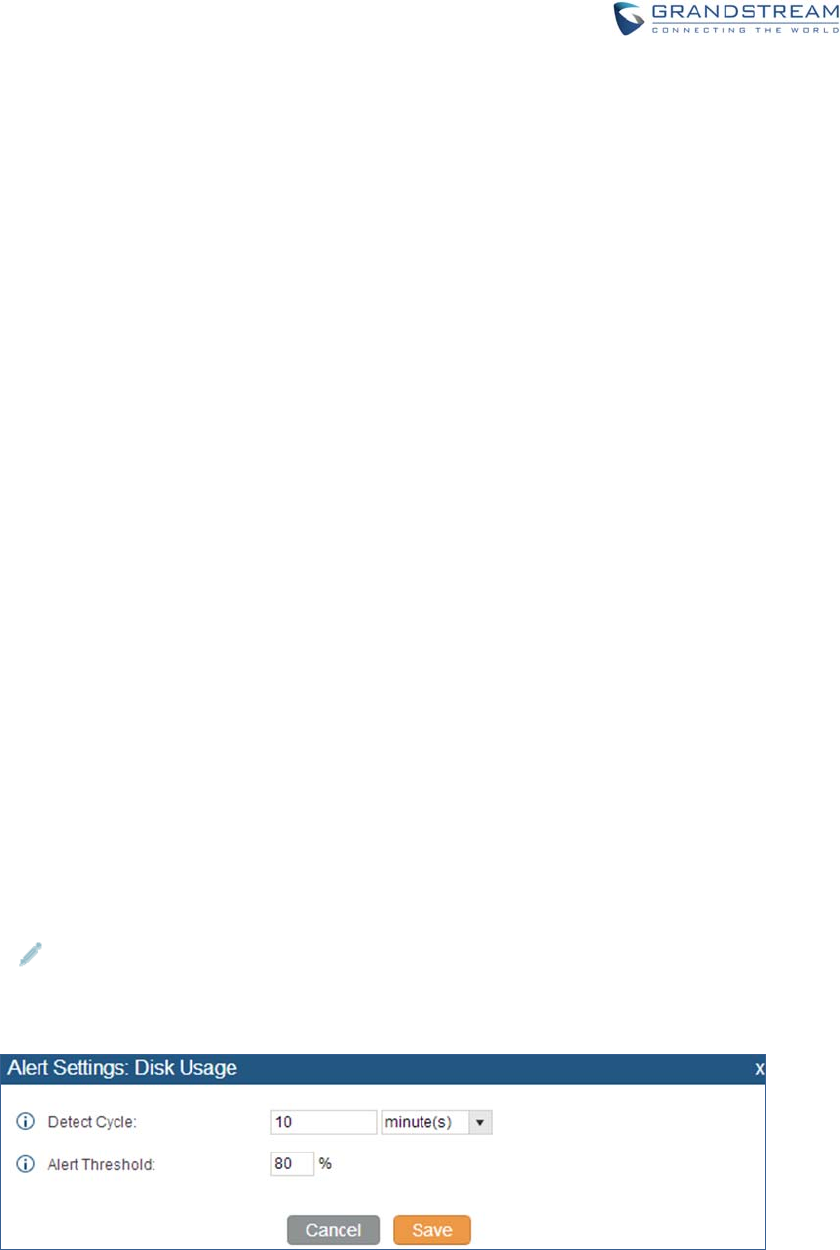
Firmware Version 1.0.0.1 UCM6200 Series IP PBX User Manual Page 291 of 320
SYSTEMEVENTS
The UCM6200 can monitor important system events, log the alerts and send Email notifications to the
system administrator.
ALERTEVENTSLIST
The system alert events list can be found under Web GUI->Status->System Events->Alert Events List.
The following event are currently supported on the UCM6200 which will have alert and/or Email generated
if occurred:
Disk Usage
Modify Admin Password
Memory Usage
System Reboot
System Update
System Crash
Register SIP Failed
Register SIP Trunk Failed
Restore Config
User Login Success
User Login Failed
SIP Internal Call Failure
SIP Outgoing Call through Trunk Failure
Fail2ban Blocking
SIP Lost Registration
SIP Peer Trunk Status
Click on to configure the parameters for each event. See examples below.
1. Disk Usage.
Figure 171: System Events->Alert Events Lists: Disk Usage
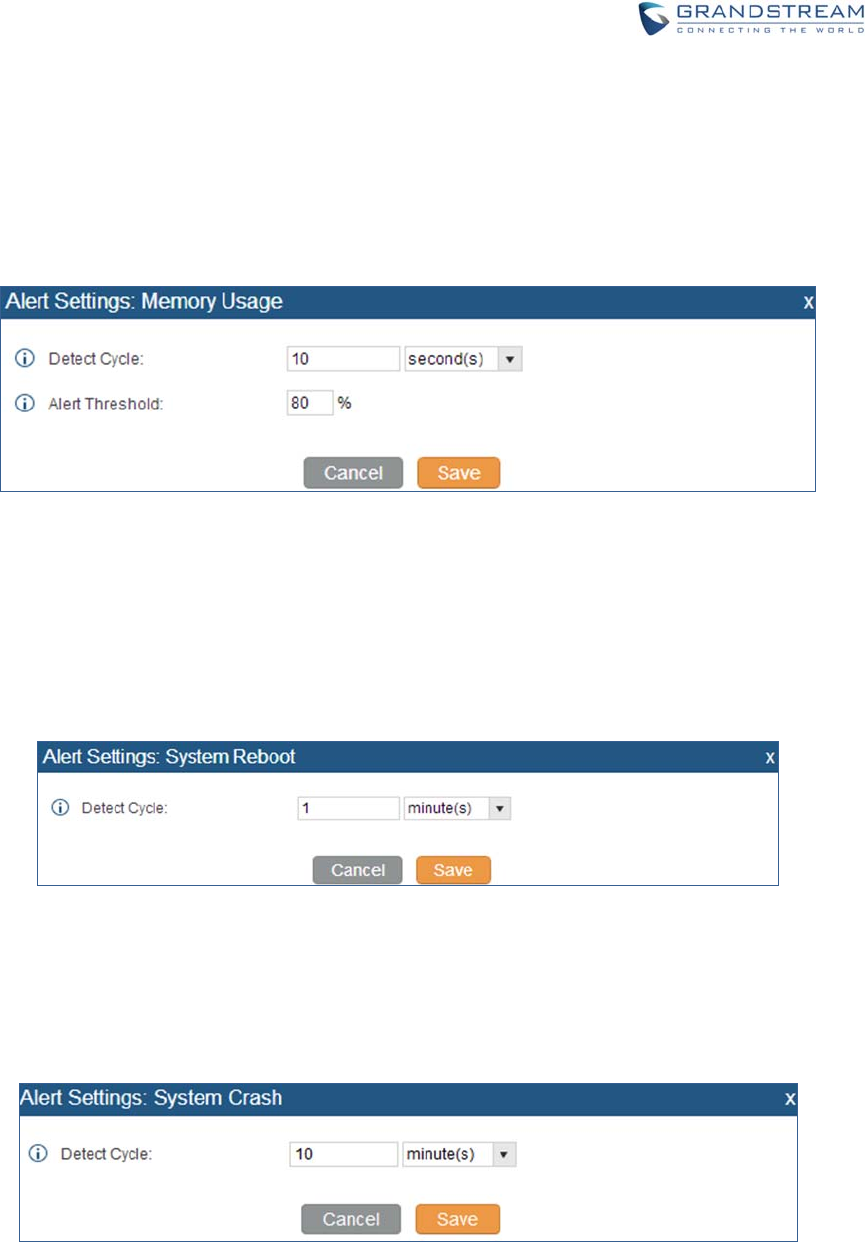
Firmware Version 1.0.0.1 UCM6200 Series IP PBX User Manual Page 292 of 320
Detect Cycle: The UCM6200 will perform the internal disk usage detection based on this cycle.
Users can enter the number and then select second(s)/minute(s)/hour(s)/day(s) to configure the
cycle.
Alert Threshold: If the detected value exceeds the threshold (in percentage), the UCM6200
system will send the alert.
2. Memory Usage
Figure 172: System Events->Alert Events Lists: Memory Usage
Detect Cycle: The UCM6200 will perform the memory usage detection based on this cycle. Users
can enter the number and then select second(s)/minute(s)/hour(s)/day(s) to configure the cycle.
Alert Threshold: If the detected value exceeds the threshold (in percentage), the UCM6200
system will send the alert.
3. System Reboot
Figure 173: System Events->Alert Events Lists: System Reboot
Detect Cycle: The UCM6200 will check the system reboot based on this cycle. Users can enter
the number and then select second(s)/minute(s)/hour(s)/day(s) to configure the cycle.
4. System Crash
Figure 174: System Events->Alert Events Lists: System Crash
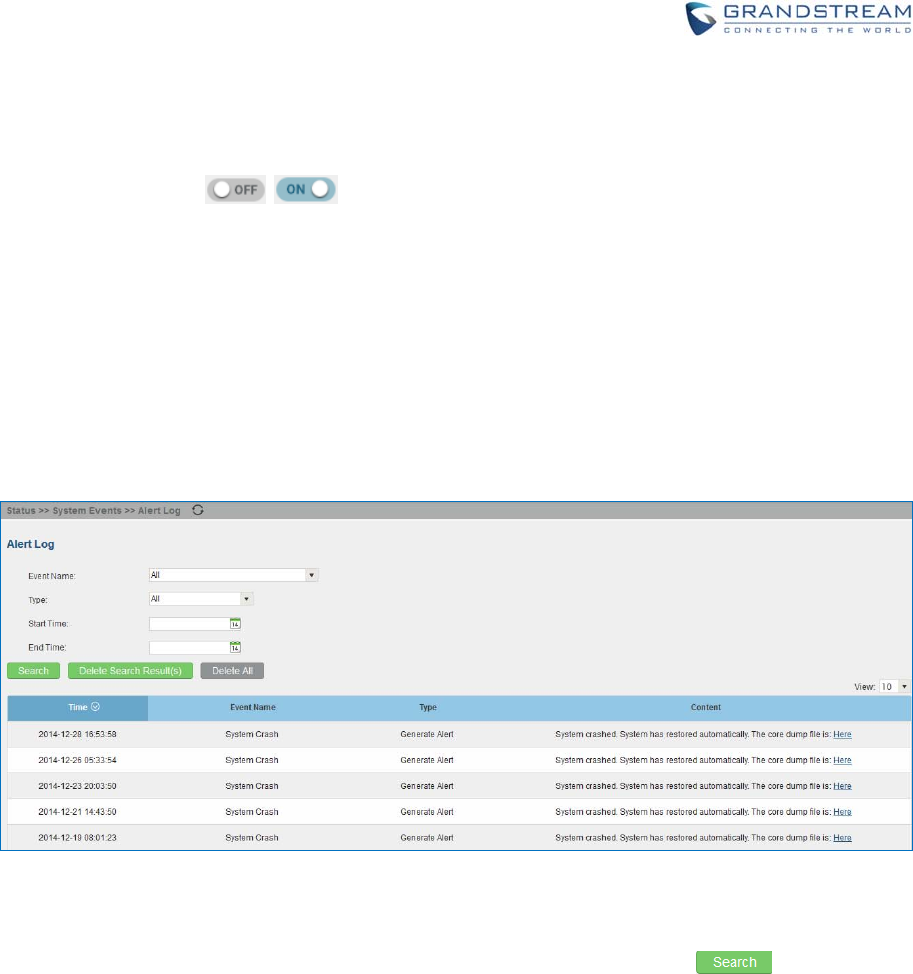
Firmware Version 1.0.0.1 UCM6200 Series IP PBX User Manual Page 293 of 320
Detect Cycle: The UCM will detect the event at each cycle based on the specified time. Users can
enter the number and then select second(s)/minute(s)/hour(s)/day(s) to configure the cycle.
Click on the switch to turn on/off the alert and Email notification for the event. Users
could also select the checkbox for each event and then click on button "Alert On", "Alert Off", "Email
Notification On", "Email Notification Off" to control the alert and Email notification configuration.
ALERTLOG
Under Web GUI->Status->System Events->Alert Log, system messages from triggered system events
are listed as alert logs. The following screenshot shows system crash alert logs.
Figure 175: System Events->Alert Log
User could also filter alert logs by selecting a certain event category, type of alert log, and/or specifying a
certain time period. The matching results will be displayed after clicking on . Alert logs are
classified into two types by the system:
1. Generate Alert: Generated when alert events happen, for example, alert logs for disk usage
exceeding the alert threshold.
2. Restore to Normal: Generated when alert events being cleared, for example, logs for disk usage
dropping back below the alert threshold.
User could filter out alert logs of “Generate Alert” or “Restore to Normal” by specifying the type according
to need. The following figure shows an example of filtering out alert logs of type of “Restore to Normal”.
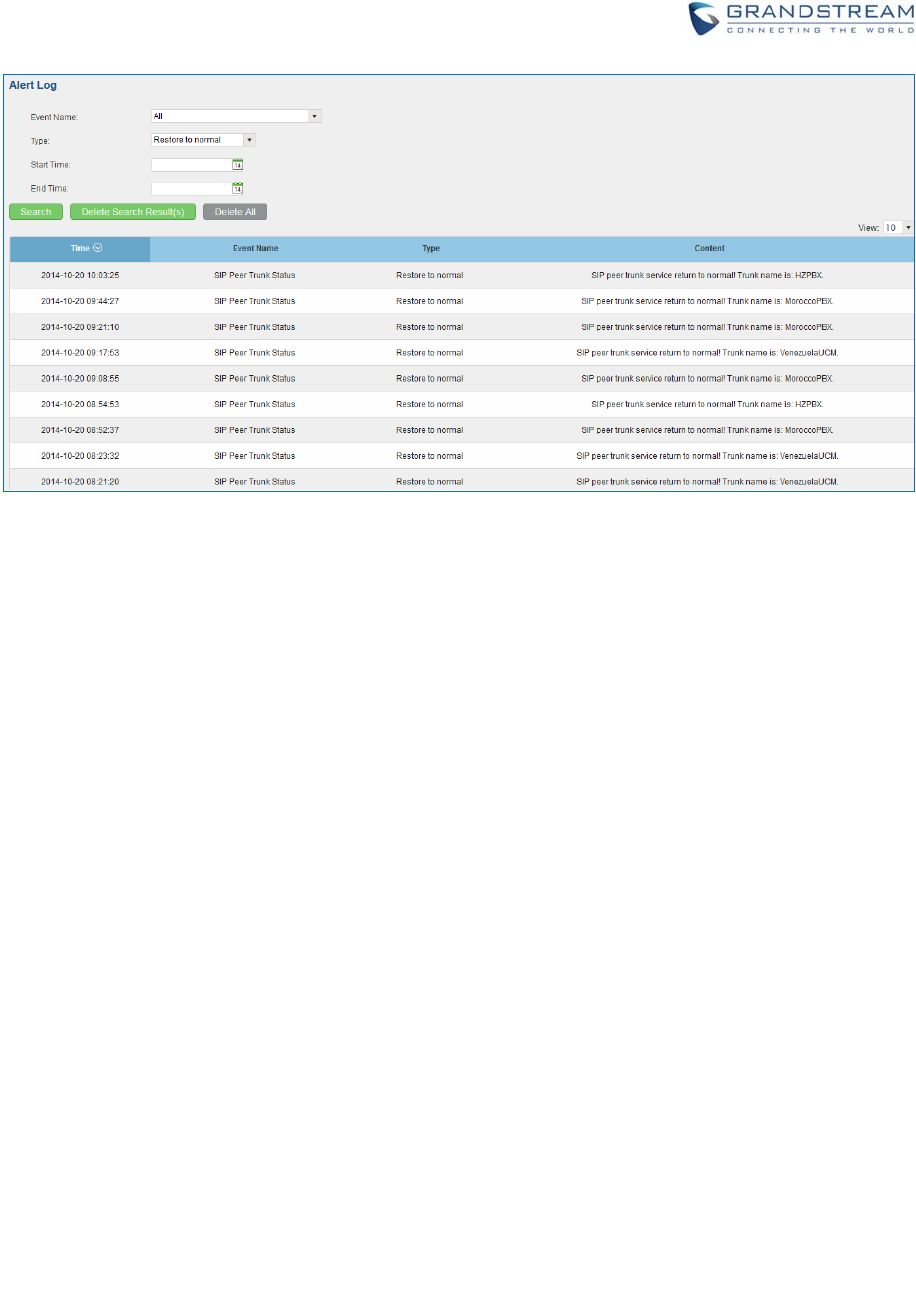
Firmware Version 1.0.0.1 UCM6200 Series IP PBX User Manual Page 294 of 320
Figure 176: Filter for Alert Log
ALERTCONTACT
Users could add administrator's Email address under Web GUI->Status->System Events->Alert Contact
to send the alert notification to. Up to 10 Email addresses can be added.
CDR
A Call Detail Record (CDR) is a data record produced by telephone exchange activities or other
telecommunications equipment documenting the details of a phone call that passed through the PBX. The
CDR is composed of the following data fields on the UCM6200.
Start Time. Format: 2016-02-27 16:47:03.
Call From. Format: "John Doe"<6012>.
Call To. Format: 6005.
Answered By. Format: 6005.
Call Time. Format: 0:00:10.
Talk Time. Format: 0:00:10
Status. Format: NO ANSWER, BUSY, ANSWERED, or FAILED.
Options. Voice record playing/downloading/deleting.
Users could filter the call report by specifying the date range and criteria, depending on how the users
would like to include the logs to the report. Then click on "View Report" button to display the generated
report.
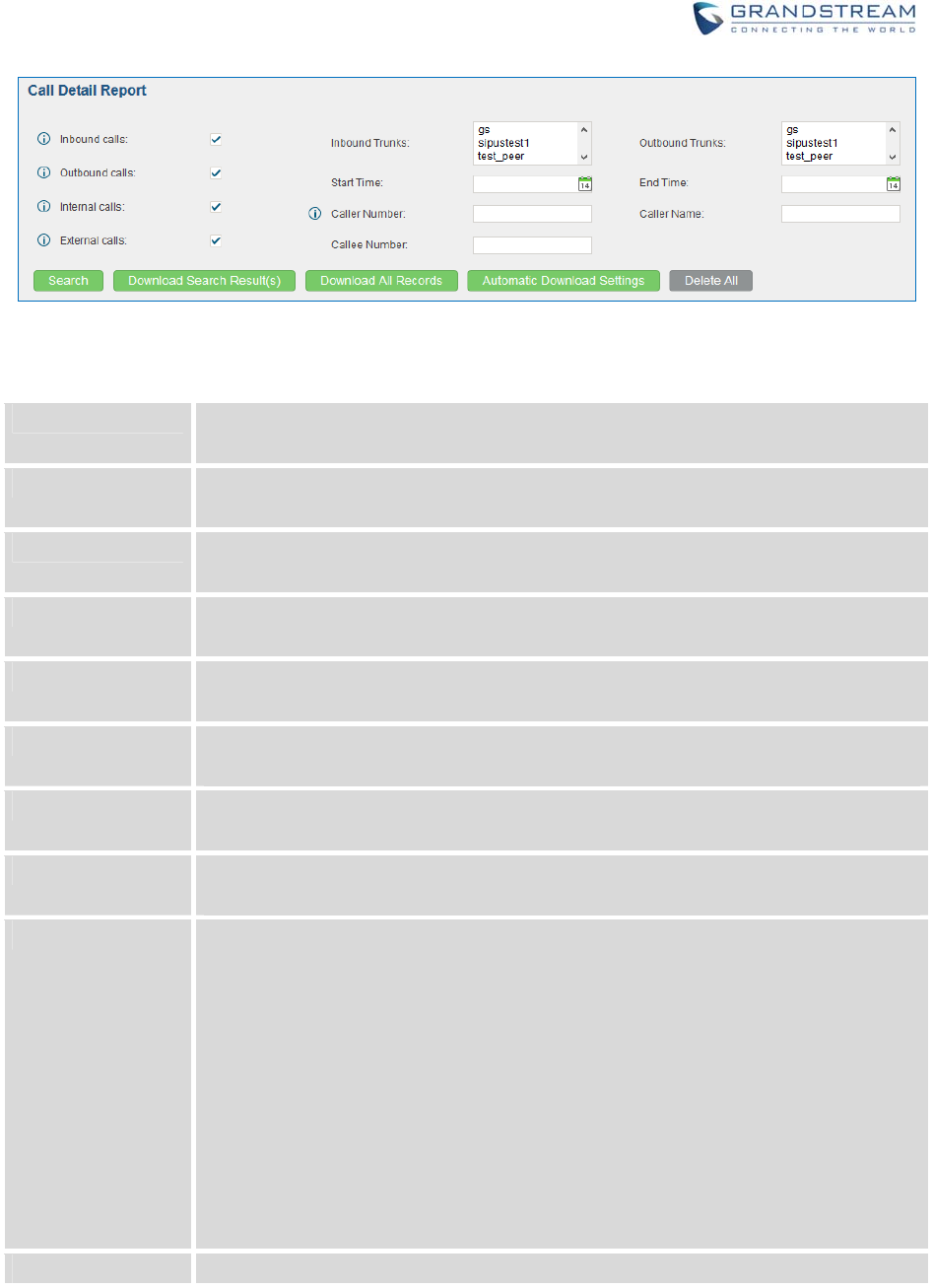
Firmware Version 1.0.0.1 UCM6200 Series IP PBX User Manual Page 295 of 320
Figure 177: CDR Filter
Table 99: CDR Filter Criteria
Inbound calls Inbound calls are calls originated from a non-internal source (like a VoIP trunk) and
sent to an internal extension.
Outbound calls Outbound calls are calls sent to a non-internal source (like a VoIP trunk) from an
internal extension.
Internal calls Internal calls are calls from one internal extension to another extension, which are
not sent over a trunk.
External calls External calls are calls sent from one trunk to another trunk, which are not sent to any
internal extension.
Inbound Trunks Select certain inbound trunk(s) and the CDR of calls going inbound through the
trunk(s) will be filtered out.
Outbound Trunks Select certain outbound trunk(s) and the CDR of calls going outbound through the
trunk(s) will be filtered out.
Start Time Specify the start time to filter the CDR report. Click on the calendar icon on the right
and the calendar will show for users to select the exact date and time.
End Time Specify the end time to filter the CDR report. Click on the calendar icon on the right
and the calendar will show for users to select the exact date and time.
Caller Number Enter the caller number to filter the CDR report. CDR with the matching caller
number will be filtered out.
User could specify a particular caller number or enter a pattern. ‘.’ matches zero or
more characters, only appears in the end. ‘X’ matches any digit from 0 to 9,
case-insensitive, repeatable, only appears in the end.
For example:
3XXX: It will filter out CDR that having caller number with leading digit 3 and of 4
digits length.
3.: It will filter out CDR that having caller number with leading digit 3 and of any
length.
Caller Name Enter the caller name to filter the CDR report. CDR with the matching caller name will
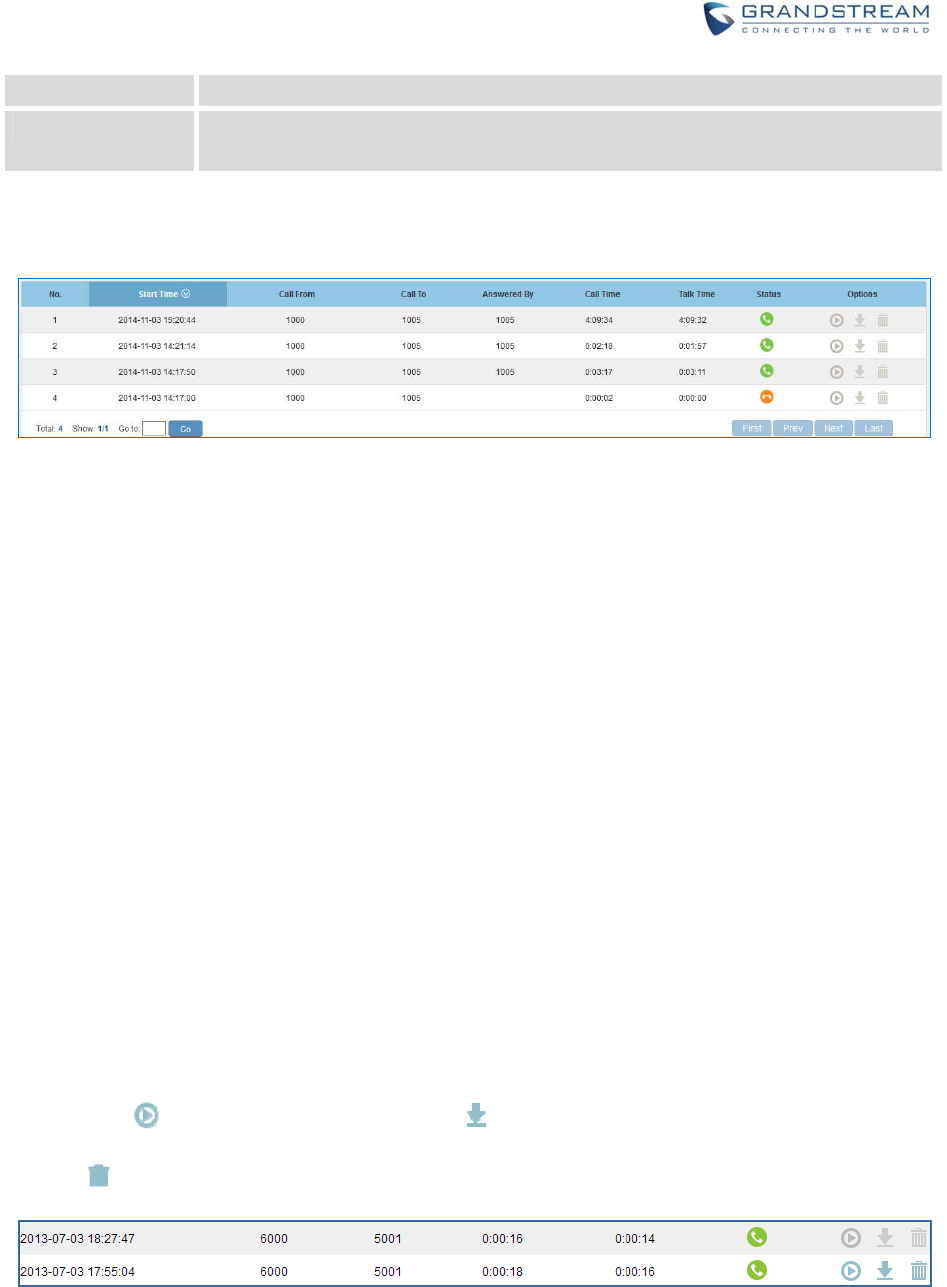
Firmware Version 1.0.0.1 UCM6200 Series IP PBX User Manual Page 296 of 320
be filtered out.
Callee Number Enter the callee number to filter the CDR report. CDR with the matching callee
number will be filtered out.
The call report will display as the following figure shows.
Figure 178: Call Report
Users could perform the following operations on the call report.
Sort
Click on the header of the column to sort by this category. For example, clicking on "Start Time" will
sort the report according to start time. Clicking on "Start Time" again will reverse the order.
Download Searched Results
Click on “Download Search Result(s)” to export the records filtered out to a .csv file.
Download All Records
Click on “Download All Records” to export all the records to a .csv file.
Delete All
On the bottom of the page, click on "Delete All" button to remove all the call report information.
Play/Download/Delete Recording File (per entry)
If the entry has audio recording file for the call, the three icons on the most right column will be
activated for users to select. In the following picture, the second entry has audio recording file for the
call.
Click on to play the recording file; click on to download the recording file in .wav format; click
on to delete the recording file (the call record entry will not be deleted).
Figure 179: Call Report Entry with Audio Recording File
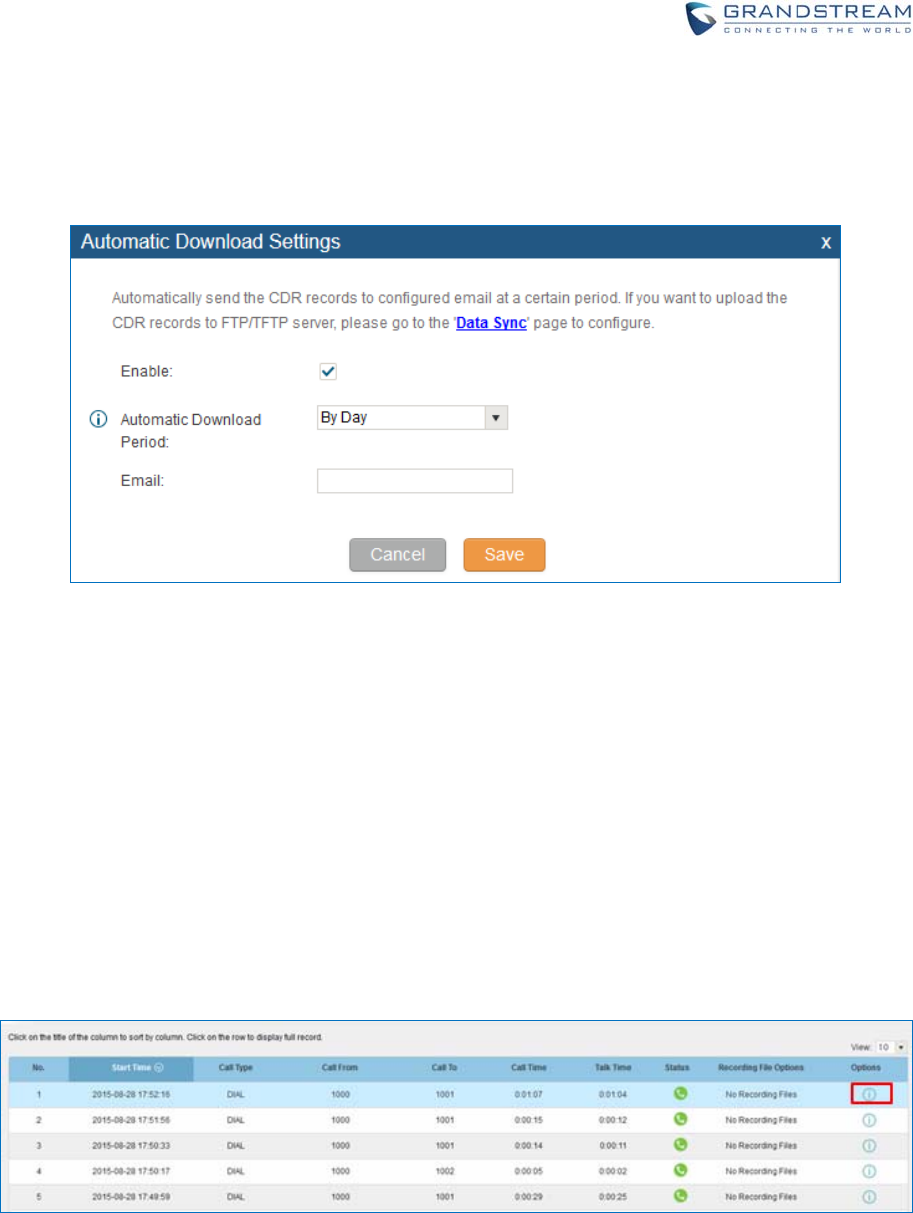
Firmware Version 1.0.0.1 UCM6200 Series IP PBX User Manual Page 297 of 320
Automatic Download CDR Records
User could configure the UCM6200 to automatically download the CDR records and send the records
to an Email address. Click on “Automatic Download Settings”, and configure the parameters in the
dialog below.
Figure 180: Automatic Download Settings
To receive CDR record automatically from Email, check “Enable” and select a time period “By Day” “By
Week” or “By Month” for the automatic download period. Make sure you have entered an Email
address to receive the CDR records.
CDRIMPROVEMENT
Starting from UCM6200 firmware 1.0.10.x, transferred call will no longer be displayed as a separate call
entry in CDR. It will display within call record in the same entry. CDR new features can be found under web
UI-> Status->CDR->CDR. The user can click on the option icon for a specific call log entry to view details
about this entry, such as premier caller and transferred call information.
Figure 181: CDR Report
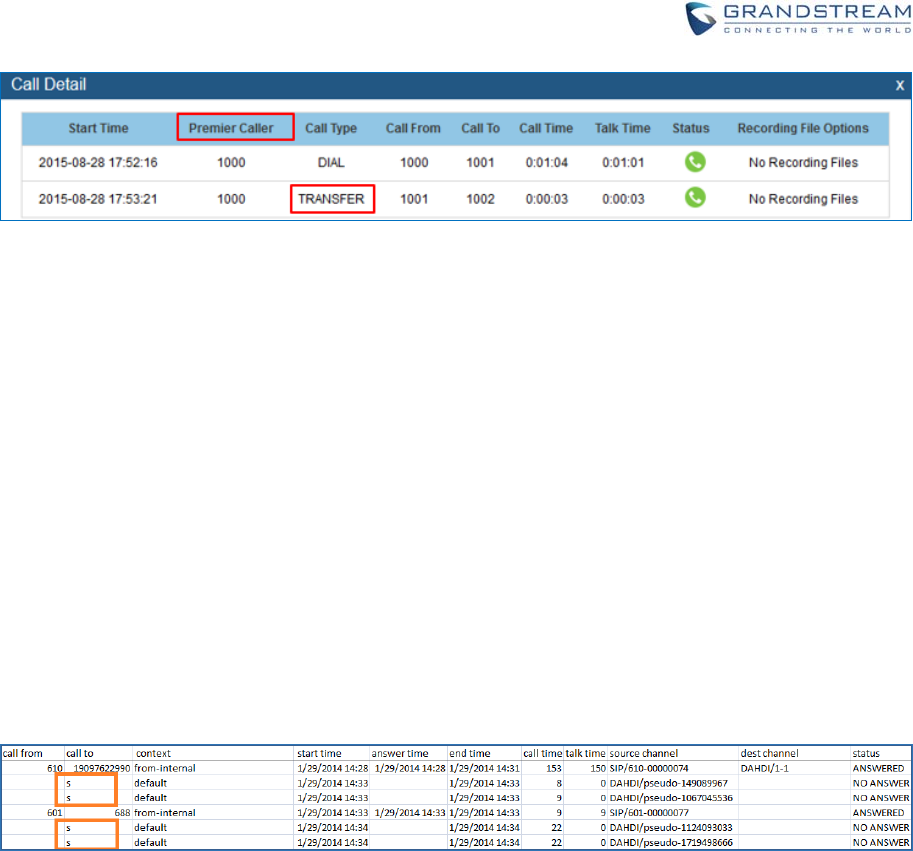
Firmware Version 1.0.0.1 UCM6200 Series IP PBX User Manual Page 298 of 320
Figure 182: Detailed CDR Information
DOWNLOADEDCDRFILE
The downloaded CDR (.csv file) has different format from the web UI CDR. Here are some descriptions.
Call From, Call To
"Call From": the caller ID.
"Call To": the callee ID.
If "Call From" shows empty, "Call To" shows "s" (see highlight part in the picture below) and the "Source
Channel" contains "DAHDI", this means the call is from FXO/PSTN line. For FXO/PSTN line, we only know
there is an incoming request when there is incoming call but we don't know the number being called. So
we are using "s" to match it where "s" means "start".
Figure 183: Downloaded CDR File Sample - Call To Shows "s"
Context
There are different context values that might show up in the downloaded CDR file. The actual value can
vary case by case. Here are some sample values and their descriptions.
from-internal: internal extension makes outbound calls.
ext-did-XXXXX: inbound calls. It starts with "ext-did", and "XXXXX" content varies case by case, which
also relate to the order when the trunk is created.
ext-local: internal calls between local extensions.
Source Channel, Dest Channel
Sample 1:
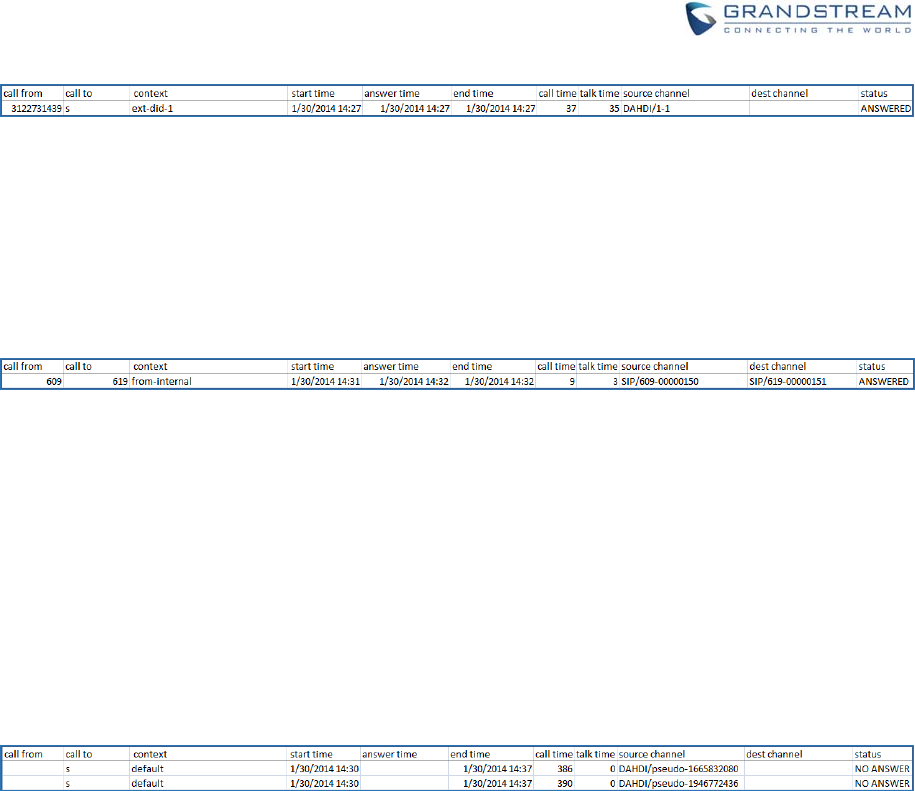
Firmware Version 1.0.0.1 UCM6200 Series IP PBX User Manual Page 299 of 320
Figure 184: Downloaded CDR File Sample - Source Channel and Dest Channel 1
DAHDI means it is an analog call, FXO or FXS.
For UCM6202, DAHDI/(1-2) are FXO ports, and DAHDI(3-4) are FXS ports.
For UCM6204, DAHDI/(1-4) are FXO ports, and DAHDI(5-6) are FXS ports.
For UCM6208, DAHDI/(1-8) are FXO ports, and DAHDI(9-10) are FXS ports.
Sample 2:
Figure 185: Downloaded CDR File Sample - Source Channel and Dest Channel 2
"SIP" means it's a SIP call. There are three possible format:
(a) SIP/NUM-XXXXXX, where NUM is the local SIP extension number. The last XXXXX is a random string
and can be ignored.
(c) SIP/trunk_X/NUM, where trunk_X is the internal trunk name, and NUM is the number to dial out
through the trunk.
(c) SIP/trunk_X-XXXXXX, where trunk_X is the internal trunk name and it is an inbound call from this trunk.
The last XXXXX is a random string and can be ignored.
Sample 3:
Figure 186: Downloaded CDR File Sample - Source Channel and Dest Channel 3
This is a very special channel name. If it shows up, most likely it means a conference call.
There are some other possible values, but these values are almost the application name which are used
by the dialplan.
IAX2/NUM-XXXXXXX: it means this is an IAX call.
Local/@from-internal-XXXXX: it is used internally to do some special feature procedure. We can simply
ignore it.
Hangup: the call is hung up from the dialplan. This indicates there are some errors or it has run into
abnormal cases.
Playback: play some prompts to you, such as 183 response or run into an IVR.
ReadExten: collect numbers from user. It may occur when you input PIN codes or run into DISA
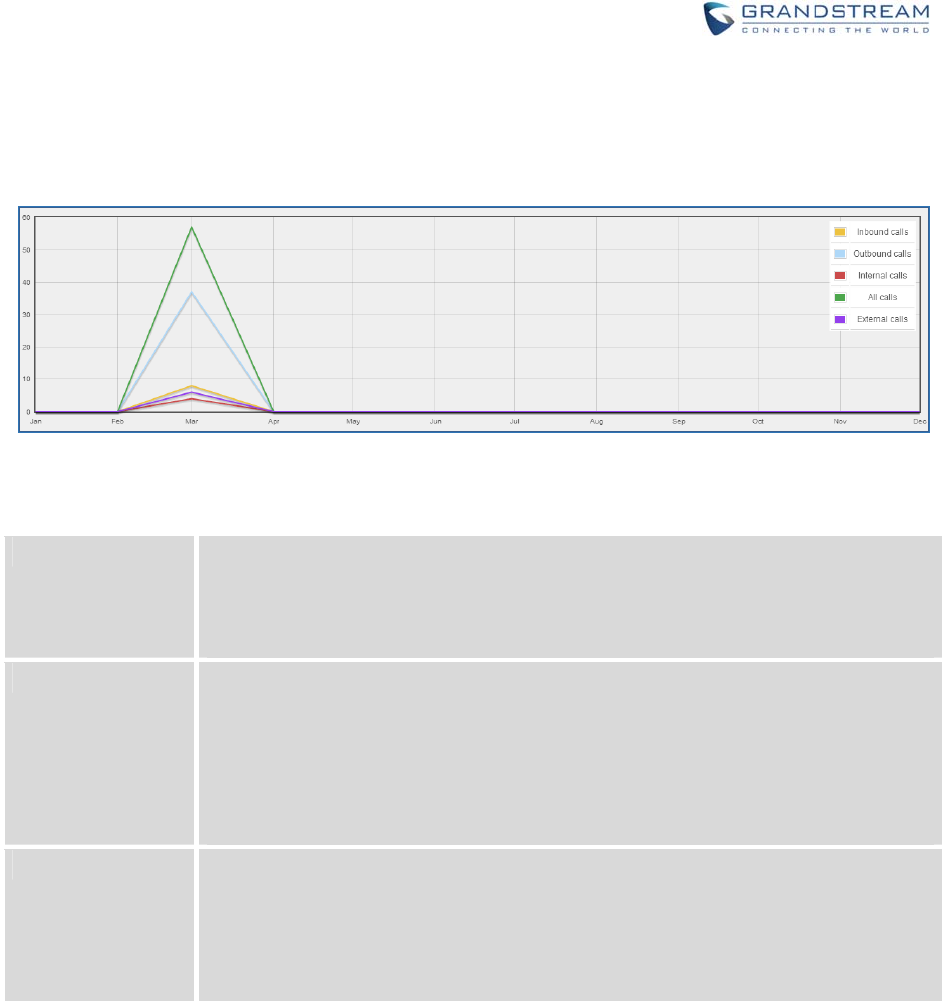
Firmware Version 1.0.0.1 UCM6200 Series IP PBX User Manual Page 300 of 320
STATISTICS
CDR Statistics is an additional feature on the UCM6200 which provides users a visual overview of the call
report across the time frame. Users can filter with different criteria to generate the statistics chart.
Figure 187: CDR Statistics
Table 100: CDR Statistics Filter Criteria
Trunk Type Select one of the following trunk type.
All
SIP Calls
PSTN Calls
Call Type Select one or more in the following checkboxes.
Inbound calls
Outbound calls
Internal calls
External calls
All calls
Time Range By month (of the selected year).
By week (of the selected year).
By day (of the specified month for the year).
By hour (of the specified date).
By range. For example, 2016-01 To 2016-03.
RECORDINGFILES
This page lists all the recording files recorded by "Auto Record" per extension/ring group/call queue/trunk,
or via feature code "Audio Mix Record". If external storage device is plugged in, for example, SD card or
USB drive, the files are stored on the external storage. Otherwise, internal storage will be used on the
UCM6200.
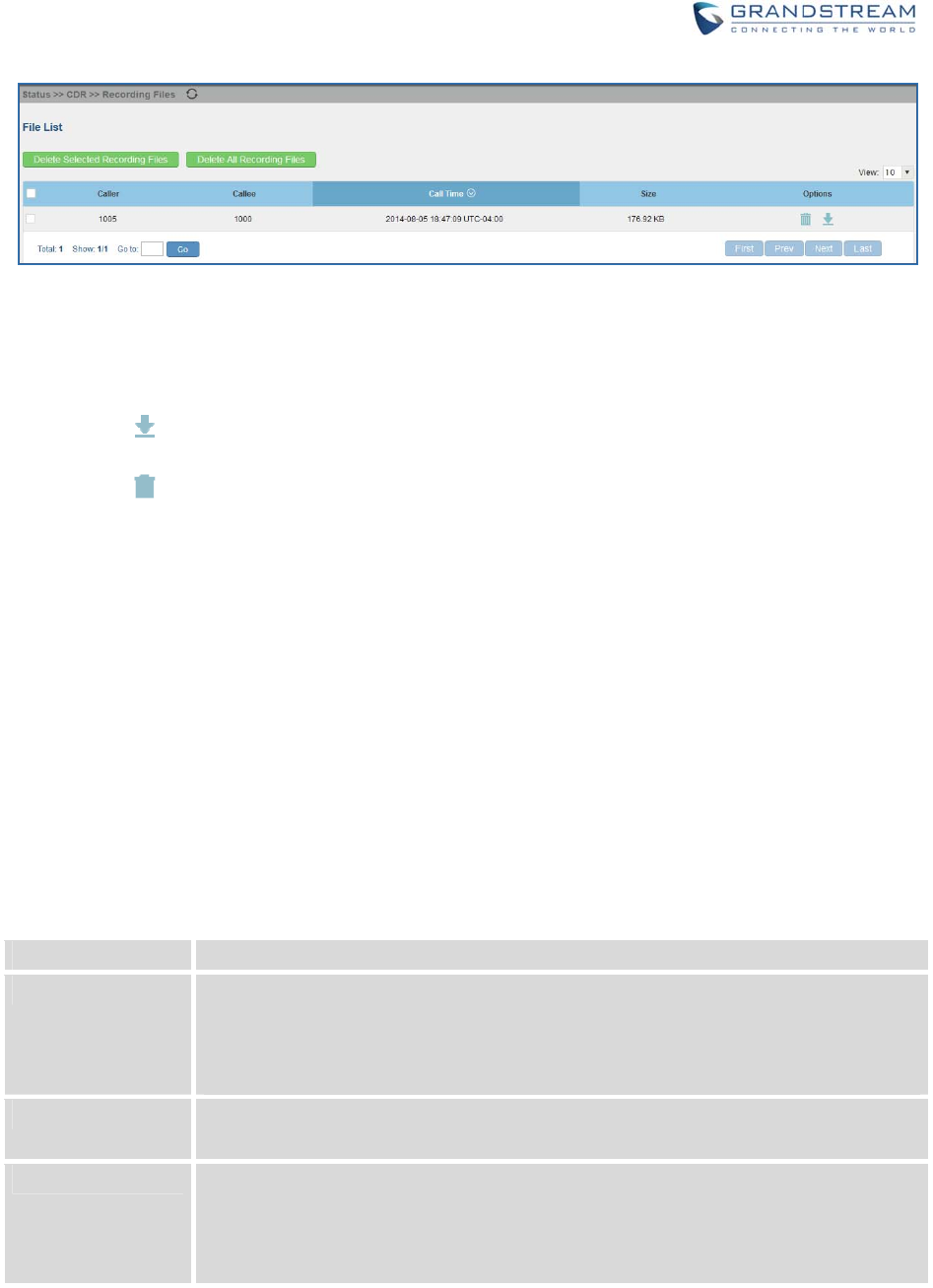
Firmware Version 1.0.0.1 UCM6200 Series IP PBX User Manual Page 301 of 320
Figure 188: CDR->Recording Files
Click on “Delete Selected Recording Files” to delete the recording files.
Click on “Delete All Recording Files” to delete all recording files.
Click on to download the recording file in .wav format.
Click on to delete the recording file.
To sort the recording file, click on the title "Caller", "Callee" or "Call Time" for the corresponding column.
Click on the title again can switch the sorting mode between ascending order or descending order.
APICONFIGURATION
The UCM6200 supports third party billing interface API for external billing software to access CDR and call
recordings on the PBX. The API uses HTTPS to request the CDR data and call recording data matching
given parameters as configured on the third party application.
Before accessing the API, the administrators need enable API and configure the access/authentication
information on the UCM6200 first. The API configuration parameters are listed in the table below.
Table 101: API Configuration Files
Enable Enable/Disable API. The default setting is disabled.
TLS Bind Address Configure the IP address for TLS server to bind to. "0.0.0.0" means binding to all
interfaces. The port number is optional and the default port number is 8443. The IP
address must match the common name (host name) in the certificate so that the TLS
socket won't bind to multiple IP addresses. The default setting is 0.0.0.0:8443.
TLS Private Key Upload TLS private key. The size of the key file must be under 2MB. This file will be
renamed as 'private.pem' automatically.
TLS Cert Upload TLS cert. The size of the certificate must be under 2MB. This is the certificate
file (*.pem format only) for TLS connection. This file will be renamed as
"certificate.pem" automatically. It contains private key for the client and signed
certificate for the server.
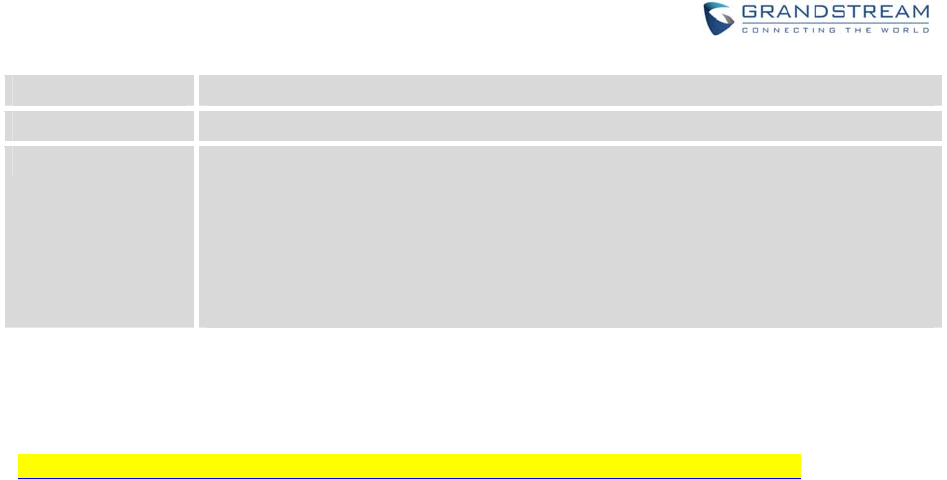
Firmware Version 1.0.0.1 UCM6200 Series IP PBX User Manual Page 302 of 320
Username Configure the Username for API Authentication.
Password Configure the Password for API Authentication.
Permitted Specify a list of IP addresses permitted by API. This creates an AIP-specific access
control list. Multiple entries are allowed.
For example, "192.168.40.3/255.255.255.255" denies access from all IP addresses
except 192.168.40.3.
The default setting is blank, meaning all IPs will be denied. Users must set permitted
IP address before connecting to the API.
For more details on CDR API (Access to Call Detail Records) and REC API (Access to Call Recording
Files), please refer the document in the link here:
http://www.grandstream.com/sites/default/files/Resources/ucm6200_cdr_rec_api_guide.pdf

Firmware Version 1.0.0.1 UCM6200 Series IP PBX User Manual Page 303 of 320
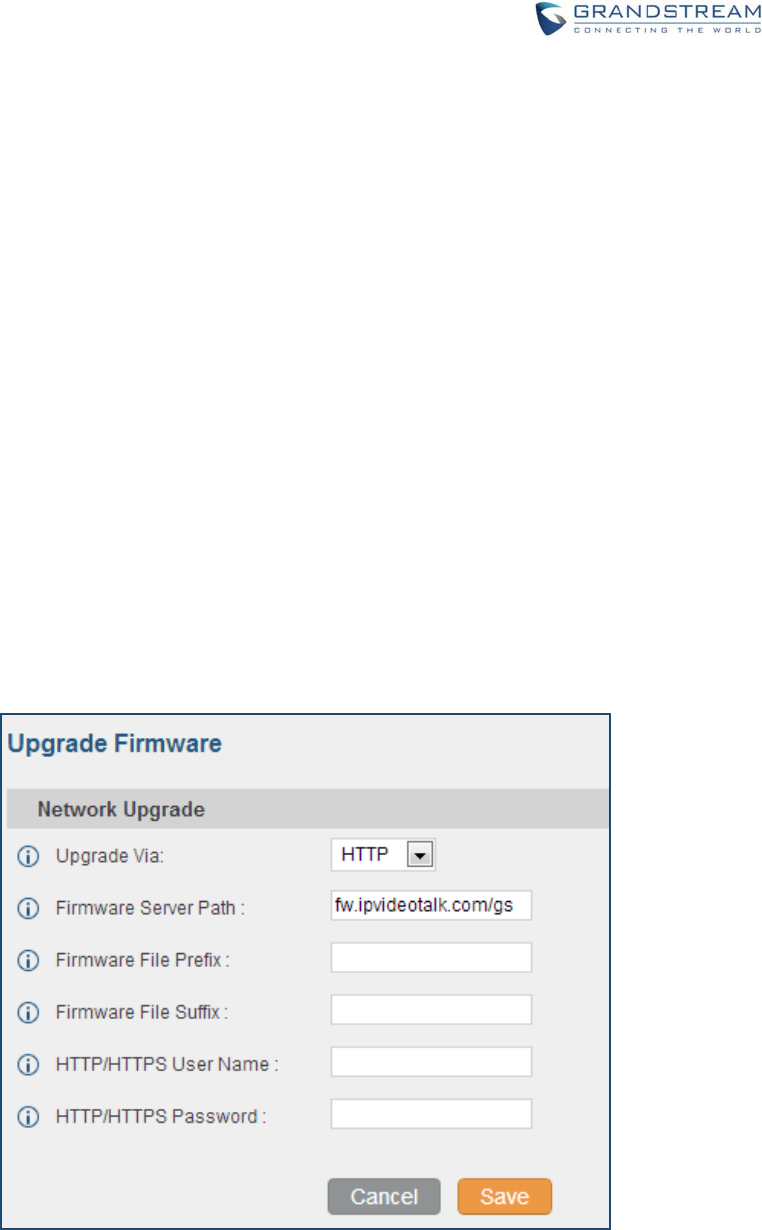
Firmware Version 1.0.0.1 UCM6200 Series IP PBX User Manual Page 304 of 320
UPGRADINGANDMAINTENANCE
UPGRADING
The UCM6200 can be upgraded to a new firmware version remotely or locally. This section describes how
to upgrade your UCM6200 via network or local upload.
UPGRADINGVIANETWORK
The UCM6200 can be upgraded via TFTP/HTTP/HTTPS by configuring the URL/IP Address for the
TFTP/HTTP/HTTPS server and selecting a download method. Configure a valid URL for TFTP, HTTP or
HTTPS; the server name can be FQDN or IP address.
Examples of valid URLs:
firmware.grandstream.com/BETA
The upgrading configuration can be accessed via Web GUI->Maintenance->Upgrade.
Figure 189: Network Upgrade
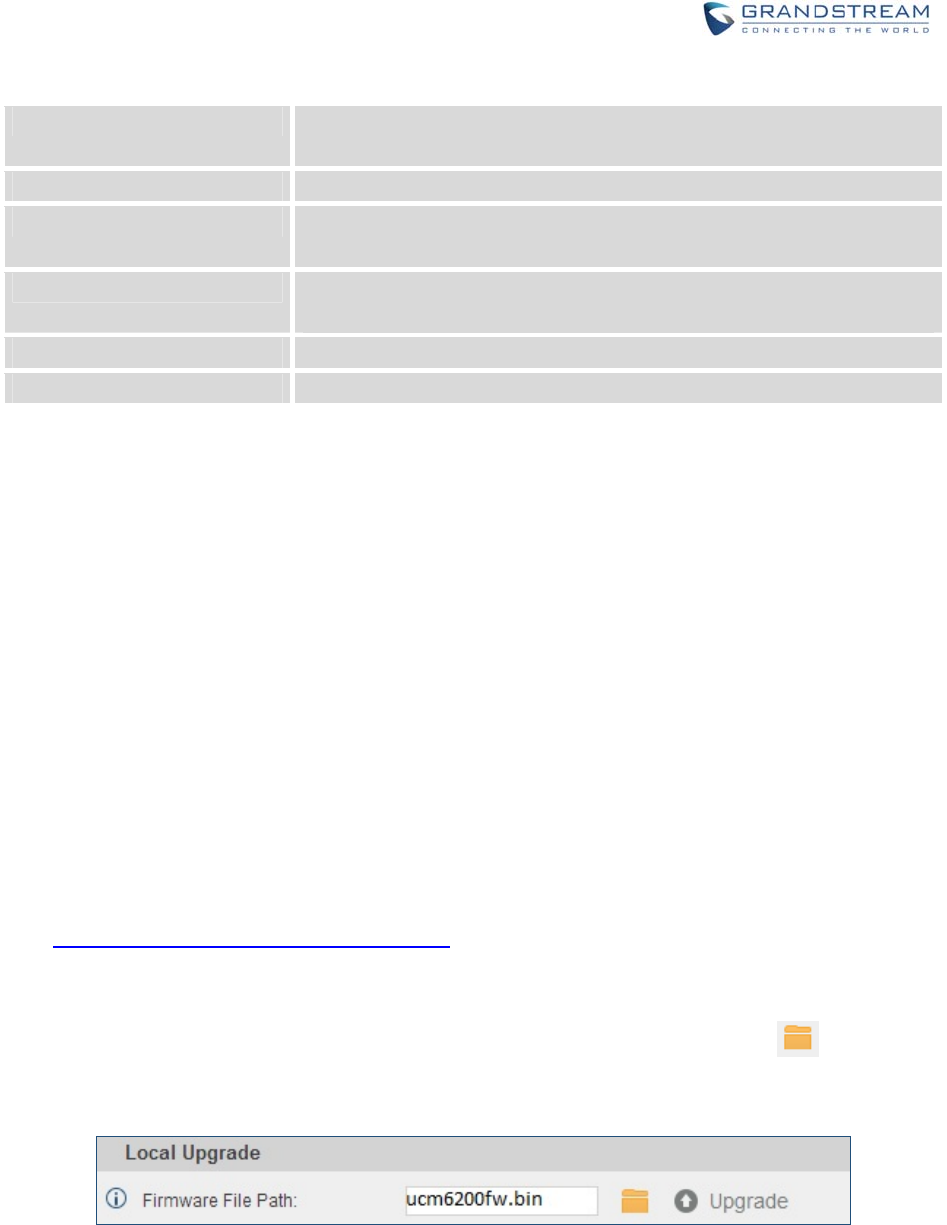
Firmware Version 1.0.0.1 UCM6200 Series IP PBX User Manual Page 305 of 320
Table 102: Network Upgrade Configuration
Upgrade Via Allow users to choose the firmware upgrade method: TFTP, HTTP or
HTTPS.
Firmware Server Path Define the server path for the firmware server.
Firmware File Prefix If configured, only the firmware with the matching encrypted prefix will be
downloaded and flashed into the UCM6200.
Firmware File Suffix If configured, only the firmware with the matching encrypted postfix will be
downloaded and flashed into the UCM6200.
HTTP/HTTPS User Name The user name for the HTTP/HTTPS server.
HTTP/HTTPS Password The password for the HTTP/HTTPS server.
Please follow the steps below to upgrade the firmware remotely.
Enter the firmware server path under web UI->Maintenance->Upgrade.
Click on "Save". Then reboot the device to start the upgrading process.
Please be patient during the upgrading process. Once done, a reboot message will be displayed in the
LCD.
Manually reboot the UCM6200 when it's appropriate to avoid immediate service interruption. After it
boots up, log in the web GUI to check the firmware version.
UPGRADINGVIALOCALUPLOAD
If there is no HTTP/TFTP server, users could also upload the firmware to the UCM6200 directly via Web
GUI. Please follow the steps below to upload firmware locally.
Download the latest UCM6200 firmware file from the following link and save it in your PC.
http://www.grandstream.com/support/firmware
Log in the Web GUI as administrator in the PC.
Go to Web GUI->Maintenance->Upgrade, upload the firmware file by clicking on and select
the firmware file from your PC. The default firmware file name is ucm6200fw.bin
Figure 190: Local Upgrade
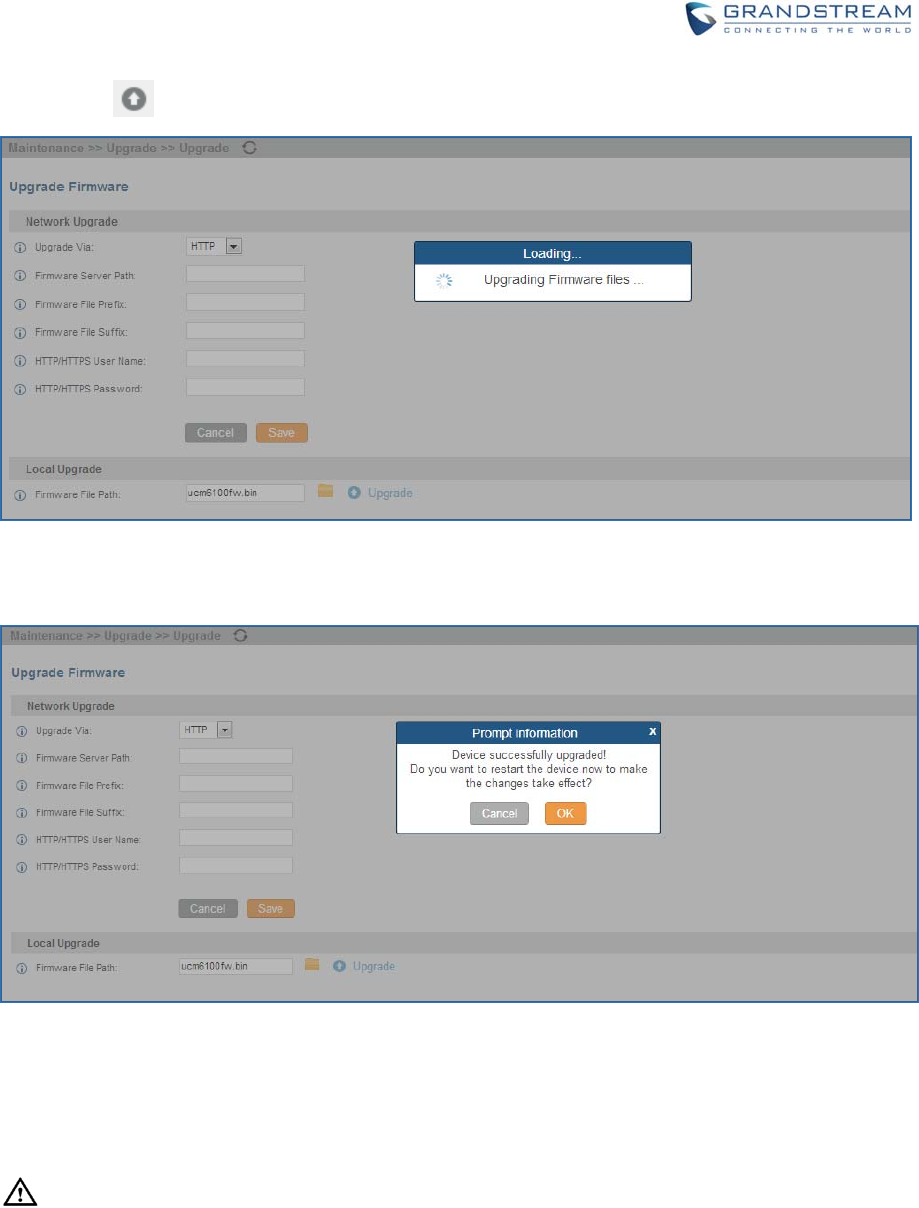
Firmware Version 1.0.0.1 UCM6200 Series IP PBX User Manual Page 306 of 320
Click on to start upgrading.
Figure 191: Upgrading Firmware Files
Wait until the upgrading process is successful and a window will be popped up in the Web GUI.
Figure 192: Reboot UCM6200
Click on "OK" to reboot the UCM6200 and check the firmware version after it boots up.
--------------------------------------------------------------------------------------------------------------------------------------------
Note:
Please do not interrupt or power cycle the UCM6200 during upgrading process.
--------------------------------------------------------------------------------------------------------------------------------------------
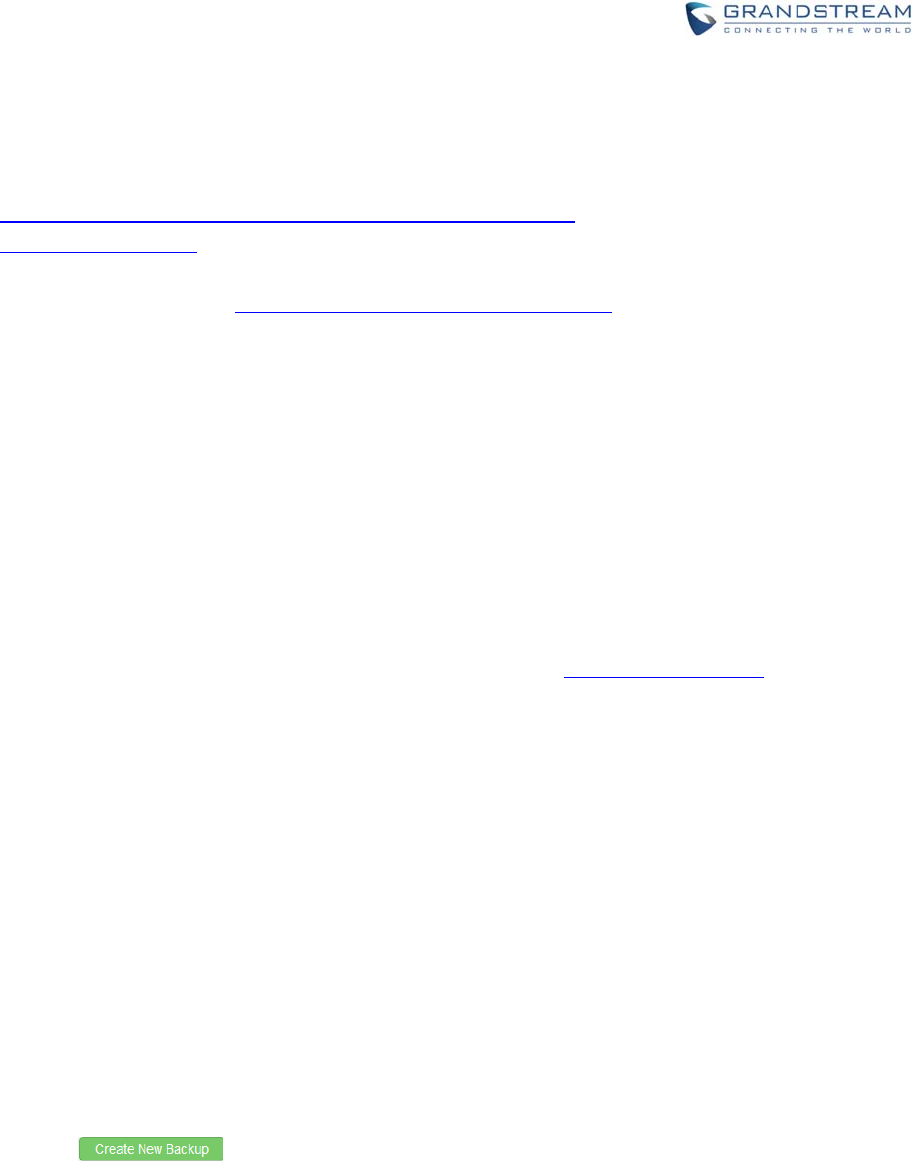
Firmware Version 1.0.0.1 UCM6200 Series IP PBX User Manual Page 307 of 320
NOLOCALFIRMWARESERVERS
Service providers should maintain their own firmware upgrade servers. For users who do not have
TFTP/HTTP/HTTPS server, some free windows version TFTP servers are available for download from
http://www.solarwinds.com/products/freetools/free_tftp_server.aspx
http://tftpd32.jounin.net
Please check our website at http://www.grandstream.com/support/firmware for latest firmware.
Instructions for local firmware upgrade via TFTP:
1. Unzip the firmware files and put all of them in the root directory of the TFTP server;
2. Connect the PC running the TFTP server and the UCM6200 to the same LAN segment;
3. Launch the TFTP server and go to the File menu->Configure->Security to change the TFTP server's
default setting from "Receive Only" to "Transmit Only" for the firmware upgrade;
4. Start the TFTP server and configure the TFTP server in the UCM6200 web configuration interface;
5. Configure the Firmware Server Path to the IP address of the PC;
6. Update the changes and reboot the UCM6200.
End users can also choose to download a free HTTP server from http://httpd.apache.org/ or use
Microsoft IIS web server.
BACKUP
The UCM6200 configuration can be backed up locally or via network. The backup file will be used to
restore the configuration on UCM6200 when necessary.
BACKUP/RESTORE
Users could backup the UCM6200 configurations for restore purpose under Web
GUI->Maintenance->Backup->Local Backup.
Click on to create a new backup file. Then the following dialog will show.
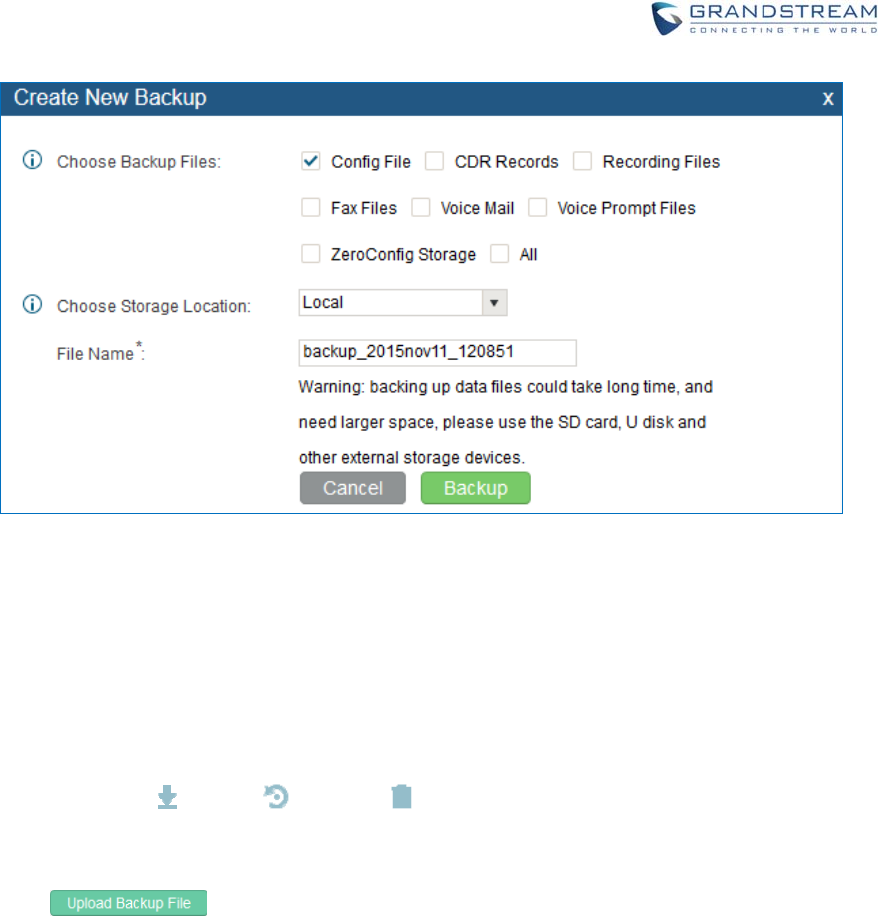
Firmware Version 1.0.0.1 UCM6200 Series IP PBX User Manual Page 308 of 320
Figure 193: Create New Backup
1. Choose the type(s) of files to be included in the backup.
2. Choose where to store the backup file: USB Disk, SD Card or Local.
3. Name the backup file.
4. Click on "Backup" to start backup.
Once the backup is done, the list of the backups will be displayed with date and time in the web page.
Users can download , restore , or delete it from the UCM6200 internal storage or the external
device.
Click on to upload backup file from the local device to UCM6200. The uploaded
backup file will also be displayed in the web page and can be used to restore the UCM6200.
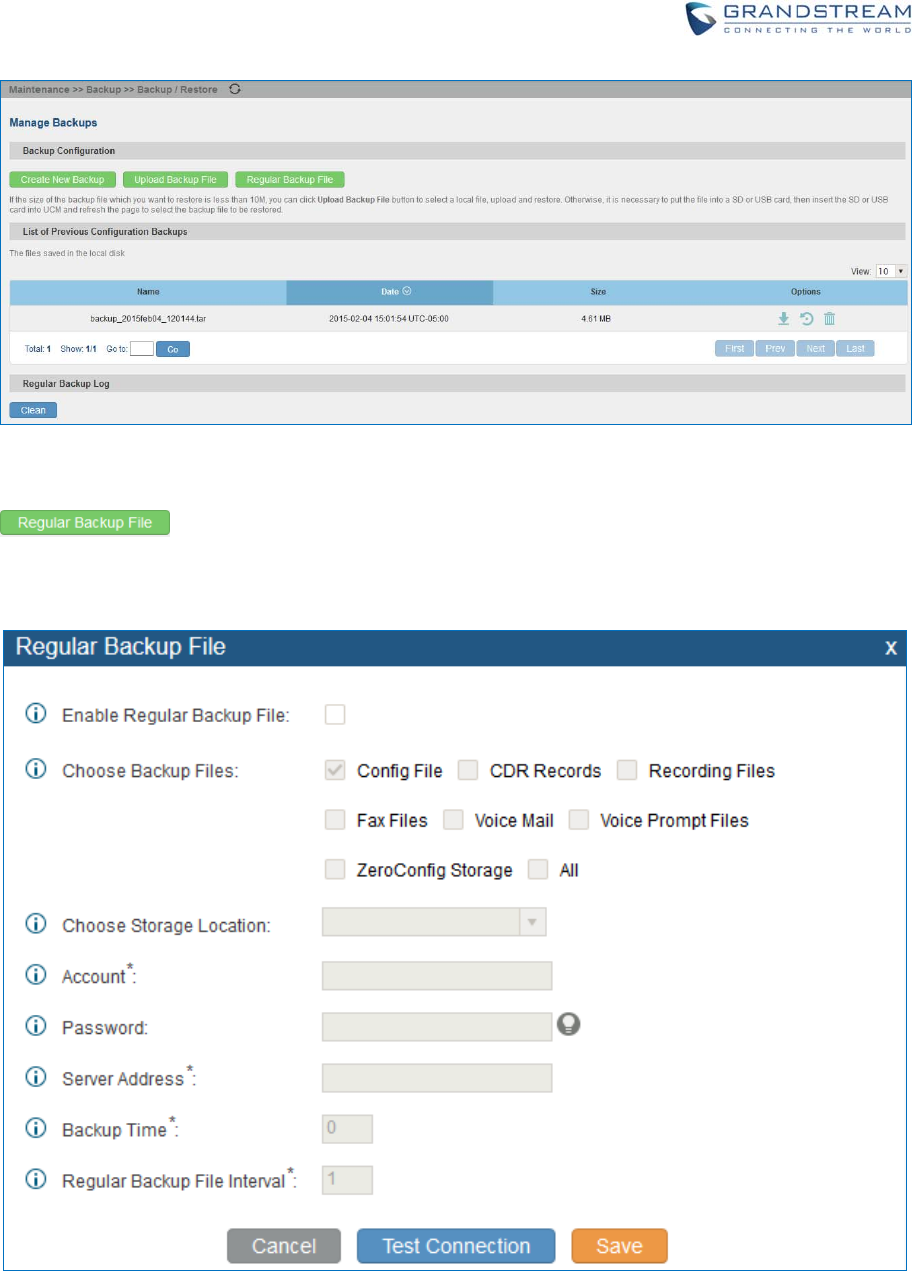
Firmware Version 1.0.0.1 UCM6200 Series IP PBX User Manual Page 309 of 320
Figure 194: Backup / Restore
option allows UCM to perform automatically backup on the user specified time.
Regular backup file can only be stored in USB / SD card / SFTP server. User is allowed to set backup time
from 0-23 and how frequent the backup will be performed.
Figure 195: Local Backup
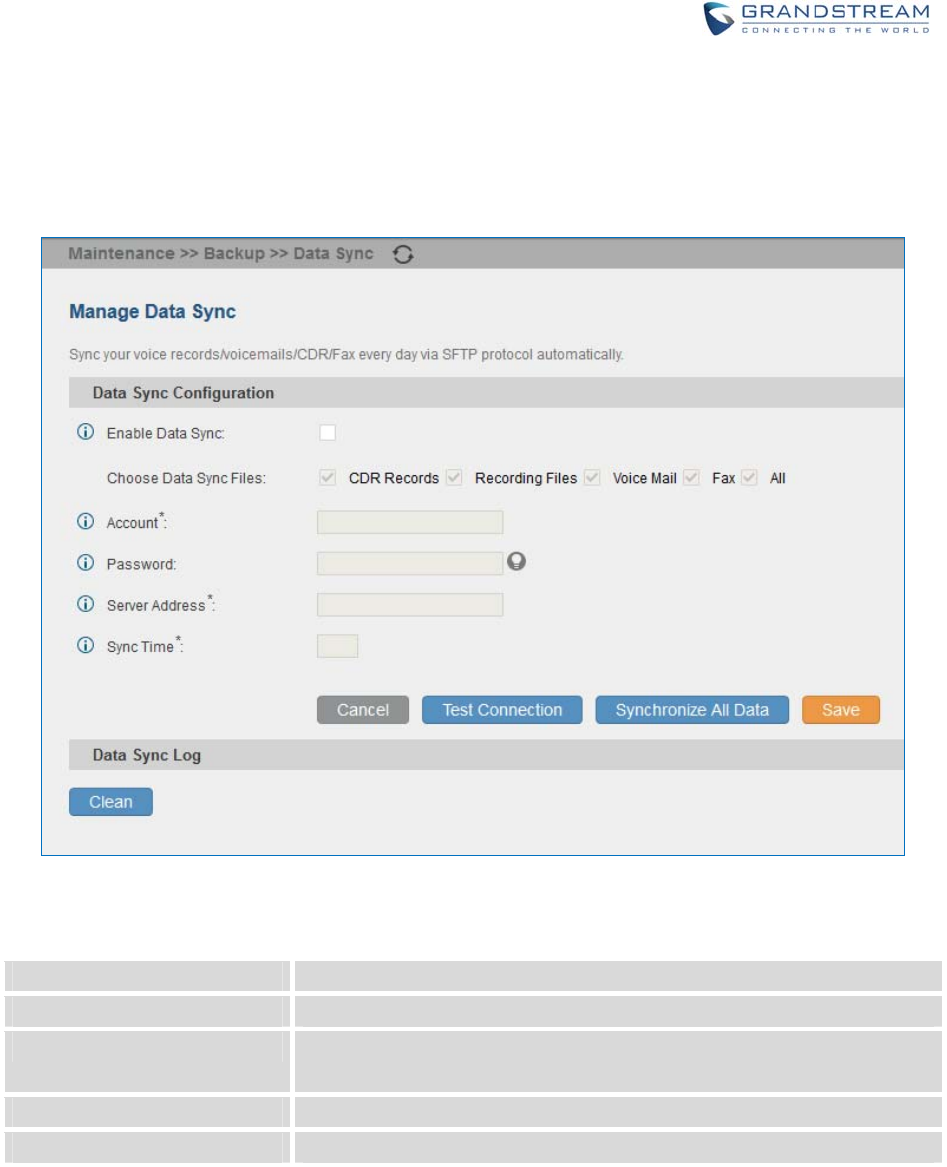
Firmware Version 1.0.0.1 UCM6200 Series IP PBX User Manual Page 310 of 320
DATASYNC
Besides local backup, users could backup the voice records/voice mails/CDR/FAX in a daily basis to a
remote server via SFTP protocol automatically under Web GUI->Maintenance->Backup->Data Sync.
Figure 196: Data Sync
Table 103: Data Sync Configuration
Enable Data Sync Enable the auto data sync function. The default setting is "No".
Account Enter the Account name on the SFTP backup server.
Password Enter the Password associate with the Account on the SFTP backup
server.
Server Address Enter the SFTP server address.
Sync Time Enter 0-23 to specify the backup hour of the day.
Before saving the configuration, users could click on "Test Connection". The UCM6200 will then try
connecting the server to make sure the server is up and accessible for the UCM6200. Save the changes
and all the backup logs will be listed on the web page. After data sync is configured, users could also
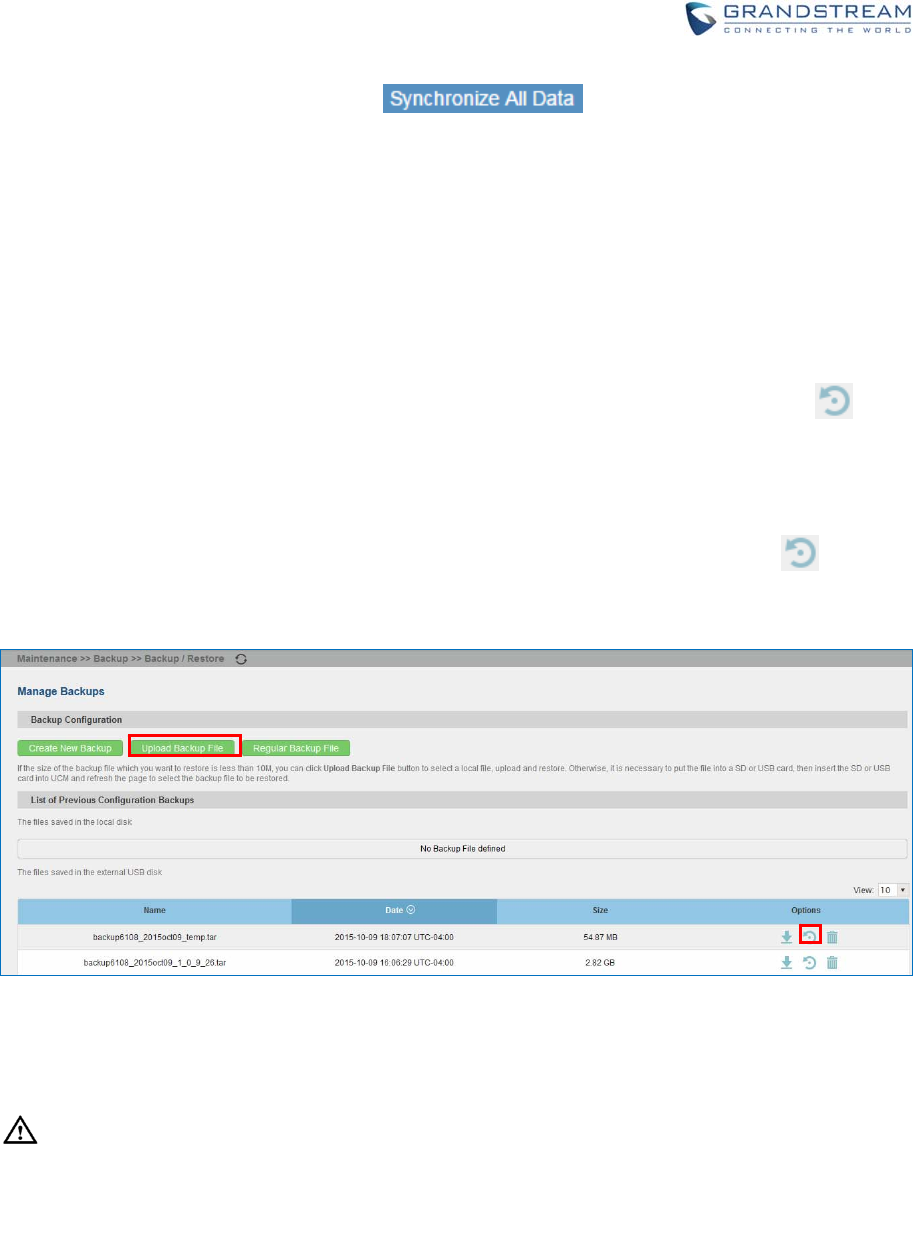
Firmware Version 1.0.0.1 UCM6200 Series IP PBX User Manual Page 311 of 320
manually synchronize all data by clicking on instead of waiting for the backup time
interval to come.
RESTORECONFIGURATIONFROMBACKUPFILE
To restore the configuration on the UCM6200 from a backup file, users could go to Web
GUI->Maintenance->Backup->Local Backup.
A list of previous configuration backups is displayed on the web page. Users could click on of the
desired backup file and it will be restored to the UCM6200.
If users have other backup files on PC to restore on the UCM6200, click on "Upload Backup File" first
and select it from local PC to upload on the UCM6200. Once the uploading is done, this backup file will
be displayed in the list of previous configuration backups for restore purpose. Click on to restore
from the backup file.
Figure 197: Restore UCM6200 from Backup File
--------------------------------------------------------------------------------------------------------------------------------------------
Note:
The uploaded backup file must be a tar file with no special characters like *,!,#,@,&,$,%,^,(,),/,\,space
in the file name.
The uploaded back file size must be under 10MB.
--------------------------------------------------------------------------------------------------------------------------------------------
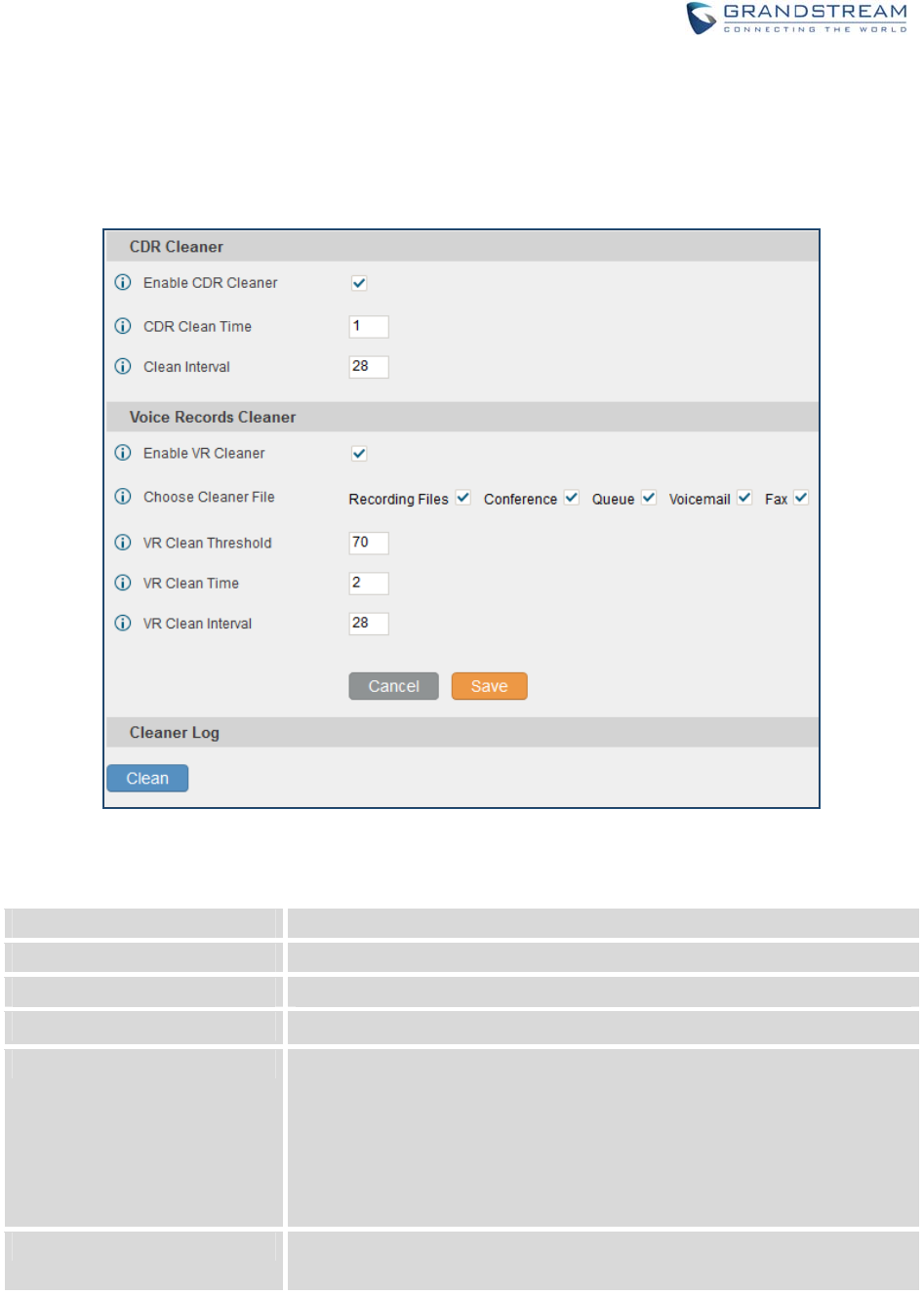
Firmware Version 1.0.0.1 UCM6200 Series IP PBX User Manual Page 312 of 320
CLEANER
Users could configure to clean the Call Detail Report/Voice Records/Voice Mails/FAX automatically under
Web GUI->Maintenance->Cleaner.
Figure 198: Cleaner
Table 104: Cleaner Configuration
Enable CDR Cleaner Enable the CDR Cleaner function.
CDR Clean Time Enter 0-23 to specify the hour of the day to clean up CDR.
Clean Interval Enter 1-30 to specify the day of the month to clean up CDR.
Enable VR Cleaner Enter the Voice Records Cleaner function.
Choose Cleaner File Select the files for system automatic clean.
Recording Files
Conference
Queue
Voicemail
Fax
VR Clean Threshold Specify the Voice Records threshold from 0 to 99 by using local storage
status in percentage.
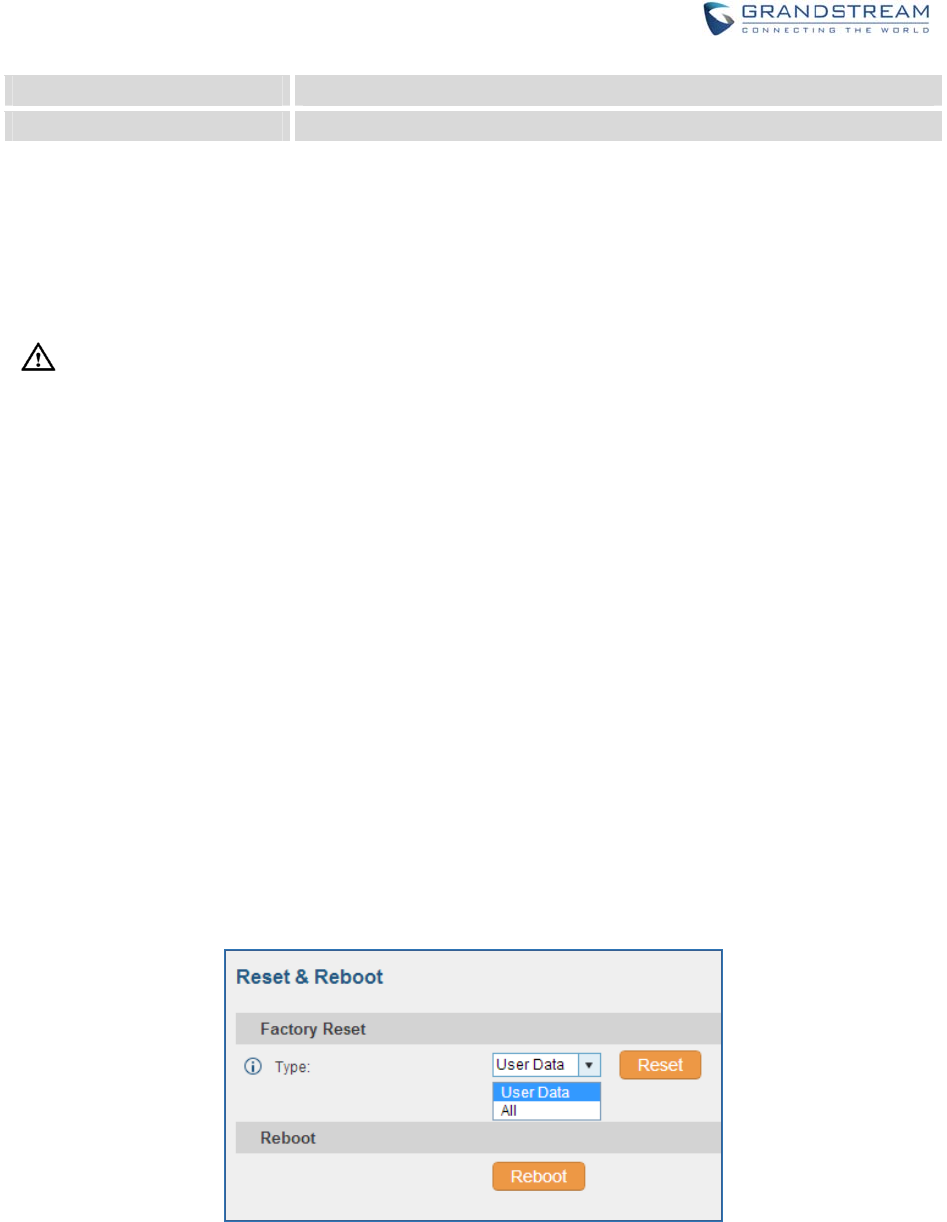
Firmware Version 1.0.0.1 UCM6200 Series IP PBX User Manual Page 313 of 320
VR Clean Time Enter 0-23 to specify the hour of the day to clean up Voice Records.
Clean Interval Enter 1-30 to specify the day of the month to clean up Voice Records.
All the cleaner logs will be listed on the bottom of the page.
--------------------------------------------------------------------------------------------------------------------------------------------
Note:
Cleaner will delete data based on Recording Storage selection. If USB Disk is selected, Cleaner will only
clean data in USB and local data will leave untouched. If Enable auto change is selected and USB disk is
connected, Cleaner will only delete data in USB drive. Recordings Storage function can be found under
web UI-> Settings-> Recordings Storage-> Recordings Storage.
--------------------------------------------------------------------------------------------------------------------------------------------
RESETANDREBOOT
Users could perform reset and reboot under Web GUI->Maintenance->Reset and Reboot.
To factory reset the device, select the mode type first. There are two different types for reset.
User Data: All the data including voicemail, recordings, IVR Prompt, Music on Hold, CDR and backup
files will be cleared.
All: All the configurations and data will be reset to factory default.
Figure 199: Reset and Reboot

Firmware Version 1.0.0.1 UCM6200 Series IP PBX User Manual Page 314 of 320
SYSLOG
On the UCM6200, users could dump the syslog information to a remote server under Web
GUI->Maintenance->Syslog. Enter the syslog server hostname or IP address and select the module/level
for the syslog information.
The default syslog level for all modules is "error", which is recommended in your UCM6200 settings
because it can be helpful to locate the issues when errors happen.
Some typical modules for UCM6200 functions are as follows and users can turn on "notic" and "verb"
levels besides "error" level.
pbx: This module is related to general PBX functions.
chan_sip: This module is related to SIP calls.
chan_dahdi: This module is related to analog calls (FXO/FXS).
app_meetme: This module is related to conference bridge.
--------------------------------------------------------------------------------------------------------------------------------------------
Note:
Syslog is usually for debugging and troubleshooting purpose. Turning on all levels for all syslog modules is
not recommended for daily usage. Too many syslog print might cause traffic and affect system
performance.
--------------------------------------------------------------------------------------------------------------------------------------------
TROUBLESHOOTING
On the UCM6200, users could capture traces, ping remote host and traceroute remote host for
troubleshooting purpose under Web GUI->Maintenance->Troubleshooting.
ETHERNETCAPTURE
The captured trace can be downloaded for analysis. Also the instructions or result will be displayed in the
web GUI output result.
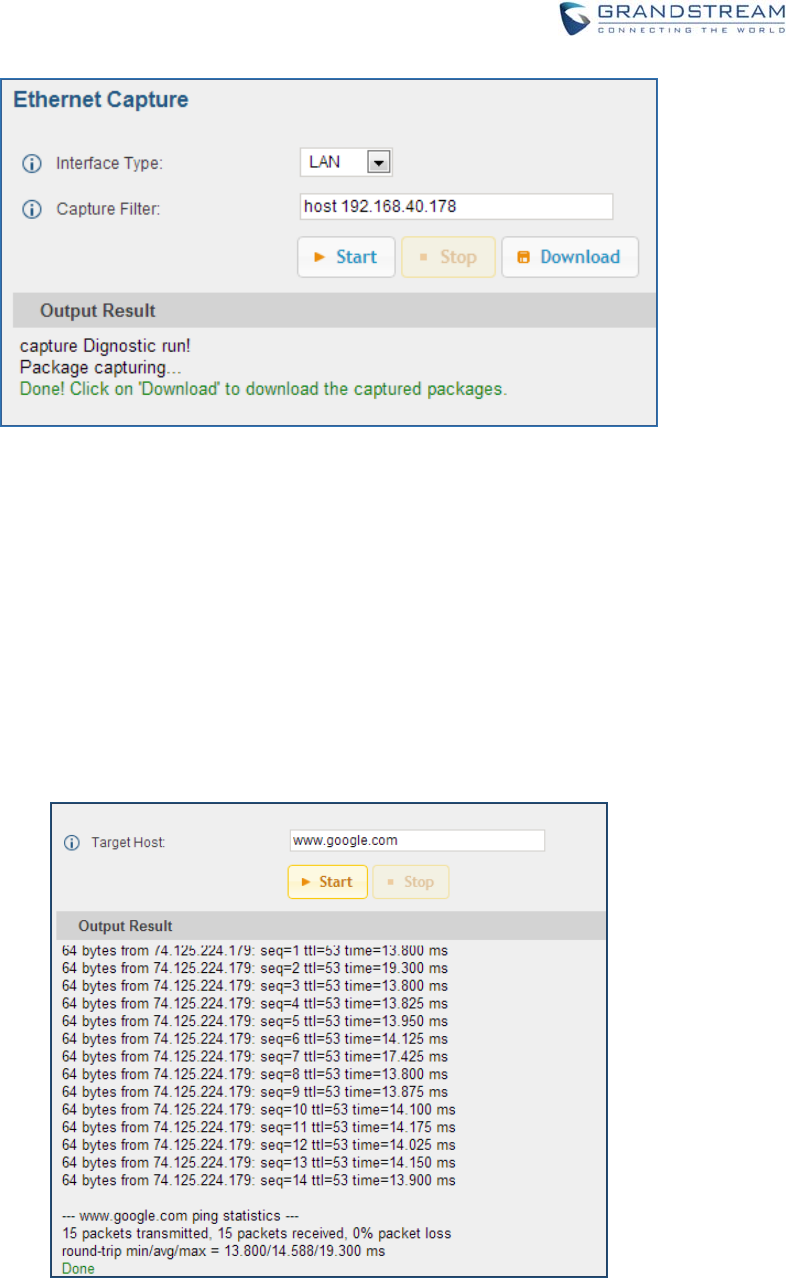
Firmware Version 1.0.0.1 UCM6200 Series IP PBX User Manual Page 315 of 320
Figure 200: Ethernet Capture
The output result is in .pcap format. Therefore, users could specify the capture filter as used in general
network traffic capture tool (host, src, dst, net, protocol, port, port range) before starting capturing the
trace.
IPPING
Enter the target host in host name or IP address. Then press "Start" button. The output result will
dynamically display in the window below.
Figure 201: PING

Firmware Version 1.0.0.1 UCM6200 Series IP PBX User Manual Page 316 of 320
TRACEROUTE
Enter the target host in host name or IP address. Then press "Start" button. The output result will
dynamically display in the window below.
Figure 202: Traceroute
ANALOGRECORDTRACE
Analog record trace can be used to troubleshoot analog trunk issue, for example, the UCM6200 user has
caller ID issue for incoming call from Analog trunk. Users can access analog record trance under web
GUI->Maintenance->Troubleshooting ->Analog Record Trace.
Here is the step to capture trace:
1. Select FXO or FXS for "Record Ports". If the issue happens on FXO 1, select FXO port 1 to record the
trace.
2. Select "Record Direction".
3. Select "Record File Mode" to separate the record per direction or mix.
4. Click on "Start".
5. Make a call via the analog port that has the issue.
6. Once done, click on "Stop".
7. Click on "Download" to download the analog record trace.
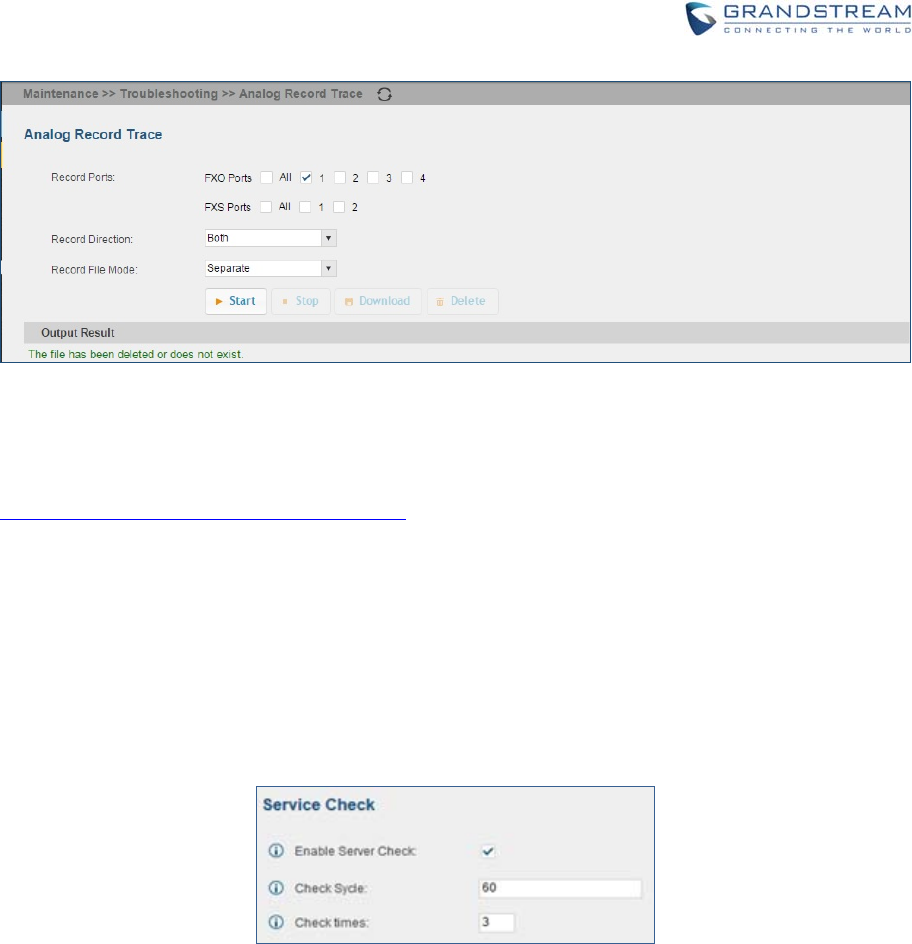
Firmware Version 1.0.0.1 UCM6200 Series IP PBX User Manual Page 317 of 320
Figure 203: Troubleshooting Analog Trunks
After capturing the trace, users can download it for basic analysis. Or you can contact Grandstream
Technical support in the following link for further assistance if the issue is not resolved.
http://www.grandstream.com/index.php/support
SERVICECHECK
Enable Service Check to periodically check UCM6200. Check Cycle is configurable in seconds and the
default setting is 60 sec. Check Times is the maximum number of failed checks before restart the
UCM6200. The default setting is 3. If there is no response from UCM6200 after 3 attempts (default) to
check, current status will be stored and the internal service in UCM6200 will be restarted.
Figure 204: Service Check
NETWORKSTATUS
In UCM6200 web UI->Maintenance->Troubleshooting->Network Status, the users can view active Internet
connections. This information can be used to troubleshoot connection issue between UCM6200 and other
services.
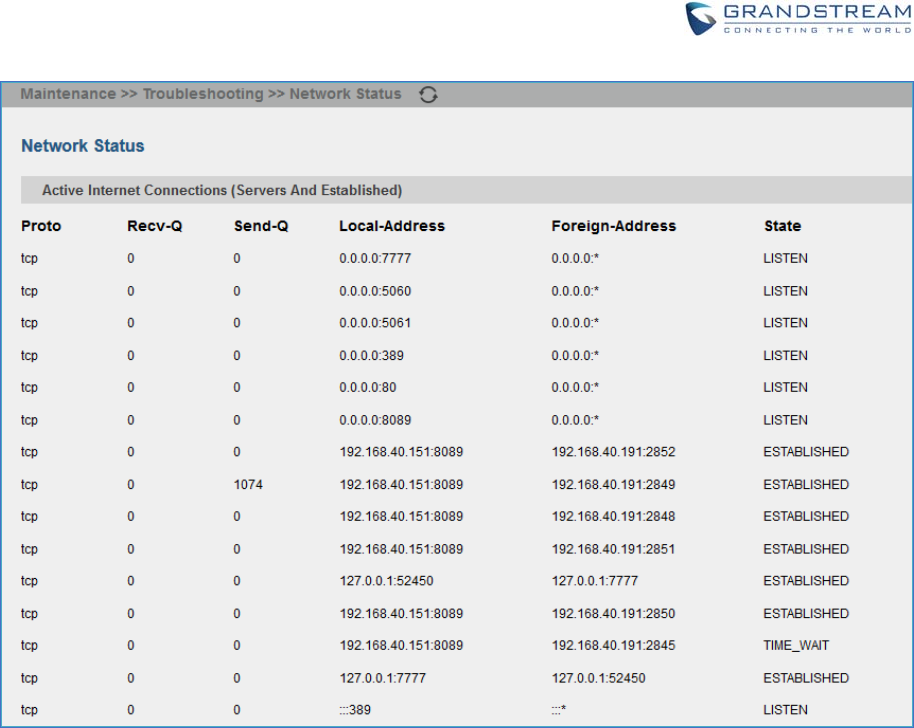
Firmware Version 1.0.0.1 UCM6200 Series IP PBX User Manual Page 318 of 320
Figure 205: Network Status
REMOTEACCESS
SSHACCESS
SSH switch now is available via web UI and LCD. User can enable or disable SSH access directly from
web UI or LCD screen. For web SSH access, please log in UCM6200 web interface and go to
Maintenance->Remote Access->SSH Access. By default, SSH access is disabled for security concerns.
It is highly recommended to only enable SSH access for debugging purpose.
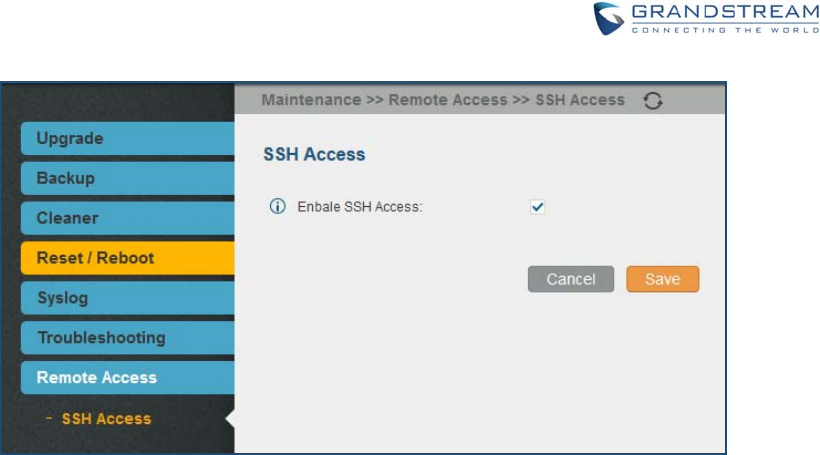
Firmware Version 1.0.0.1 UCM6200 Series IP PBX User Manual Page 319 of 320
Figure 206: SSH Access

Firmware Version 1.0.0.1 UCM6200 Series IP PBX User Manual Page 320 of 320
EXPERIENCINGTHEUCM6200SERIESIPPBX
Please visit our website: http://www.grandstream.com to receive the most up- to-date updates on firmware
releases, additional features, FAQs, documentation and news on new products.
We encourage you to browse our product related documentation, FAQs and User and Developer Forum
for answers to your general questions. If you have purchased our products through a Grandstream
Certified Partner or Reseller, please contact them directly for immediate support.
Our technical support staff is trained and ready to answer all of your questions. Contact a technical support
member or submit a trouble ticket online to receive in-depth support.
Thank you again for purchasing Grandstream UCM6200 series IP PBX appliance, it will be sure to bring
convenience and color to both your business and personal life.
* Asterisk is a Registered Trademark of Digium, Inc.
FCC Caution:
Any Changes or modifications not expressly approved by the party responsible for compliance could void
the user's authority to operate the equipment.
This device complies with part 15 of the FCC Rules. Operation is subject to the following two conditions: (1)
This device may not cause harmful interference, and (2) this device must accept any interference received,
including interference that may cause undesired operation.
Note: This equipment has been tested and found to comply with the limits for a Class B digital device,
pursuant to part 15 of the FCC Rules. These limits are designed to provide reasonable protection against
harmful interference in a residential installation. This equipment generates, uses and can radiate radio
frequency energy and, if not installed and used in accordance with the instructions, may cause harmful
interference to radio communications. However, there is no guarantee that interference will not occur in a
particular installation. If this equipment does cause harmful interference to radio or television reception,
which can be determined by turning the equipment off and on, the user is encouraged to try to correct the
interference by one or more of the following measures:
- Reorient or relocate the receiving antenna.
- Increase the separation between the equipment and receiver.
- Connect the equipment into an outlet on a circuit different from that to which the receiver is connected.
- Consult the dealer or an experienced radio/TV technician for help.
Regulatory Information
U.S. FCC Part 68 Statement
This equipment complies with Part 68 of the FCC rules and the requirements adopted by the ACTA. The
unit bears a label on the back which contains among other information a product identifier in the format US:
GNIIS01BUCM6208. If requested, this number must be provided to the telephone company.
This equipment uses the following standard jack types for network connection: RJ11C.
This equipment contains an FCC compliant modular jack. It is designed to be connected to the telephone
network or premises wiring using compatible modular plugs and cabling which comply with the
requirements of FCC Part 68 rules.
The Ringer Equivalence Number, or REN, is used to determine the number of devices which may be
connected to the telephone line. An excessive REN may cause the equipment to not ring in response to an
incoming call. In most areas, the sum of the RENs of all equipment on a line should not exceed five (5.0).
In the unlikely event that this equipment causes harm to the telephone network, the telephone company
can temporarily disconnect your service. The telephone company will try to warn you in advance of any
such disconnection, but if advance notice isn't practical, it may disconnect the service first and notify you
as soon as possible afterwards. In the event such a disconnection is deemed necessary, you will be
advised of your right to file a complaint with the FCC.
From time to time, the telephone company may make changes in its facilities, equipment, or operations
which could affect the operation of this equipment. If this occurs, the telephone company is required to
provide you with advance notice so you can make the modifications necessary to obtain uninterrupted
service.
There are no user serviceable components within this equipment. See Warranty flyer for repair or warranty
information.
It shall be unlawful for any person within the United States to use a computer or other electronic device to
send any message via a telephone facsimile unless such message clearly contains, in a margin at the top
or bottom of each transmitted page or on the first page of the transmission, the date and time it is sent and
an identification of the business, other entity, or individual sending the message and the telephone number
of the sending machine or of such business, other entity, or individual. The telephone number provided
may not be a 900 number or any other number for which charges exceed local or long distance
transmission charges. Telephone facsimile machines manufactured on and after December 20, 1992, must
clearly mark such identifying information on each transmitted message. Facsimile modem boards
manufactured on and after December 13, 1995, must comply with the requirements of this section.
This equipment cannot be used on public coin phone service provided by the telephone company.
Connection to Party Line Service is subject to state tariffs. Contact your state public utility commission,
public service commission, or corporation commission for more information.
If trouble is experienced with this equipment, please contact (Agent in the US):
Company Name: Grandstream Networks, Inc.
Address: 126 Brookline Ave, 3rd Floor Boston, MA 02215, USA
Tel: +1 617-566-9300
Fax: 844-350-7572